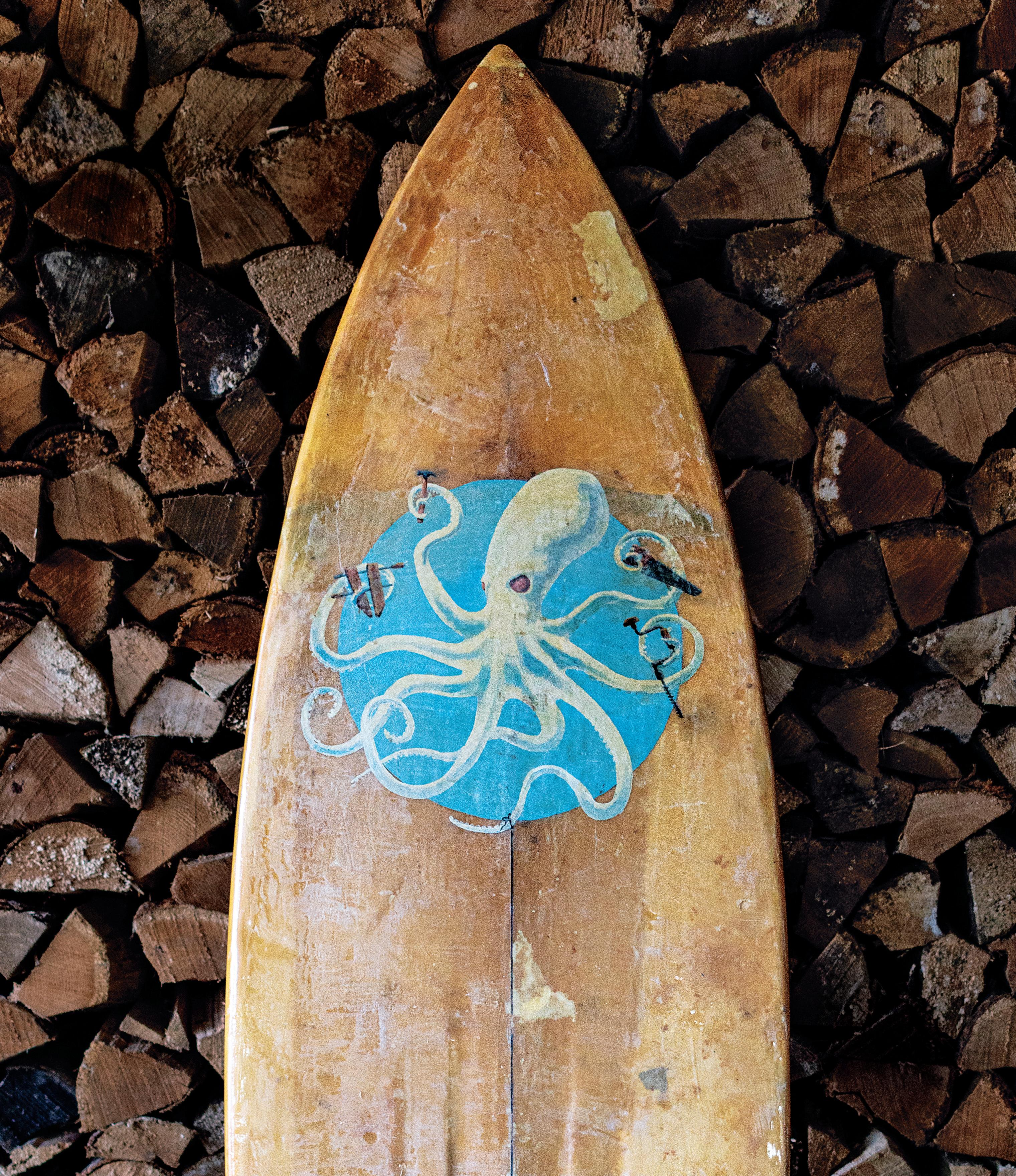
PART AND APART
WINTER 2024 VOL. 95 NO. 2
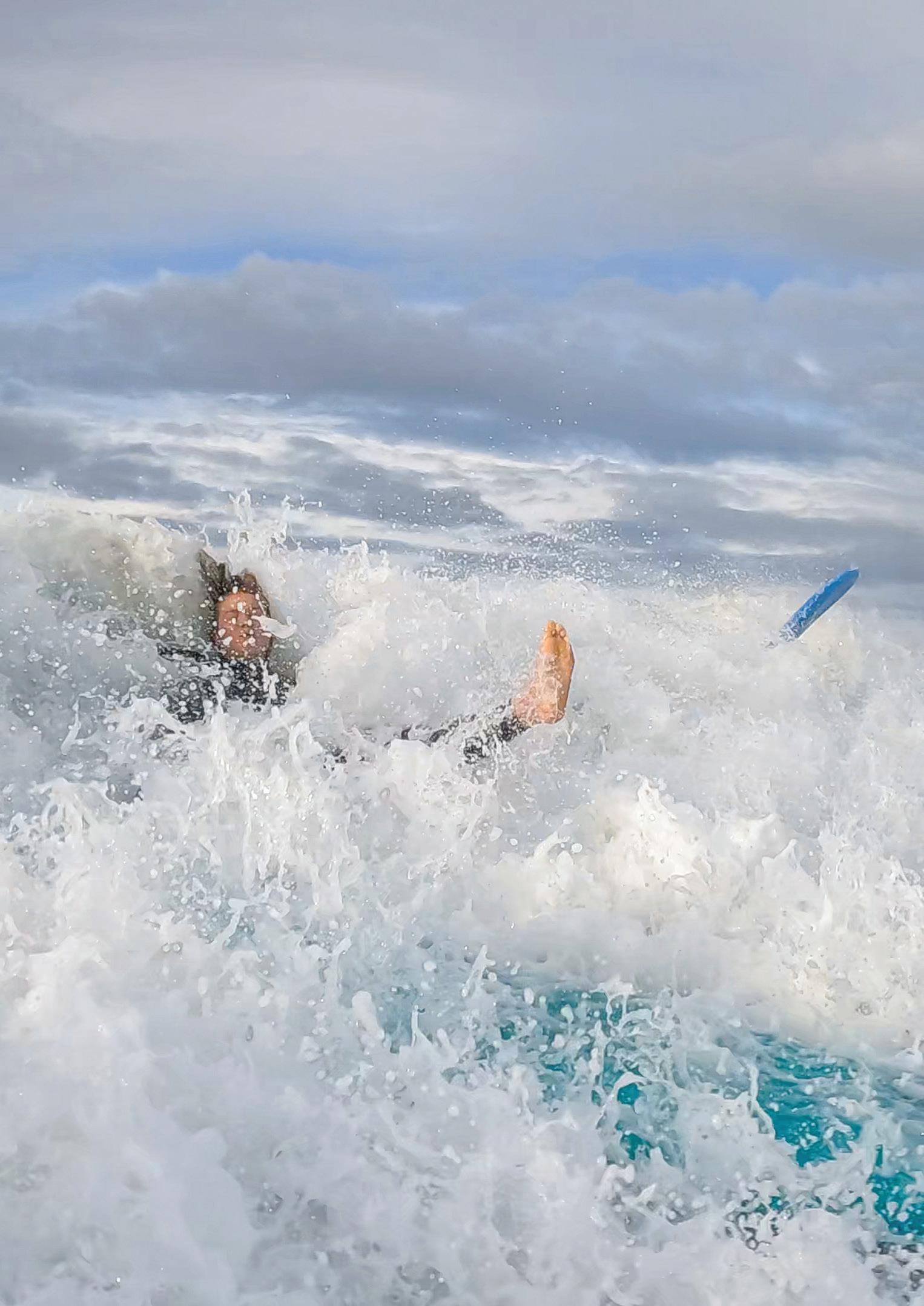
24 Second to Nature
In his story about Bowdoin surfers over generations, writer, recent grad, and surfer Chris Ritter ’21 describes what happens in the cold Maine waters: a sense of being both a part of and apart from the world, in a moving meditation built on taking, receiving, and riding the waves.
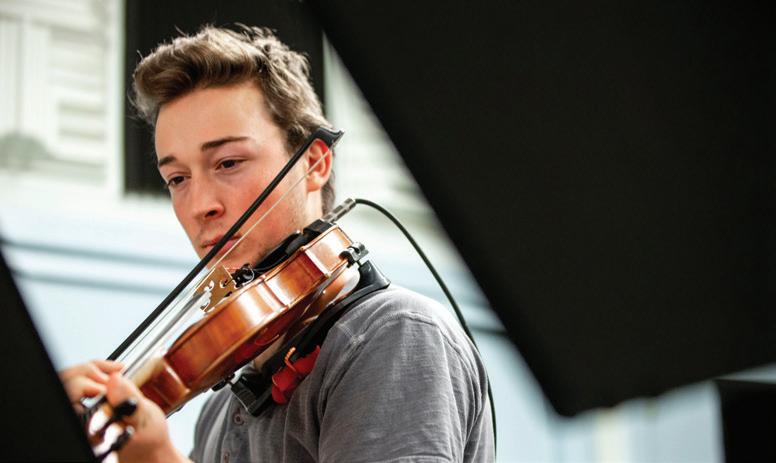
16 What Lasts
English teacher Samantha Francis-Taylor ’09 on finding solace in her grief for former student Finn Woodruff ’21.

18 Humanity’s Art
Michael Colbert ’16 talks with faculty in Bowdoin’s new urban studies minor and alumni working in the field about challenges and opportunities that face our cities.
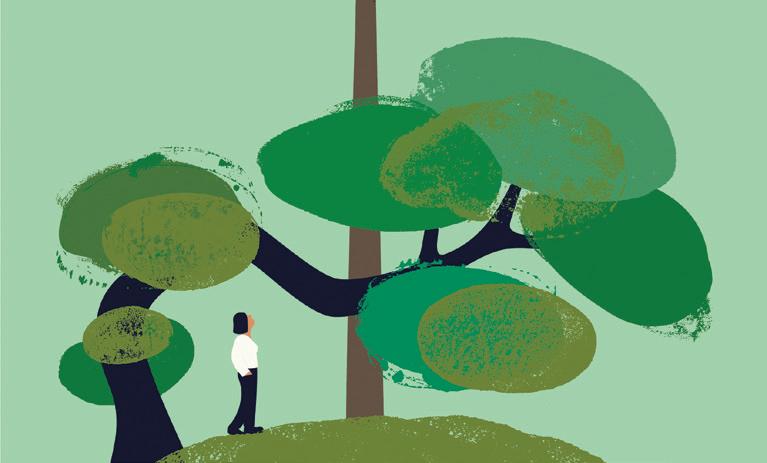
34 The Root of All Virtues
Four members of the Bowdoin community write about humility’s role in helping us to be human and what it means to cultivate humility in the modern world.
Contents WINTER 2024 VOL. 95 NO. 2
5 Creative: When she isn’t working as an executive assistant in finance and administration at Bowdoin, Amy Dionne is busy exercising her creativity in vast and varied ways.
7 Dine: Professor of Physics Dale Syphers shares a recipe for shrimp and artichokes to serve on rice or pasta—or as is.
8 Bearing Witness: Scientists and students get close to and collect data from Maine bears in their dens.
10 Worth Every Penny: The Class of 1964 celebrates its 60th Reunion with a gift in honor of lifelong friendship.
13 On View: Faculty collaborate on an art exhibition that explores Asian American identity, weaving past experiences of imperialism, discrimination, and broken lineages together with new futures and possibilities of belonging.

44 Water Defender: Attorney Luke Wilson ’06 is ensuring a future where water is more than a resource—it’s a right.
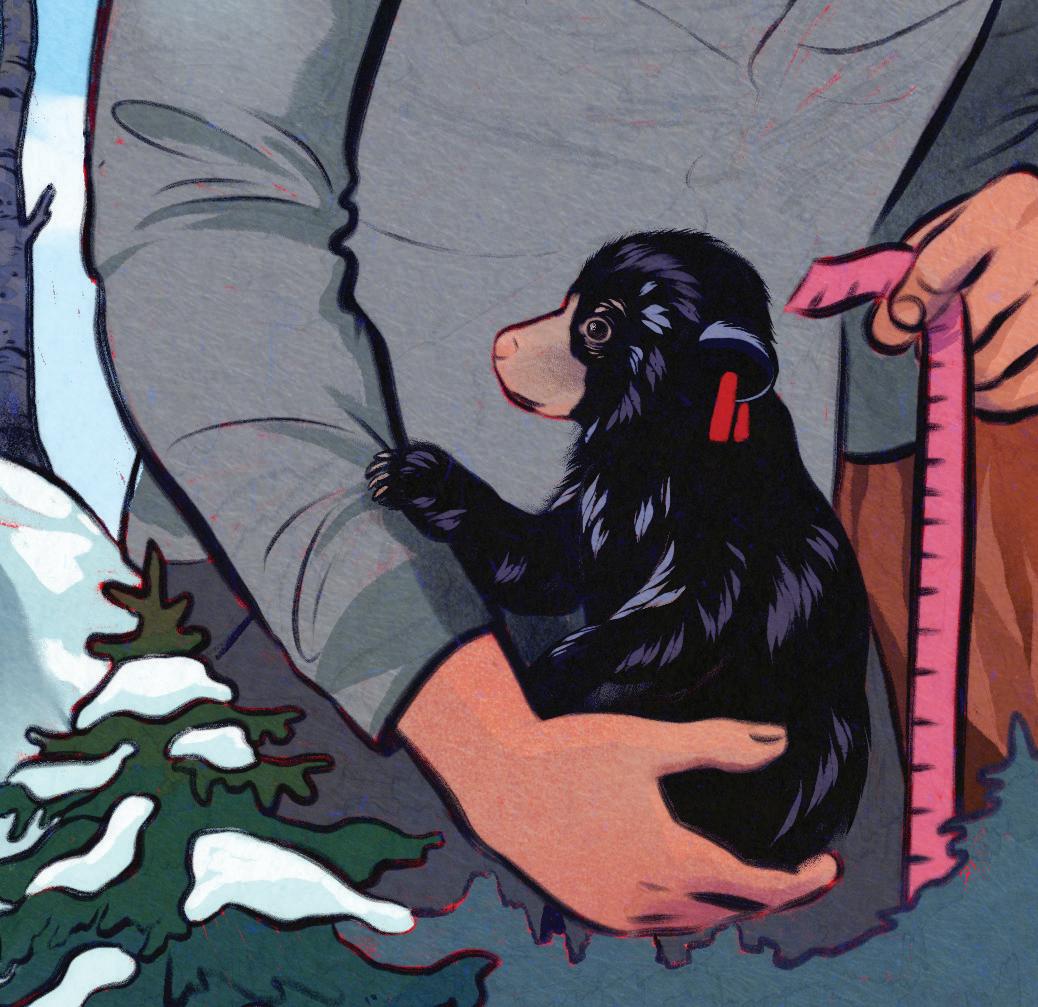

BOWDOIN MAGAZINE WINTER 2024 | CLASSNEWS@BOWDOIN.EDU 1
Connect In Every Issue 47 William Gilchrist ’06 has a ceaseless quest for growth. 51 Craig Williams ’71 on a career in catering. 55 Jen Malia ’99 writes for the neurodivergent, including herself. 4 Respond 46 Whispering Pines 64 Here
Forward
Q&A
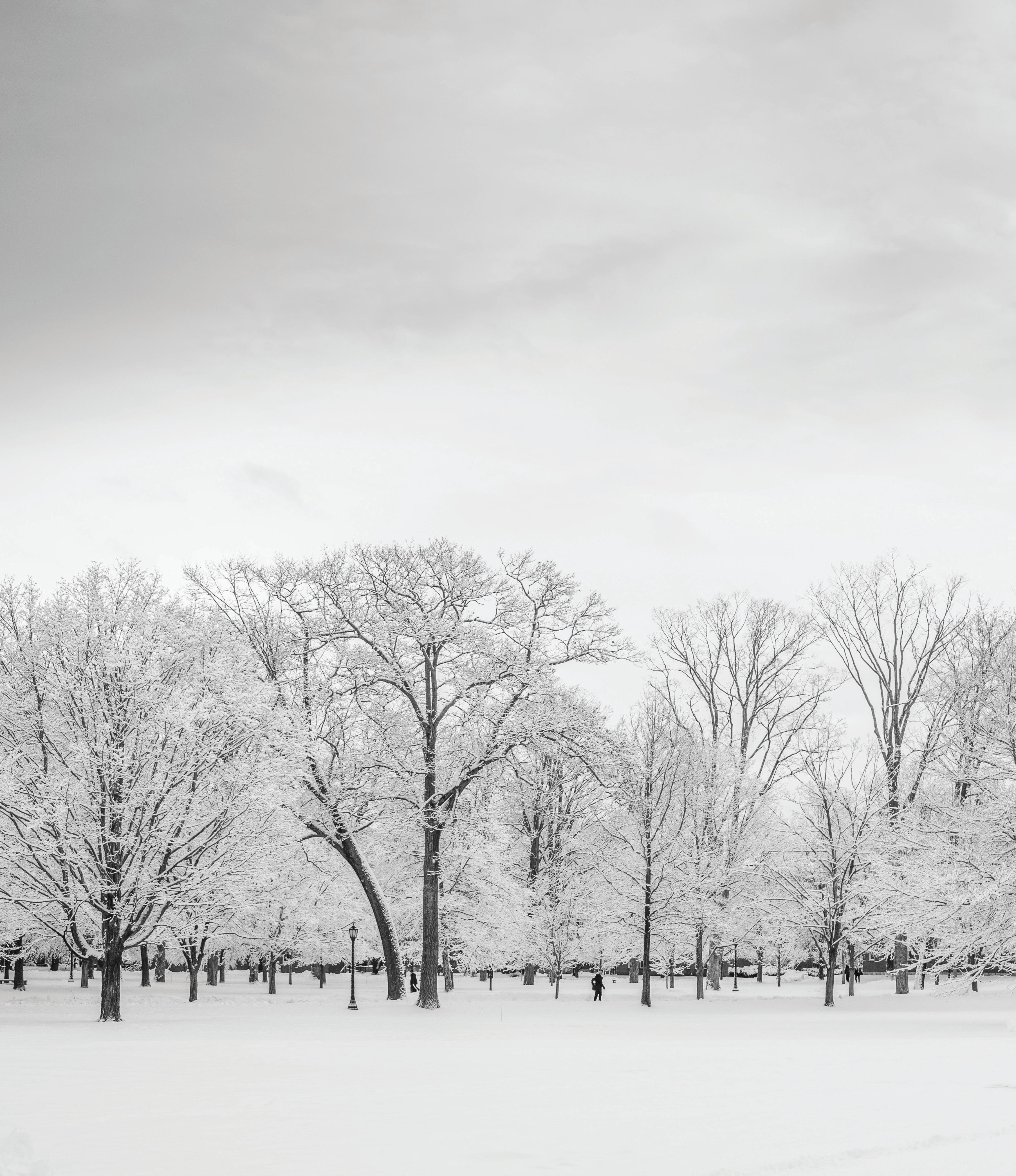
SILVER SCENE
A late January snow covered the Quad in a photogenic coat of almost silvery flakes at the end of the first week of spring semester classes.
Photo by Michele Stapleton
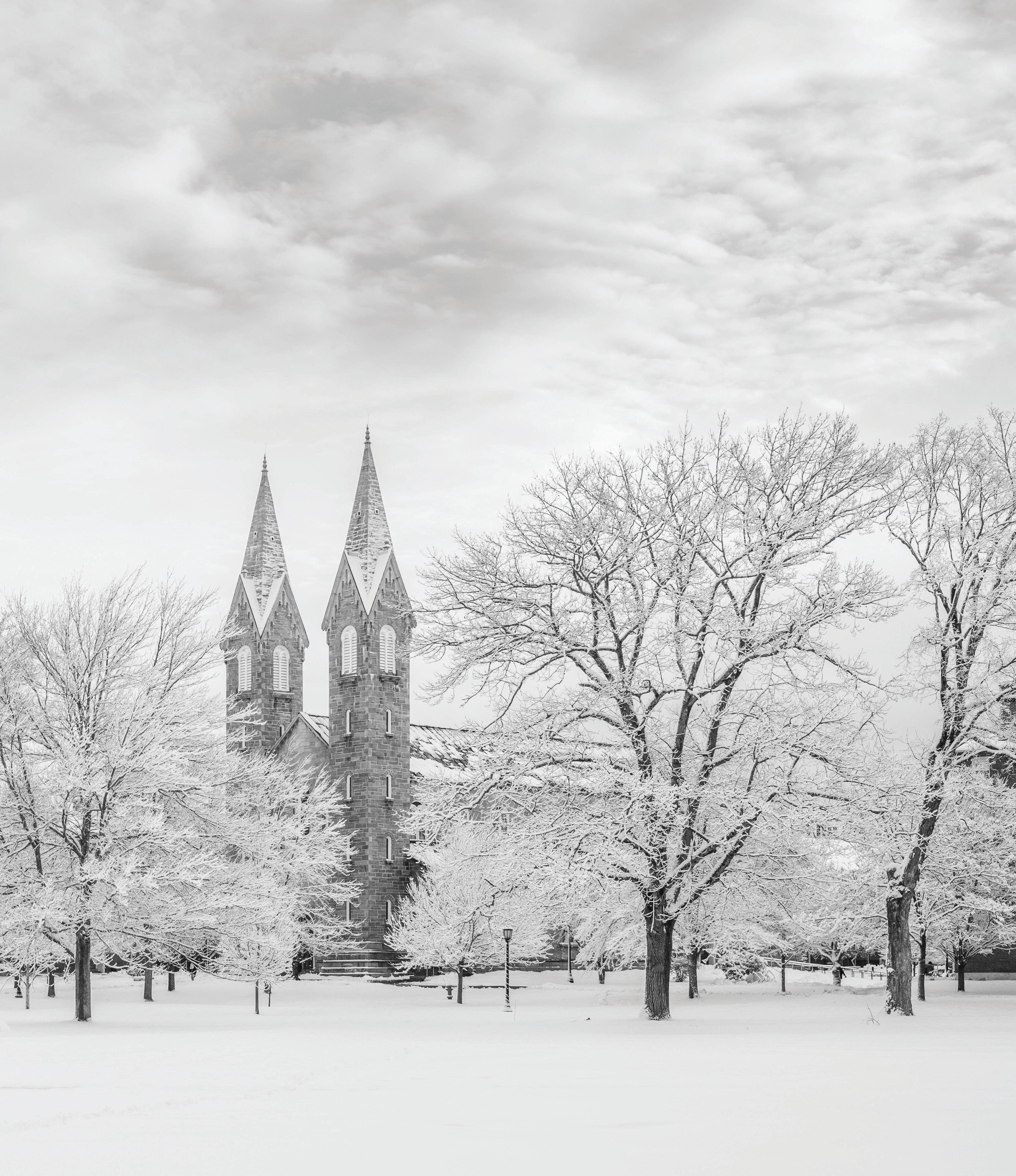
Respond

It Hit the Spot
Thank you so much for the article titled “The Very Spot” (Fall 2023). What a terrific use of grant money, the schooner Bowdoin, and the archival materials of the Peary-MacMillan Arctic Museum! I feel so much gratitude for the energy of students Aggie Macy and Lillian Frank, who clearly approached this adventure with a sense of wonder and appreciation for those who have gone before, but also an acute sensitivity to those who live in Newfoundland now. Hooray for Ms. Macy’s efforts to make new connections to the museums of these communities and provide the gift of recorded history that the Arctic museum holds. As a Bowdoin graduate who studied anthropology and natural history and sailed on schooners during and after my years at Bowdoin, I am so gratified to see the College remains connected to the schooner Bowdoin. The work of these two talented students answers the question “Why support Bowdoin College?” better than any other example I have seen in the pages of the alumni magazine since I graduated.
Arria Merrill ’85
A GREAT OPPORTUNITY
I wanted to write and say how much I loved the piece “The Very Spot.” To me, that story is what Bowdoin should be all about. What a great opportunity for those students, and I loved the focus on adventure, connecting to place, and respecting the past. Kudos to Rebecca Goldfine!
Sam Lewis ’19
MEMORIES OF DAD
I very much enjoyed the article “The Very Spot,” as it brought back fond memories of my dad, John Davis ’52. Donald MacMillan, fondly known as “Captain Mac” to my dad, was a family friend and fellow Freeport High School graduate. He made a strong impression on my father, and I believe played a role in inspiring him, in the summer between junior and senior year, to participate in a Bowdoin program, where he traveled to and spent time at a base in Greenland. As a participant, he received a proclamation, which he proudly displayed, that in August 1951 he had crossed the Arctic Circle. In 2003, he published a book about notable Freeporters and included a chapter on MacMillan. In the 1990s, he was integral to the founding of an organization known as The Friends of Peary’s Eagle Island, which led to my own involvement for a time. Last but not least, a very special memory from, I believe, 2012: my dad and I boarded the Bowdoin for an excursion from South Freeport to Portland. So, I enjoyed the article on multiple levels.
Peter Davis, Yarmouth, Maine
SEND US YOUR NEWS!
If there isn’t a class news entry for a class year, it’s because we didn’t receive any submissions for that year. We want to hear from you, and so do your classmates! Email classnews@bowdoin.edu or fill out a class news form on our website, bowdoin.edu/magazine.
MAGAZINE STAFF
Editor
Alison Bennie
Designer and Art Director
Melissa Wells
Managing Editor
Leanne Dech
Senior Editor
Doug Cook
Design Consultant
2Communiqué
Editorial Consultant
Laura J. Cole
Contributors
Jim Caton
John Cross
Cheryl Della Pietra
Rebecca Goldfine
Scott Hood
Janie Porche
Tom Porter
On the Cover: Photographs by Heather Perry
BOWDOIN MAGAZINE (ISSN: 0895-2604) is published three times a year by Bowdoin College, 4104 College Station, Brunswick, Maine, 04011. Printed by Penmor Lithographers, Lewiston, Maine. Sent free of charge to all Bowdoin alumni, parents of current and recent undergraduates, members of the senior class, faculty and staff, and members of the Association of Bowdoin Friends.
Opinions expressed in this magazine are those of the authors.
Please send address changes, ideas, or letters to the editor to the address above or by email to bowdoineditor@bowdoin.edu. Send class news to classnews@bowdoin.edu or to the address above.
4 BOWDOIN MAGAZINE WINTER 2024 | CLASSNEWS@BOWDOIN.EDU
PHOTO: LILLIAN FRANK ’25
AMY DIONNE EXECUTIVE ASSISTANT, FINANCE AND ADMINISTRATION
CREATIVE AS THE DAY IS LONG
I can’t image my life without the magic of creativity woven into every part of who I am.
These days, I dance, write, and craft, but I’ve been part of the creative world since I was young, taking part in chorus, band, and theater throughout grade school.
The dance studio is definitely my happy place. I took my first modern dance class in college for my theater degree and jumped in with both feet. I continue to dance multiple days a week at a local studio.
I’ve been a writer and poet since I was young, with stories and poems in scattered notebooks as a constant companion no matter where I am. I have multiple novels in progress, all in various drafts—mostly fantasy, leaning toward magical realism with paranormal elements. And when I’m not creating, my nose is buried in a book. With a cat or two close by.
I grew up surrounded by handcrafts—quilts, sewing, embroidery, and crochet. The women in my family were all practical, and I inherited that love of making everyday things both functional and beautiful.
Being creative fills my life with meaning. The challenge is there’s only so much time and energy in a day. I have so many creative projects in progress that it’s not easy to stay focused on finishing them.
Being an executive assistant for Matthew Orlando, Bowdoin’s senior vice president for finance and administration, gives my day-to-day life a necessary structure, even though my days are never the same. I love being part of the finance and administration division, and I’m glad to support my office and help make their days run smoothly. It lets me be a part of the inner workings of the side of the College that many don’t see—and pursue my creative projects in my “down” time.
For more from this interview, visit bowdoin.edu/magazine.
PHOTO: CHRISTINA WNEK
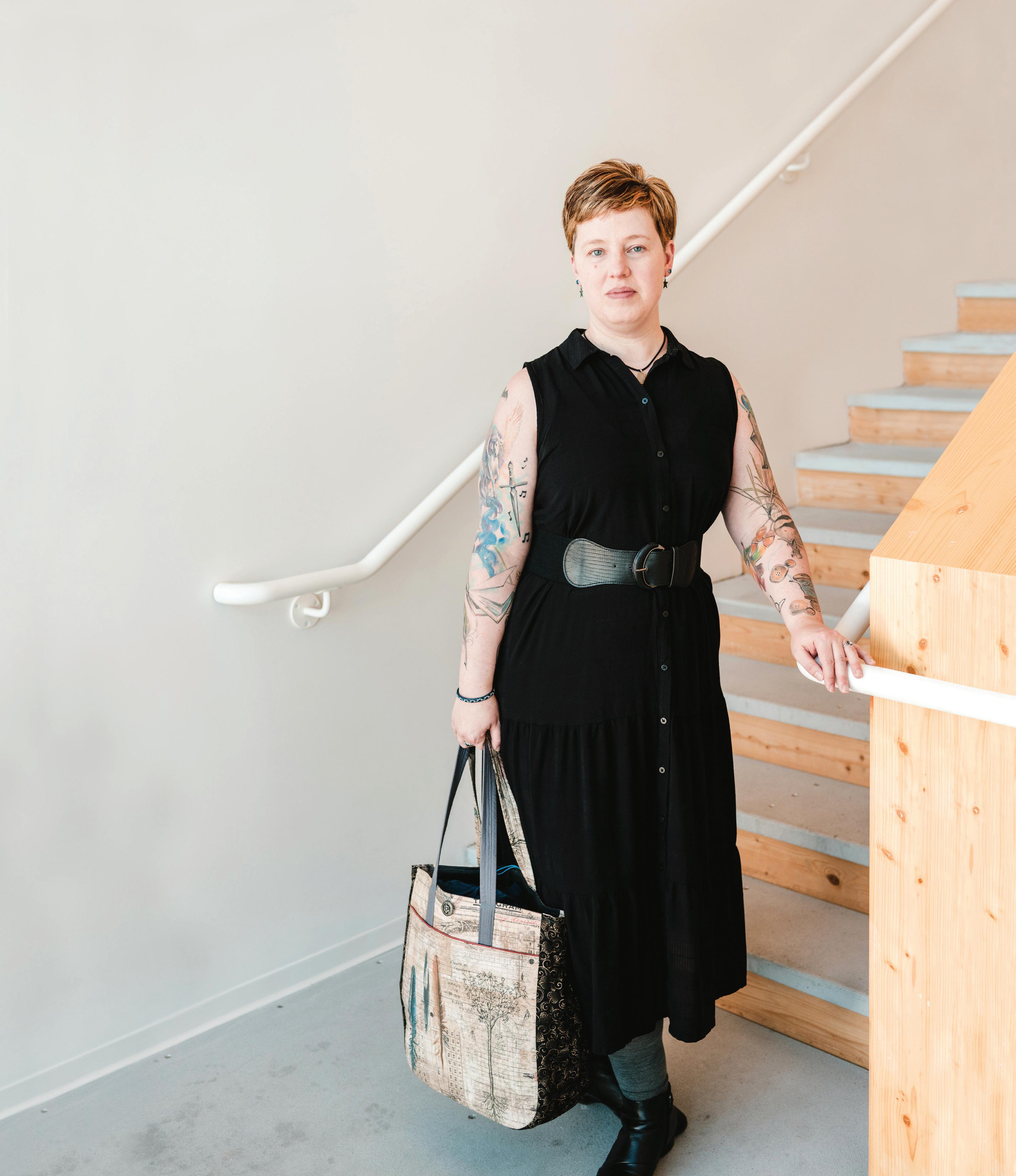 FROM BOWDOIN AND BEYOND
FROM BOWDOIN AND BEYOND
When Amy Dionne isn’t working as an executive assistant at Bowdoin, the self-proclaimed introvert and pagan can be found dancing, writing, reading, or making fabric arts like the bag she created and is holding here.
Forward
Bowdoin Records
With the help of Brunswick journalist Lisa Bartfai, Bowdoin’s faculty apply their storytelling talents to the podcasting realm.
A TERRIBLE LOVE
Nadia Celis, professor of Romance languages and literatures and Latin American, Caribbean, and Latinx studies, continues to investigate the true story of Margarita Chica Salas, the woman behind the character of the bride in Gabriel García Márquez’s novel Chronicle of a Death Foretold. After her 2023 Spanish-language book about Salas became a bestseller, Celis started work on a bilingual podcast to share the story with English listeners. The eight episodes, which will be produced with Futuro Studios and Brunswick-based journalist Lisa Bartfai, have “a fantastic narrator, a personal connection, global relevance, the true crime [angle] that a lot of podcast listeners look for, and also a passionate love story,” Bartfai said.
LITERARY HOMES
For years, Tess Chakkalakal, associate professor of Africana studies and English, fought to preserve Harriet Beecher Stowe’s house in Brunswick. Her efforts brought her in contact with other literary homes and amplified her interest in these architectural relics of long-gone writers. This spring, she’ll start recording a new podcast, Dead Writers, with Brock Clarke, A. LeRoy Greason Professor of English and novelist, as cohost. Bartfai will produce the show. Traveling around Maine, the three will explore the people and homes associated with Nathaniel Hawthorne, Henry Wadsworth Longfellow, Edna St. Vincent Millay, and others, chatting—and cheerfully arguing—about the purpose of literary houses.

FACULTY TALKS
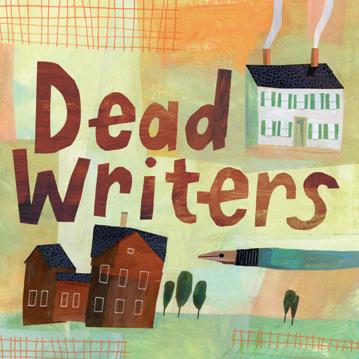
The College’s own podcast, Bowdoin Presents, addresses current topics in our classrooms, on campus, and in culture. In the latest season, produced by Bartfai, Associate Professor of Music Tracy McMullen—a saxophonist and composer— discusses jazz as a moral practice and how she uses music to teach anti-racism and inclusivity. Other episodes feature faculty talking about US economic history, global literature and the digital humanities, the reinvention of museums during the pandemic, and the spread of information in medieval times. Look for season three later this semester.
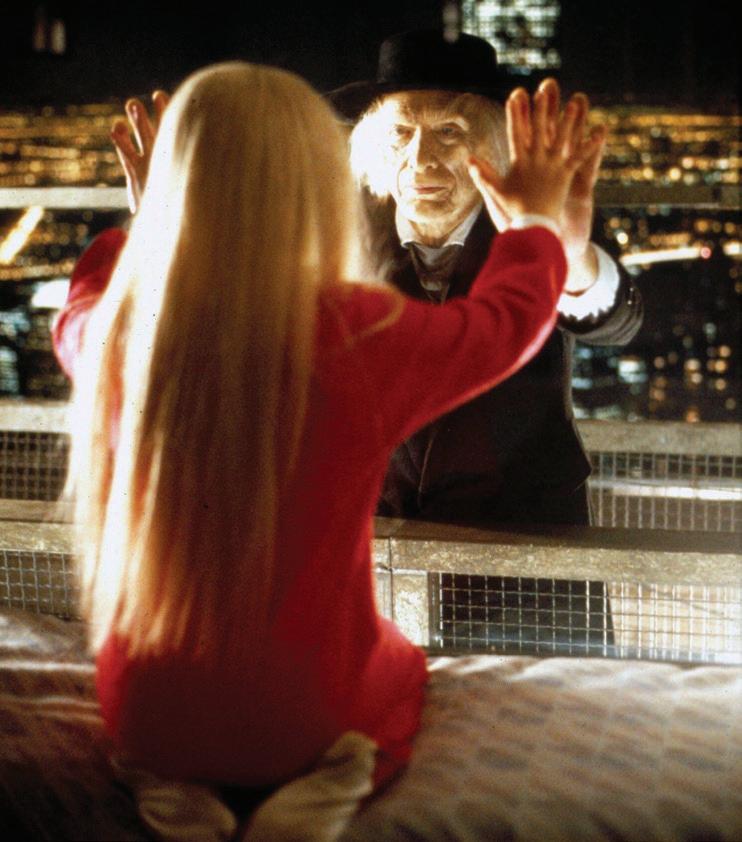
Reimagining Poltergeist
WHILE THE CONCEPT of the 1988 horror film Poltergeist III is decent and the visuals (very ’80s) are good, that’s where any hint of praise ends, at least for Cody Charrier, who has worked as a Thorne Dining Hall card checker since 2017. Besides its narrative inconsistencies, “story-wise it was a disaster. And the story keeps changing pace. On top of that, they have too many people screaming ‘Carol Anne’ over and over. No one would ever name their child Carol Anne after seeing the movie,” he said.
Charrier has been a cinema buff since he was a kid growing up in Newport, Maine, with his movie-loving mom. During COVID, he started tuning in to Jaguar Sharks’ The Film Rescue Show, a podcast that explores alternative plots to movie flops. He pitched his revision of Poltergeist III to the podcast, and the hosts invited him to chat about why his version would have saved it from failure. Their interview has yet to be scheduled, Charrier said.
When he’s not watching movies and dreaming up better endings to them, Charrier is writing a fantasy novel. His job at Thorne provides endless fodder for his imagination. “You get exposed to people, which is good, because that is where you get ideas,” he said.
6 BOWDOIN MAGAZINE WINTER 2024 | CLASSNEWS@BOWDOIN.EDU Forward ILLUSTRATION: (DEAD WRITERS) MARK HOFFMANN; PHOTO: ( POLTERGEIST III ) MGM
Staff
Faculty
Dine
Shrimp and Artichoke Hearts
Recipe by Dale Syphers
Professor of Physics Dale Syphers calls this dish one of his “favorite fast meals.” It’s bright, speedy, pantry-friendly, and flexible for the type of ingredients you have on hand.
White or brown rice
1 pound cooked shrimp, peeled and deveined
2 tablespoons olive oil
6 to 8 small shallots, chopped finely
14-ounce can of diced tomatoes or the equivalent amount of fresh 12-ounce can of artichoke hearts (not marinated)*
2 tablespoons fresh lemon juice
2 to 3 tablespoons white wine, preferably sauvignon blanc (optional)
Salt and freshly ground black pepper
*If you wish, you can use fresh artichokes. After steaming them, remove the leaves and choke and quarter the hearts.
Cook the rice according to package directions to make enough for four servings. While the rice is cooking, thaw the shrimp if frozen. Remove the tails from the cooked shrimp. Cut up the shrimp if they are large or keep them as is, according to your taste.
Heat the olive oil in a large skillet over medium heat. Add the chopped shallots and sauté, stirring occasionally, until translucent. Stir in the diced tomatoes. Drain the artichoke hearts, cut them into quarters, and add them to the skillet, stirring until the mixture is heated through. Add the shrimp and the lemon juice, along with the wine if you are using it, and stir to combine. Season with salt and freshly ground black pepper to taste. Serve over the rice.
Professor of Physics Dale Syphers, who first submitted this recipe as part of a 2007 faculty and staff collection, earned his PhD in experimental solid state physics at Brown University.
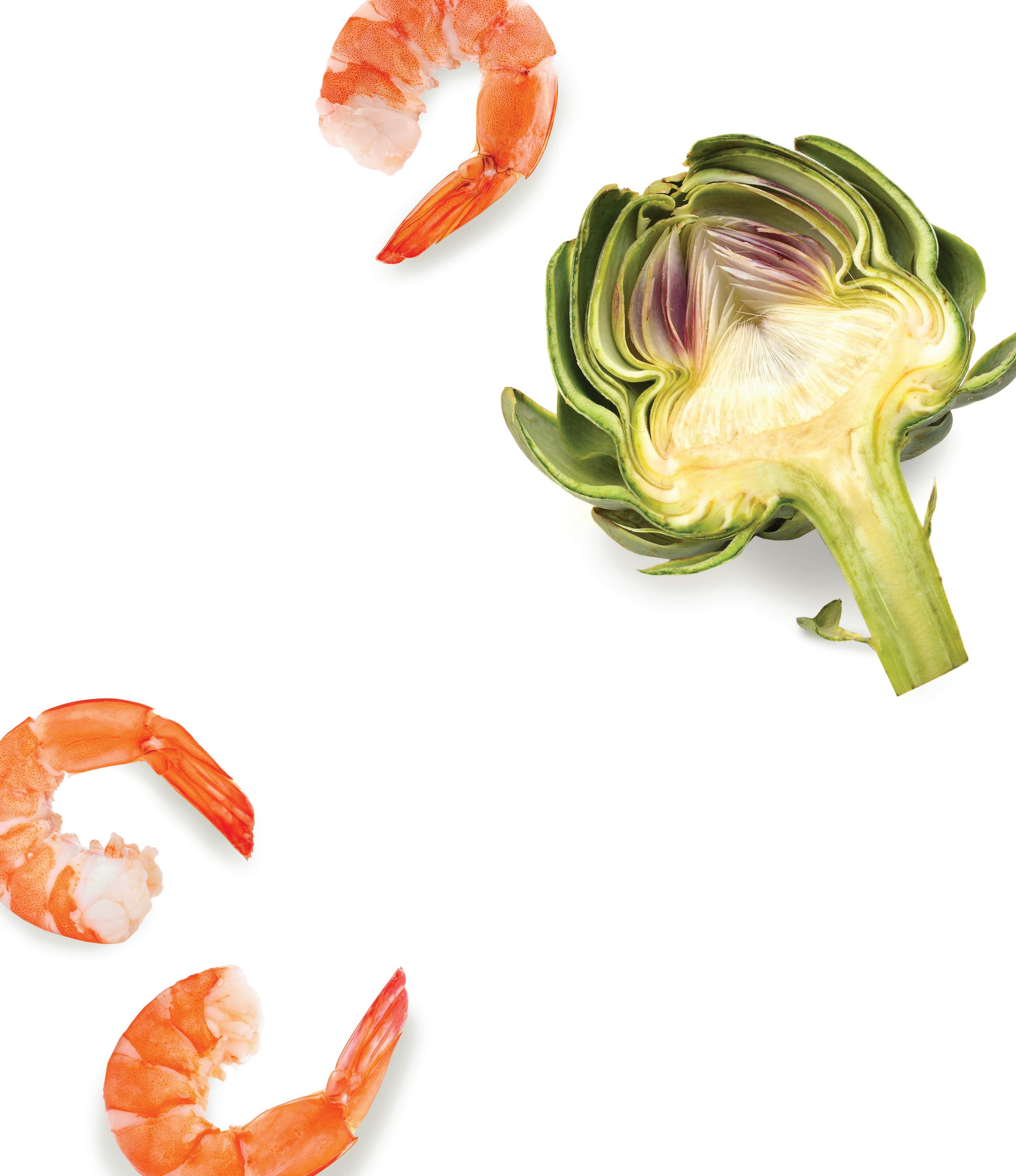
DID YOU KNOW?
Castroville, California, home to the annual Artichoke Festival, calls itself the artichoke center of the world. Each year, the festival crowns an annual artichoke queen—the first recipient of the title, crowned years before the festival began, was none other than Marilyn Monroe. “Norma Jean, artichoke queen” appears in many biographies written about Monroe’s life, and the sash from her award is displayed in the Castroville Chamber of Commerce. The 2024 festival theme is “Where Fun Blossoms,” and in addition to naming a new queen (and king), there will be comedy, a celebrity chef, and a Prince tribute band.
BOWDOIN MAGAZINE WINTER 2024 | CLASSNEWS@BOWDOIN.EDU 7
Forward
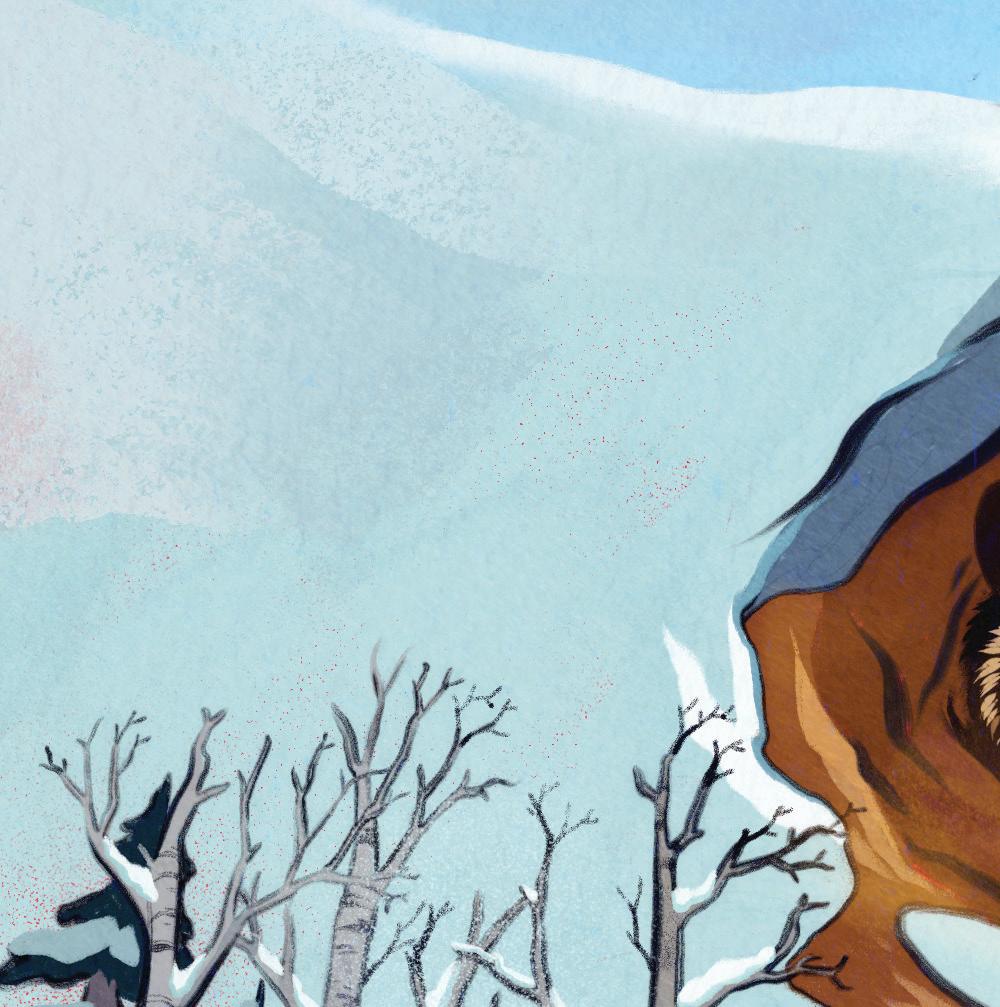
Bears give birth to their cubs in the winter den, and the mother bear and cubs emerge from the den together in the spring. Cubs stay with the mother for the whole year, going back into the den with her the following winter and only separating from her when they are sixteen to eighteen months old.
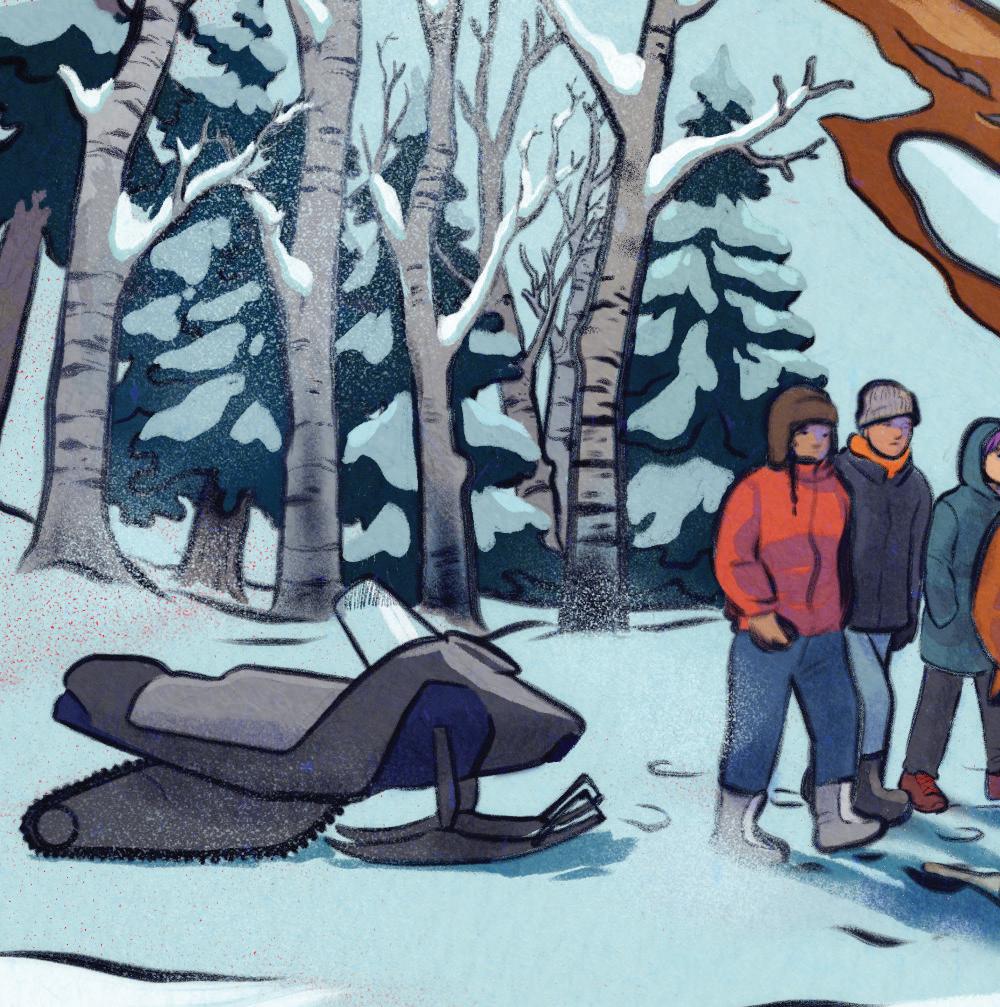
Did You Know?
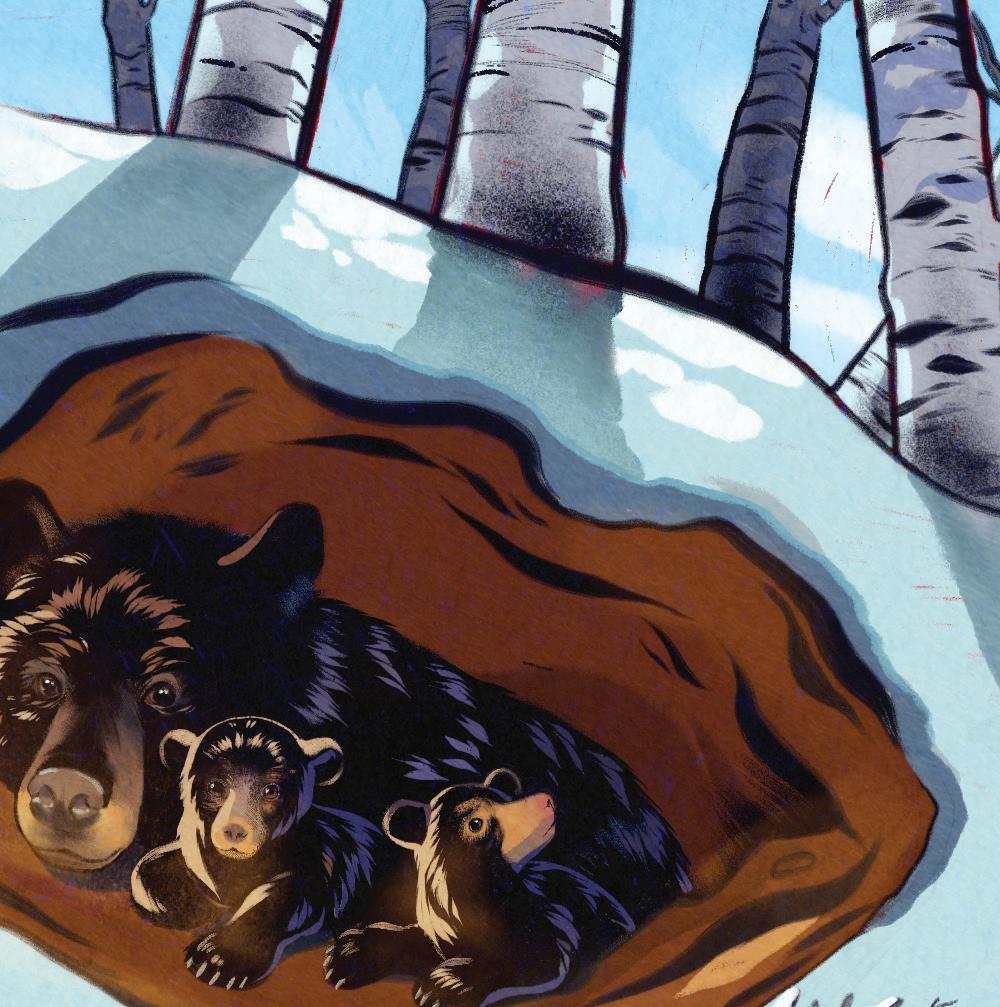
The team takes measurements of cubs, gauges their ages, and tags them for future identification. Female yearlings are fitted with radio collars to monitor their movements and help the biologists find their dens and any cubs they have once they begin to breed.
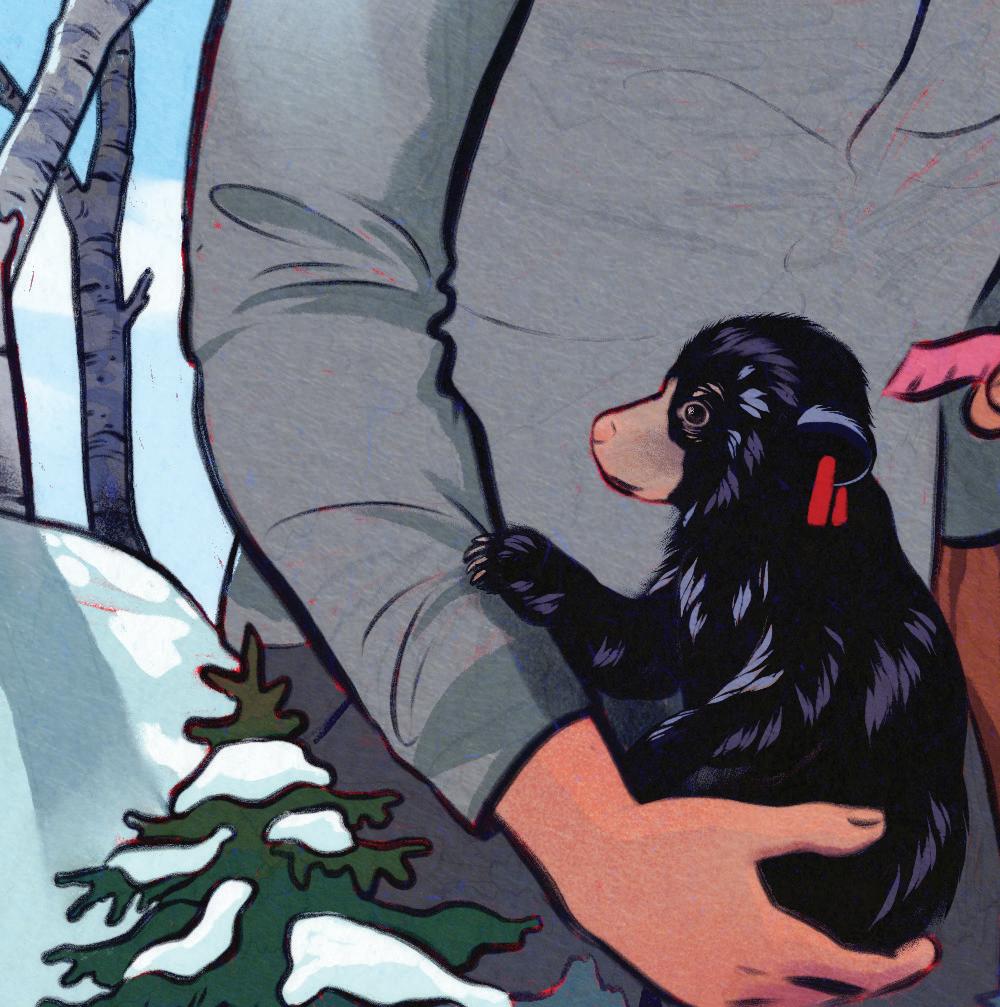
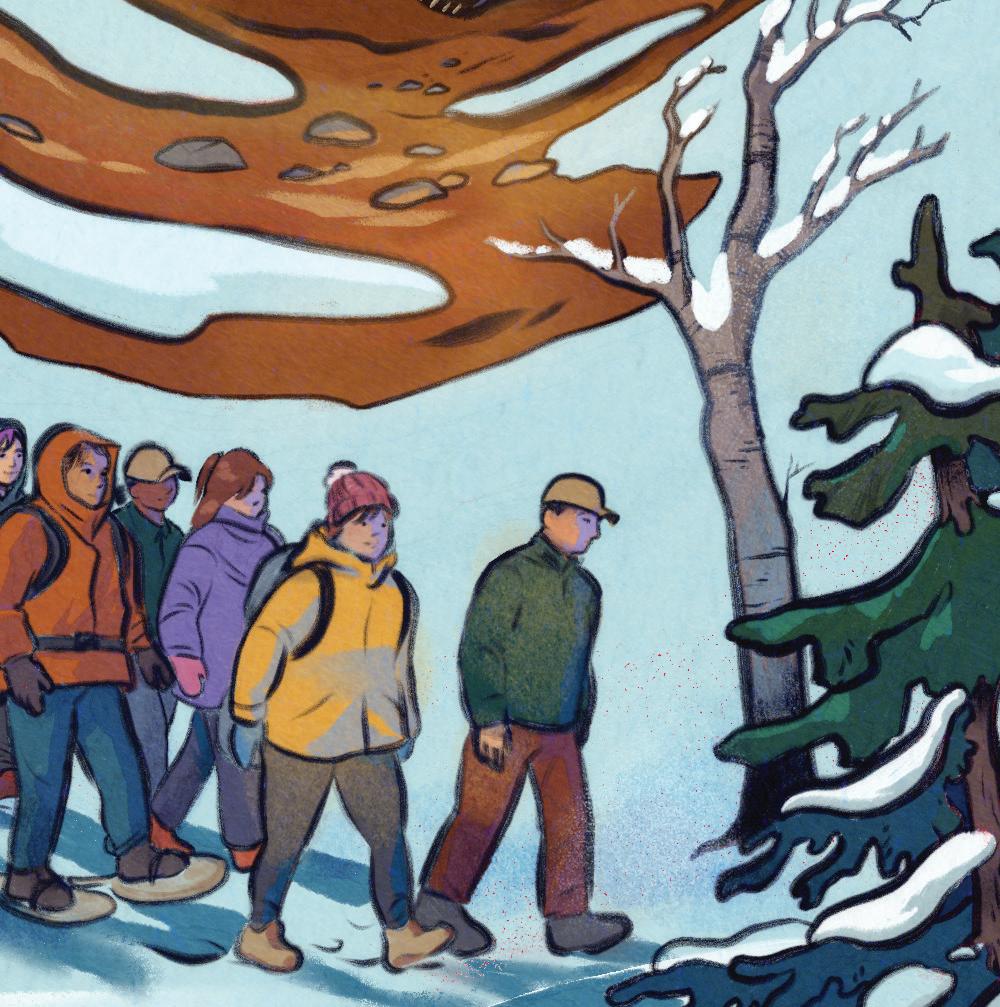
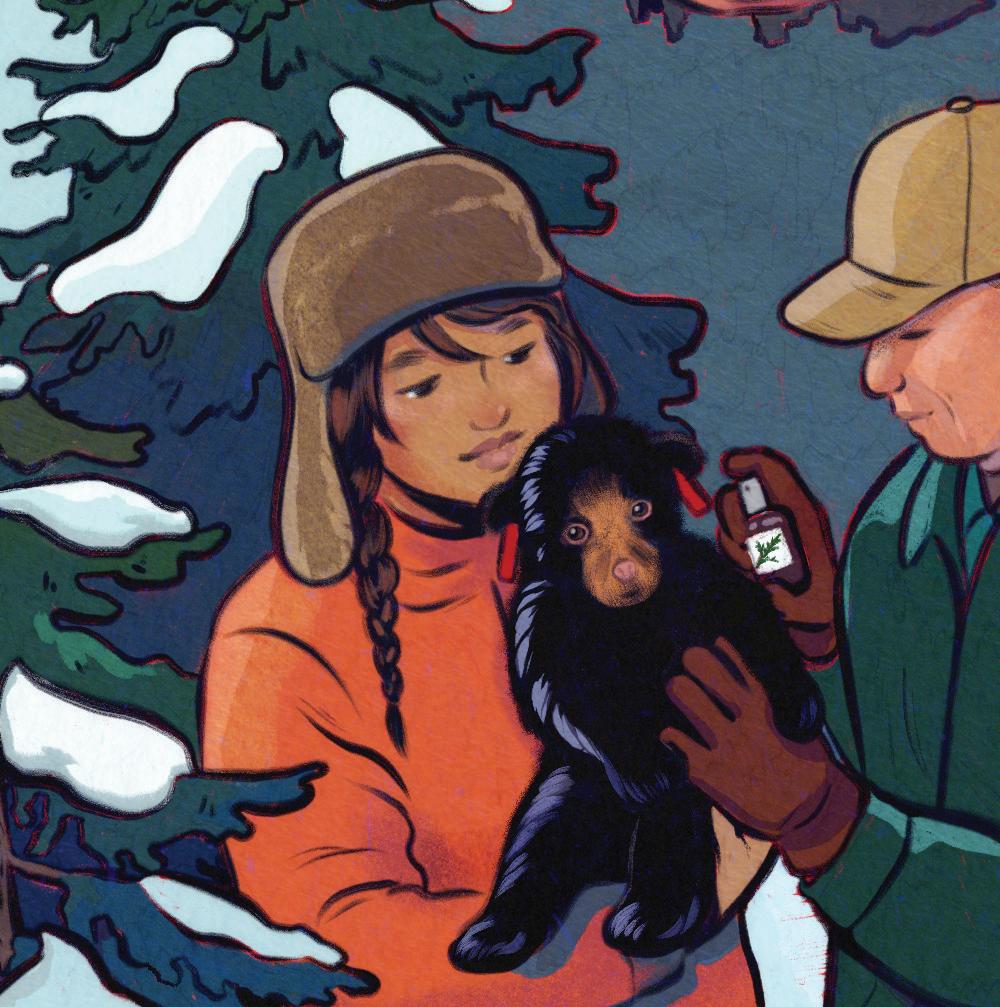
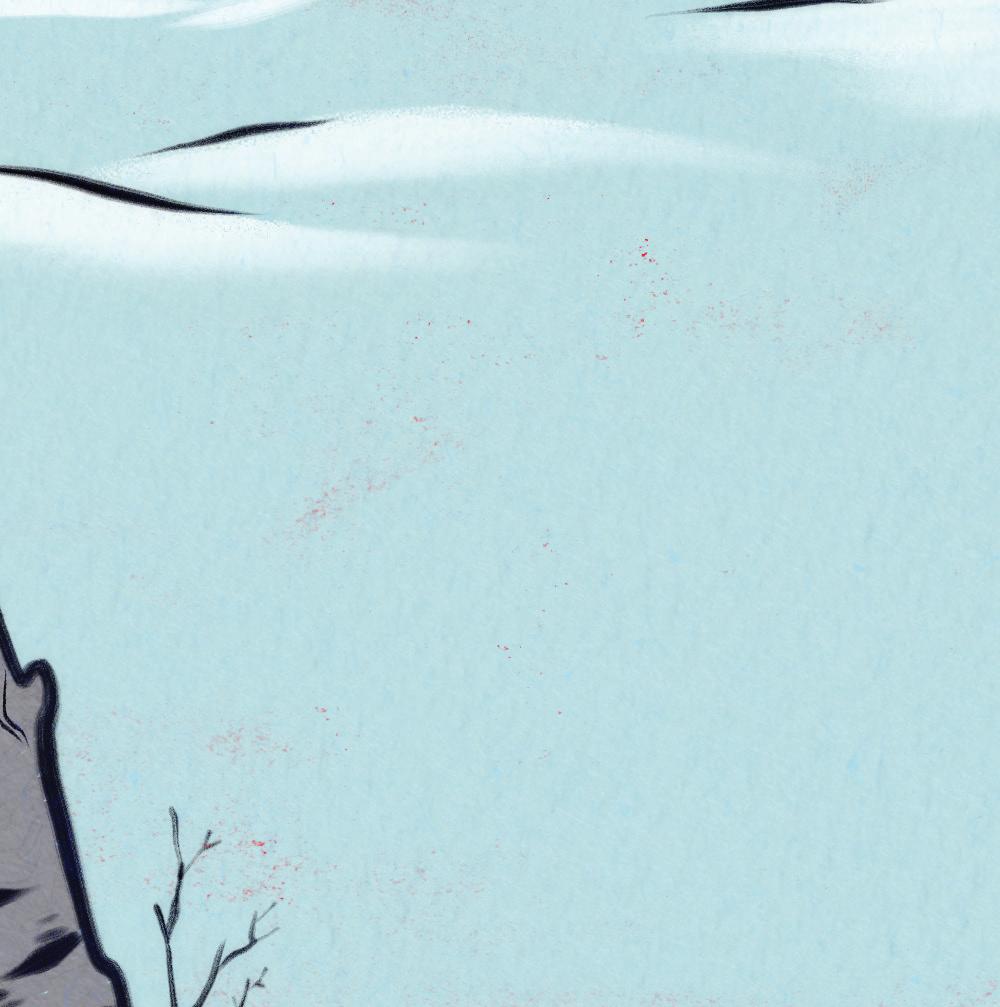
Bearing Witness
In winter, Maine black bears enter a state of torpor, a kind of twilight sleep—a perfect time for scientists to get close and collect data.
Illustration
by Natasha Donovan
Bowdoin students have traveled with bear biologists in Maine’s Department of Inland Fisheries and Wildlife many times during a long-term study that began in 1975 and that now tracks seven generations of black bears to keep tabs on the population. The department makes time to include students from Maine colleges and universities as part of its efforts to build awareness of the importance of wildlife management and monitoring. Of the approximately thirty-five thousand bears in Maine, the state biologists visit and check on the ones in eighty to a hundred or so dens. The students who go along with the biologists help to collect data and often do a lot of cuddling with the cubs. This year, those enrolled in Biology 3308 dressed warmly and traveled three hours north to meet up with the scientists at the Airline Snack Bar halfway between Bangor and Calais on Route 9, where, with little snow so far in the season, they set off on foot to get to the den.
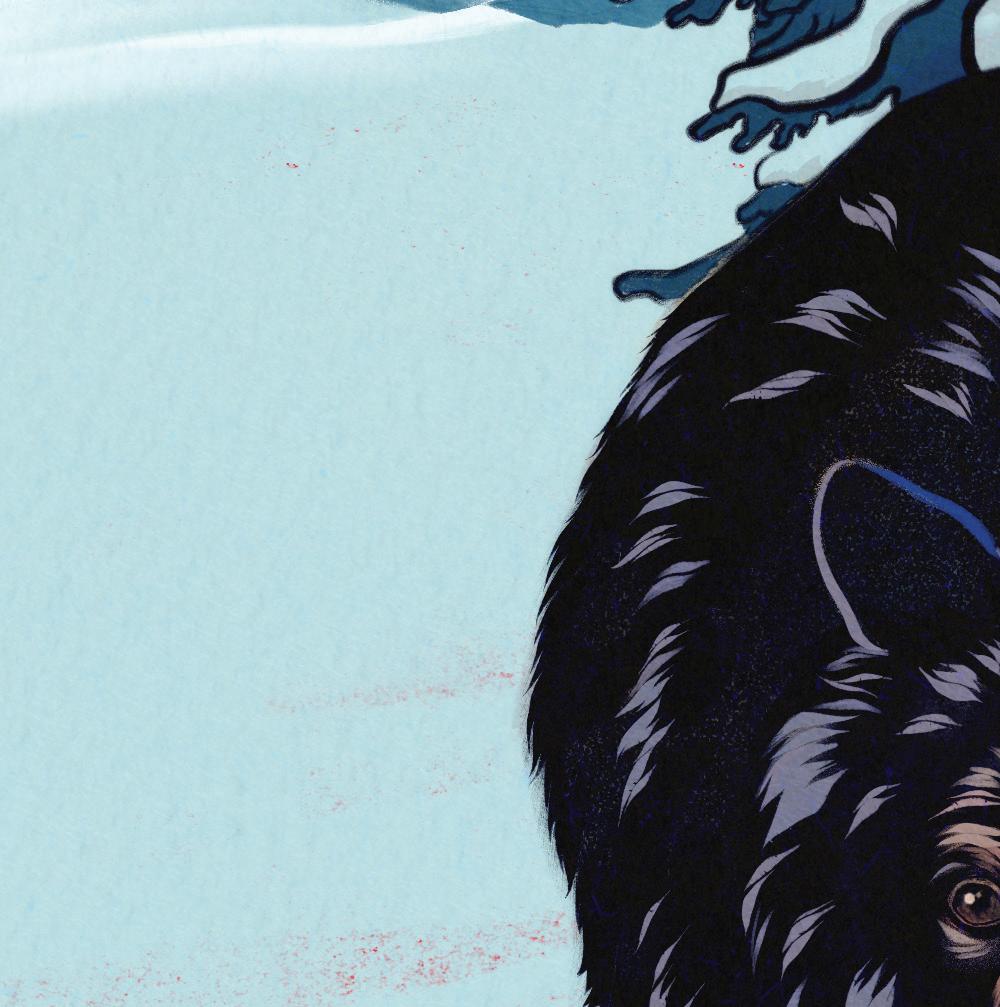
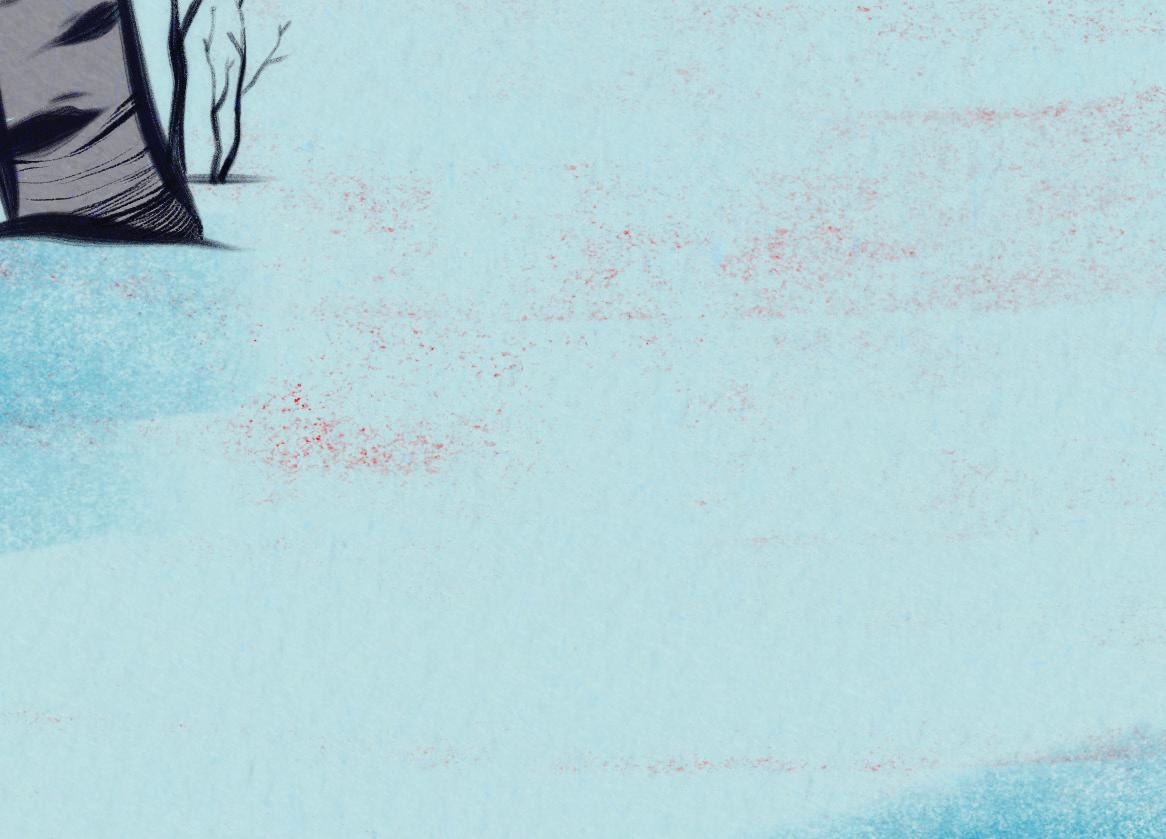

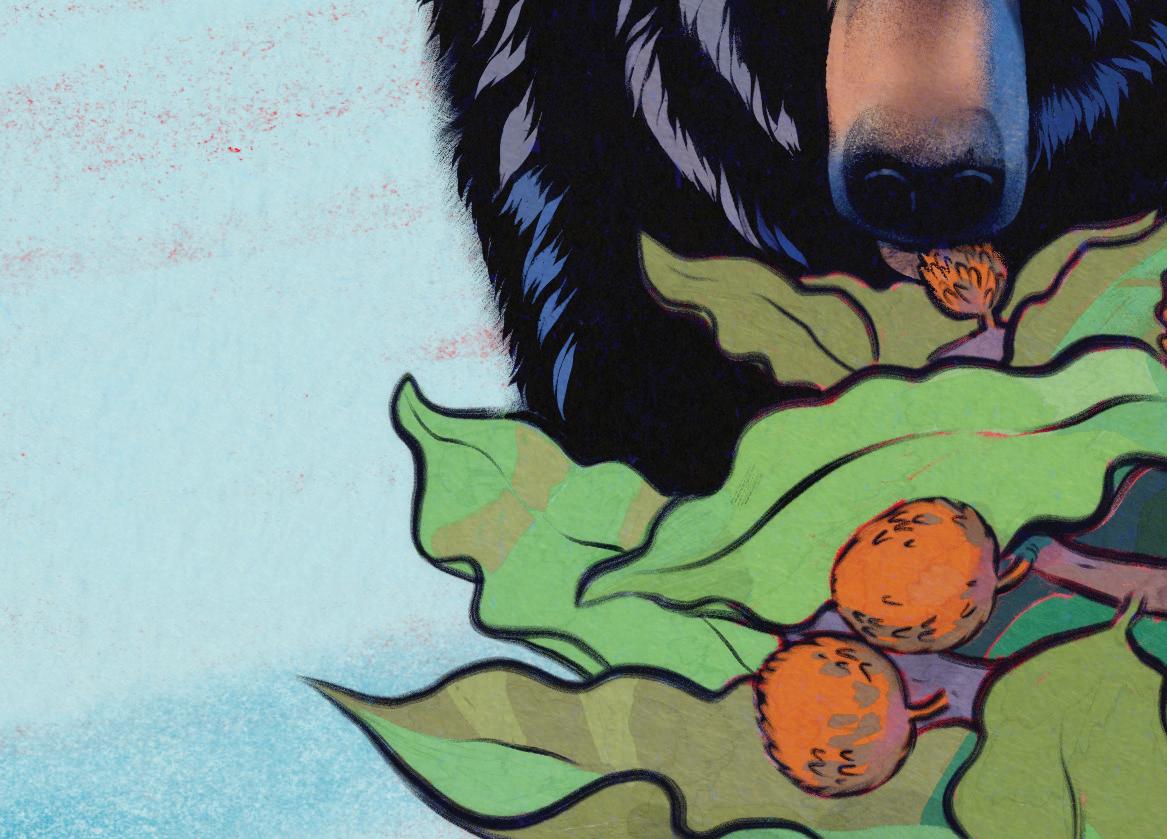
The Maine biologists observed synchronicity between Maine’s beechnut production, which would alternate a heavy year with a light year, and the number of bear cubs. On years when beechnuts were scarce, females would not be as fat going into the den and would not give birth. That beechnutbear cub pattern no longer holds, as beech trees have declined in Maine and bears have become less dependent on the crop.
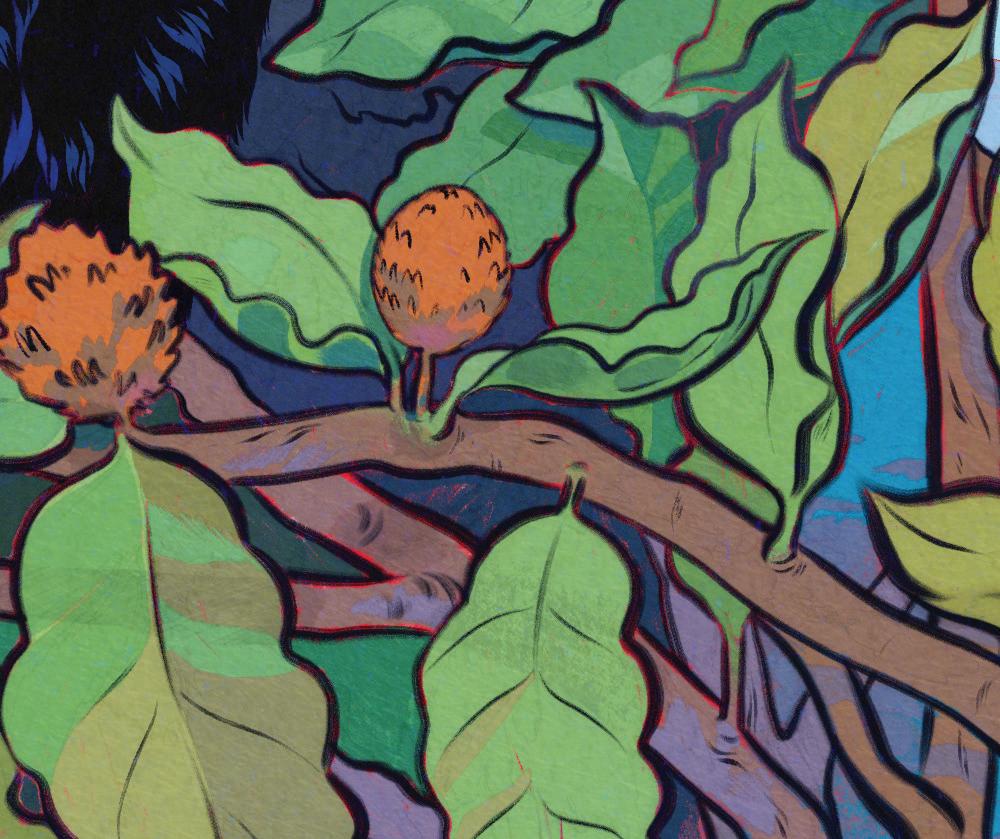
8 BOWDOIN MAGAZINE WINTER 2024 | CLASSNEWS@BOWDOIN.EDU
To mask the smell of human handlers, cubs are scented with cedar oil or boughs before they are placed back in their dens.
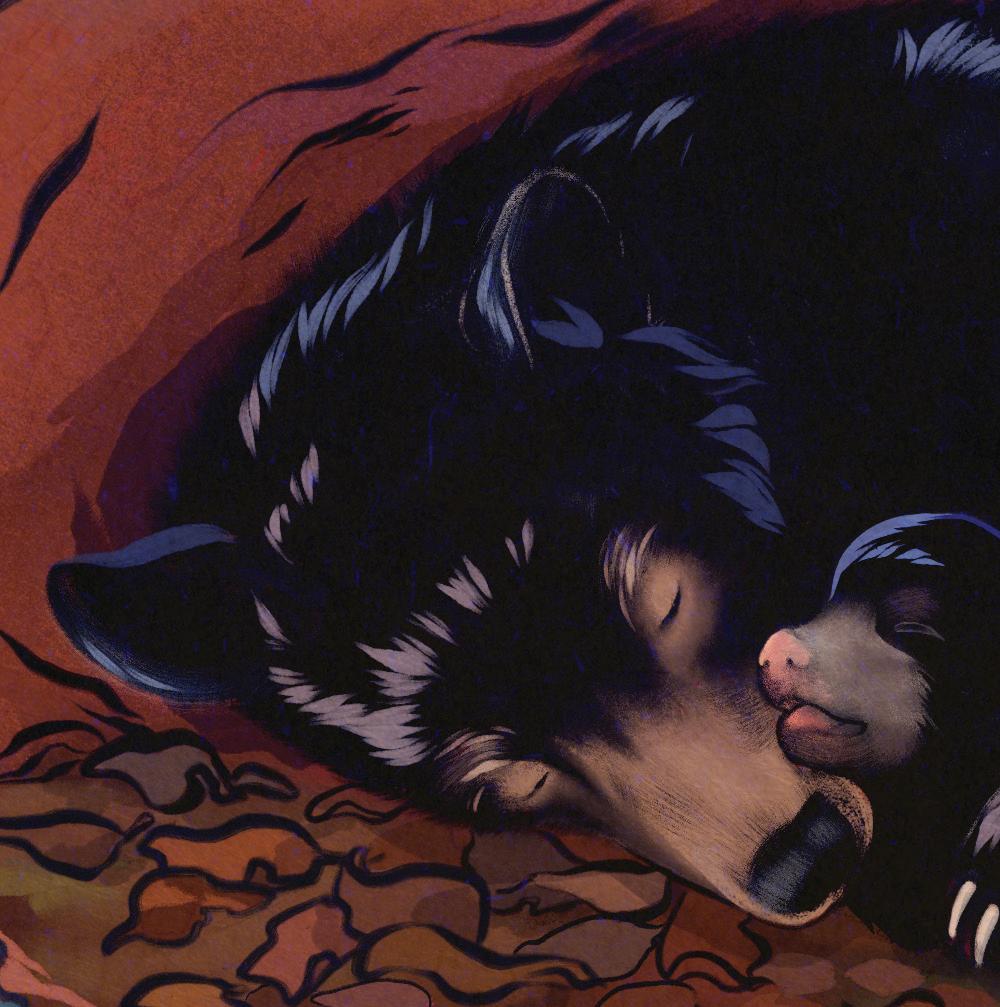
Bears breed in summer, but the fertilized eggs do not implant in the womb until months later when they go into the den, and only then if the female has the fat resources to maintain the pregnancy and give birth to cubs during hibernation.
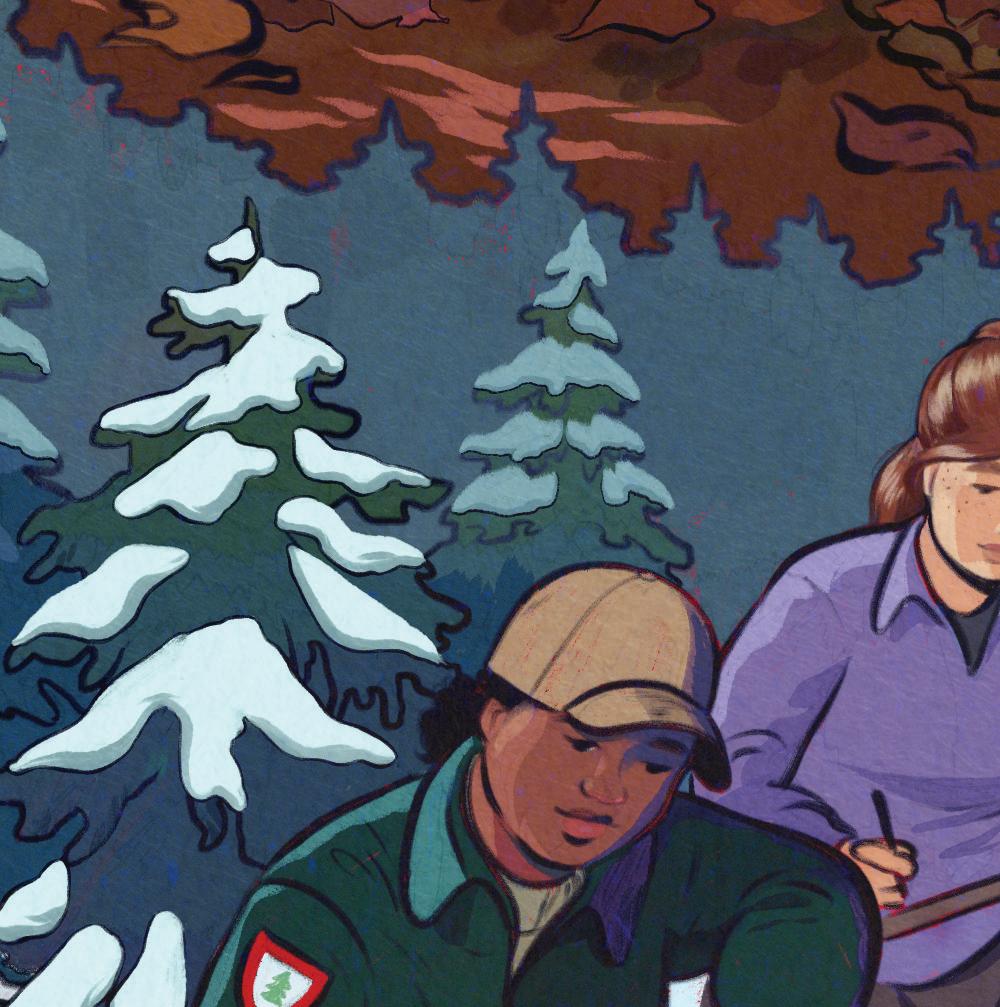
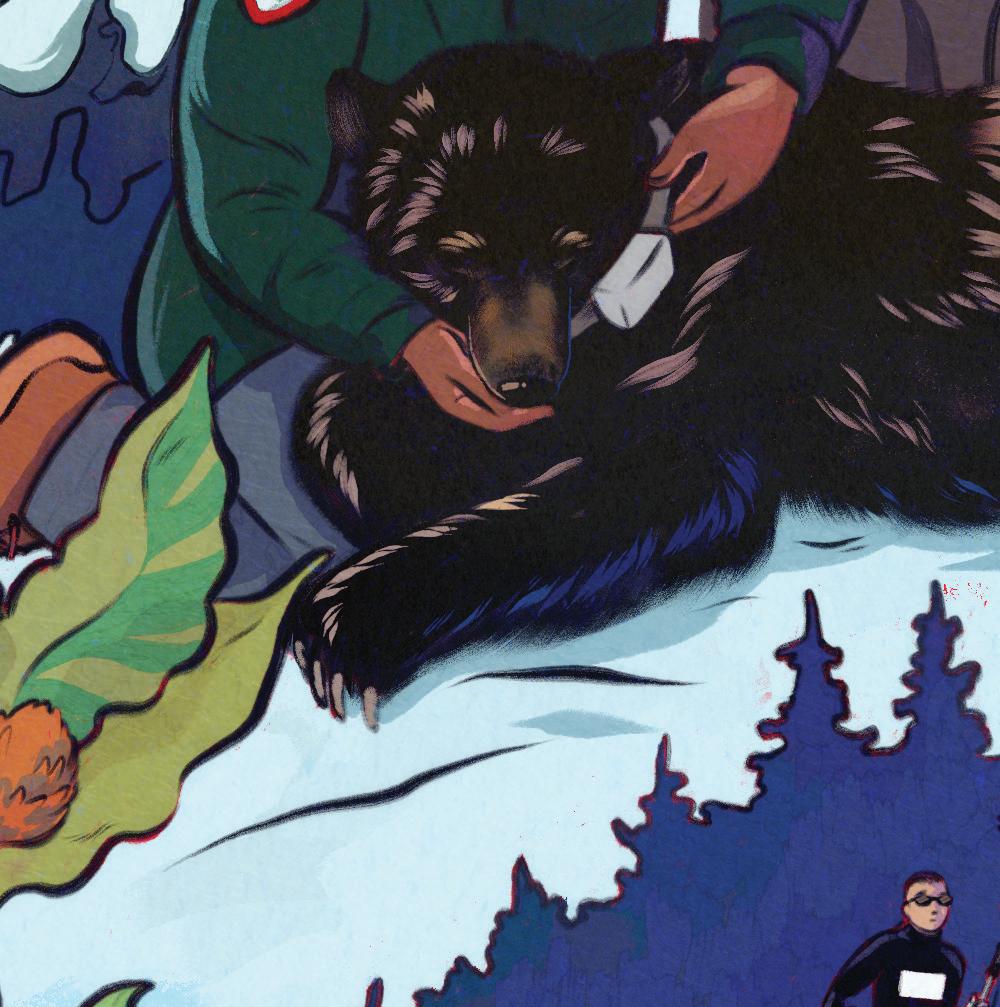
Black bears are found statewide, but are most common in northern and eastern Maine. They are capable of surviving for thirty years in the wild.
Radio collars on the bears show that the average range of female bears in Maine is six to nine square miles and that males travel much farther—a hundred square miles or more.
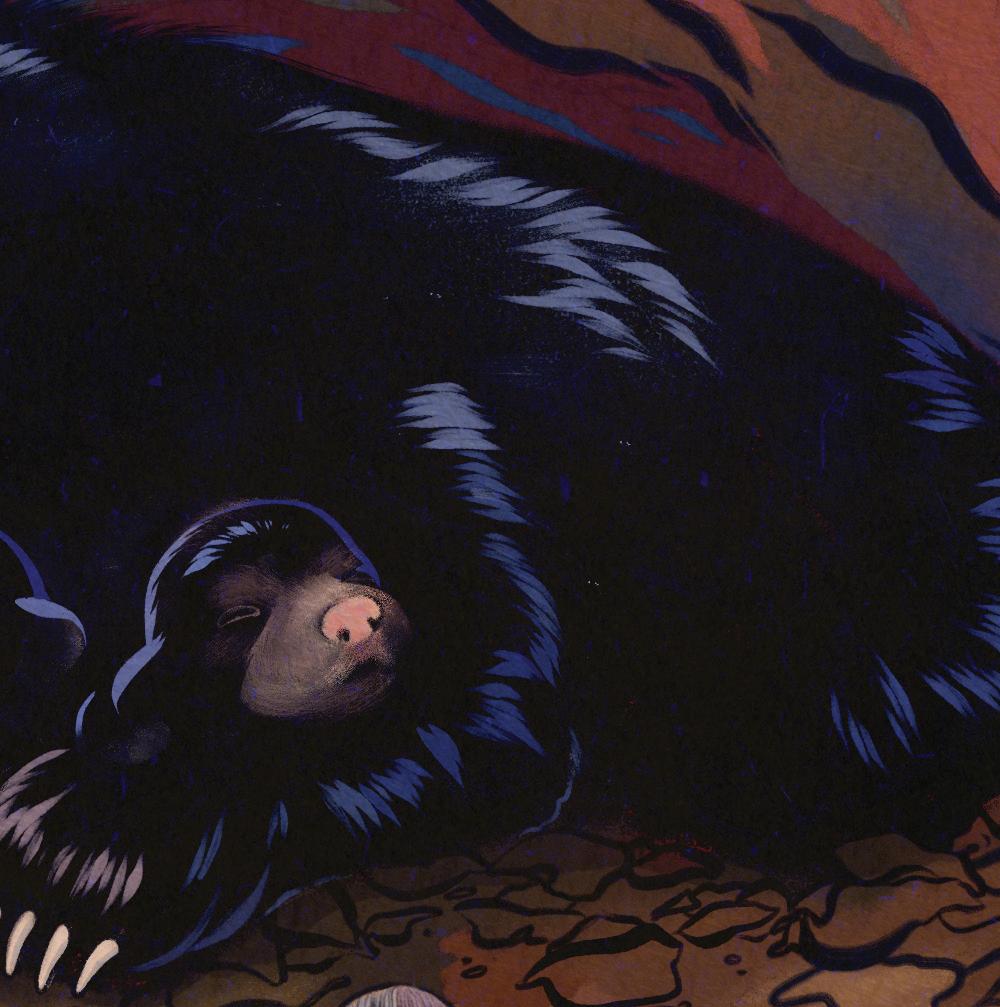
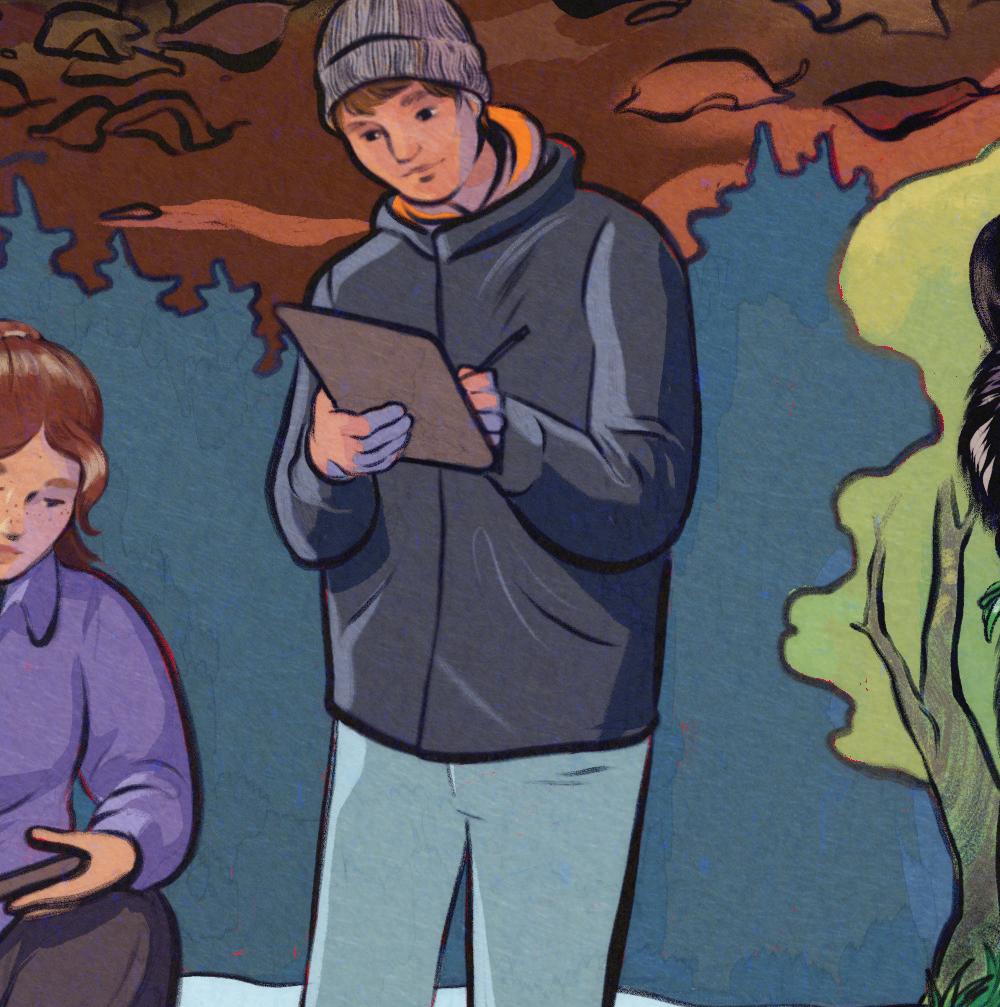
Bears are opportunistic eaters, meaning they eat a wide variety of foods and are adaptable to whatever is available, but they mostly eat plants. They consume the most food in the fall to build fat stores for the winter.
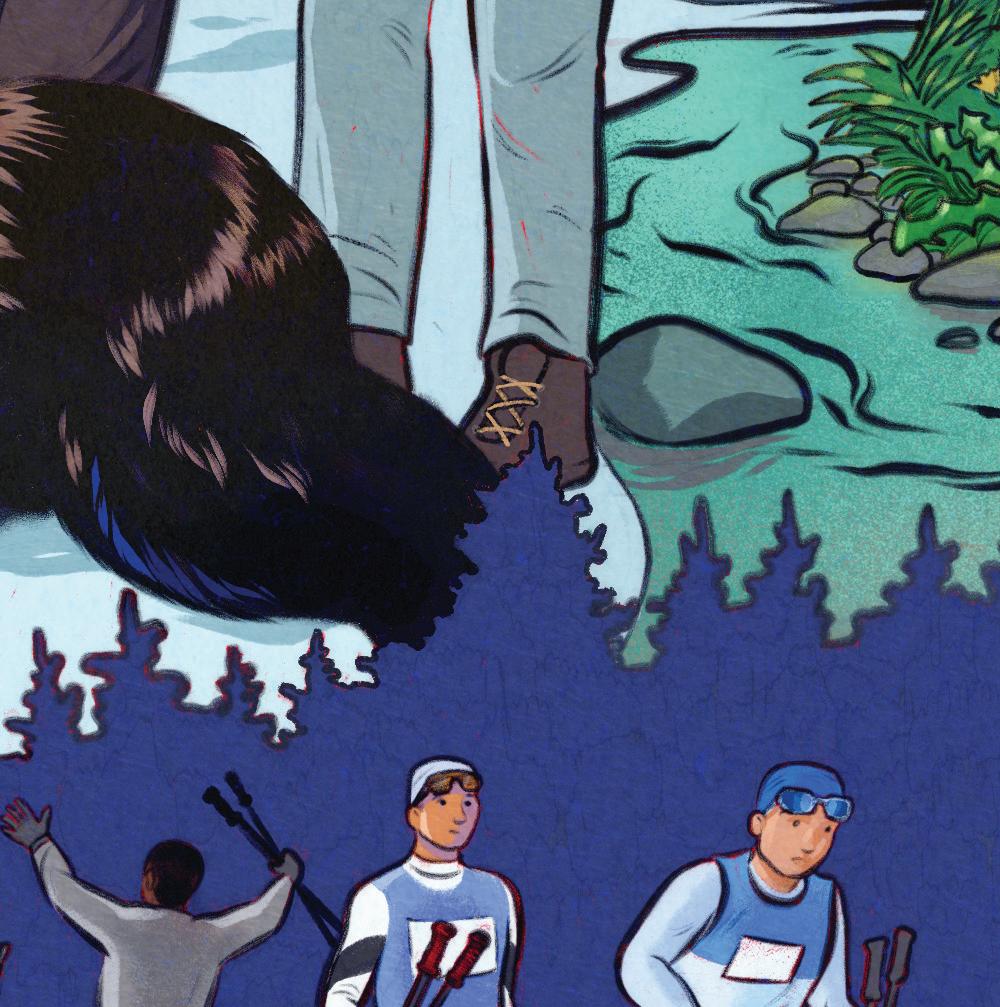
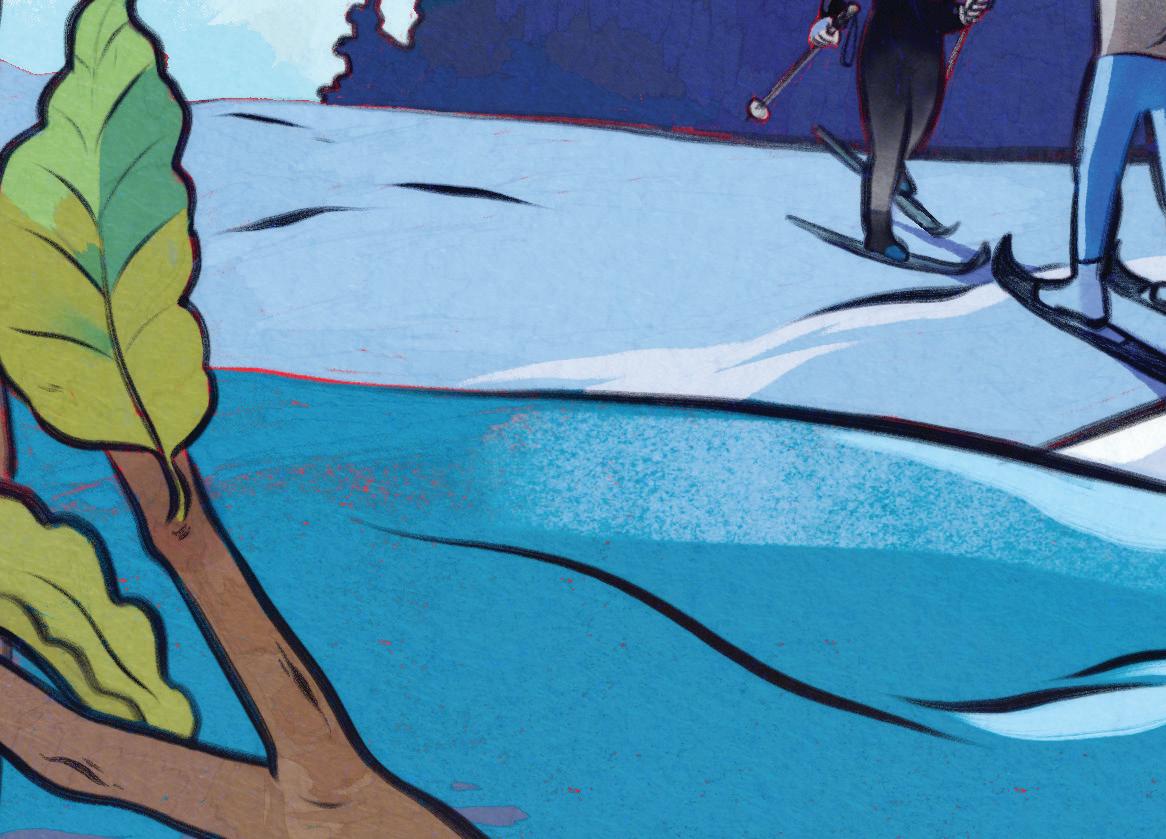
In 2018, Maine wardens received a call about a mother bear that had been hit by a car in Caribou and killed. After rescuing the orphan cub, they successfully relocated him to the den of another mother they had been tracking who was still hibernating with a new cub of her own.
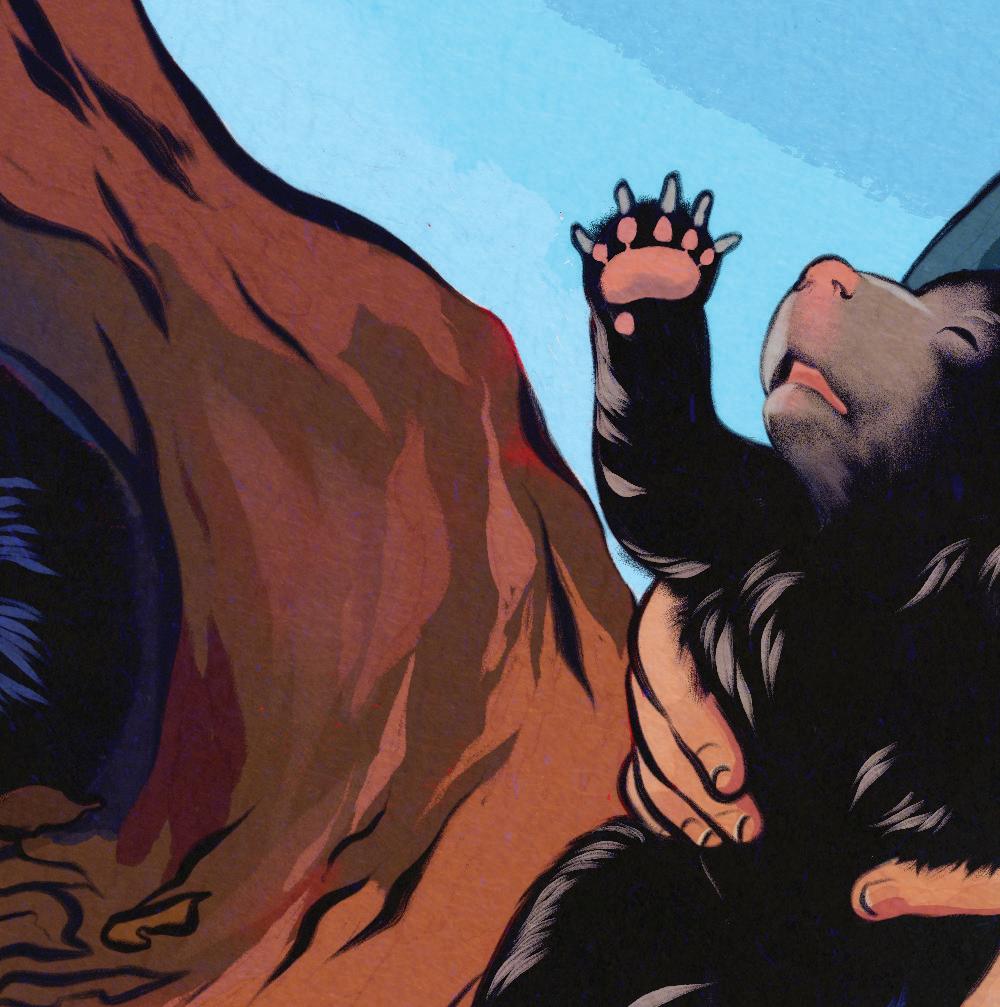
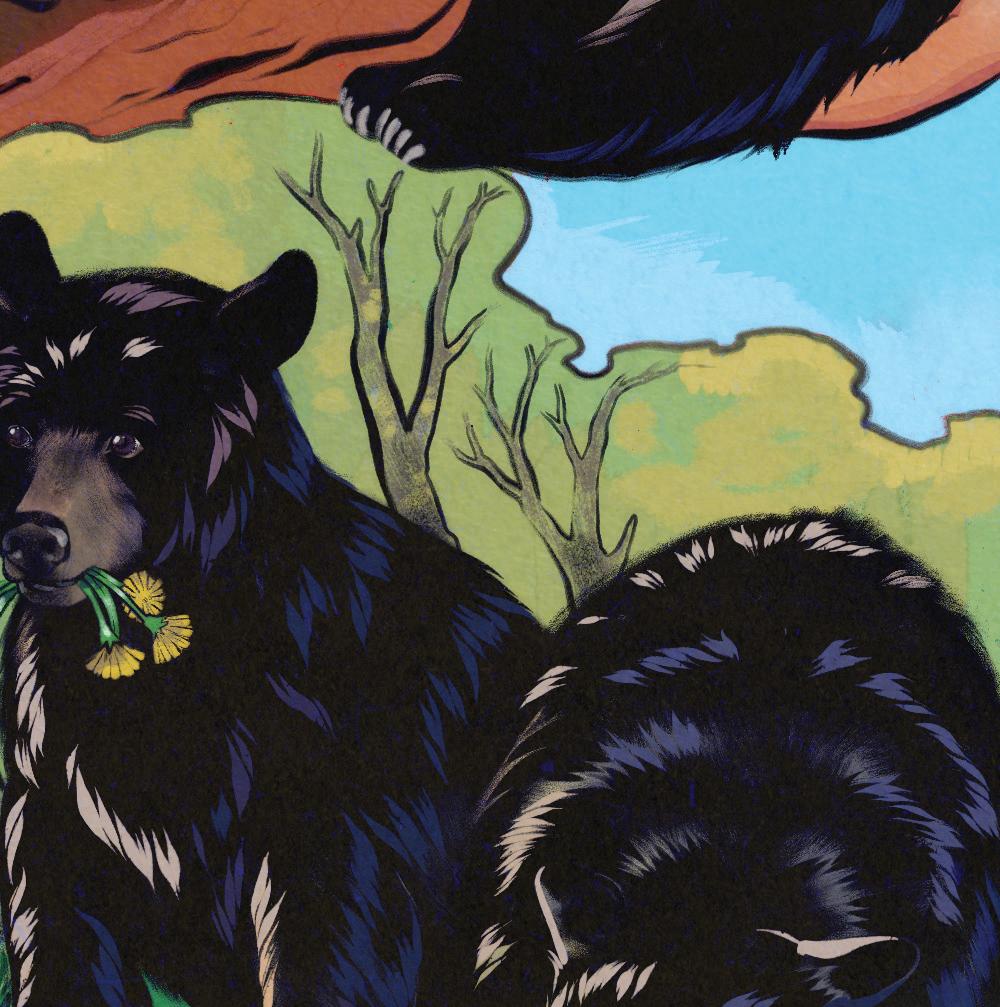

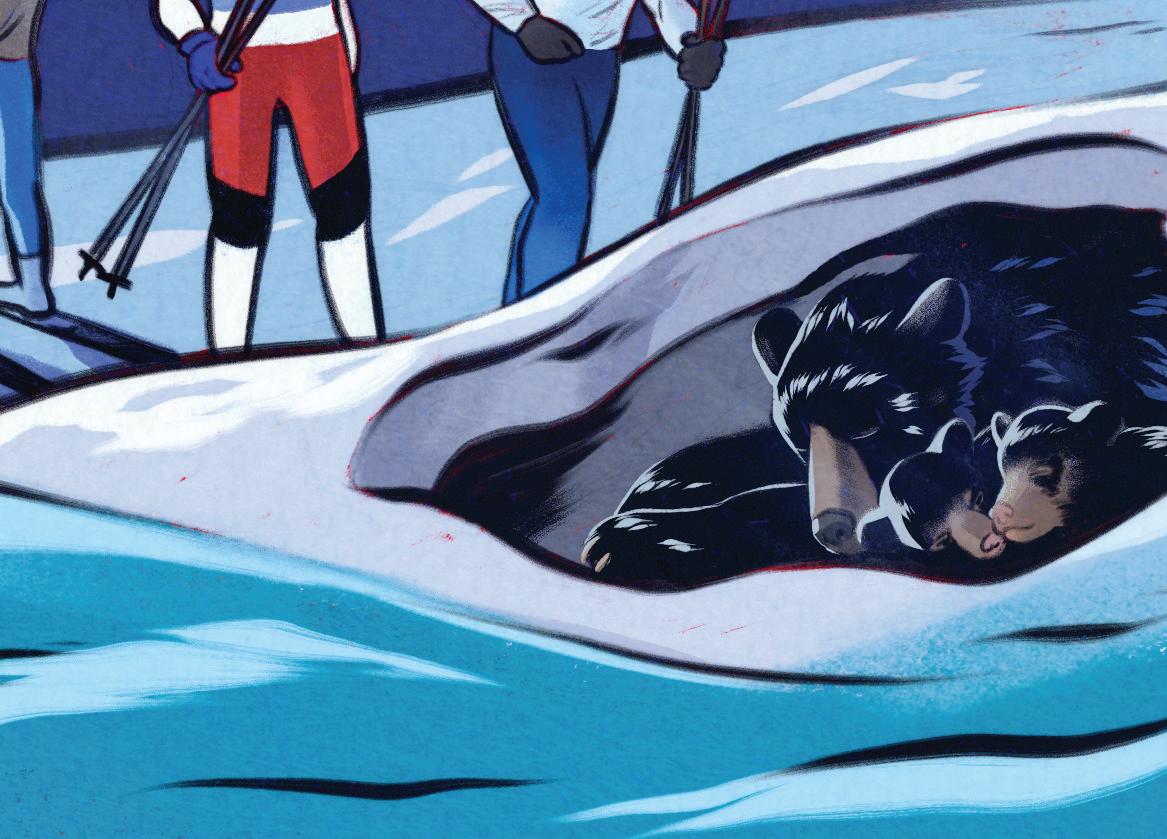
In 2018, the women’s race at the Chummy Cup, Maine’s collegiate Nordic skiing championships, was delayed while officials quickly rerouted the course after the men, who raced first, discovered a hibernating mother bear and cubs just off the edge of the trail.
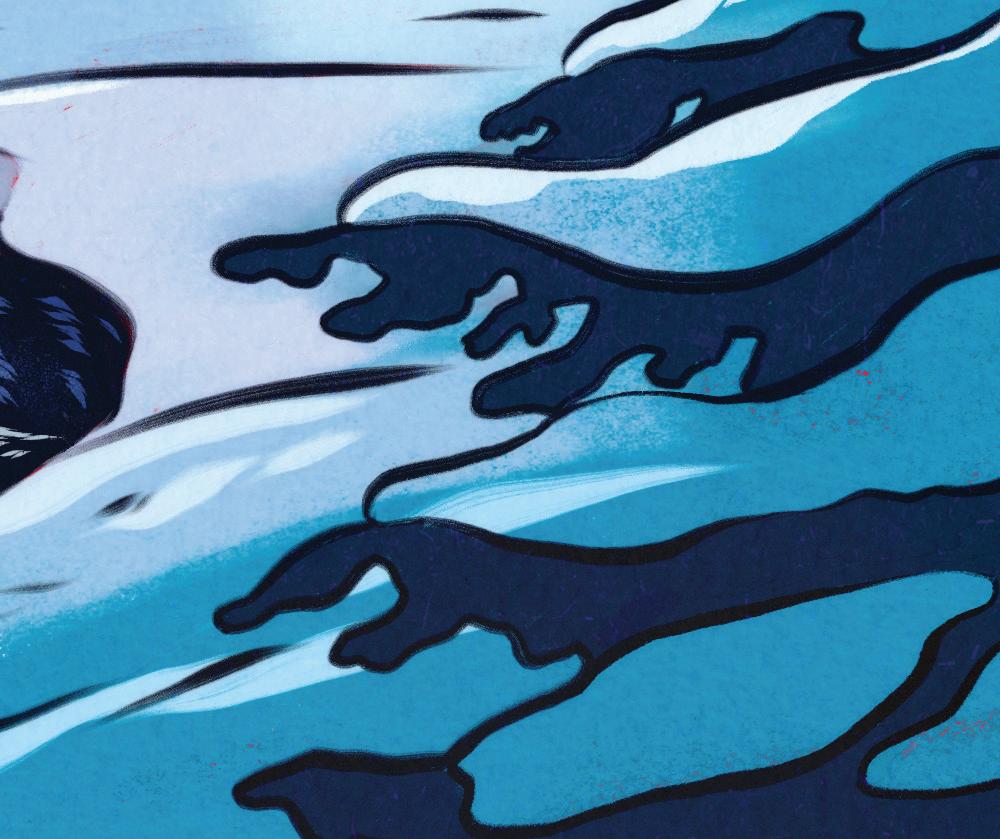
Forward
On the Shelf
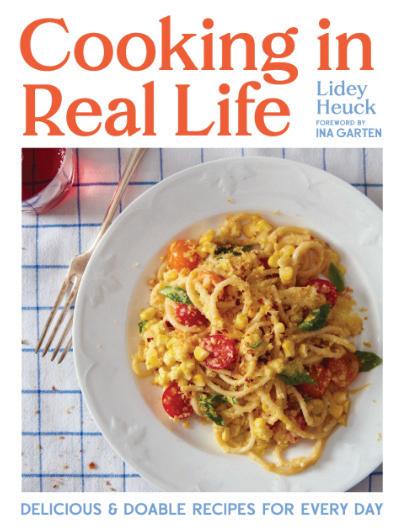
Cooking in Real Life
LIDEY HEUCK ’13
(Simon & Schuster, 2024)
With a foreword from beloved cook and food personality Ina Garten and reviews by The Lost Kitchen’s Erin French and Girl Meets Farm host Molly Yeh, Heuck’s first book features recipes that are, as Heuck says, “deliciously doable.” A cook, food writer, and recipe developer, Pittsburgh native Heuck began her career as Garten’s assistant and is now a regular recipe contributor to The New York Times. She writes a food and entertaining blog at lideylikes.com.
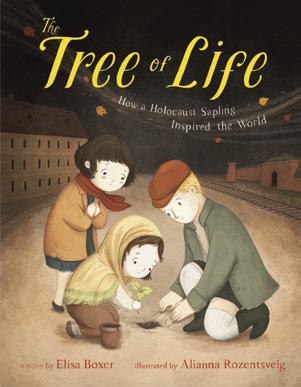
The Tree of Life: How a Holocaust Sapling Inspired the World
ELISA BOXER ’93 (Rocky Pond Books/ Random House, 2024)
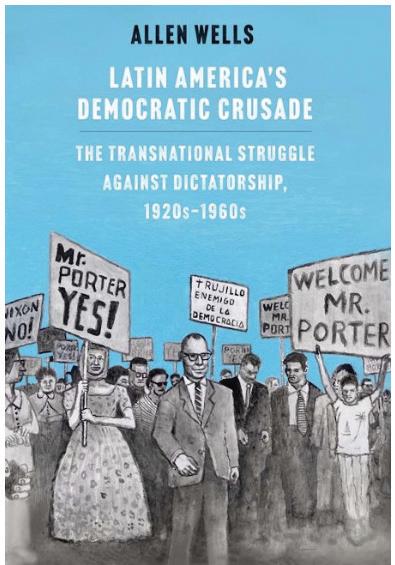
Latin America’s Democratic Crusade: The Transnational Struggle Against Dictatorship, 1920s–1960s
ALLEN WELLS, Roger Howell Jr. Professor of History Emeritus (Yale University Press, 2023)
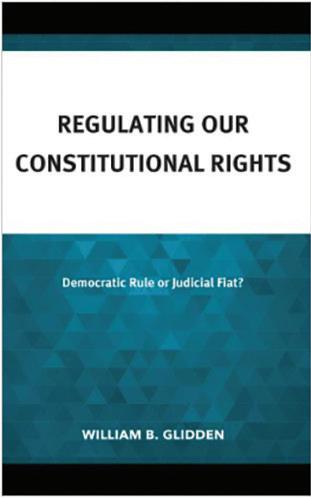
Regulating Our Constitutional Rights: Democratic Rule or Judicial Fiat?
WILLIAM B. GLIDDEN ’62
(Lexington Books/ Roman & Littlefield, 2023)

American Familia: A Memoir of Perseverance
DAVID A. MORALES ’97
(River Grove Books, 2022)
Alumni Life
Worth Every Penny
Two lifelong friendships, forged at Bowdoin, inspire the largest gift to an annual fund that Bowdoin has ever received.
GORDON “GLEN” MORIE ’64 thinks there should be a line in “The Offer of the College” that specifically refers to lifelong friendships. As central as the intellectual environment was to his development, he says, it is the friendships with men he met and admired as a student that continued to be most important and influential for him over the course of his life.
He paid tribute to two of those classmates and friends—Charlie Metz and Sandy Markey, both deceased—with a $1 million Class of 1964 gift to Bowdoin’s general unrestricted annual fund.
Metz was a mathematician and professor of radiology at the University of Chicago whose contributions to medical imaging analysis and assessment improved the accuracy of diagnostic tests such as mammograms and digital chest X-rays and affects the lives of millions who receive diagnoses from these tests. He developed the “Metz filter,” which is widely used to enhance resolution and remove distractions from nuclear medicine images.
Markey, who founded the Laboratory of Neurotoxicology in the National Institute of Mental Health and served as its chief, was a researcher whose professional specialty was analytical biochemistry using mass spectrometry to research the molecular mechanisms of normal and aberrant cellular protein
architecture and the biochemical pathology of behavioral diseases.
“We all knew each other, but I had separate bonds with each of them,” Morie says. “Charlie and I were graduate students at the University of Pennsylvania, he in physics, me in law school. When I served in Vietnam, he stayed in touch more than anyone else, including my family.
“Sandy and I met at a recruiting event for Bowdoin as teenagers,” says Morie. “It seemed like I had always known him. Later that autumn, an alum took us to visit the campus, and we both were granted early decision. Driving back, we agreed to become roommates. One night at a fraternity dinner, a math student was doing an experiment in statistics. Did you know that in every group of sixty people or so, two will have the same birthday? Well, we were the two.”
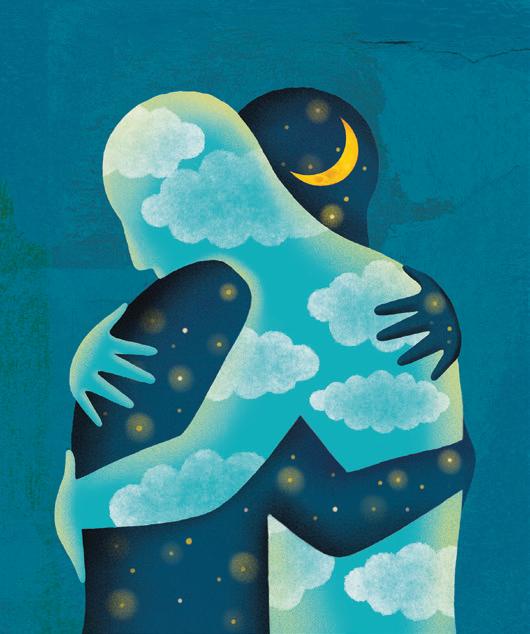
10 BOWDOIN MAGAZINE WINTER 2024 | CLASSNEWS@BOWDOIN.EDU
ILLUSTRATION: ANNA GODEASSI

Faculty
BOWLING WITH BRUCE
When Professor Bruce Kohorn was starting out as a new faculty member at Duke University in 1987, he received a small but life-changing bit of advice from a mentor who urged him to develop a pastime apart from academics. A hobby, his colleague told him, would provide a much-needed respite from the rigors of research and teaching.
In Durham, North Carolina, Kohorn was surrounded by beautiful trees—walnuts, red maples, cherries, and black gums. They inspired him to enroll in a six-week workshop on turning wood—the process of fashioning wood into various forms using a lathe. Ever since, the plant biologist has been producing a steady stream of silky-smooth bowls.
Now when he walks through the forest, he keeps his eye out for raw material to work with, like tree bases or branch knots. But his “holy grail” is a burl, the bulbous growths that develop on the side of trunks, usually from injury or infection. When smoothed, their rough, bulky exteriors reveal intricate grain patterns that transform in the turning process into a delicate swirl of browns. Kohorn often fills in the gaps of his bowls with a translucent blue epoxy, like icy lakes in a strange landscape.
At this point, many of his friends and Bowdoin colleagues have been gifted with a Kohorn bowl, he said, although his wife will often want to keep the latest because it’s too beautiful. “So we have scores of bowls around the house!” he said.
Campus Life
BUT WHO’S COUNTING?
The tunes keep on spinning at radio station WBOR, which on January 23, 2024, at 4:00 p.m. EST to be exact, achieved a major milestone—30,000 days of continuous broadcasting. The station’s earliest iteration, broadcast at WGAN in Portland, hit the airwaves on December 4, 1941, with three songs performed by the Meddiebempsters. Stanley Herrick ’42 was the first student DJ, ushering in an era of student-led radio that has since become a hallmark of the 300-watt station, which broadcasts throughout the midcoast area.
Athletics
An Honor for Howie
During Reunion 2023, the Bates College Alumni Association announced that it would retire number 56, worn by Howard Vandersea, a 1963 Bates graduate, Bowdoin football coach, and longtime Brunswick resident. Vandersea, who served as a first lieutenant in the US Army and was at one time signed as a free agent for the Chicago Bears, also coached softball, men’s tennis, and throwers on the men’s and women’s track teams at Bowdoin.
 Vandersea at Bates
Vandersea at Bates
BOWDOIN MAGAZINE WINTER 2024 CLASSNEWS@BOWDOIN.EDU 11 PHOTOS: (BOWL) BRUCE KOHORN; (VANDERSEA) THE EDMUND S. MUSKIE ARCHIVES AND SPECIAL COLLECTIONS LIBRARY, BATES COLLEGE
A wood and epoxy Kohorn bowl
ROLLING FOR JOY
Emma Paterson-Dennis ’24 didn’t know roller derby existed until March 2023, when a friend took them to their first “bout.”
“Every skater looked so solid and confident, and they were having so much fun! Watching so many strong people hitting, falling, laughing, and skating their hearts out together, I wanted to join them!” recalls Paterson-Dennis. “I used to skate every weekend with my dad through middle school, until our home rink closed in 2016. One of the main reasons I decided to try out for roller derby was that I missed skating.”
Roller derby is a contact sport played between two opposing teams on an oval track, in which players try to both outrun and block their opponents. Visual arts major PatersonDennis, who skates under the moniker “Mx. D’Media,” is now a proud member of the “Ship Wreckers” team, one of two home teams in the Maine Roller Derby (MRD).
They were introduced to the sport by their friend Cátia Cunha, who works for Bowdoin College in the Office of Annual Giving (and whose derby name is “Sticky Situation”). Cunha has been playing since 2017, attracted by the camaraderie. “MRD is a really special community that is invested in its people on and off the track,” she says.
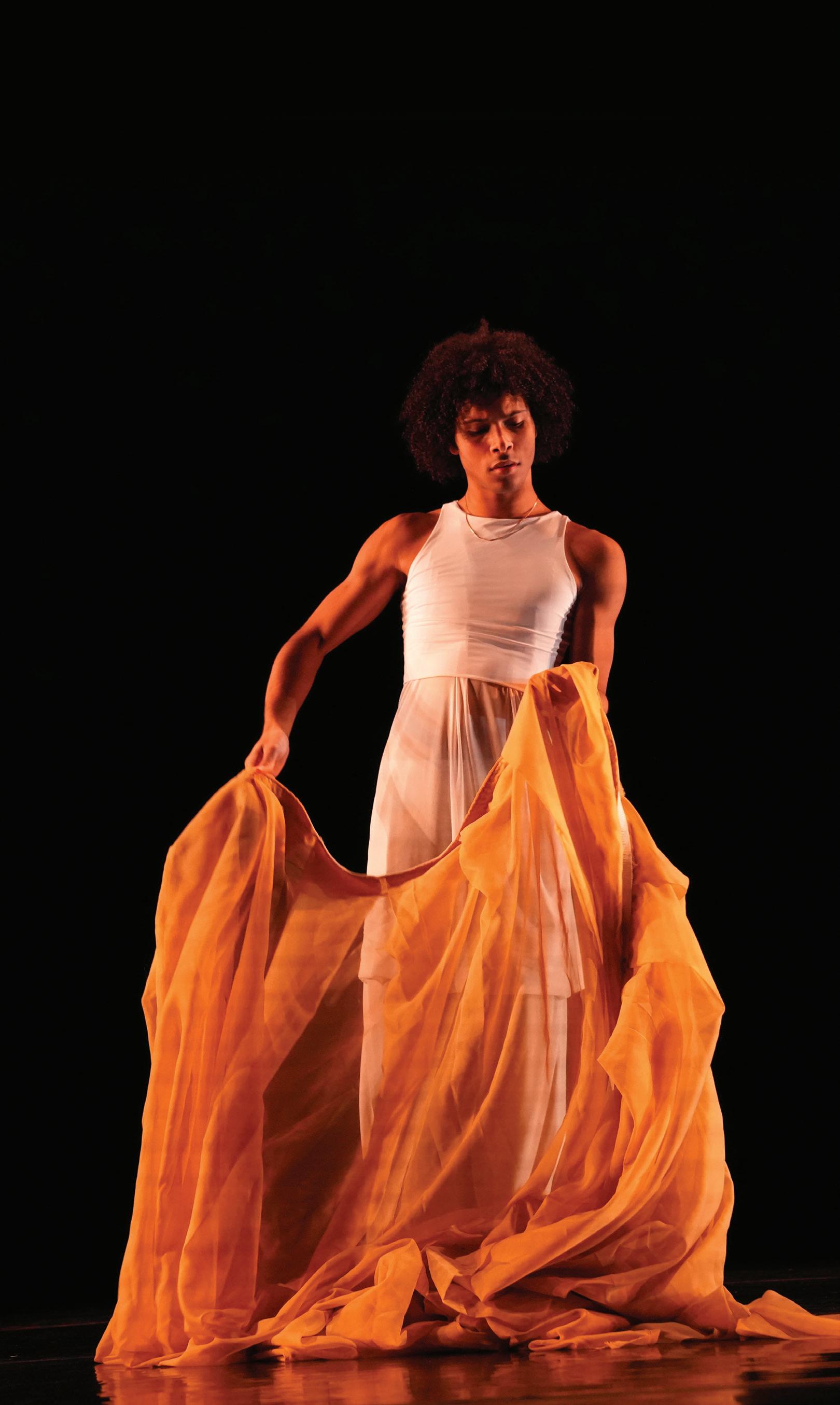
On Stage
Dancing the Light
In December, dance and English major Dylan Richmond ’24 performed his dance in Pickard Theater, our sun is a star and those stars way out there may or may not be suns/ but i know i am light. The piece is the first installment of his honors project, which will be performed April 13 and is inspired by writer Ntozake Shange’s expressive storytelling she calls “choreopoems.”
12 BOWDOIN MAGAZINE WINTER 2024 | CLASSNEWS@BOWDOIN.EDU Forward ILLUSTRATION: SABELSKAYA; PHOTO: ALEX CORNELL DU HOUX
Student Life
Henry Wadsworth Longfellow
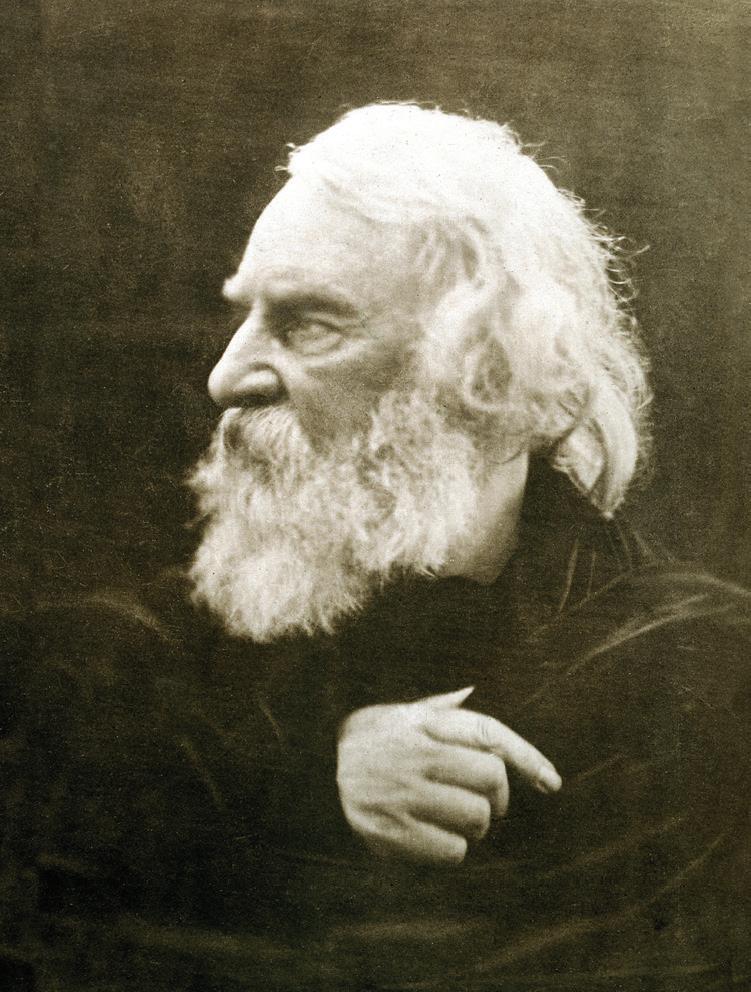
Anniversary
O Ye Familiar Scenes
“Longfellow Days,” which celebrates its twentieth anniversary this year and is supported by the Brunswick Downtown Association and Bowdoin College, among others, was set up to honor the life and work of one of the College’s most celebrated graduates, the poet Henry Wadsworth Longfellow, Class of 1825.
Events were held, as they typically are, throughout the month of February, Longfellow’s birthday month. This year’s offerings included literary readings, discussions, a book launch, music, and parties. To help celebrate the twentieth anniversary, the Pejepscot History Center cosponsored a literary and social event featuring Secretary of Development and College Relations John Cross ’76, who is also the unofficial Bowdoin historian. He took part in a discussion on Longfellow’s poem “Morituri Salutamus,” a reflection on youth and age composed for the fiftieth reunion of his 1825 Bowdoin graduating class (another anniversary!).
The program concluded on February 27— Longfellow’s 217th birthday!—with a poetry open mic and a performance by the Bowdoin College a cappella group, appropriately enough called Longfellows.
On View
Memories and Selves
Faculty collaborate on an art exhibition exploring expressions of Asian American identities.
FIVE ASIAN STUDIES SCHOLARS have teamed up with museum staff to curate Without Apology. Currently showing at the Bowdoin College Museum of Art, the exhibition weaves together past experiences of imperialism, discrimination, and broken lineages with new futures and possibilities of belonging.
It features thirty works of art by more than twenty artists who identify as Asian American, including Tomie Arai, Mel Chin, An-my Lê, Hung Liu, and Shahzia Sikander. “Without Apology shines a spotlight on the vibrant and diverse spectrum of Asian American artistic expressions,” said museum codirector Anne Goodyear. The show, she added, also acknowledges the growth in anti-Asian discrimination and violence since the start of the COVID-19 pandemic in 2020. “This exhibition demonstrates how artists tackled both personal and political themes of identity for more than a century, and collectively helps to give voice to these complex issues.”
The exhibition is divided into three sections: “Memories,” which explores historical currents that continue to resonate today; “Regenerations,” which underscores efforts to reconstruct the past and forge new narratives in the present; and “Selves,” which gives insight into how Asian Americans assert their identities in bold, playful, and often unexpected ways.
The show, which runs through June 2, 2024, is part of a larger, collegewide yearlong initiative called Asian American Reckonings, which includes courses, speakers, and a variety of events connected to the Asian American experience.
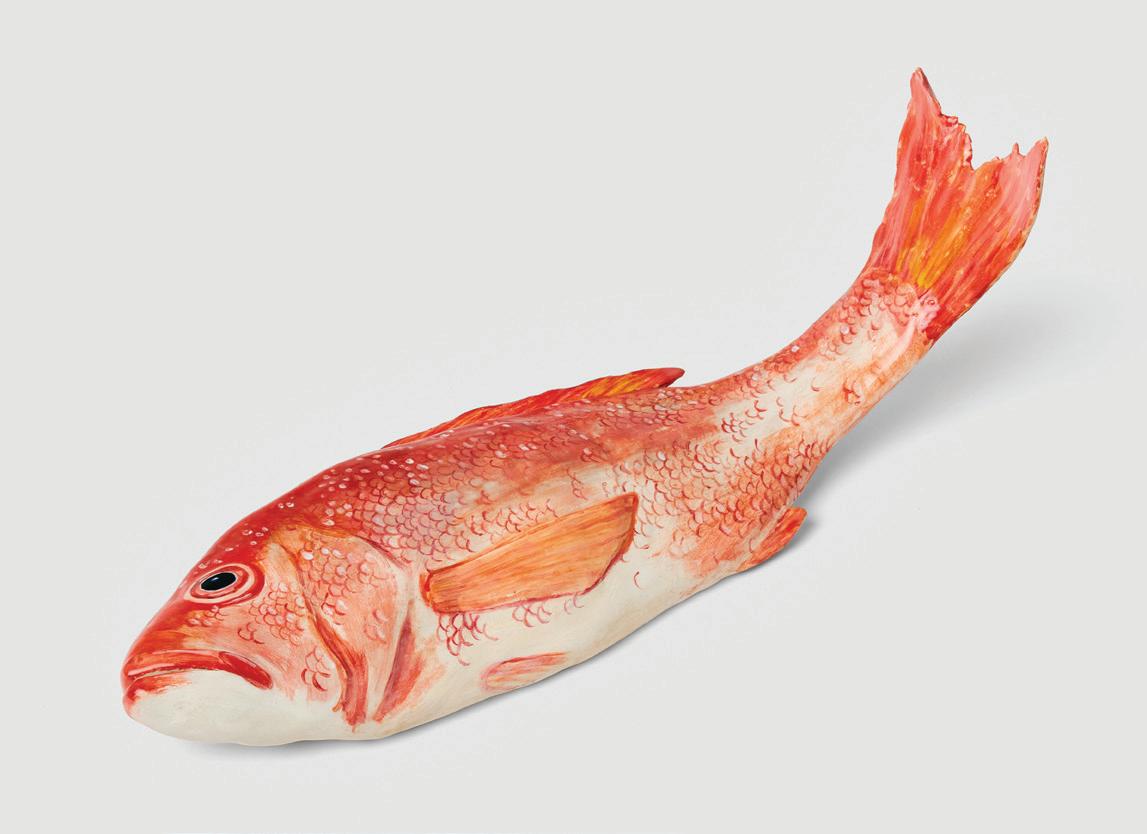
Red Snapper, 2023, painted ceramic, by Stephanie H. Shih
BOWDOIN MAGAZINE WINTER 2024 | CLASSNEWS@BOWDOIN.EDU 13 PHOTOS: (LONGFELLOW) JULIA MARGARET CAMERON; ( RED SNAPPER ) ROBERT BREDVAD
By the Numbers
Techno Craft
362
Days, 47 hours, and 100 minutes that the printers have run since moving into Jewett Hall in 2021.
250
Student visits last semester during walk-in hours. (If the space is closed, Israel leaves a sign on the door inviting people to find him in his upstairs office so he can open it for them.)
13,160
Meters of filament the printers have used to build objects.
Bowdoin’s Maker Space got its start eight years ago with just one 3D printer in the office of David Israel P’25, a member of the College’s academic technology and consulting team. Since then, it has moved into a series of bigger rooms on campus while acquiring a growing suite of sophisticated machines. This summer, the space had its most major expansion yet, into the large front room of Jewett Hall, which doubled its size. Israel also bought new furniture and received more machines from other departments. Currently, the space is outfitted with fourteen 3D printers, a laser engraver, a vinyl cutter, and two 3D scanners. Along with Israel, a staff of student lab instructors run the space during walk-in hours. They’re ready to assist any student or employee with an idea for a classroom assignment or hobby. The Maker Space is not just helpful for academics but is a fun outlet for students, Israel said. “A lot of students are very busy and don’t have the time or bandwidth to take an art class. But they want to be creative. The Maker Space is like the craft barn for the twenty-first century.”
28
Leach’s storm-petrel tubes printed to help scientists study the endangered seabird on Kent Island. Monitoring the petrels, which nest underground, requires a lot of bird handling, but with the new 3D-printed tubes, which can be augmented with tiny sensors that weigh the birds and alert scientists to when they enter and exit their nest, the birds can be left more in peace.
Hours needed to build the 3D-printed replica of the lion statues that grace the Walker Art Building steps. Practically a Maker Space mascot, the printed lion is made of multicolored blocks of bio-based plastic made from renewable sources like corn or sugar cane.
500
Cork coasters given to incoming first-year students last fall to print their own custom Bowdoin-themed dorm accessory.
Models of miniature human brains requested for a fall cognitive neuroscience class taught by Erika Nyhus, associate professor of neuroscience and psychology.
639
Objects created, from anatomical models to missing chess pieces.
5
Student workers trained to help visitors use the gadgets.
30
Different colors of printer filament. Israel is always buying new materials for the 3D printers—filaments with names like quantum silver raspberry, salmon red, sparkle yellow, and a perennial favorite, glow-in-the-dark.
14 BOWDOIN MAGAZINE WINTER 2024 | CLASSNEWS@BOWDOIN.EDU Forward
960
“Believe me, the word ‘belonging’ comes up a lot. We’re hearing it on college campuses across the country. One thing I try to remind students often is: you are all here because we chose you. So, it’s our responsibility to increase that level of belongingness. But you already belong.”
—GARRY JENKINS, BATES COLLEGE PRESIDENT, AT THE FIRESIDE CHAT DURING THE BLACK STUDENT SUMMIT AT BOWDOIN, FEBRUARY 10, 2024
Community
HELLO, GOOD BUY
In response to high mortgage rates and the limited inventory of affordable homes within commuting distance of Brunswick, the College is offering a forgivable loan program to assist employees who are first-time home buyers. For a limited time, Bowdoin will provide a ten-year forgivable loan for up to 10 percent ($50,000 maximum) of the home purchase price to support faculty or staff who have not owned a primary residence within forty miles of campus within the past five years. For each year that the employee remains at the College, one-tenth of the loan principal, as well as the annual interest, will be forgiven.
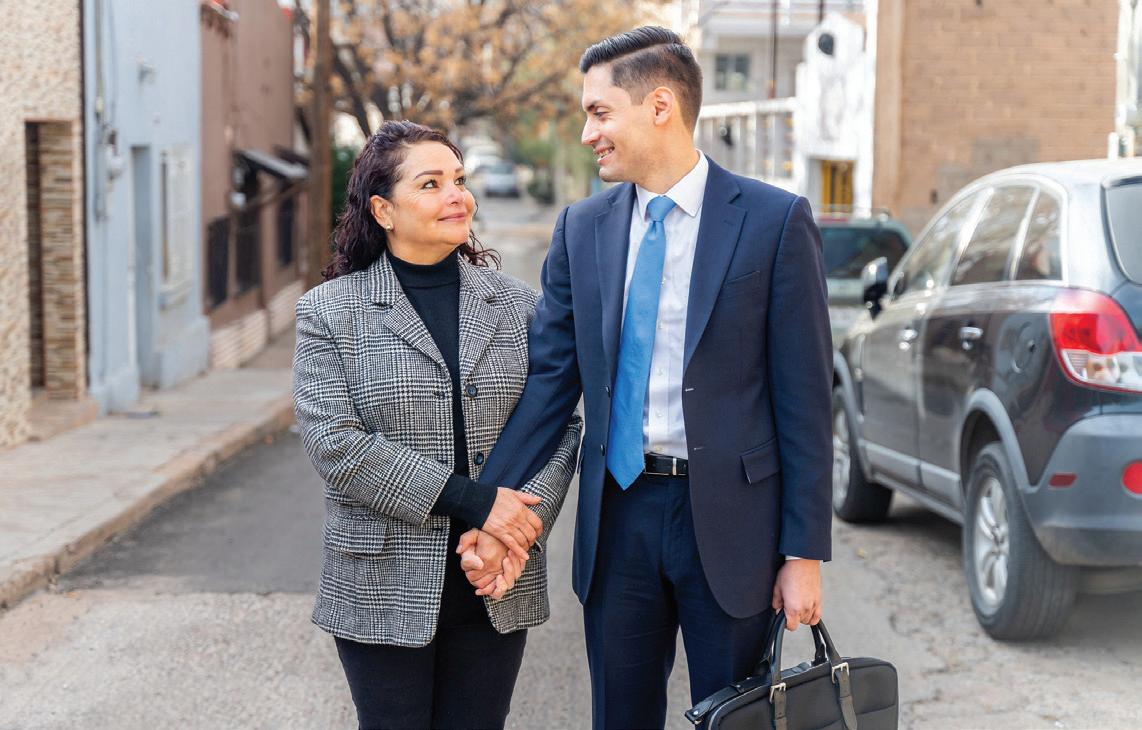
An American Life, Reunited
This American Life, Ira Glass’s weekly public radio program and podcast, will be airing a show featuring Bill De La Rosa ’16 and his family this spring.
REPORTERS HAVE BEEN following the De La Rosa family since August, through the final stressful months as they worked to get their mother, Gloria, the documents she needed to return to her home in the US.
In October 2009, Gloria left her house, husband, and four children in Tucson, Arizona, to travel to Mexico and apply for a green card. Instead, she was barred reentry into the US for ten years, a penalty for having lived here for longer than a year without documents. Her process of reentry was delayed another four years by COVID, immigration backlogs, and legal setbacks.
At last, on January 9, 2024, Gloria was approved. Less than two weeks later, Bill went to the border town of Nogales to walk with his mother across the border at the DeConcini
Port of Entry. On the US side, they were greeted by a throng of reporters, family, friends, and well-wishers.
Since then, Gloria has been settling back into the home she left and where three of her children still live. “We’re incredibly excited that finally this nightmare has come to an end,” Bill said. “But it is couched in bittersweetness because we missed fourteen years.”
Bill, who is currently studying at Yale Law School and finishing his doctorate at Oxford University, also worries about the millions of other immigrant families who are split up or afraid of being so. “It took an entire village to make my family’s reunification possible,” he wrote on Facebook. “My family’s triumph is all our victory. Let us continue fighting for other families. ¡Adelante !”
BOWDOIN MAGAZINE WINTER 2024 | CLASSNEWS@BOWDOIN.EDU 15 PHOTO: MANUEL RUIZ
Alumni Life
Sound Bite
Bill and his mom set off for the US.
What Lasts
Grieving the death of her former student and fellow Polar Bear Finn Woodruff ’21, Samantha Francis-Taylor ’09 finds solace in music, memories, and the calling that is teaching.
I APPLIED TO BOWDOIN because my dad was obsessed with Joshua Chamberlain. I’m not kidding. It was the only school I got into—the SATs and I were not friends—and as a result, I ended up in Brunswick with buckets of enthusiasm and a firm belief that Bowdoin and I were meant to be.
When my acceptance letter arrived in the mail (yes, I am that old), the first person I told besides my mom was my English teacher. I drove the three minutes back to school, ran straight for Mr. Templeton’s portable classroom, and, half-screaming, half-crying, I yelled: “I GOT IN!!!” I’m not sure how common it is for a student to graduate with a degree in what they arrive on campus intending to pursue, but I did just that. I majored in English and minored in teaching, and after grad school I came back to Maine to start my career at Brunswick High School. I mean, of all the places, right?
The English teachers I had during my last two years of high school changed my life—they opened up every corner of my mind, took my breath away with their empathy and kindness, inspired me with their depth of knowledge and wisdom, transformed me from the inside out. Gordon Strout, may he rest in peace, passed away suddenly in 2018. I never got to say goodbye. My other mentor, Ken Templeton ’01, exuded enviable patience, creativity, and joy—he was brilliant but down to earth, and he listened like you were the only one in the room. It wasn’t just our discussions about Dostoyevsky and Nina Simone that left me buzzing, but how he carried himself through the world, how he contributed to his community, that inspired me. Teaching is a calling, one I knew I had to answer. Almost twenty years later, I’m proud to say that Ken and I are still friends. And we’re both still in the classroom, doing the work.
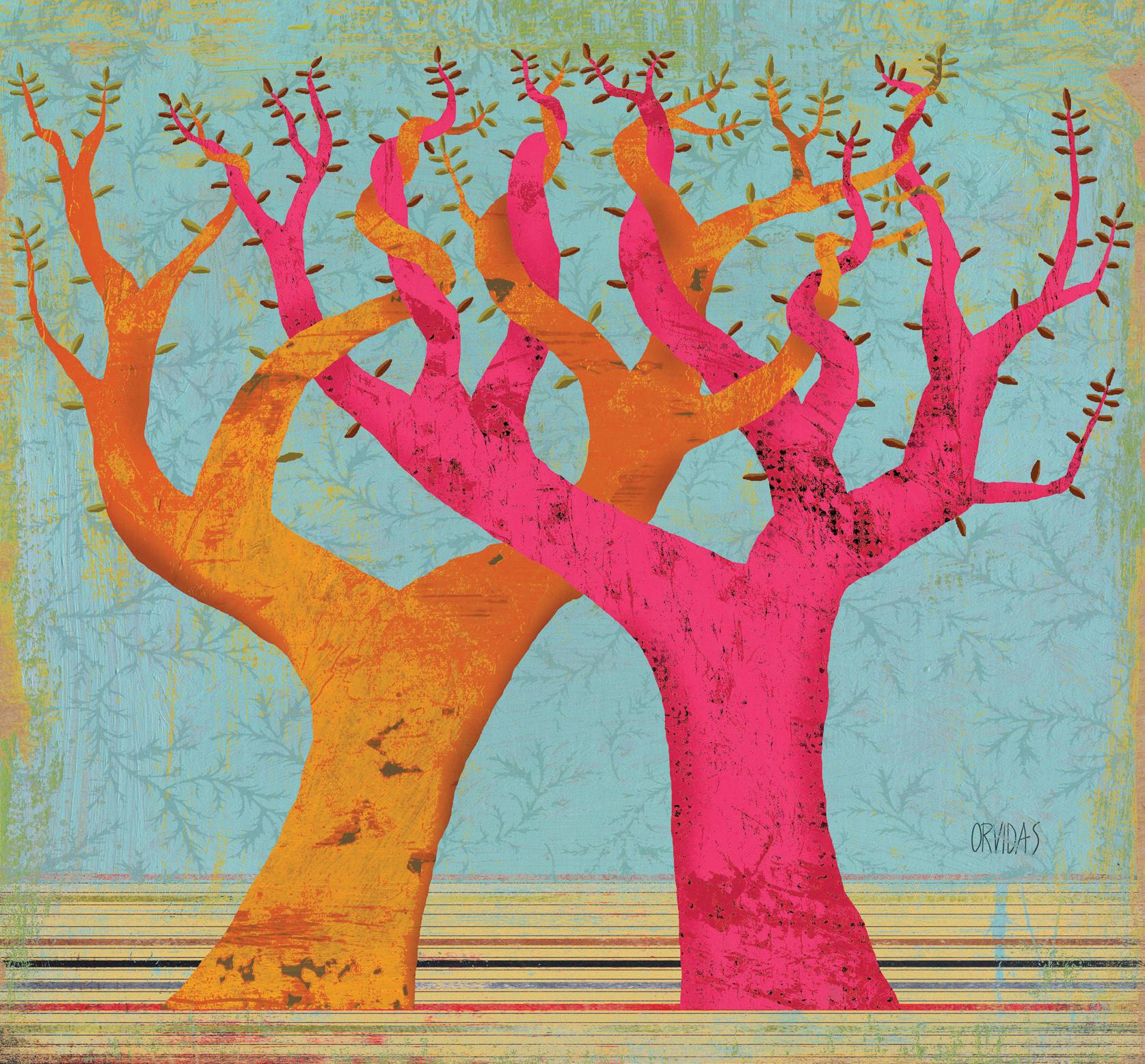
I FIRST MET Finn Woodruff when he was a sophomore in high school. He was the eldest of four children and the first to become a Brunswick Dragon. He was small in stature but mighty in intellect. He seemed skeptical of his teachers, and I loved that he wasn’t afraid to tell me so. We hit it off right away. We bonded over being born and raised in Maine; we bonded over Bowdoin—Finny’s dad ran the Outing Club, so we shared the same home away from home; we bonded over music: the learning, writing, and playing of it. We argued about Shakespeare and whether Charlotte or Emily was the better Brontë (the answer is Emily). I was his teacher and he was my student, but— and you’ll know this if you spend your own precious days in a classroom—the best ones impart more lessons than you could have ever hoped to teach yourself. There is an invisible string that binds some teachers and students together forever, and I could tell that Finny and I were connected for good.
When he ran into my classroom to tell me that he was going to Bowdoin, was officially becoming part of the Polar Bear family, I hugged him and told him he already was. A delightful
feeling of déjà vu washed over me, only this time I was the one imploring “there is only one rule, and it’s called you HAVE to take a class with Professor Reizbaum!” High school teachers don’t often get to witness the fruits of their labor. Students move on, as they should—they leave town and begin the business of living. With Finny still close by, I would be able to continue cheering him on from the trail or the auditorium. After he graduated salutatorian of the Class of 2017, we joked that we’d do it all over again in four more years, only this time we could have a beer after. I can still picture Finn’s smile from that gorgeous Friday night in June— the kid had a Gatsby smile—his whole body glowing under the glare of the Watson Arena lights. I could have lived a thousand lifetimes and never once foreseen his tragic death.
I learned that Finn had passed away in an email no teacher ever wants to receive. The subject line read: “Death of a Former Student.” I had just started teaching my first block of the day, and for some stupid reason I clicked on the email. I was juggling windows and screens, trying to project a passage up onto the whiteboard. I thought I’d see the name of a student
16 BOWDOIN MAGAZINE WINTER 2024 | CLASSNEWS@BOWDOIN.EDU Column
ILLUSTRATION: KEN ORVIDAS
I didn’t know well, someone I had passed in the hallways or had watched play basketball in the gym once. I would feel sad, of course, but I wouldn’t adopt a cloak of false grief. Instead, my eyes saw letters that formed the name “Finnegan Woodruff,” and in that split-second, my heart shattered into a million pieces. I scanned the email quickly, then read the whole thing properly, reread it again, trying to undo the unfathomably sad reality that awaited with every line. I stood up and told my students to keep going with their close reading, told them I’d be right back, told them (like I always do when I have to step out briefly) not to light my room on fire.
Teaching during COVID was brutal—you’ve heard the horror stories, perhaps endured them yourself. But the saddest day from that traumatic epoch in time, for me, was the day I found out that Finn had drowned in a kayaking accident on the White Salmon River. Never have I wanted so badly to turn back the clock, to undo the past. I wanted to wake up and start the day over, text him and say, Hey, kid, maybe just stay home today
But I kept moving forward, which is, of course, the only way to keep going. It’s absurd what human beings can withstand when they have to. Somehow, I returned to my classroom, grateful for the N-95 disguising those first blasts of sorrow, made it through the rest of the block, then signed out during bathroom duty. I sobbed in my car, drove home so I could hug my husband. I remember I took my dog Pippin for a walk. And then I went back to school. And I kept teaching. And as long as there are students out there like Finny, I will keep teaching.
We are emerging from a period marked by so much loss, so much isolation, so much time apart from the people and communities we love. But this grief? For me, this is a Holden Caulfield aching for his brother Allie, a Hamlet longing for his father kind of grief; it punches me in the stomach, it makes it difficult to breathe. I hate that I have to let my memories of Finn settle into the past tense. It isn’t right. It isn’t where Finny belongs.
FINN WAS a remarkable talent, brimming with gifts and idiosyncrasies. He was the best fiddle player I’ve ever heard, the most affectionate
brother I’ve ever seen, the most self-assured teenager I’ve ever met. Finn knew exactly who he was and what mattered most to him, even when he was fifteen years old. It’s not that he was closed off to other ideas, merely that he possessed innate self-confidence in his ability to carve out a life worth living. He moved humbly through the halls with grace, but he did not suffer fools. He was a quiet leader. He was wise beyond his years. The world did not deserve him, but my God did the world need him.
I know he was happy with Siena, happy out West, happy pursuing the things he loved best in this world. But that’s more reason to feel he was stolen from us. While Finn lived more fully than some people who make it to 100, it isn’t enough. I wanted to drink that beer with him, I wanted to play music around a blazing campfire, I wanted to dance at his wedding.
Most of all, I wanted to see what Finn was going to do to change the world, because every part of me knew that he was born to lead. He inspired every person who was fortunate enough to move in his orbit; he made things beautiful. Finny was like a shooting star that flashes across the dark, that stirs our sense of awe as it illuminates everything in its path, and is gone all too soon.
When Finn graduated from Brunswick High School, he wrote and played an original song in lieu of giving a speech. I usually leave my phone untouched during these events, but on this occasion, I broke my rule. I am grateful I did— hearing Finn’s fiddle sometimes tricks me into believing he’s still right here. I tell my students all the time that art is the only thing that lasts— art and love—and I don’t think I’m wrong.
WHEN SCHOOL came to a close last summer, I made the heartbreaking but necessary odyssey to Oregon. I crossed into Washington State, I picked poppies along the highway, I left them at the White Salmon River. I put my feet in the cool water, I read my Mary Oliver poem, and I tried to say goodbye to Finn as best I could. Two of my dearest Bowdoin friends were there to hug me when it was over.
I write this now, bursting with gratitude for all the ways this community has shaped me. I know my life would have looked entirely different
without my Polar Bear family, and it’s not lost on me that it has been the home to many heroes throughout time: from a man who saved the Union, to one who saved me when he put the right book in my hands at the right time, to a young man I would have done anything in my power to save if I could.
While I mourn the milestones we’ll never mark, I can still find Finn: I feel him in the dappled light of late summer, in a lone tree standing at Crystal Spring Farm, in the smooth tracks I make with my skis, gliding through freshly fallen snow. I feel him every time I hear a violin or sing “All of Me” to my daughter at bedtime. Most of all, I find Finn in the faces that sit before me, that remind me to keep trying, to keep showing up, to keep giving them every single thing I’ve got. Very soon, one of those faces will belong to Finn’s sister. She’ll be my student; I’ll be her teacher. We’ll read the books. She’ll mend and break my heart—I’ll do everything in my power to take care of hers.
So here’s my vow: to try like hell to live like Finn. Ken once told me that teaching was about trying to convey how to love something. I’ve never had a hard time doing that—telling people that I love them. It’s the letting go I have always struggled with. At Finn’s memorial, my classmate Willy Oppenheim ’09 stood up in the December light and read Mary Oliver’s “In Blackwater Woods.” I leave the final words here now for you: “To live in this world,” she instructs, “you must be able to do three things: to love what is mortal; to hold it against your bones knowing your own life depends on it; and when the time comes to let it go, to let it go.”
I’m still not ready to let Finn go. I’m not sure I ever will be. But I can promise to hold Finn in the table of my memory, to reflect upon every lesson he ever taught me, every lesson he continues to teach me. And I can keep sharing my Finn stories and encourage you to share yours as well.
Once upon a time, I taught a boy named Finnegan Woodruff. He was a marvel, and I miss him.
Samantha Francis-Taylor ’09 lives in Brunswick, Maine, with her husband, Maximillian Taylor ’10, and their son and daughter. She teaches English at Brunswick High School.
BOWDOIN MAGAZINE WINTER 2024 | CLASSNEWS@BOWDOIN.EDU 17
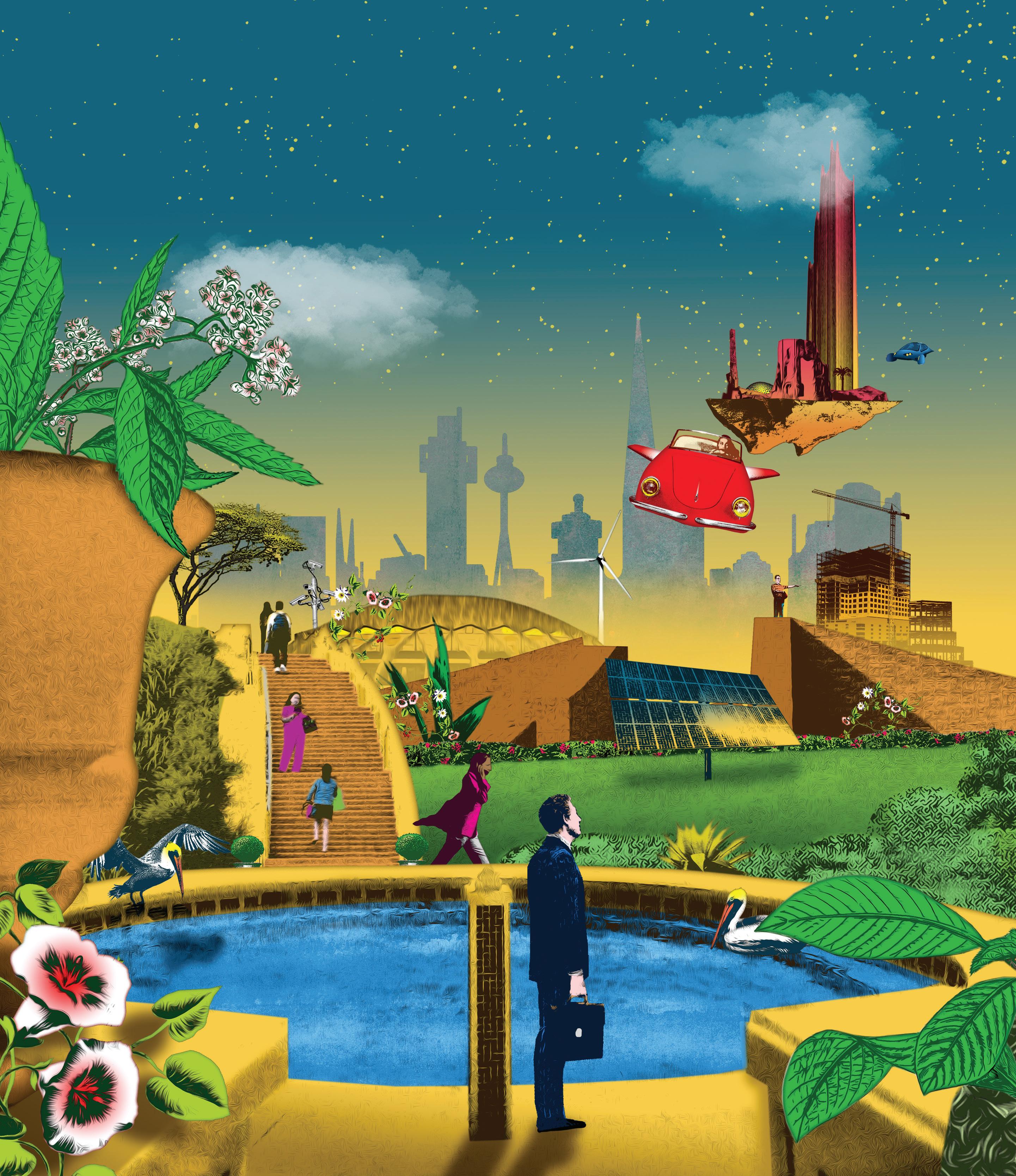 BY MICHAEL COLBERT ’16
ILLUSTRATIONS BY PIERRE-PAUL PARISEAU
BY MICHAEL COLBERT ’16
ILLUSTRATIONS BY PIERRE-PAUL PARISEAU
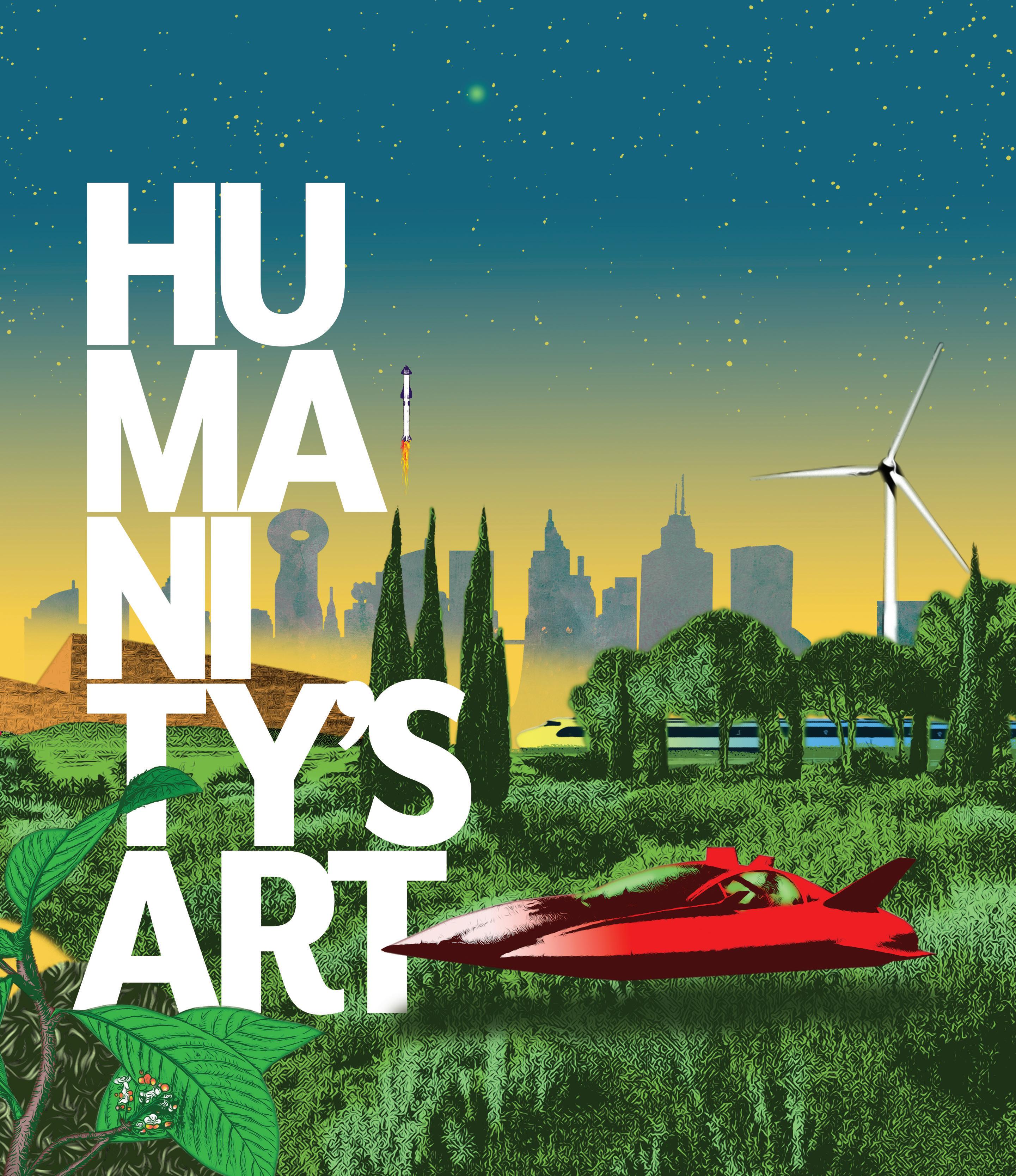
Senior lecturer Jill Pearlman calls them “humanity’s greatest achievement.” A hub for culture and commerce, cities are also places where some of the most intractable problems of society are magnified: poverty and income inequality, traffic congestion and pollution, overcrowding and crime. And yet they continue to be human magnets—experts estimate that even as the world’s population grows, cities will house something like 70 percent of our world’s citizens. Students in Bowdoin’s new urban studies minor learn to think critically about cities, and alumni work in all kinds of ways to consider challenges and opportunities in the years to come and to reimagine cities—with clarity and optimism.
THOMAS JEFFERSON thought the United States never would—or should—have cities.
“He thought we’d create the raw goods here, ship them to Europe, and let them industrialize, because industry and cities are synonymous. Cities have grown up around industry,” said Jill Pearlman, who codirects Bowdoin’s new urban studies minor along with professors Theo Greene and Rachel Sturman.
Pearlman teaches the history of urbanism and architecture at the College, asking students to interrogate the relationships people develop with their lived environments. Her course, City, Anti-City, Utopia, begins by looking at an idea that persists throughout American history, that our cities must embody the “best of city, best of country.” Circumstances in the US didn’t develop as Jefferson imagined, however.
“Obviously, that didn’t pan out, and we had to do our manufacturing here, so cities—really mill towns—sprung up,” said Pearlman. “Then we see in the city all of the things Jefferson warned us against: we have poverty, we have slums, we have hierarchy, misuse of power. In Jefferson’s case, both themes come together. In the quest for the marriage of perfect city and country, there are a lot of proposed utopian schemes along the way: the garden city, the tower in the park.”
PORTLAND, MAINE: A CASE STUDY
Across the College’s various urban thinkers— faculty, students, and alumni alike—there seems to be consensus around cities’ capaciousness, their ability to grow and develop.
“Cities are humanity’s greatest work of art, our greatest creation,” said Pearlman.
“They’re where people come together, communicate with each other, and feed off one another more than anywhere else,” she added. “It’s where our greatest art, architecture—our greatest cultural accomplishments—are created and performed. It’s also the place where we have our biggest flaws, where our biggest crises are magnified.”
Such questions have persisted for centuries. Crime became an important issue for voters around the country in the last election and in many others before that. Half an hour down the road from Bowdoin, Portland often finds itself amid the discourse surrounding cities: ranking as one of U.S. News and World Report’ s best cities to live, Bon Appetit ’s Restaurant City of the Year, a beloved tourism destination for visitors around the country. The pandemic brought with it an influx of new Mainers—about 55,000 new residents to the entire state, the Portland Press Herald reports—and Portlanders subsequently noticed a spike in the cost of living. As more people struggle with housing, encampments have grown and been the subject of debate and controversy in the city.
Assessing a place like Portland, Theo Greene finds that the very notion of the city starts to unravel.
“As Portland has ascended as a creative location and a destination for tourists, the qualities that sociologists ascribe to cities may shift depending on the time of year,” he said. “In the winter, when there are not a lot of tourists, it has a village-like quality. People know each other. It seems to be that people can access things very easily. Interactions are much more cordial and friendly. Then in summertime, when you have hundreds of thousands, even millions, of people moving through Portland, you have these different dynamics that actually very deeply mirror a city.
“That’s been of really great interest to me in recent years: what makes a city?” he added.
“There are some places that very clearly will always be a city—New York, Los Angeles—but what about other places that may not be as large but still can have the forms of urbanism, urban culture, and relationships that might emerge in New York, San Francisco, Los Angeles, or Chicago?”
Cities possess boundless potential. In a place like Portland, with its growth and attendant problems, questions that Pearlman poses bubble to the surface. Who are we building for? What’s the vision of this place? Who even fits within that collective vision, and who’s excluded? How can cities—in all their rich possibilities— accommodate the slew of problems that accompany them today?
UNLOCKING URBAN SOLUTIONS
For architect and sustainable cities consultant Peter Steinbrueck ’79, the marriage of city and country finds accord in Seattle’s Pike Place Market.
“Pike Place Market is the densest human interaction you’ll find in Seattle,” he said. “Daily, it’s people brushing shoulders, like the subway in New York City. It’s massive numbers of people thronging in a confined space. You may go there to buy some local fresh produce, or go to a restaurant, but really, the total experience that we enjoy is through that human interaction: sights, senses, smells, all those things.”
While this collision of human life captivated Steinbrueck from an early age, Pike Place’s future was not always so certain. As a child, Steinbrueck partnered with his father and joined the efforts to protect the market when the city nearly bulldozed the landmark. The efforts were successful—the market is a proud icon of Seattle today—and for Steinbrueck its preservation underlines the role that cities play in fostering human connectivity.
“Cities evolved as a place of commerce and trade,” he said. “Going back thousands of years to their earliest formations, they were where people came together for social interaction, which is a human need.”
Taking a wide-angle view on the concept of “the city,” it can seem that conflict resides at its core. But they’re places where people find possibility, where people graft their imagination onto development, arts and culture,
20 BOWDOIN MAGAZINE WINTER 2024 | CLASSNEWS@BOWDOIN.EDU
skyscrapers. Yet why do they so magnetically attract the imagination?
For Prema Katari Gupta ’00, cities embody significant points of human connection.
“I have always been drawn to places where people can be together,” said Katari Gupta. “I really like the idea of cities as places of celebration, culture, and togetherness. Whether it’s supporting the Eagles or the Phillies, or seeing the ballet, or going to see Taylor Swift, I think cities are places where people get together, which to me is an essential and critical part of being a human.”
Based in Philadelphia, Katari Gupta is CEO of the business improvement district, Center City District, a role that she describes as “downtown’s biggest cheerleader.” This enthusiasm pervades her work, and she identifies solutions to social and environmental problems wrapped up in urban living.
Take public transit, for example. In order to meet global climate goals, Katari Gupta says that countries need to double down on existing modes of transportation.
“I think a lot of people have the perception that living somewhere rural is best for the climate, but the percentage of greenhouse gases that come from automobiles is profound.
Having a pattern of life and work where you’re able to rely on public transportation, walking, and bicycles is what’s best for the environment, and cities are where that can happen at scale. I often say two-thirds of jobs downtown don’t require a college degree, but not one of them requires a car.”
The same philosophy bears out across the country. As Los Angeles is looking to build the Sepulveda Transit Corridor, a new subway line, Nick Suarez ’21 provides environmental insight and assesses impact—from noise and vibration impact to air quality and biological and cultural resources. Though Los Angeles may be synonymous with the car, Suarez notes this was not always the case.
“There were a number of streetcar lines along major arterials in Los Angeles in the 1920s and 1930s,” he said. “It’s a pretty new city, compared to others on the East Coast or in Europe, so it was in a unique historical place for development; the city was just getting built at a time when there were these new transportation technologies.”
As the planning ideal reformulated around the automobile, however, the city pivoted to freeways and single-family homes.
“This creates a traffic nightmare. Everything is so spread apart, and everyone’s trying to get to very distant places,” he said. “What LA Metro is trying to do is bring us back to that point where we were before, with a more sustainable system and lessening the environmental impacts of those previous decisions.”
“Cities are definitely the key to environmental resilience,” he added. “If you look at the environmental footprint of someone living in a rural area versus a city, it’s much lower for someone living in a city, because everything is so concentrated. That’s a concept that we try to maximize in urban planning.”
THE CITY AS A WORK OF ART
The city is a meeting point. It is an environment where people come together and exchange ideas, and here art is made.
“Cities are spaces of collaboration,” said Pamela Fletcher, professor of art history. This semester, Fletcher is teaching Art of Urban Life in Europe, 1500–1950
“Artists travel to different cities in order to see the art there and to learn from the people who are practicing there, but it also gives rise to various kinds of conflict,” said Fletcher. “For example, if you want to understand a lot about Italian Renaissance art or the various political conflicts with the Medici as Florence—the city and the political entity—transitioned through various phases of government, art is a really powerful tool in both the Republican and Medici arguments about who should rule the city, why, and what their values are.”
While students in her course could examine works of art and simply telegraph today’s problems onto the past—seeing where the Medici conflict could shed light on the development of an emerging city like Portland—Fletcher also wants her students to see the art, and the cities it depicts, on its own terms.
Urban life has been artistically generative for centuries. She points to William Hogarth’s paintings of modern moral subjects in the eighteenth century: depicting sheriffs and madams and thieves, he created art for people who live
in cities, which captures the feeling of life in London. She thinks, too, of Impressionism and German Expressionism.
“There are these very expressionist pictures of the streets of Berlin that are not about trying to capture the actual cultural geography of it but what, I think, humans have felt in cities for a very long time, which is both energized and overwhelmed by the sheer scale of cities,” she said. “How have artists made art about what it feels like to live in a city, to live in such close contact with people who are unfamiliar? Art is a place where people processed a lot of those feelings.
“At any moment that anyone’s living in a city, their experience of it is often one of change and dislocation,” she added. “On the one hand, you can think of the city as this vertical thing: that land, those places, things, and buildings, all with this rich history. But on the other hand, you get these masses of people moving through at any particular time, and their collaborations and collisions give rise to an emotional life, and
Cities are
places where
people find possibility, where people graft their imagination onto development, arts and culture, skyscrapers. Yet why do they so magnetically attract the imagination?
BOWDOIN MAGAZINE WINTER 2024 | CLASSNEWS@BOWDOIN.EDU 21
that is part of what generates so much art out of city contact.”
Cities are places of wondrous production. Through the collaboration, clashes, and encounters they promote, they provide both the inspiration and the backdrop upon which people can dream.
IN SEARCH OF COMMUNITY
A dream of another place became a lodestar for Theo Greene, who studies urban sociology and the role of the gay neighborhood, at the College.
“When I began to do field studies, I understood the powerful role that cities played in terms of the formation of a gay identity,” said Greene. “The notion that the size and density allow people who were exploring sexualities to be anonymous. That led me to really understand the dynamics of the city, and how a lot of the problems and opportunities that exist in cities are deeply interconnected in terms of community, placemaking, movements, and the various kinds of activities and infrastructure that exist there.”
The power of finding community within a larger place resonates with Suarez as well.
“There’s definitely a duality in terms of how people feel about cities,” Suarez said. “A lot of people say you can never really know Los Angeles because there are so many corners of it, and each neighborhood is completely different. I think that goes against what we look for in a home.”
The city’s beloved neighborhoods can at once be alienating and contain within them the potential to help Angelenos form attachment to place. Small institutions help people make sense of a megacity like Los Angeles.
“It’s when I go to the small bookstore and the coffee shop that I feel most like this is where I want to be. It feels like a neighborhood, kind of like Brunswick. It feels like something that’s attainable.”
The scale becomes more human. Suarez argues that’s something planners and stakeholders should strive toward.
“I’ve seen memes on Facebook that say college is the greatest four years of our lives because we actually live in a walkable environment,” he said. “When we think about some of the biggest issues like crime and homelessness, I think that the answer lies somewhere in finding a new sense of community for everybody in a city.”
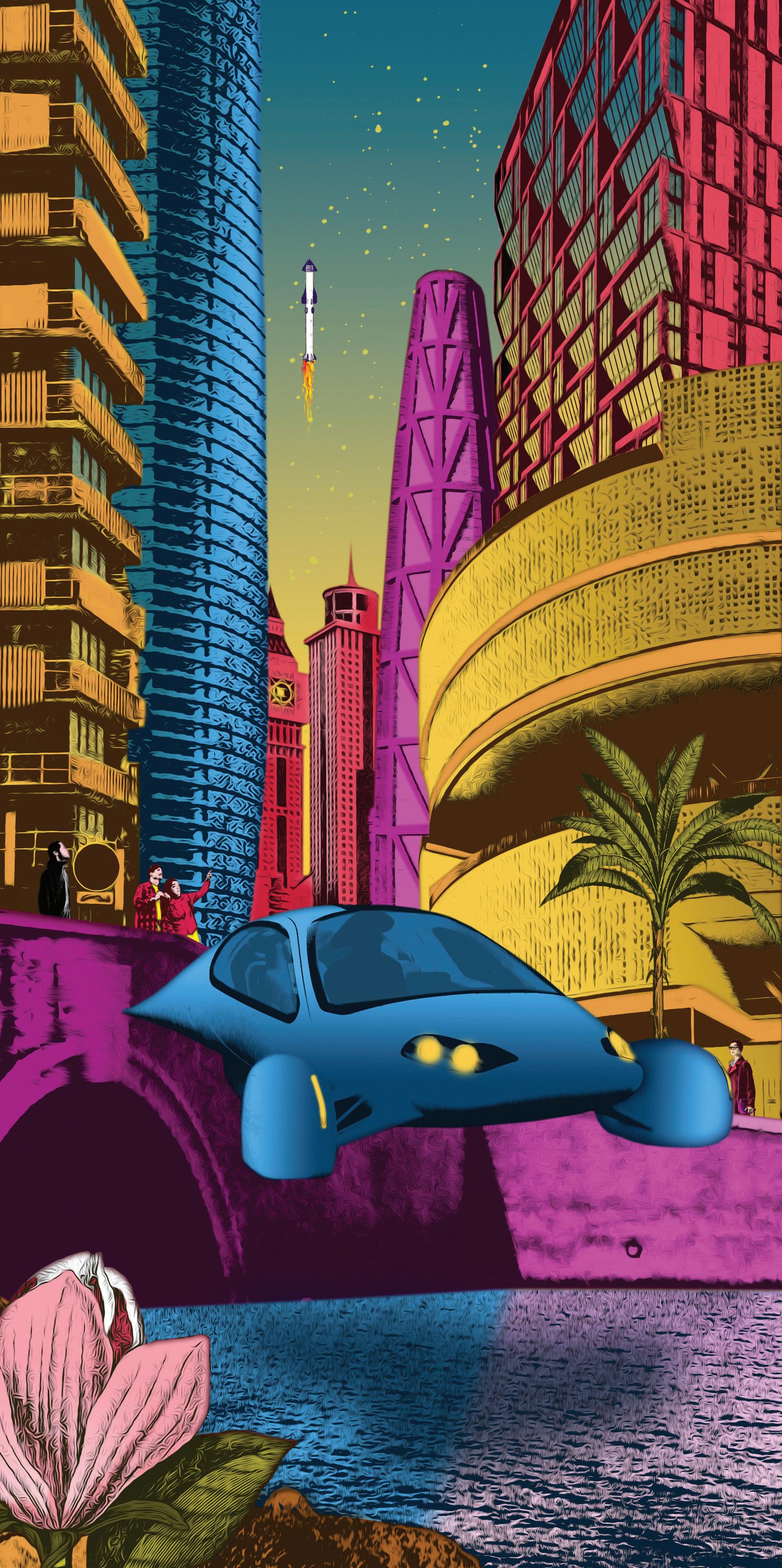
22 BOWDOIN MAGAZINE WINTER 2024 | CLASSNEWS@BOWDOIN.EDU
MAKING PLACE LOVABLE
For many different populations, there’s significant value in like finding like in a city. To respond to Pearlman’s question—who are “we” building for—the paradigm might need to shift.
“Cities that are trying to achieve livability— the standard way to try to be like every other city—can tend to correlate with a negative gentrification and a monoculture,” said Ethan Kent ’98. Kent founded PlacemakingX, an organization that sees public spaces as a means to connect local communities and address a broad range of crises and challenges, from equity to health and isolation.
“Our theory is that you want to preserve and attract lovability—place attachment—and that actually attracts livability in a more inclusive, affordable, and faster way,” he added.
Kent sees that conventional means in which cities strive toward livability do not inspire place attachment but generate a consumptive experience, one that’s transitory, more expensive, and often less culturally distinct.
“But leading with social life, with the existing population defining their public spaces and attracting new people—a new investment on their terms—is a more sustainable and inclusive way of allowing a city to develop.”
Kent has worked in numerous cities around the country and the world, training people to create more inclusive public spaces. This led him to establish PlacemakingX in order to connect and support placemaking leadership and projects all over the world.
“In the ’70s, downtowns around the US were very much disinvested in. People were improving public spaces through policing them and making them less friendly and taking out the seating,” said Kent. “The new idea at that time was to invite people in so that public spaces become safer and more inviting for everybody. The theory was that if any one user group dominates a public space, it’s a form of privatization. It’s not about pushing out those groups—it’s inviting in whoever’s not welcome and supporting them, challenging them to be a contributor to the spaces.”
Spending time working on markets, waterfronts, and squares, Kent has found that investing in public spaces can be a way to address not
just inclusion and economic development but also social health, cultural creativity, and preservation. Kent points to the example of Detroit; by partnering with the local population first, there’s great potential to build—and attract development—from the ground up.
“People love it because they feel like they’re part of its story. They’re being challenged to contribute to the entrepreneurial and cultural ecosystem there,” said Kent. “It’s almost because of its incompleteness, the porosity and openness, that it’s creating this dynamic narrative that many cities should learn from.
“We led a lot of public space projects that worked with the existing population to lead with programming and activation of spaces in the very short term with low costs. That then attracted billions of dollars of investment in the downtown,” said Kent. “Detroit was one of the emptiest downtowns in the country, even just ten to twenty years ago; now, it’s one of the liveliest. It shows how a city can transform through inclusive, active, public spaces, and attract development that adds to those spaces.”
REASON TO HOPE
Though the perception of American cities in the media may sometimes be negative, Katari Gupta sees significant reason for hope in cities’ creativity and adaptability. She thinks often of the public realm—everything between buildings, from the sidewalk to the street, trees, and bike lanes.
“For the last ten to fifteen years in American cities—maybe inspired by a desire to make cities more livable—we have seen a reallocation of the public realm,” said Katari Gupta. “That to me is of huge interest because it is what makes cities more livable, more competitive, and more desirable to be in.”
As people adjusted to life during the pandemic, restaurants reclaimed space from the street for outdoor dining.
“You tell me what’s better for the city’s economy: for somebody to park a car [in a spot] all day and maybe pay five or six dollars to the local parking authority, or for it to be eight or ten tables for a restaurant, the tax from that, the people enjoying themselves, the socialization, the jobs created and preserved,” she added. “I think we realized that not only was it a more
urbane or more gracious use of the public realm, but that cities benefit, too. It’s been really nice to see a lot of cities hang on to those outdoor dining typologies that maybe didn’t exist before but that we’ve all been enjoying in other countries for a long time.”
Reimagining process seems to undergird the philosophy across the board—who’s brought into the process, who’s allowed to become a stakeholder, and what powers they are given.
“One of the things I see about Portland—and why often I would not associate it as a city—is, even though it’s developing these big urban problems, it doesn’t have the infrastructure to deal with them,” said Greene.
Examining the city’s attitude toward addressing social problems, he pointed to a recent city council decision to lift encampment restrictions during the winter.
“People are not necessarily thinking beyond the immediate problem to understand longterm solutions, and how even short-term solutions have impact in terms of the broader infrastructure of the city,” he said.
“I think that the key for problem-solving in places like Portland is providing opportunities for people to think beyond simply the immediate problem,” he added. “As the population is changing, diversifying, and growing, the inequalities have become far starker. It raises a whole series of issues that leads to people coming up with these short-term solutions that can be harmful to the city’s development.”
Suarez also recognizes the need for a new approach. “I think honestly if we want to solve the big problems that cities face, then it has to be a more interdisciplinary approach.”
Cities hold so much within them: the coin’s two sides contain boundless potential for creation and challenges. It stands to reason that the solutions—and the mindset—we bring to approach them must meet them in their full complexity and from there, begin to dream.
Michael Colbert ’16 is a Portland, Maine–based writer. You can find his work at michaeljcolbert.com.
Pierre-Paul Pariseau is an illustrator based in Montreal who works for a wide range of international clients. Find his work at pierrepaulpariseau.com.
BOWDOIN MAGAZINE WINTER 2024 CLASSNEWS@BOWDOIN.EDU 23
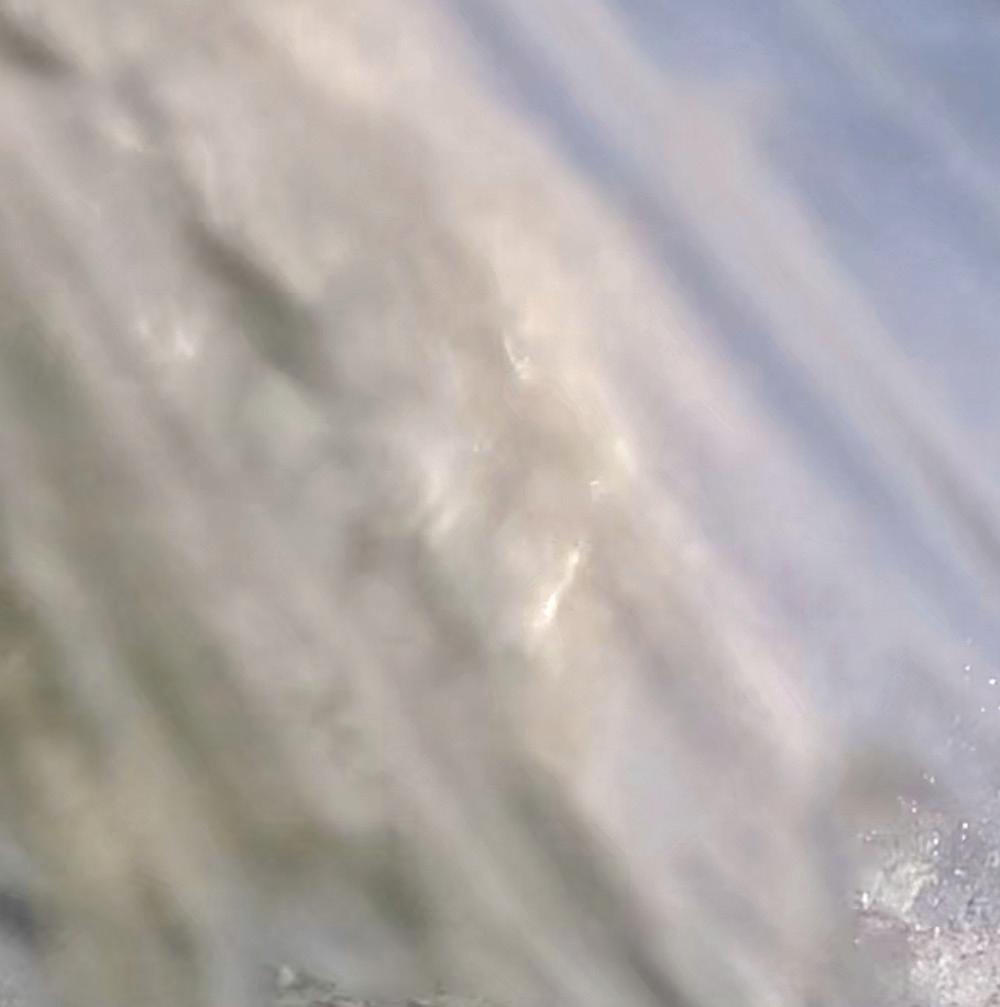
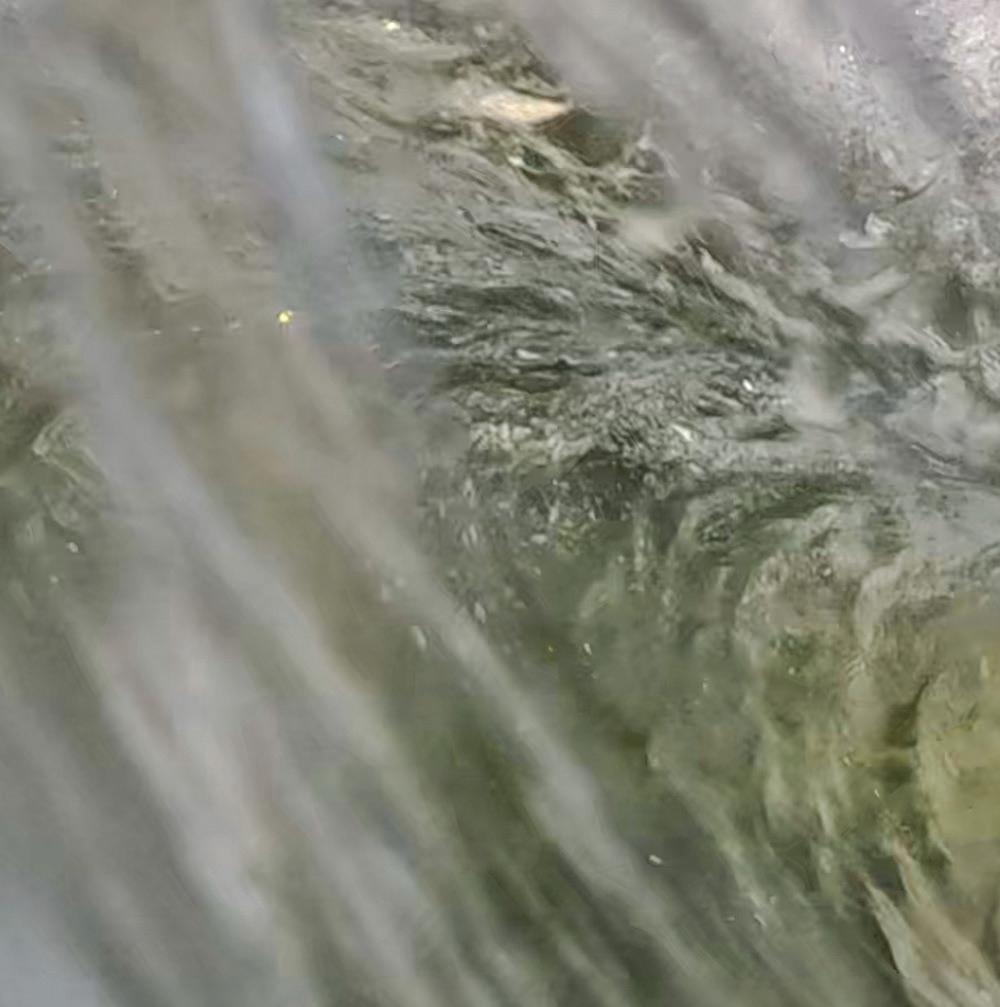

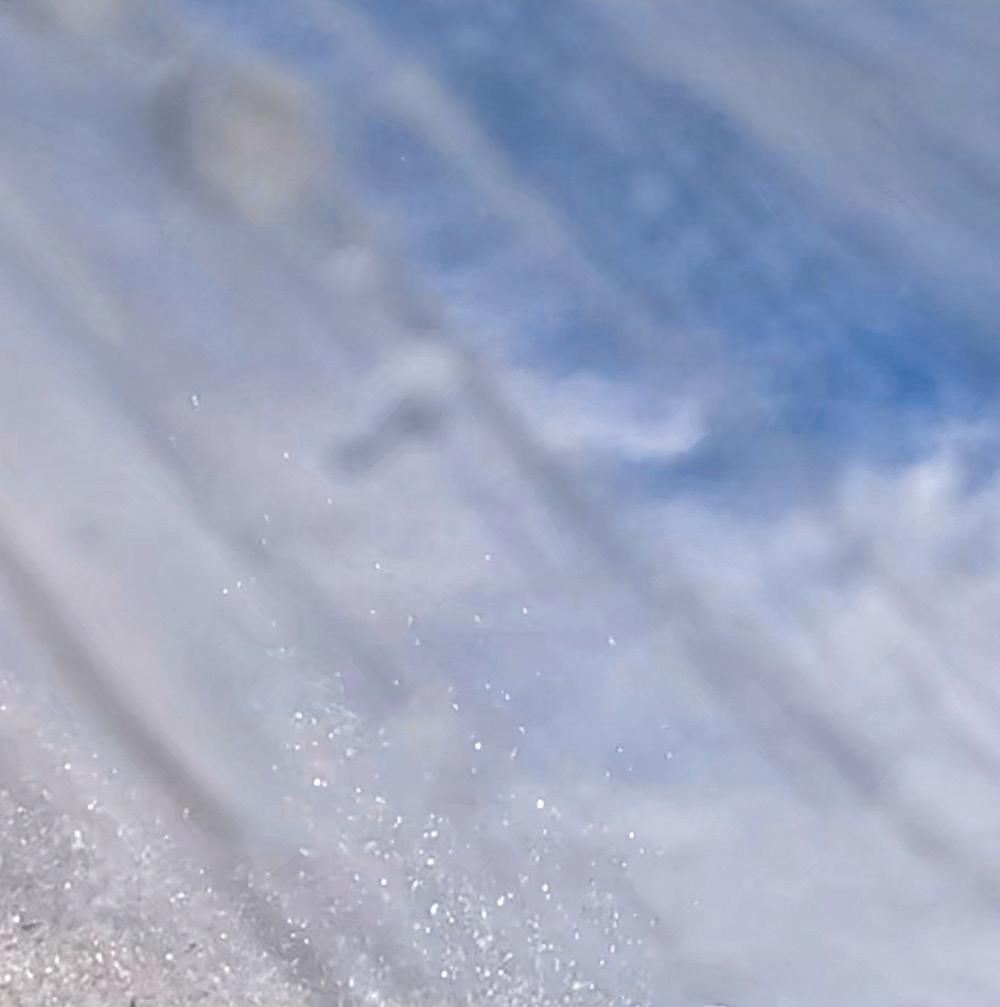
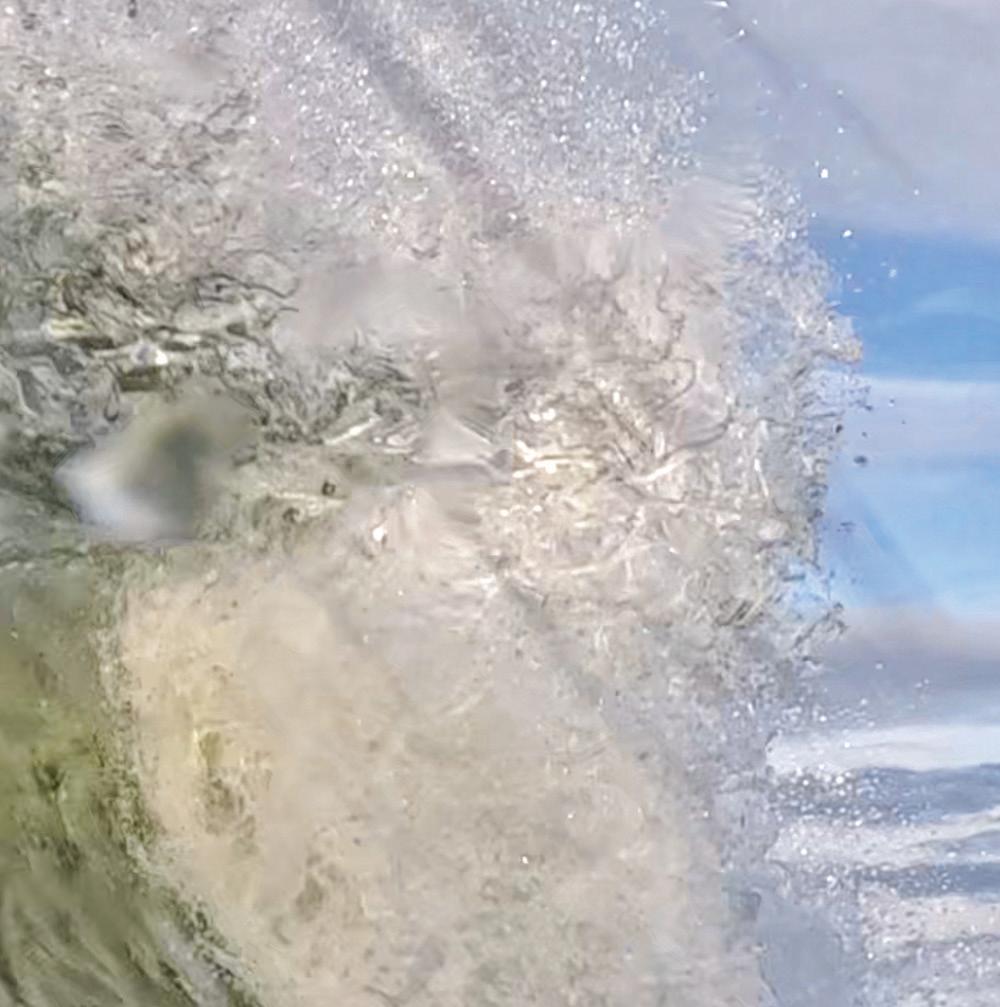
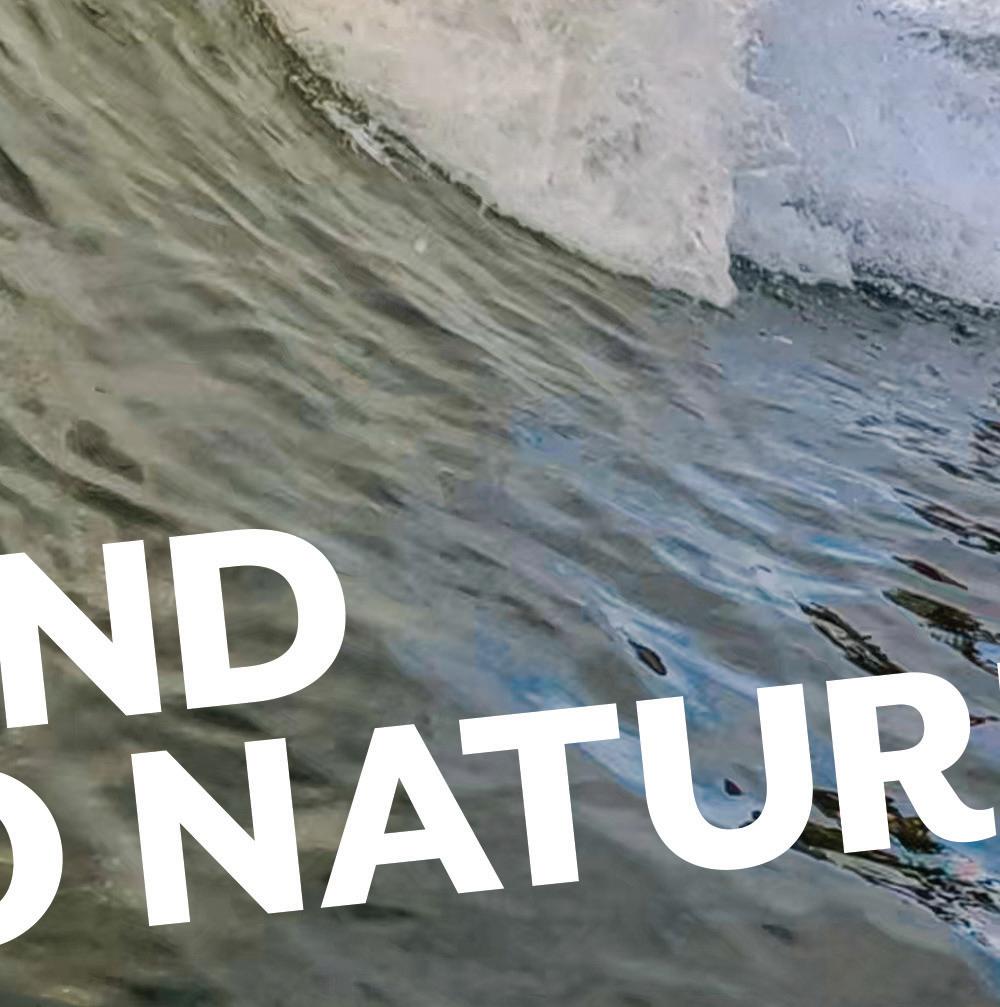

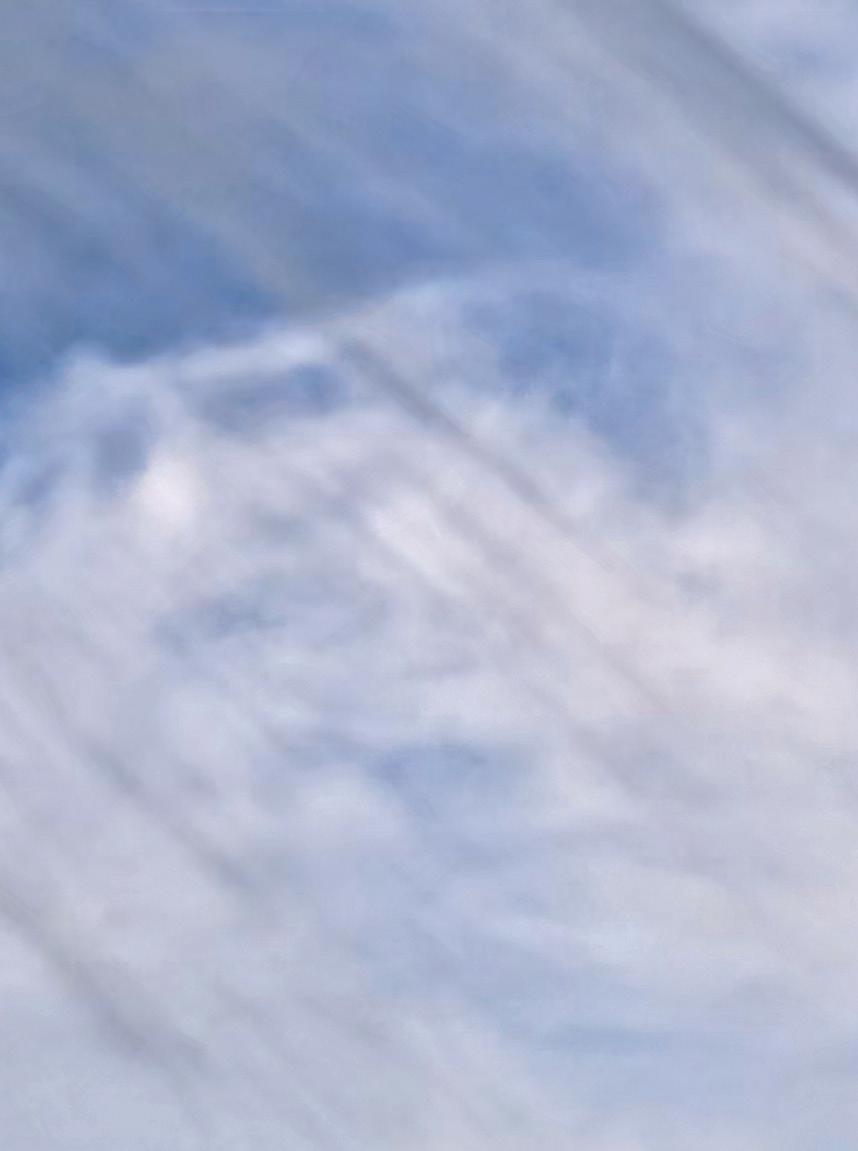
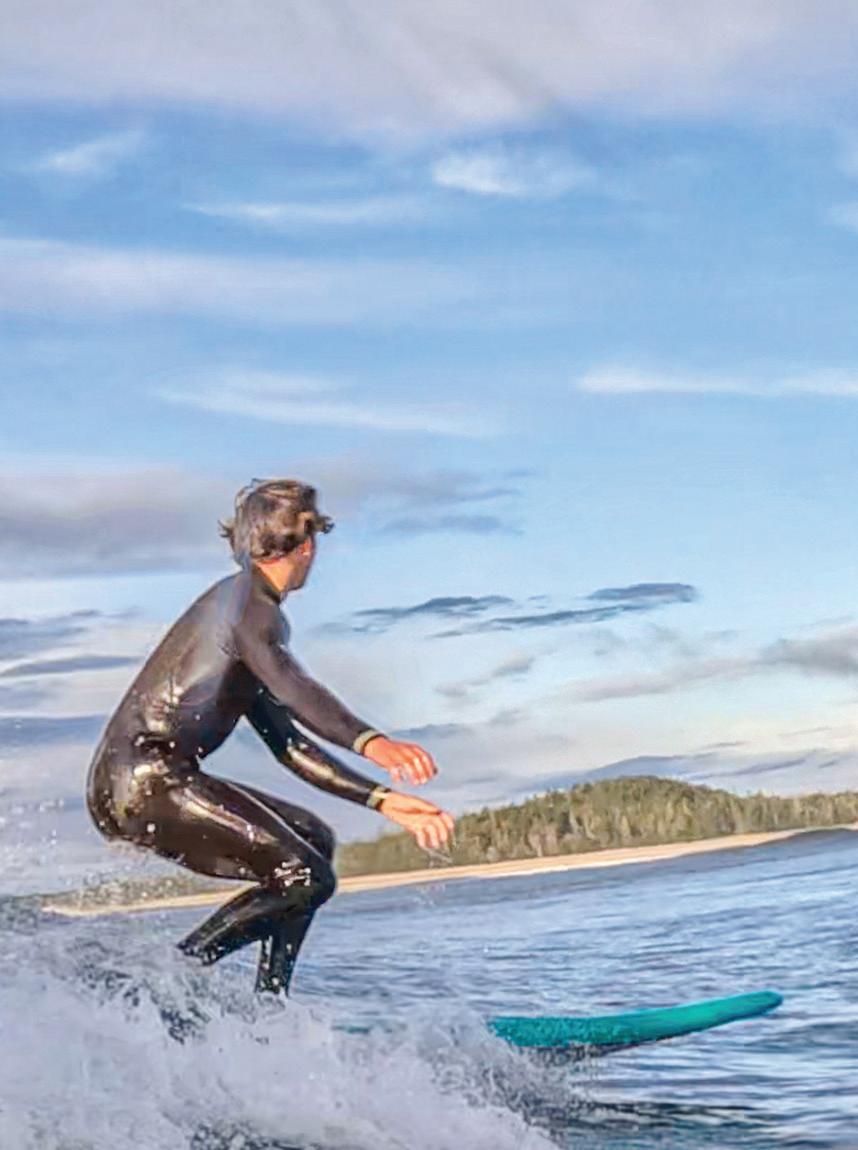
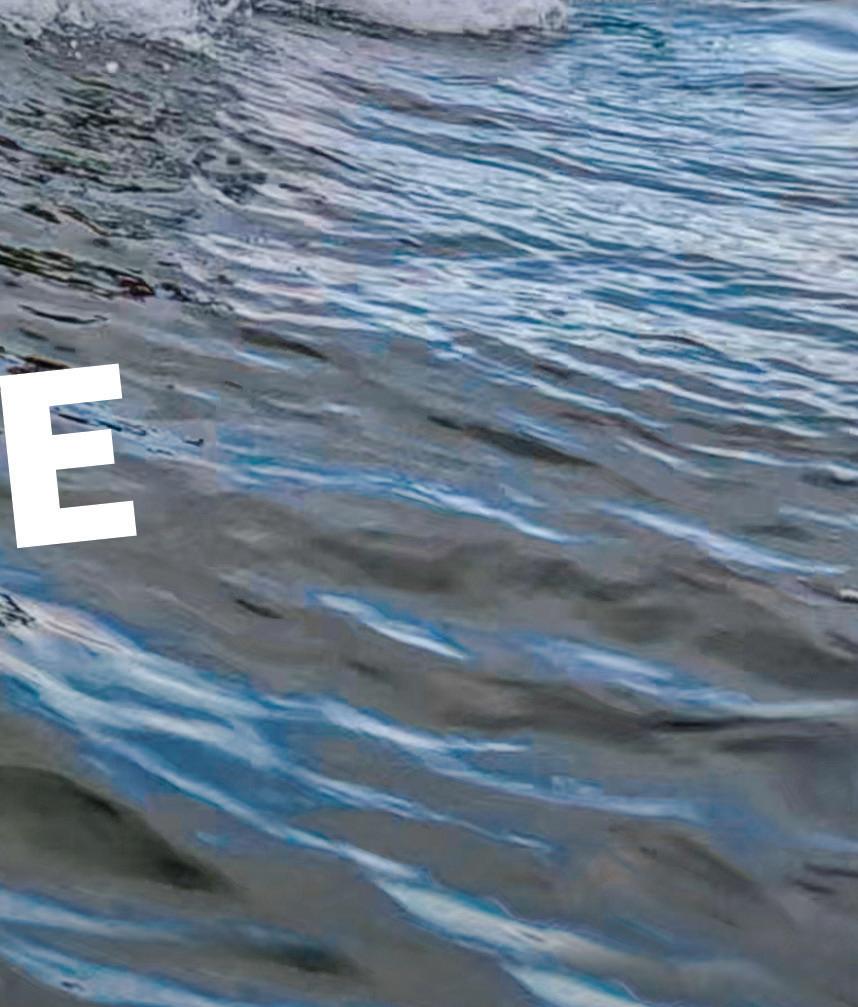
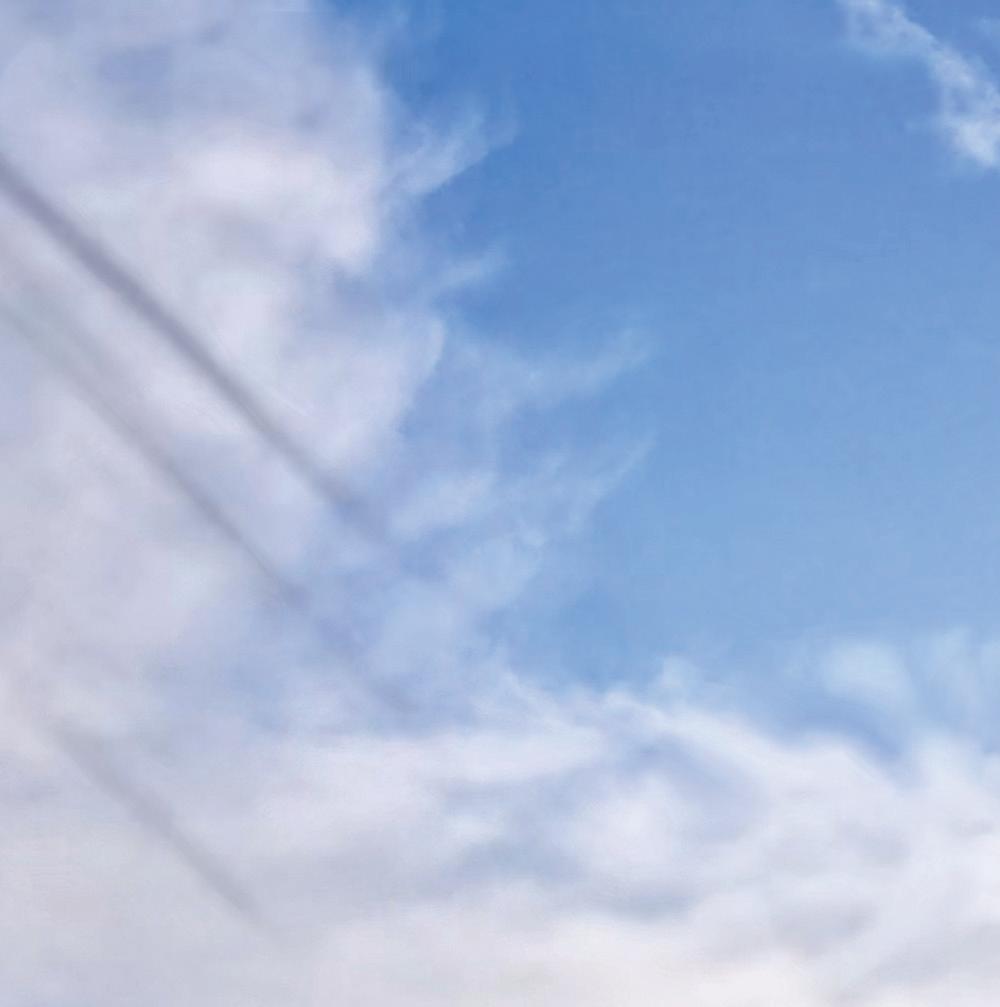
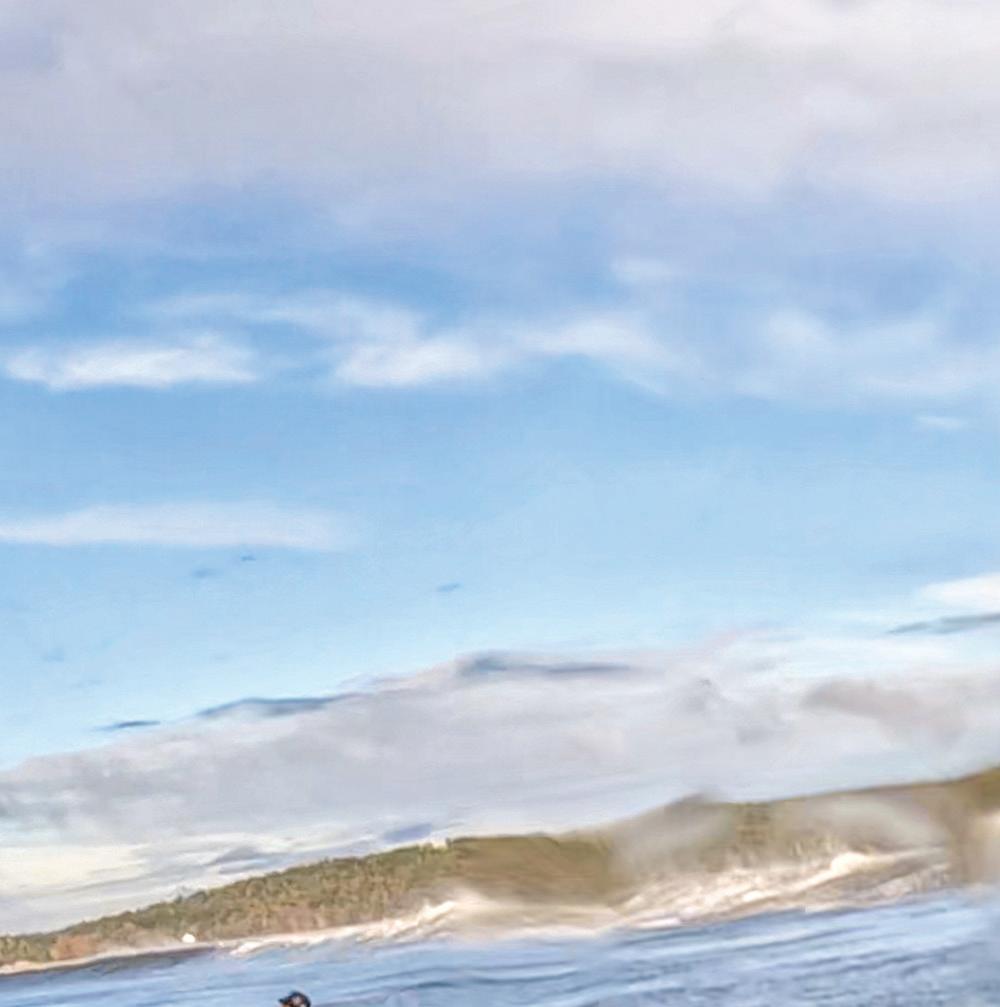

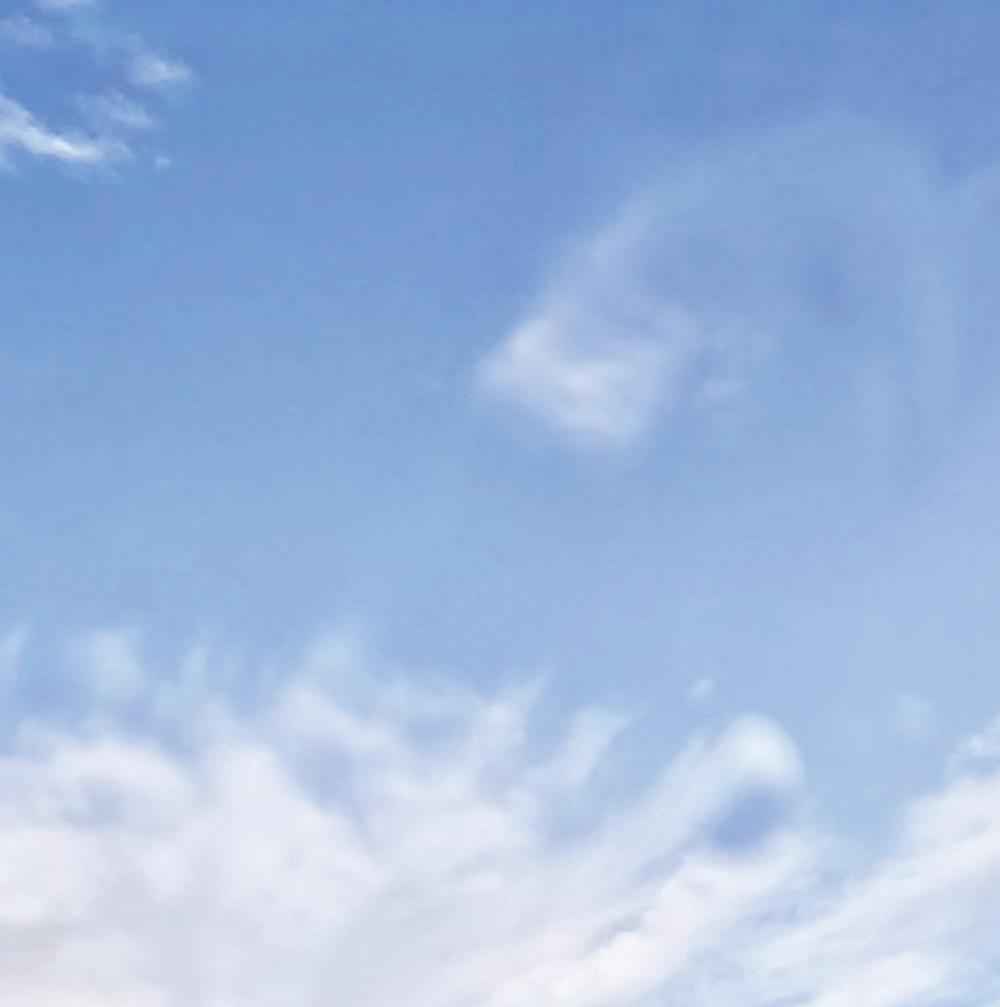
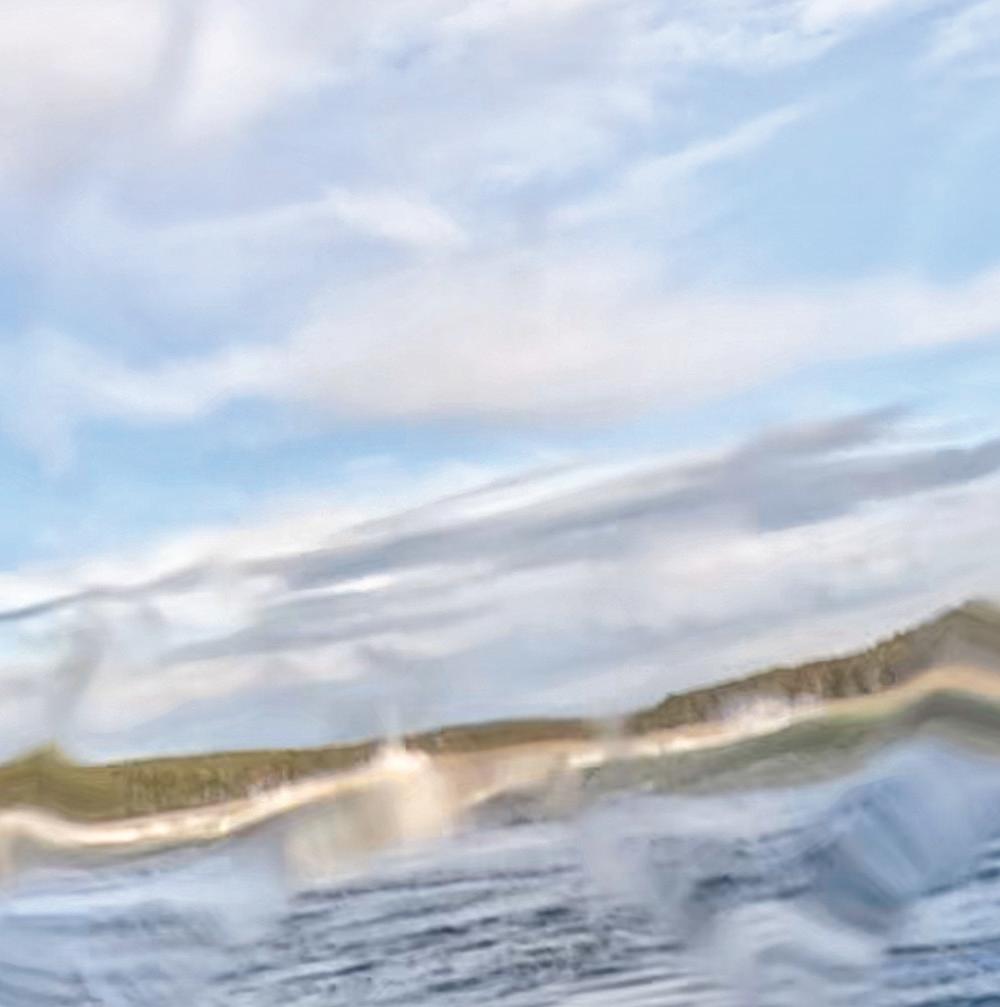
Bowdoin surfer stories span generations, all rooted in what surfing provides—a grounding force through uncertainty and a steadfast connection to nature, a mark of resilience, a measure of passion, and a path toward inclusive community in the outdoors. In Maine’s cold water, there’s a sense of being both a part of and apart from the world, in a moving meditation built on taking, receiving, and riding the waves, open to what is given.
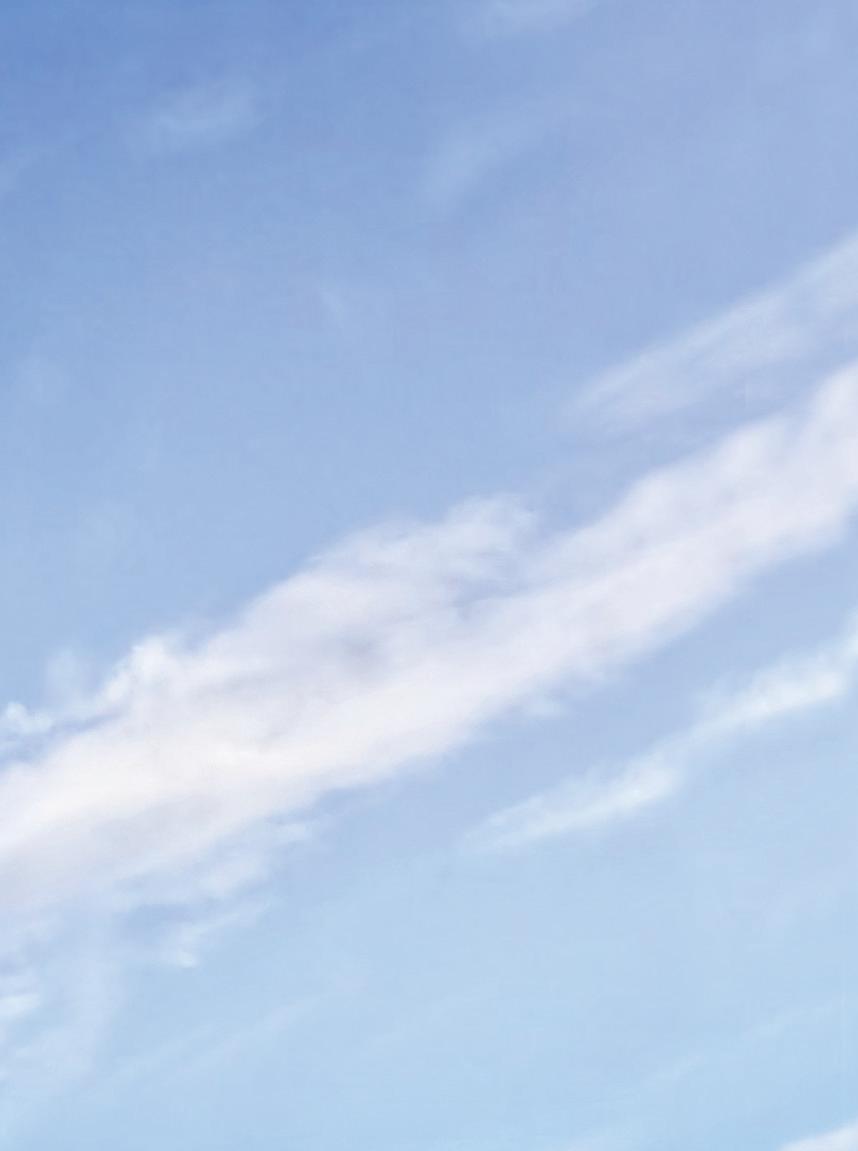 BY CHRIS RITTER ’21 PHOTOGRAPHS BY HEATHER PERRY
BY CHRIS RITTER ’21 PHOTOGRAPHS BY HEATHER PERRY
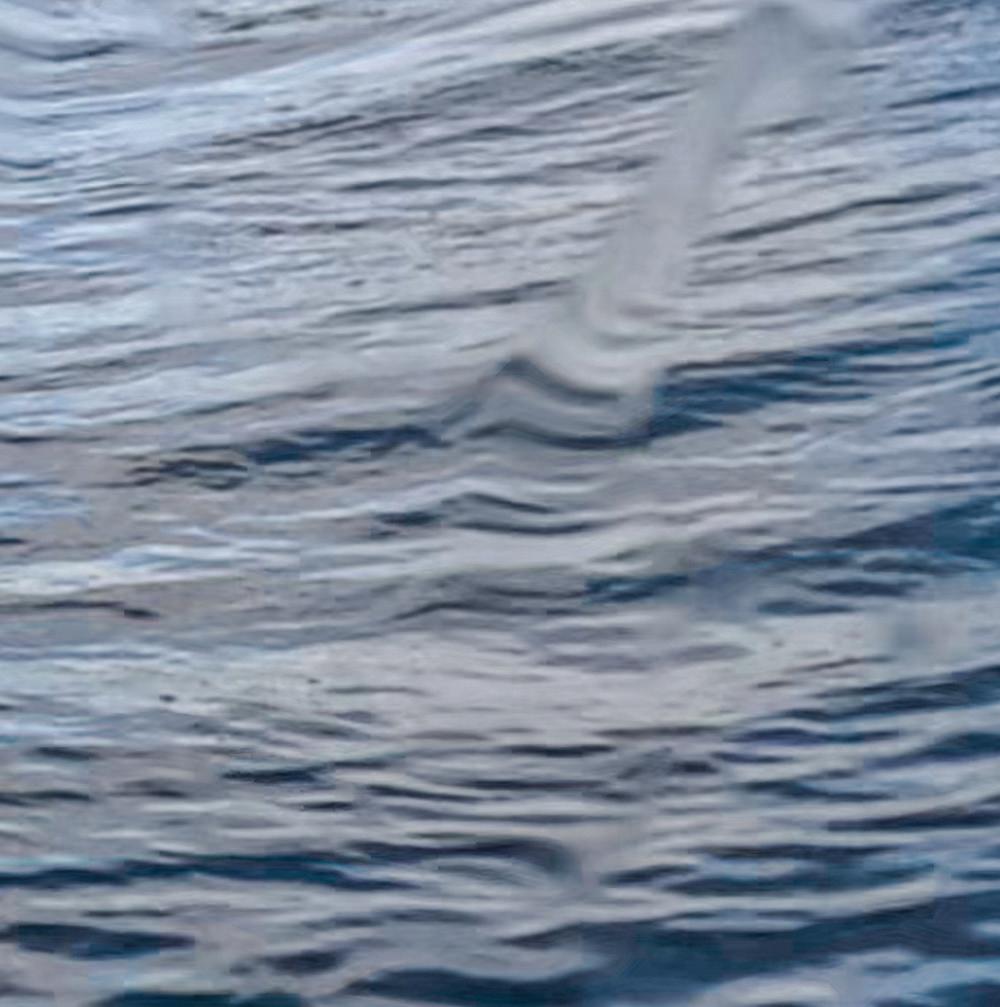

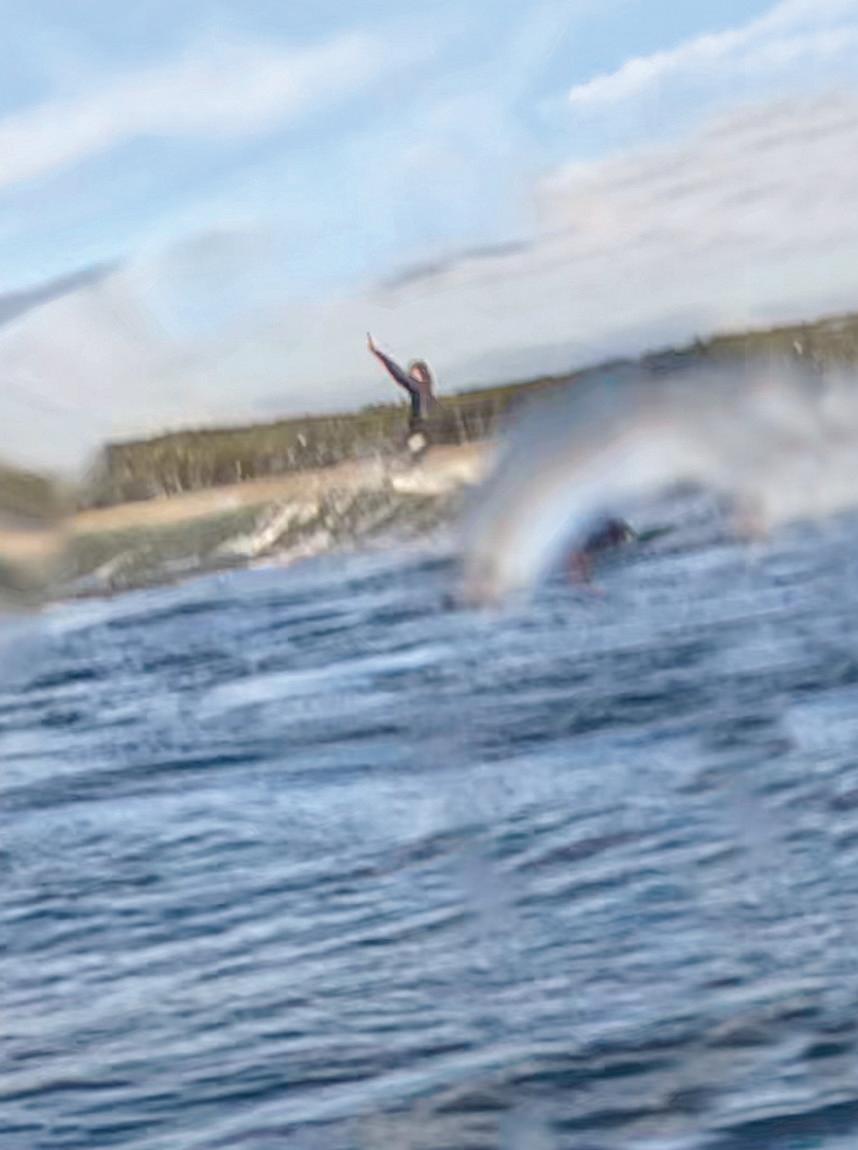
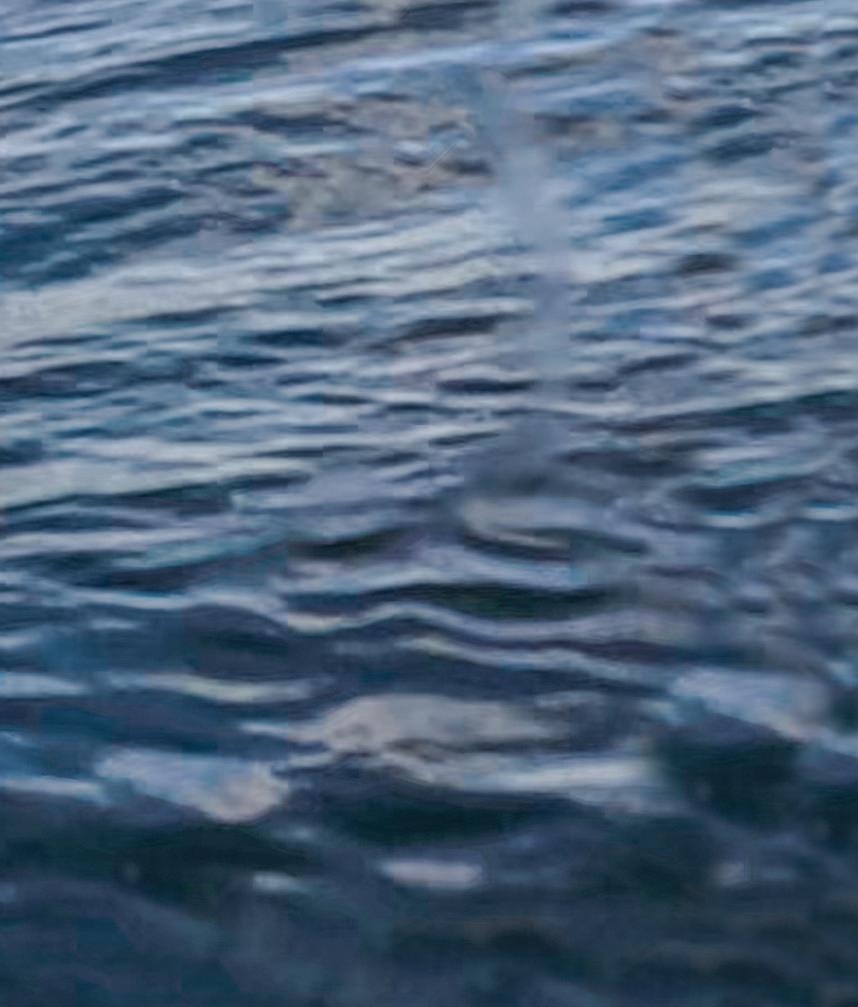
Opening spread:
Evan Knight ’22 surfs a wave while Sapphire Hall ’25 waits for another.
Below: Waiting for waves in the water at Popham Beach.
Opposite page:
Adrian Bossi ’85 with surfboards at his home in Brunswick.
ON A PARTICULARLY terrible afternoon at Higgins Beach, my roommate, John Lane ’21, and I were the only ones out in an ocean that looked like soapy bathwater. It was forty degrees, warm for early March in Maine, but the water was probably close to forty too. A crosswind howled up the bay, churning the water into a foamy mess, with waves breaking into each other in every direction. There’s a very specific kind of pain that comes from dunking your head underwater to evade a broken wave. It’s a feeling remarkably similar to brain freeze, but it’s more malicious than anything you might get from a bowl of ice cream. Maine surfers know the feeling well.
I learned to surf during my first year at Bowdoin. My roommate, who grew up down the road in Yarmouth, had surfed his whole life. I, on the other hand, had about as much surfing experience as you’d expect from an eighteenyear-old who grew up nowhere near the ocean in western Virginia. I grew accustomed to following
John into truly horrendous conditions. Most days, when I asked him how the waves were, he’d reply with one of a number of catchphrases he used to egg me on. Among them were “doable” or “could be fun” or “yeah, there could be a little something out there.”
On this day in 2019, in our sophomore spring, there was definitely “a little something out there.” Whether it could be fun or was even doable was in serious doubt.
By then, a community of surfers had grown at Bowdoin. What once seemed like an inside joke between roommates was blossoming into an eager community of folks willing to cancel plans, wake up before the sunrise, or brave nor’easters to hurl themselves into the ocean, and then, for some reason, choose to come back.
But on this particular violent day in midwinter, it was just me and John. In the brief moments of peace between set after foamy set, I asked myself the only question worth asking in that situation.
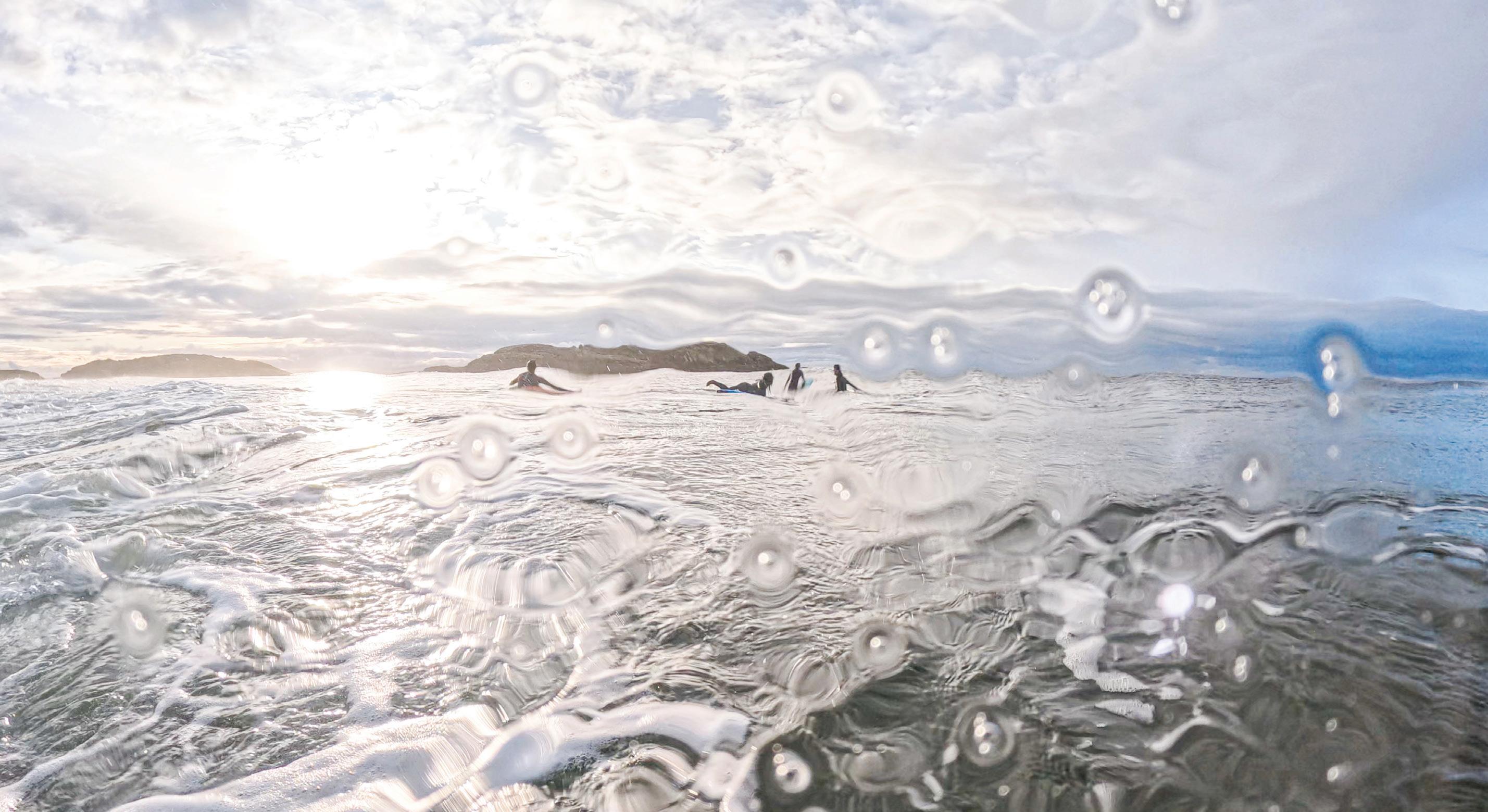
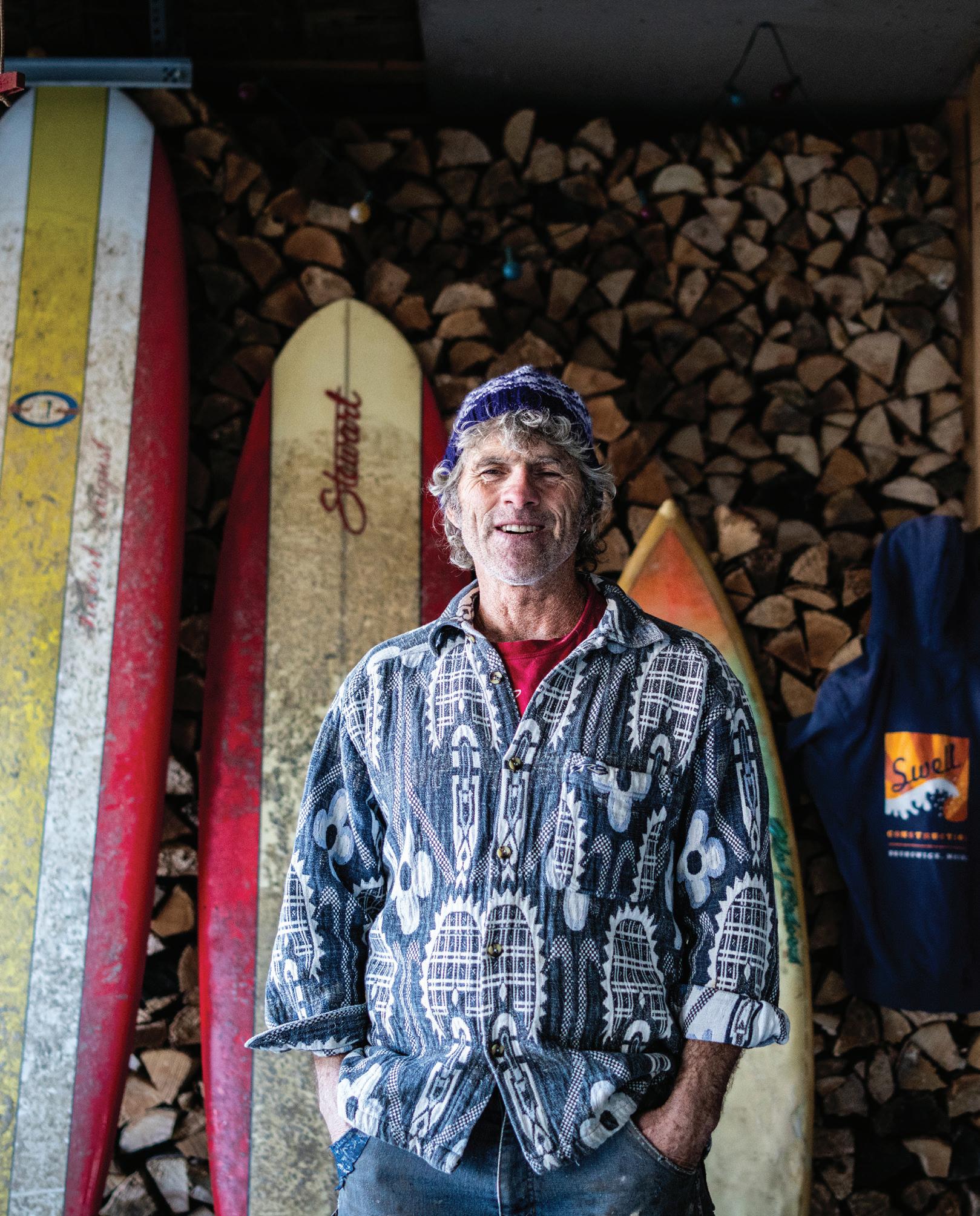
It’s a question every Bowdoin surfer has asked themselves, I think, at one point or another, head throbbing while looking out at the blank sea— why am I surfing, and why am I surfing here?
BOWDOIN STUDENTS have been surfing in Maine since at least the mid-’70s. With no phones, internet, or Surfline to forecast the waves, students like Hank Lange ’76 and Sprague Ackley ’76 relied on NOAA weather radios and a fair amount of luck to score waves.
“People came to surf activity in organic and chance ways,” according to Dave Menz ’85. As a sophomore, Menz remembers living upstairs in the house of former director of Moulton Union Don Lancaster, which sat on the lot
now occupied by the Roux Center for the Environment. That year, Menz found a sevenfoot-two, red-finned Plastic Fantastic board in Lancaster’s garage and started going on trips.
Stories of those early trips read like the stuff of other early East Coast surf lore—half epic mission into the unknown, half DIY school project. After finding the Plastic Fantastic, Menz went with Scott Harrison ’85 to a dive shop in Brunswick to look for a wetsuit. Having pooled their money, Menz and Harrison could afford to rent one half of one wetsuit for an afternoon. They went with the top—a quarter-inch-thick wetsuit jacket with a beaver-tailed bottom and nothing to cover the legs. With one board and one piece of wetsuit to share, Menz and Harrison
“I’ve surfed some greatspots,butjust the camaraderie of surfingwiththose friends in Maine made it so much better there.”
—ADRIAN BOSSI ’85
were forced to take turns surfing, while the other would watch from behind a rock on the snow-covered beach. Other times, they went with no wetsuit at all, wearing wool caps and “some other ridiculous clothing modifications, which failed,” said Menz. “It was obviously so crazy.”
It’s an understatement. Reading Menz’s account of these trips in an email, I think, These guys were insane. Having surfed here, I’ve been advised by people who know better than I do that doing anything in the Gulf of Maine in winter requires a full wetsuit that’s at least five millimeters thick, along with booties, gloves, and a hood that covers as many inches of your face as possible. I’ve been close to hypothermia wearing all of it.
But, not knowing better, Menz and company made it work. It was February of 1983, before you could order gear online and before surf shops dotted the East Coast.
By spring, a community was growing. Menz and Harrison were joined by a group of five or six like-minded surfers who had caught wind of their misadventures along the coast.
Among the group was Adrian Bossi ’85, a frizzy-haired carpenter from Cape Cod who remembers those trips with a wistful fondness. I meet Bossi outside his home in Brunswick, and he gives me a sampling of his favorite memories from those early trips—scoring hot chocolate and peppermint schnapps in the water from some local kayakers, listening to Beach Boys tunes on a Sony Walkman on the beach with the crew
BOWDOIN MAGAZINE WINTER 2024 | CLASSNEWS@BOWDOIN.EDU 27
It’saquestioneveryBowdoinsurfer hasaskedthemselves,Ithink,atone pointoranother,headthrobbingwhile lookingoutattheblanksea—whyam Isurfing,andwhyamIsurfinghere?
group of six to ten at a time, mostly made up of people who weren’t dedicated surfers until college. “Nowadays, we have a bunch of surfers who come in with experience, and they plug right in,” Woodruff says. “Back in the day, guys were kind of just reinventing the wheel—finding boards in a basement or a garage and figuring it out with a Saran Wrap wetsuit.”
There’s joy in reinventing the wheel, though. Woodruff talks about the misadventures of his Subzero friends with the same reserved spark as when he talks of the generations of beginner surfers who have rolled through trips with the BOC.
Opposite page, top:
Opposite page, middle:
Opposite page, bottom:
while watching one of them surf in their lone wetsuit. Eventually, Bossi got his own—a holey yellow-and-orange suit that he covered in Saran Wrap to keep the water out (remember Menz’s ridiculous clothing modifications, which failed).
It had no designation on campus, but the group eventually dubbed themselves the Subzero Surf Club. They were a dedicated bunch. Forecasts be damned, Bossi remembers going with the Subzero crew to check the waves “every single day.” They would go to Small Point, a finicky right-point break not far from Popham Beach.
“If the waves weren’t good, we’d still just go in the water and splash around,” said Bossi. Bossi has since surfed in Australia and the South Pacific, but he remembers his time surfing in Maine as particularly special. “I’ve surfed some great spots, but just the camaraderie of surfing with those friends in Maine made it so much better there.”
Menz sees it the same way. “At the end of the day, what became clear to us was the joy of immersing in wild nature, where sea meets land, together with friends,” Menz writes. “That’s the mere simplicity of what we were up to, and that spirit has remained with us throughout our lives, as we are still immersing in the wilds.”
TAGGING ALONG on many of those trips with the Subzero crew was a kayaker—Mike Woodruff ’87. Perhaps no one has seen more of Bowdoin’s surf history than Woodruff, who paddled out with the early members of Subzero, and is known to students today as the head of the Bowdoin Outing Club, a position he’s held since 1992.
Woodruff recounts how, until recently, Bowdoin’s surf scene was usually limited to a
“You don’t have to be an advanced surfer to totally get your life’s energy from it,” Woodruff says. “No matter the conditions or your ability level, it’s already a net gain to spend the day outside—and then, when you do have an awesome day, it’s mind-blowing.”
This is a graciousness fitting for people who surf, especially in Maine. For those who immerse themselves in it, surfing anywhere is more than just an activity—it’s a way of life, a guide for surrendering to the unpredictability of nature and finding joy in whatever comes. In Maine, with its always frigid waters and rarely consistent waves, perfect days happen but are few and far between. Ask anyone who’s surfed here, and they’ll tell you it makes those days even sweeter, and every day in between more worth showing up for.
While there have almost always been a few stoked surfers at Bowdoin, Woodruff says that, compared to other outdoor sports, the BOC has had a harder time finding those willing to teach surfing to beginners. As surf crews came and went, for years the scene stayed limited to the few obsessives willing to seek out the sport largely on their own.
But, slowly, that would change.
THE FIRST TIME Zoe Wood went surfing, she was teaching it. Wood ’18 was studying abroad in Chile, and she had volunteered to work with a local environmental nonprofit near the coast. She was tasked with teaching English, environmental lessons, and surfing—the latter of which she had never done before.
“Suddenly I found myself pushing kids into waves and yelling, ‘Stand up! Stand up!’ when I couldn’t really surf myself,” says Wood.
28 BOWDOIN MAGAZINE WINTER 2024 | CLASSNEWS@BOWDOIN.EDU
Alex Washburn ’25 rides a wave.
A view through the barrel of a left-breaking wave, with a surfer about to drop in to catch it.
Evan Knight ’22 and Sydney Reaper ’21 looking out to the ocean for the next wave.
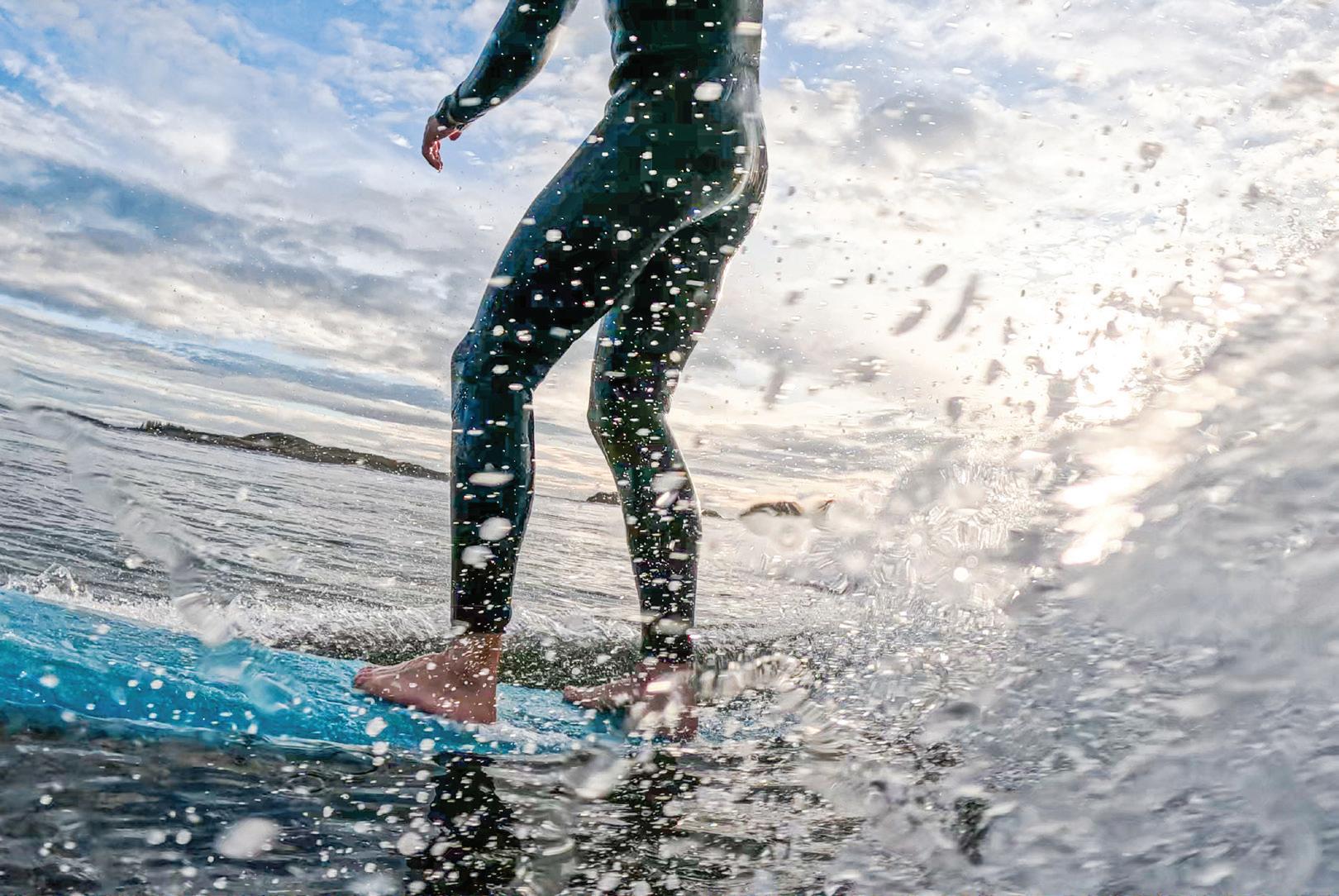
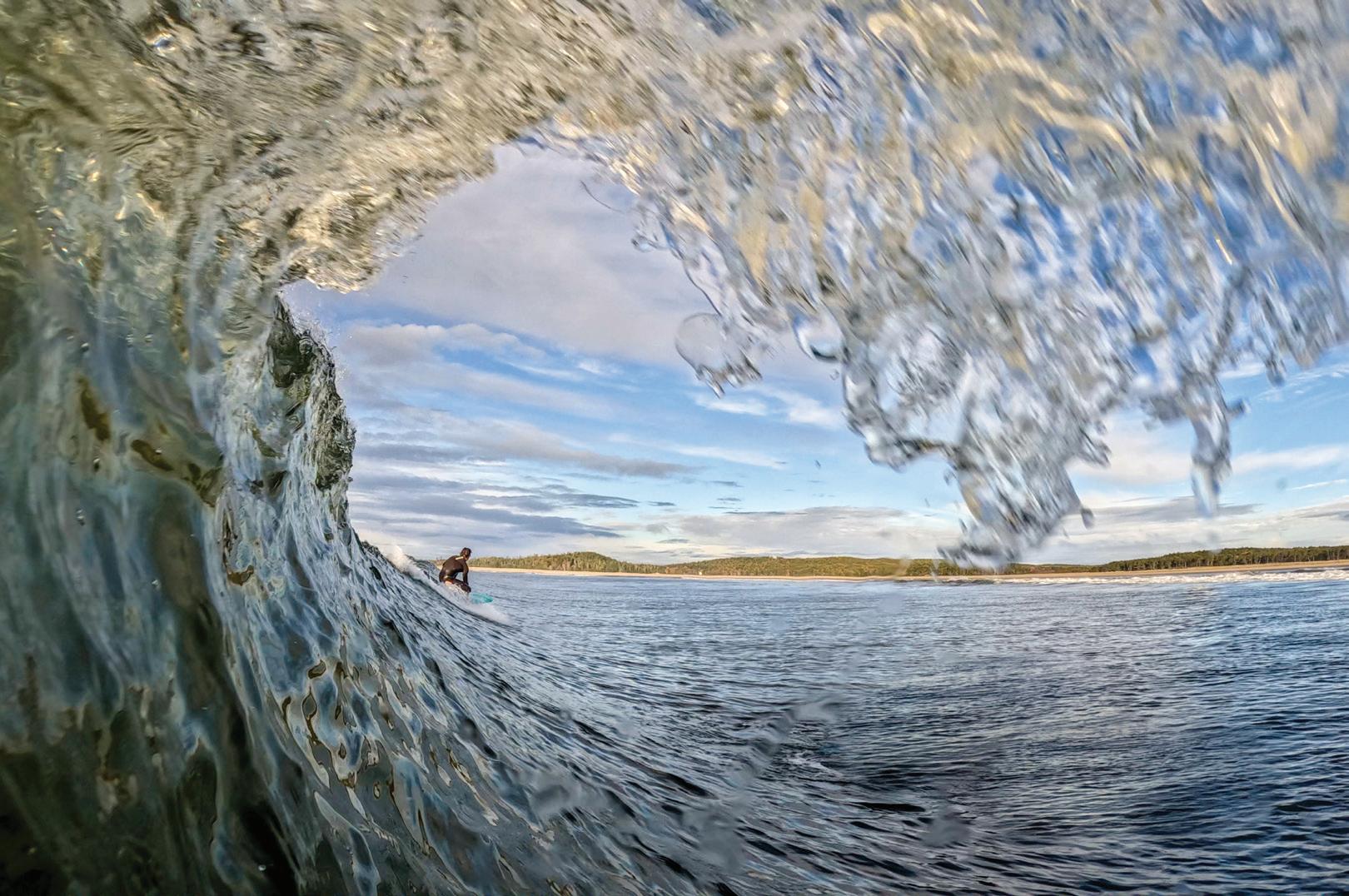
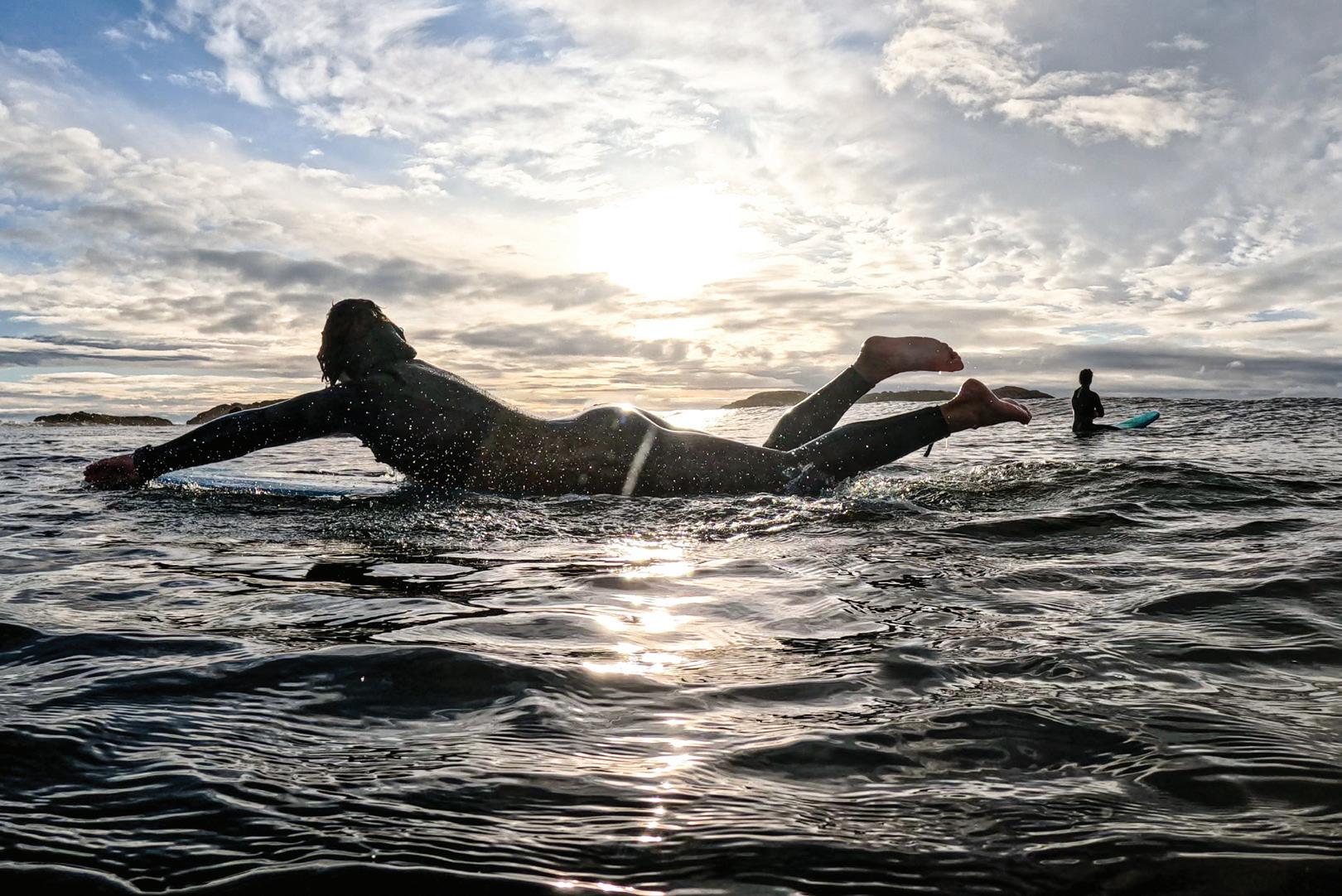
But when presented an opportunity to share her love for the ocean with others, Wood ran with it. Wood grew up New York’s Hudson Valley, but she fell in love with the ocean swimming in the waters near her grandmother’s house on Long Island in the summer. The ocean guided her decision to come to Bowdoin, and it continued guiding her life from there.
When Wood returned to Maine for her senior year in 2017, surfing was more accessible than it had ever been at the College—the Outing Club had a sizable fleet of foam boards, and vans took several trips to the beach per week—but big challenges remained. BOC surf trips would fill up within seconds of them going live online. Before they were leaders themselves, Shona Ortiz ’21 and Abby Wu ’21 remember, they pestered leaders to tell them when they were going to post a trip so they could refresh their screens at just the right moment like they were in a Ticketmaster queue.
If you couldn’t land a spot in a BOC van, you’d need a car, a board, and a wetsuit, or to find someone who could supply you with all three. And that’s just to get in the water.
There are more pervasive barriers too, and Wood knows them well. Wood and other women surfers I talk to, especially those of color, have faced their share of suspicious looks and snide remarks in the lineup, in Maine and elsewhere— You know there are waves further inside, right? Do you know how to coat your board?
“I feel like I’m always scanning the crowd to see how many women and how many people of color are out there; it can really change a session,” says Wood.
It’s clear that she takes that awareness with her when she teaches. “It’s really important for someone to feel welcome in their first experiences in surfing, because that feeling of not belonging can be really insidious.”
Those feelings are only compounded by a sport where the learning curve is already steep. Wood notes a truth well known to anyone who starts surfing past their adolescence—before you’re any good, you’ll spend a long time being very, very bad. In Maine, you’ll also be very, very cold and battling inconsistent weather and raucous waves. It’s a sport where confidence, even blind confidence, is almost a prerequisite.
BOWDOIN MAGAZINE WINTER 2024 | CLASSNEWS@BOWDOIN.EDU 29
Bowdoin surfers have used many different tools to break barriers to surfing here, makeshift wetsuits and NOAA radios included. But teachers who are aware of those barriers are among the most vital.
“Surfing is such a joyful sport, and there can be a lot of barriers to feeling that joy,” says Wood. “But that feeling of surfing, where you’re in total control but also letting go and responding to what the ocean is doing, it’s just the best. I want everyone to have that.”
After Bowdoin, Wood had a job offer that would take her to Colorado, but she couldn’t make herself go. Too landlocked. She stayed in Maine and spent some more days trading waves at Higgins with Maine locals and other Bowdoin grads before moving to California.
Wood wasn’t the only teacher to help bring more people into the water at Bowdoin—she cites Hannah Baggs ’17, Jamie Ptacek ’17, and Ella Driscoll ’17 as important surf leaders during her years at Bowdoin. But Wood was part of a generous group of people working carefully at being better stewards of the sport, making it easier for all folks to get a glimmer of the obsession. They were sowing the seeds of a community, leaving them for those who came next.
“AM I STUPID?” It’s 2019, and Evan Knight ’22 is standing naked in the snow again. It’s probably around 8:00 a.m. It’s also eight degrees, and Knight has just come in from another midwinter surf session with Stephen Boe ’22. They’re both crab-handed and, having used most of their energy to peel off their soaked wetsuits, Boe is having a hard time unlocking the car. Warmth rapidly exiting his body, Boe asks himself another question—“Do I die here?”
Fortunately, they don’t. Knight recalls the morning with a laugh, sitting in his wonderfully roomtemp apartment. Hailing from Santa Barbara, Knight has surfed most of his life, and has always looked the part—on campus, Knight was notorious for longboarding to class barefoot well into the fall and winter. Today, Knight lives in New York with Boe, another lifelong surfer. The two work together and surf on Long Island together, and they remember their surf stories together like the Subzero crew does—graciously, lovingly, and happily aware of their own ridiculousness.
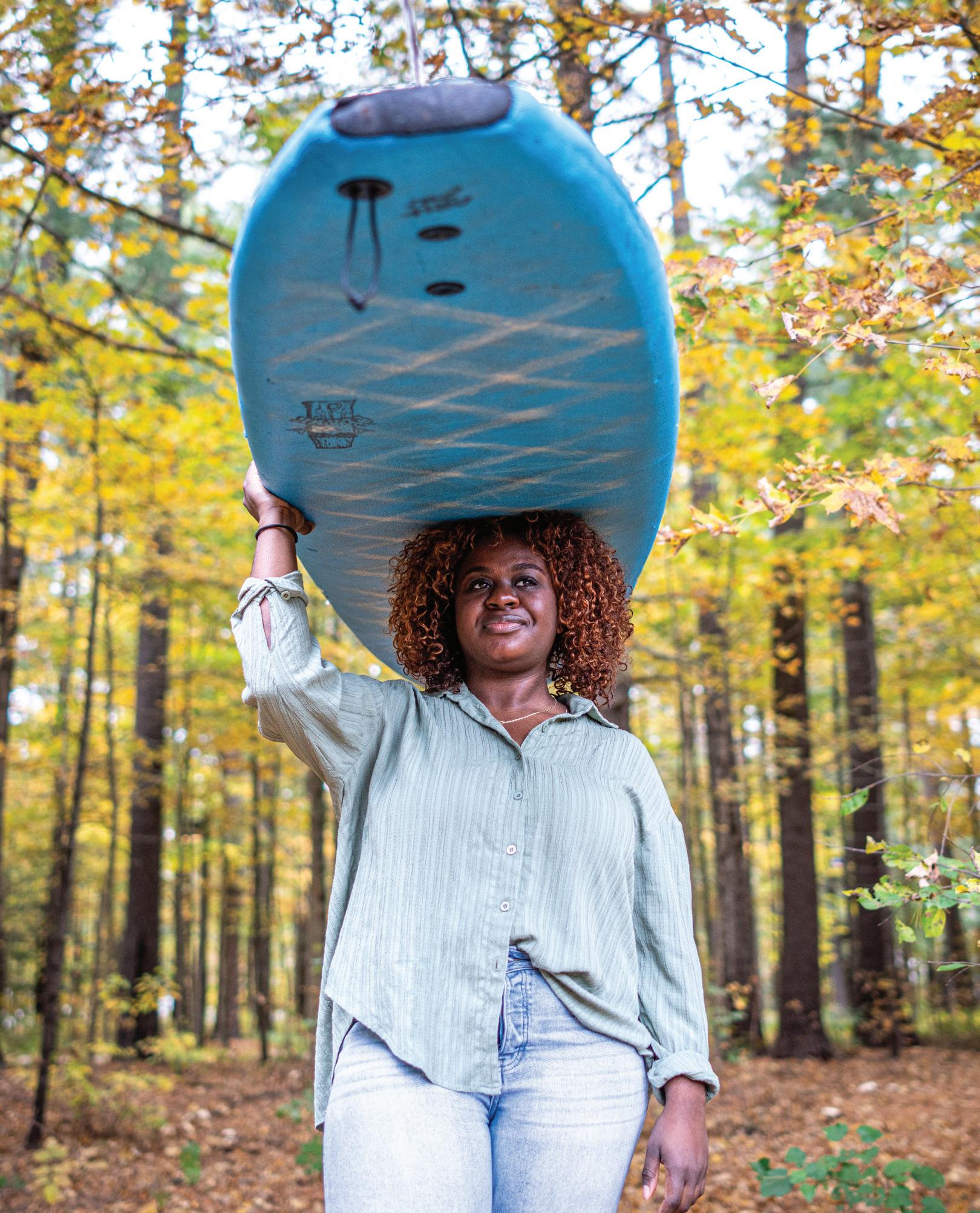
Lifelong friendships have formed over surfing at Bowdoin since the Subzero days, but it was more of a chance occurrence then. By the time Boe and Knight met, if you were looking for surfers on campus, you didn’t need to rely on chance to find them.
Spots on BOC trips went quickly as ever and, outside the BOC, surfers began to organize in new ways. Soon, the Bowdoin surf scene had what was, at the time, the hallmark of unofficial Bowdoin community-building—a group chat. At its peak, the chat held as many as ninety people. When waves were good, the chat flurried with plans to coordinate sessions around class and social schedules—cars left before sunrise or raced from campus to catch the last bits of
daylight on winter afternoons. Surfers still went to nearby beaches like Popham but were more commonly going south to the Scarborough area, like Higgins Beach, for more consistent breaks. When waves were bad, people sent ideas for dream trips to places like Nova Scotia, or, more frequently, plans for watch parties of the animated film Surf’s Up.
“It was a really beautiful, fun thing,” recalls Annie Schiffer ’21. Schiffer, who ran on the track and cross-country teams, was drawn to the informality of surfing. “A lot of activities at Bowdoin are very based on goals, like winning a game, or making a magazine. The surf group just kind of emerged out of a lot of people who wanted to find others who wanted to do this one thing.”
30 BOWDOIN MAGAZINE WINTER 2024 CLASSNEWS@BOWDOIN.EDU
Schiffer, originally from inland New Jersey, was one of a host of people around this time who had never surfed before Bowdoin, but who became prominent members of its surf scene by simply wanting to go all the time—frothing, in surfer speak. Schiffer was hooked on the sport and the social scene that was forming around it: “You would have these forty-minute drives to Higgins or Popham and get to know people in a close, but laid-back way.”
As for the cold? Well, for those willing to venture out in winter, it made the camaraderie even stronger. “In Maine, there’s this deep mutual respect in the water that I love,” says Knight. “In the winter, it doesn’t matter how good you are at surfing, you just kind of see other people in the water and are like, whoa… you really want this shit.”
Group chats and hypothermic trauma bonding aside, people still stumbled into surfing in more familiar, chance ways. Sydney Reaper ’21
reminds me that the first of many surf trips we took together came to fruition when she saw me pull a wetsuit out of the dryer in the basement of Coleman Hall, our first-year dorm.
Methods vary, but people pulled by the ocean tend to find each other.
I MEET UP WITH Sapphire Hall ’25 and Alex Washburn ’25 in the BOC kitchen. It’s around dinnertime, and I had planned on eating the chocolate-covered pretzels out of the giant barrels I remembered from my time in this room, but Hall starts making pancakes, and offers me one. We take seats on the barrels of pretzels, GORP, and other familiar things, and start talking about surfing.
Some things haven’t changed. Hall tells a story of one of her first times surfing in Maine with Washburn, where she forgot part of her wetsuit and paddled out at Higgins in neoprene Farmer Johns and a black puffy jacket.
Below:
Alex Washburn ’25
Opposite page:
Sapphire Hall ’25

“I could not believe you did that,” Washburn laughs. Unbelievable, sure, but fitting for someone at a college whose surfers have thrived on ridiculous clothing modifications, which failed
Both Hall and Washburn grew up surfing— Hall in South Carolina and Florida, Washburn in California. Woodruff had told me about both of them. With about twenty years of surfing experience between them, they’re both staples of the BOC’s surf leaders, and Hall has just returned from a summer teaching surfing in Senegal. I recognize them both from a meeting held in this building two years ago, when I was still a student. It was their first semester, and my last. I tell them this and feel old.
Things have changed since that meeting— there’s a strong core of surfers here, but numbers are fewer. Hall recalls her first year as special: “There were a lot of people in that year from the Class of 2022 that made it super fun. There were great memories, great vibes, great surfing.”
Hall notes Jamie Lau ’22, who led several trips for women of color, and Ethan Strull ’22 as particularly welcoming.
“Those people genuinely dedicated so much time to taking new people out,” said Washburn. “If I were to put myself in their shoes, that would be a lot. I really appreciated it.”
Whether it’s paddling out in a snowstorm, paddling out in a puffy, or accepting an invite to ride in the car from a surf-minded stranger you only know through a group chat, Bowdoin surfers have long had their ways of making surfing in Maine work. Some ways are crazy; other ways are just people.
I’m in Maine for a couple more days after we talk, and Hall, Washburn, and I are trying to surf. It’s October, and while there are no snowstorms in our way, the waves refuse to cooperate in a way that feels all too familiar. It’s supposed to be small and mushy all weekend, but there’s an uptick in the forecast early Monday. I hesitate
 Below: A wave flips one of the boards into the air. This can be dangerous when the water is crowded, but on this day the Bowdoin surfers were the only ones in the water.
Opposite page, top: Sydney Reaper ’21 heads for the surf.
Opposite page, bottom: Chris Ritter ’21
Below: A wave flips one of the boards into the air. This can be dangerous when the water is crowded, but on this day the Bowdoin surfers were the only ones in the water.
Opposite page, top: Sydney Reaper ’21 heads for the surf.
Opposite page, bottom: Chris Ritter ’21
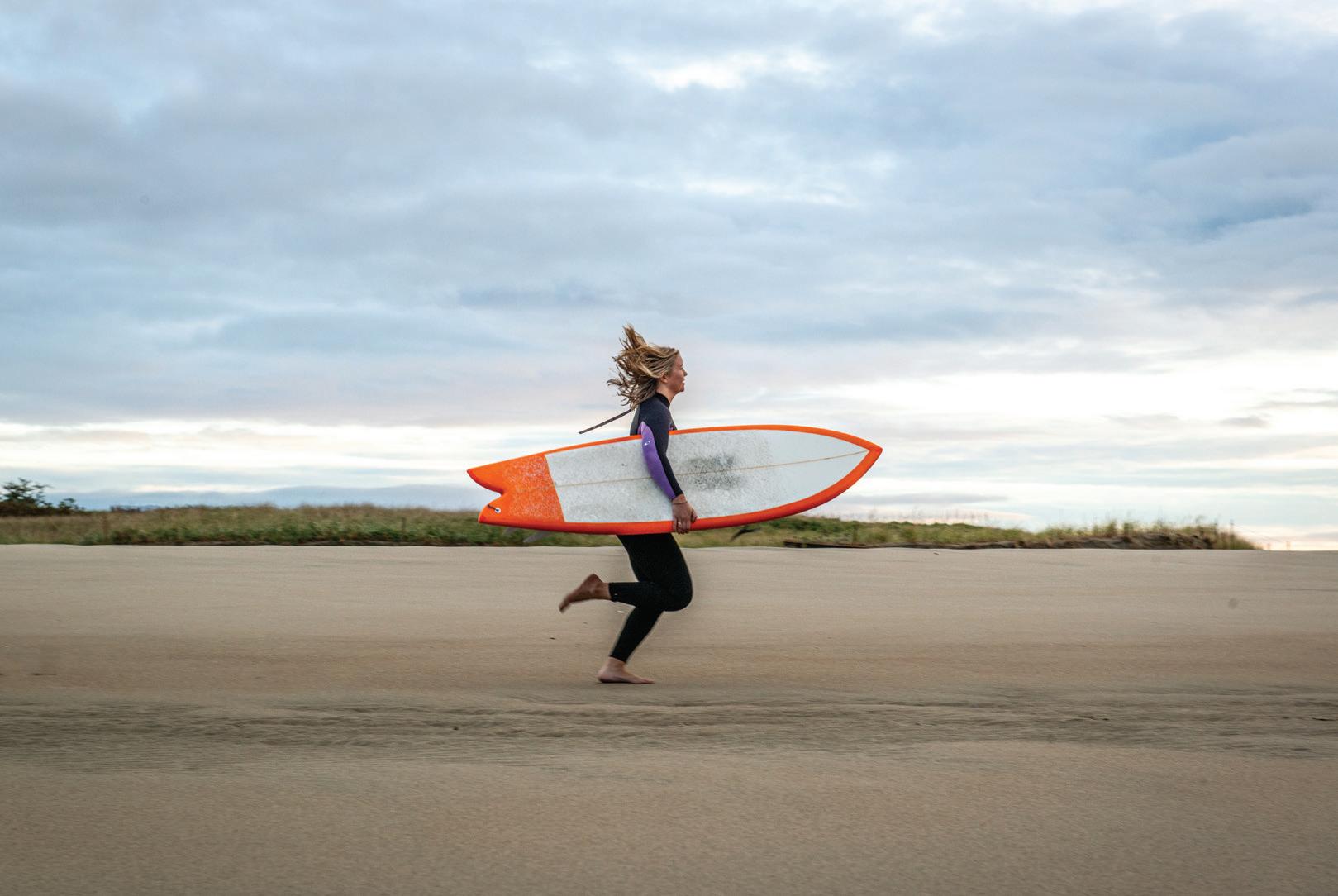
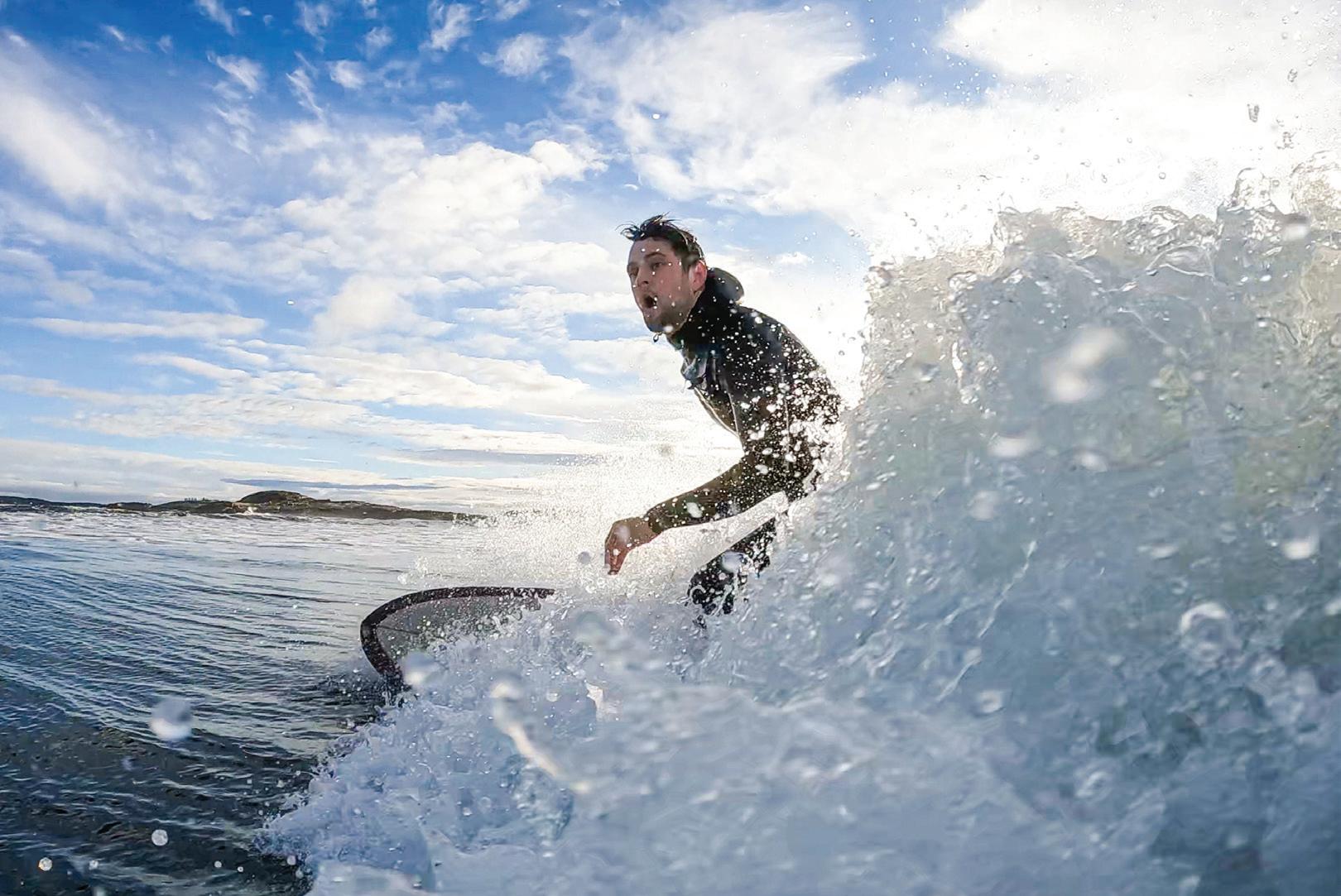
to ask them to change schedules—they could very well have class that morning.
It turns out they both do, and it turns out they don’t care. They’d need to be back by ten, but they could squeeze a session in. Hall mentions her professor for that class, Chuck Dorn of the English department, surfs too. If she’s late, he’ll understand. Still, I wonder if they’ll make it.
I’m thinking again of how Menz described how people typically came into surfing here—“organic and chance ways.” That there’s a consistent group of surfers at a tiny college in the East Coast’s coldest state feels like the greatest stroke of chance of them all. But that chance has come to people who have been ready to meet it. Surfing, with its requisite attentiveness to the movements of nature, can be a way of life anywhere. But in Maine, and at Bowdoin, surfers are frozen into that practice, the joys of it hard won. It’s harder to receive what the ocean has to offer when that ocean is forty degrees, and it’s snowing, and the only wetsuit you have is not a wetsuit at all, and you don’t have a car to drive to the beach, and you don’t see anyone in the water who looks like you. Surfing becomes more than just an activity more quickly here than it does in other places. It’s a mark of resilience, and a connection to something deeper that can only be earned through work that is sometimes hard, sometimes spiritual, and sometimes silly. Most of the time, it’s all three.
Surf communities at Bowdoin have come and gone through the years, the scene ebbing and flowing with time. But I’m not surprised that there’s always been at least a hardy few here, working for the rewards of a life guided by the ocean.
Hall and Washburn pull up to Popham Beach, the white BOC truck’s headlights cutting through the gray morning. I wonder why I ever doubted they’d come.
Surfinganywhereismorethan justanactivity—it’sawayoflife, aguideforsurrenderingto theunpredictabilityofnature andfindingjoyinwhatevercomes.
Chris Ritter ’21 is a freelance writer and photographer from Lexington, Virginia, whose work has been featured by NPR, Genius, Blue Ridge Outdoors, Live For Live Music, and more.
Heather Perry is a photographer, swimmer, and travel guide based in Bath, Maine. See her work at heatherperryphoto.com.
BOWDOIN MAGAZINE WINTER 2024 | CLASSNEWS@BOWDOIN.EDU 33
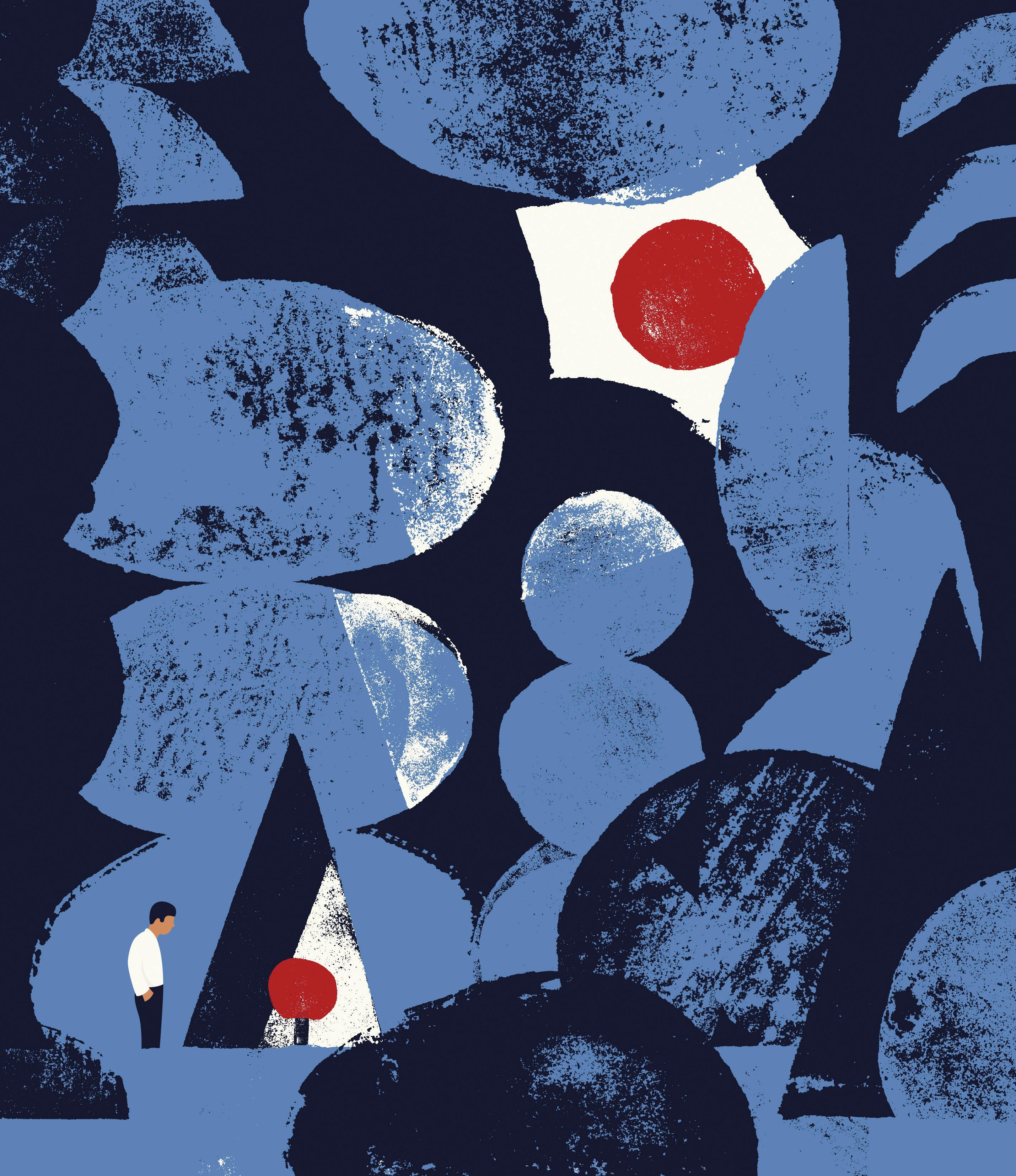
The Root of All Virtues
ILLUSTRATIONS BY FRANCESCO CICCOLELLA
What is the role of humility in a world that equates success with self-promotion? Can our desire for a healthy self-esteem coexist with a sense that we are fundamentally no more important than other human beings? Cultivating humility, whether named explicitly or not, is embedded in the education that Bowdoin offers. Our students arrive here with a list of accomplishments and awards, validated in their achievement. They are lauded and vaunted. In admissions odds that have grown vanishingly small, they have been admitted. Almost immediately, each of them learns how very, very little they know. This can happen in a class, around a table in the dining hall, anywhere they have a conversation with other smart people. It can be shocking, even panic-inducing. But in fact, it’s one of the best things that will ever happen to them. It is a feeling, you could argue, our world needs more of. That awareness—a sense that the universe is so full of things to know that we can never know them all, that our time to learn is finite and the body of knowledge so vast, that every person we encounter has something to teach us—is an essential facet of wisdom. It is also the key to repairing our public discourse and to leading with empathy. We asked some members of our community to think and write about humility. They share their stories here—generously, even humbly.
Bowdoin’s director of religious and spiritual life, Oliver Goodrich, recalls the dirty and humbling experience of picking potatoes that helped him understand his place in the world and the idea that humility is the gateway leading to understanding ourselves and others.
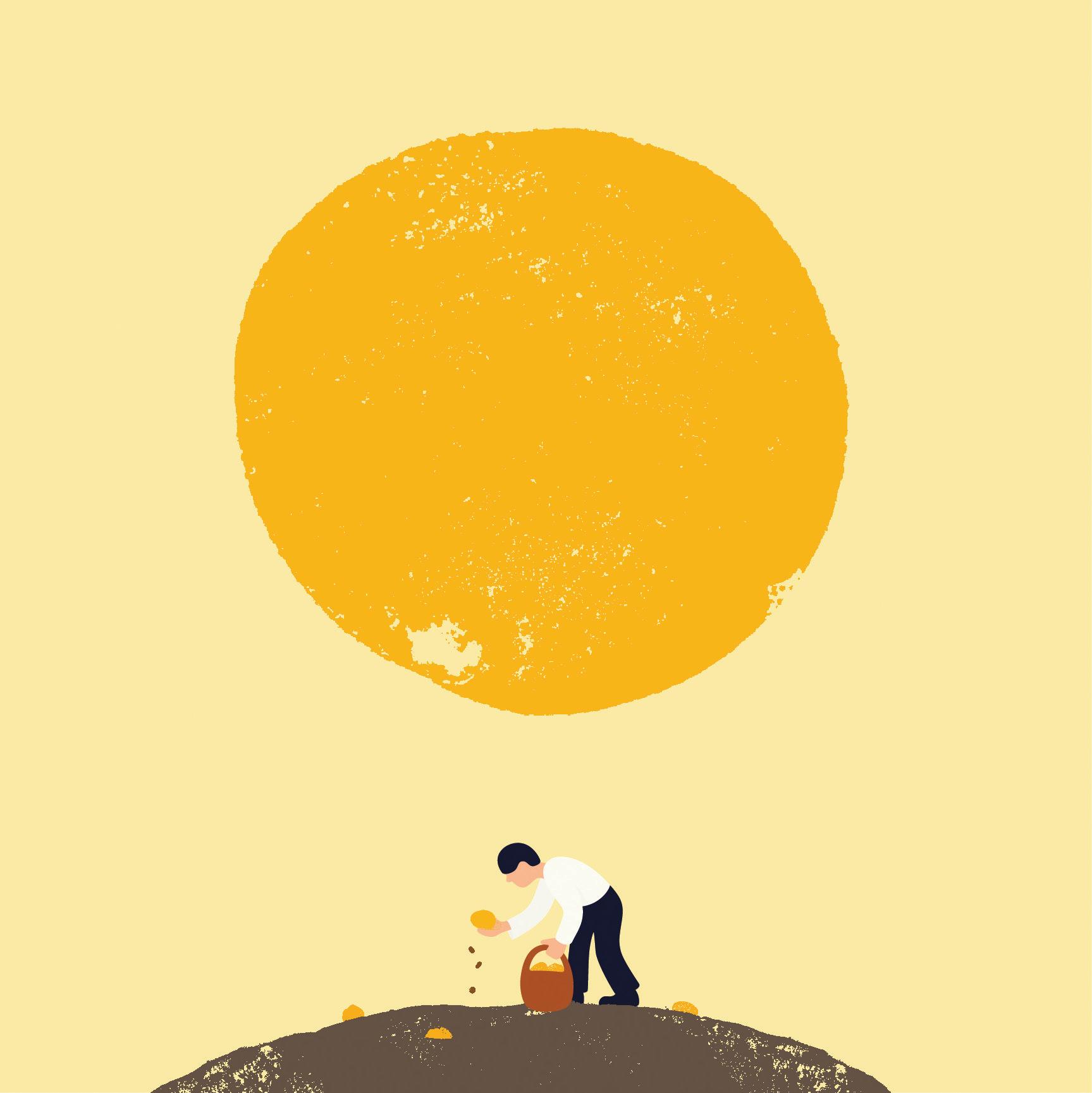
Down in the Dirt
DRIVING NORTH on Maine’s Interstate-95, miles before you reach my hometown of Houlton, you’ll begin to notice potato fields carved among the rolling hills. Potato farming is an Aroostook County tradition that goes back generations. Many small towns hold festivals each year in July to celebrate fields full of tiny white flowers, and whole communities roll up their sleeves to harvest the crop each fall.
As a child, I heard stories from my mother and grandmother about the hard work and adventures of the harvest. My grandmother would boast of picking 120 barrels of potatoes a day, a feat she had accomplished with a child hanging off each hip. My mother could pick eighty to a hundred barrels a day—not quite up to her mother’s standards, but impressive. When I finally got my first experience picking
potatoes in 1997, my largest haul was a meager forty barrels. Most days less.
Potato picking was hard work. I was a young man at the peak of my teenage fitness that fall, but I would arrive home at the end of the day barely able to stand up straight. My aches earned no sympathy with my family. My mother insisted that I head straight to the bathroom to wash the soil off my skin and out of my hair. My jeans were so caked with dirt that they would stand upright on their own.
Despite the back-breaking work—and the fact that my grandmother never forgave me for tarnishing our family’s potato-picking reputation— I grew to love the potato harvest. I loved the time in the hills and fields, abundant with birdsong and clear sky. I had a front-row seat to the magic of Maine’s changing fall foliage.
More than anything, I keenly felt I was a part of something. I had heard talk about the potato harvest tradition my entire life, but it wasn’t until I rolled up my sleeves and got down in the dirt that I really understood.
My great-uncle Linn Phelan was a potter who ran a small but successful studio in the Finger Lakes for over forty years, producing an average of a thousand ceramic pieces a year. One summer, when my younger sister and I were in grade school, we visited Uncle Linn’s studio. We loved getting our hands wet and muddy on the pottery wheel, and we watched with fascination as Linn showed us how he painted and then fired his work in the kiln. Our favorite part of the visit, however, happened outside.
Linn grabbed a stack of ceramic plates from a table and led us out to his driveway. Looking
36 BOWDOIN MAGAZINE WINTER 2024 | CLASSNEWS@BOWDOIN.EDU
down, he asked, “Notice anything special about the gravel?” We studied the driveway, then my sister asked, “What are those? They look like broken pieces of pottery.”
“That’s exactly what they are!” Linn exclaimed.
“Did someone break in and destroy your work?” I asked.
He laughed. “No, I broke them…like this!” He threw a plate at the driveway, shattering it to pieces. My sister and I froze. We stood there stunned until Linn started laughing. Even after all his years as a potter, he said, he still made mistakes. Rather than waste his work, he thought it fitting to return it to its metaphorical source.
He handed us each a small stack of plates. We laughed and danced as we smashed them into his driveway, overjoyed that for one of the first times in our young lives, a grown-up not only admitted mistakes but also celebrated them.
Like many who grew up in religious spaces, I had a vague sense that humility was the opposite of pride and a corresponding fear of overconfidence. Perhaps that’s why, as a college freshman, I was convinced I was the least intelligent person on my campus. I distinctly remember the nerves I felt as I prepared for my very first lecture on my first day, certain I was about to be found out for the intellectual fraud I feared I was.
That first class was an introduction to the Hebrew Bible, and as though he could read my mind, my professor opened his lecture by offering a few words of advice. “I know many of you here today are new students, and I can imagine that you are feeling some nerves about beginning college,” he began. “If I may, I’d like to offer you some advice. If you came to college in search of wisdom, the Hebrew Bible is a very good place to find it. The scriptures exhort us to hold two truths in balance if you want to gain wisdom: on the one hand, you must have the humility to believe that you have something to learn, and on the other hand, you must have the courage to believe that you can indeed learn.”
My professor’s advice cut straight through the fog of my fear and invited me to combine humble self-assessment with courage that reminded me that I was indeed capable of learning. It also was the first time that my emerging adult self had considered the possibility that humility wasn’t only a religious commandment. If my
Our lives are bookended by humus, and there is wisdom in remembering our humble origin and destination.
professor was right, there was wisdom for all humanity in humility.
Religion has a lot to offer on the topic of humility, which is lauded as a virtue in nearly every major religious tradition. Over the course of my spiritual journey, I spent time worshipping in the high church traditions of Anglicanism and Catholicism. In both traditions, humility comes up like clockwork on Ash Wednesday, which marks the beginning of Lent and the period of preparation for Easter. When I would receive ashes on my forehead, I was told, “Remember you are dust, and to dust you shall return.” The word “humility” derives from the Latin root humus, which can mean soil, dirt, dust, or earth. It turns out there is another common English word that linguists believe share the same root: human. This linguistic link helps connect the concept of humility with our human mortality and finitude; our lives are bookended by humus, and there is wisdom in remembering our humble origin and destination.
On this point, it’s worth noting that science would seem to be in agreement. Viewing a photograph of Earth taken by Voyager I from 4 billion miles away, astronomer Carl Sagan described feeling humbled by the tiny “pale blue dot,” which, despite being the home of every human being who has ever lived, was barely visible against the vast backdrop of space. So far as I know, Sagan attached no religious meaning to this insight; even so, it carried a sense of social responsibility. Sagan wrote, “There is perhaps no better demonstration of the folly of human conceits than this distant image of our tiny world. To me, it underscores our responsibility to deal more kindly with one another, and to preserve and cherish the pale blue dot, the only home we’ve ever known.”
Why is humility worthy of our consideration? Humility is a gateway to understanding both
ourselves and others. Social psychologists have found that Americans are inclined to overestimate their knowledge and abilities. When we put humility into practice, we assess ourselves and our capabilities more honestly, acknowledge both our strengths and our limitations, and come to a more accurate self-understanding. Humility allows us to admit our mistakes, learn from them, and even celebrate them.
Not only does the practice of humility create a more accurate self-understanding, but it also makes space for us to see others more accurately and to better understand their experiences and perspectives. In a globally interconnected world, humility allows us to engage with others—from different cultures, countries, or creeds—and admit that our way of being is not the only way of being human. It wasn’t until I got down in the dirt of my hometown potato fields that I really understood the culture and tradition of Maine potato growing; doing so was dirty and humbling—and it helped me better understand myself, my community, and my place in it.
It makes me wonder: in this cultural moment we are living through, fraught with disconnection and divisiveness, what would happen if more of us adopted a practice of humility? Would it help ground our common life together in compassion and understanding? Could it help us feel more connected to ourselves and one another? Would we feel less afraid to make mistakes and more willing to extend forgiveness? The choice to practice humility is courageous. It requires hard work, patience, and discipline. But perhaps, in this effort, we might discover that humility is more a part of our human nature than we had previously understood.
Oliver Goodrich is director of Bowdoin’s Rachel Lord Center for Religious and Spiritual Life. He is an avid runner, bird watcher, and fan of RuPaul’s Drag Race
BOWDOIN MAGAZINE WINTER 2024 CLASSNEWS@BOWDOIN.EDU 37
Artist and teacher Chaké Higgison ’78 writes about a fire that destroyed her home of thirty-five years and finding clarity, groundedness, and gratitude in what remains.
Loss, Love, and Silver Linings
WHEN I WAS ASKED to share thoughts on the question of humility, as it related to a recent event in my life, I was not sure I would know how to talk about it on paper. To share “what I know about humility” in and of itself seemed like an oxymoron. But, on reflection, I do believe some of the realities that struck me, especially freshly after the experience, and the ways my husband and I and our family have moved forward—each in our own way but also, thankfully, collectively— are perhaps worth sharing.
The recent event was a fire that destroyed our home.
My husband and I were out for a walk two days after Christmas of 2021, and a charging lithium battery overheated and sparked a massive, fast-moving fire. Within forty-five minutes from the time we left our house, the fire whipped through our home and, though the building remained standing, the house was a total loss.
I can without a doubt share that the loss of our home—the place we had lived for thirty-five years and raised our two sons, with its gorgeous field stone fireplace and wrap-around porch, filled with framed family photos and objects that held such dear memories—was a traumatic experience for our whole family. I am not glad it happened and would not wish it on anyone. But in all this we have been so fortunate.
I prefer to think that the universe gives gifts. If we can somehow figure out how to accept them, these random gifts can teach us things, and in our case can be freeing, cleansing, and even liberating.
When my husband reads this, he will not agree. He will tell you we lost everything, and on one level, we did. We also lost our two beautiful cats, a loss that haunts him each day. But he and I process the world very differently.
I am of Armenian origins, and my family’s history and the stories of their lives are my family’s truths, ones I have grown up with. My grandparents’ stories are of persistence and survival against some tough odds, and I believe thinking of my grandparents’ past journeys helped me find strengths I didn’t know I had.
I can’t imagine how terrible the loss would have been if we had lost our house to fire without insurance, or how devastating the loss would have been had we lived in a community like those out West where wildfires regularly destroy whole neighborhoods. Nor can I fathom the utter despair and cruel reality that innocent victims of wars waged currently around the world are facing when their homes are bombed, leveled with lost loved ones inside, and they are homeless, without water, food, or shelter, with neither the recourse to rebuild nor a healthy community to come to their rescue.
Instead, we were “homeless” for less than a half hour, as our closest neighbor offered us shelter that first afternoon and night. And that was the start of an outpouring of love and of tangible tokens of support both small and grand from family, friends, colleagues, and even total strangers. Had my husband died or been injured in the fire, I seriously doubt I could find any silver linings in the incident, but silver linings are what I have found.
I make it sound easy as I write this next sentence, but it was not. It was glaringly obvious to me from the first sight of thick black smoke pouring out of our second-floor bedroom window that I was going to need to do some serious letting go.
I reluctantly and slowly accepted the reality of the death of our home. The interior was a
38 BOWDOIN MAGAZINE WINTER 2024 | CLASSNEWS@BOWDOIN.EDU
charred mess of tangled objects that had fallen and collapsed on others. Acrid fumes filled my nostrils days later, when I was finally allowed into the house, wearing a hazmat suit and face mask. It looked like a movie set. Ninety-nine percent of our possessions in the house were destroyed, and things that remained and were partially burned I had no tolerance for holding onto. I was in a purging mode. We filled a full dumpster with the remains—melted full storage totes, burnt furnishings, and things that kind of survived, but not really.
When you are not used to needing help, it can be awkward to accept it, but I knew we were down and out, and I remember feeling, on day one, that we were going to need all the help we could get. I told my husband, “We are just going to say ‘yes’ to everything.” We did, and in the end it was not awkward. Accepting help is what kept us afloat. (The only thing we turned down was a GoFundMe campaign that more than one person wanted to start for us because we were quite confident that between insurance and, if need be, our family, we would be able to get through.) The outpourings we had never anticipated gave us such a renewed faith in the ultimate goodness of humanity. We felt deeply the love and support of our herd of humans.
I was raised Catholic, and what the priest would say as he would form a cross of ashes on our forehead on Ash Wednesday was, “Ashes to ashes, dust to dust; remember that you are dust, and to dust you shall return,” kept playing like a broken, scratched record in my head (admittedly, it quickly got mixed in my mind with David Bowie in a Pierrot outfit, singing “Ashes to ashes, funk to funky,” I kid you not!). But the question I kept hearing clearly in my head was and still is, “What remains?” Are we all ultimately just returning to dust? What defines us? When we peel away our “stuff” and are left naked to the world, who are we? Did my possessions define me? Was I, were we, my husband and I, enough as we were, to move forward.
One definition of humility refers to the word humble, and the origins of humble are to be low, to be of this earth. I take it literally to mean to be grounded in what really matters.
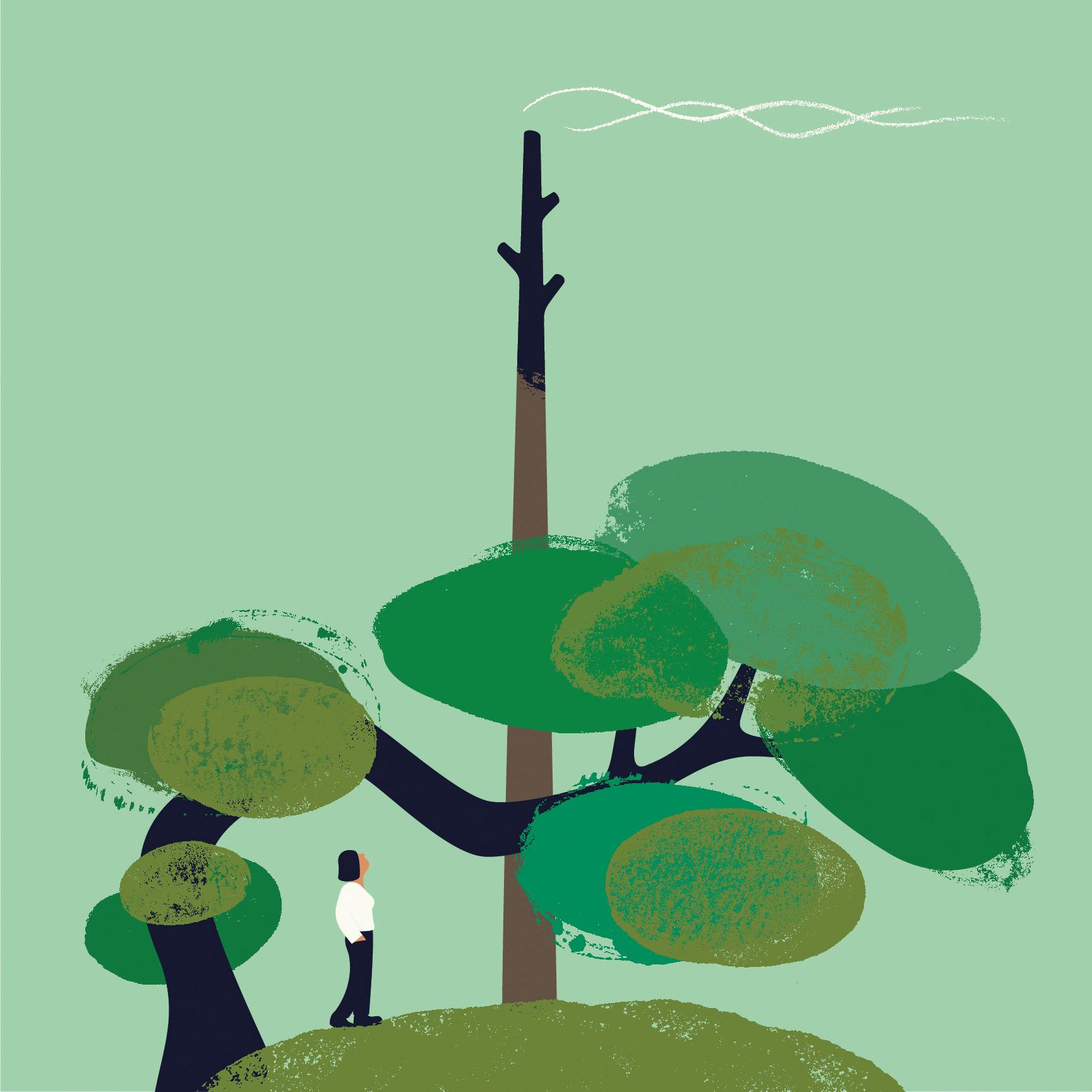
As time has gone on, I admit that the clarity of that grounding has been fading. During those first months, as painful as it was, I started to embrace the new reality as almost a gift. I would not say it was a “blessing,” as I have always felt that if there are blessings, then there are curses, and I did not feel our fire was a curse. I prefer to think that the universe gives gifts. If we can somehow figure out how to accept them, these random gifts can teach us things, and in our case, can be freeing, cleansing, and even liberating. I am a teacher, and I have been teaching cause and effect, and about Rube Goldberg machines, to my young art students recently. Goldberg’s contraptions were complex machines that ultimately accomplished a very simple task. I show them this to illustrate how the push of one object can have profound effects on another. This darn fire has had profound disruptive effects on our lives. In no way have I found it easy, but I have found a new respect for looking at my world from a different lens.
People say, “shit happens,” but the “shit” is life. It’s often out of our control and, if we let the universe in—the “shit” and the pain and the mess—I think there can be much to embrace, much to be humbled and also grounded by.
I am so very grateful that as I write this, two years after the fire, that our life is moving forward and we are in the process of renovating our barn and—with the fortuitous gift of an architect friend—have been creating a greener, smarter, easier home to grow older in together. In other words, we are hoping that we can be the phoenix rising from the ashes, coming out of this still grounded but rising and embracing what really matters in our lives—the love that remains.
Chaké Kavookjian Higgison ’78 is a painter, clothing designer, and art teacher who founded the Bowdoin Summer Art Camp. She and her artist husband, Peyton Higgison, have been finding a way to make a new life for themselves in the spot where they have lived and painted for more than thirty-five years.
BOWDOIN MAGAZINE WINTER 2024 | CLASSNEWS@BOWDOIN.EDU 39
Psychology professor Barbara Held writes about the thin line between humility and self-deprecation and argues that the virtuous golden mean of “truthfulness” is a better way to see humility.

A Rightful Pride
BEING ASKED to write an essay about humility took me aback. After all, I’m known for my moments of shameless self-promotion, about which I am—well—shameless.
Bowdoin alumni who were my students in the early two-thousands might be amused to recall one particular exchange I had with them regularly.
As students increasingly addressed professors by their first names, some of my students asked if they could call me “Barbara.” Preferring to be called “Professor Held,” I gave them a cheeky alternative, saying this:
“You may call me ‘The Precious Bundle,’” I offered. (Historical note: Tired of people our age asking my husband and me when we’d have children, which we had decided against from the start, I typically responded by saying,
“I don’t need to produce a precious bundle, because I am The Precious Bundle.” That usually stopped them dead in their tracks.)
My students said they wanted to be “The Precious Bundle,” too. I told them that wasn’t possible because there’s only one precious bundle—me; hence the definite article “the.” But, not wanting to be too much of a party pooper, I offered them this option, saying, “You can all be ‘Special Bundles.’ And if you work hard, someday, when I’m gone, maybe one of you will be ‘The Precious Bundle.’” How’s that for shameless self-promotion!
Now, onto humility. It goes without saying that most see humility as a virtue. In his poem “Psychomachia,” the early fifth-century AD poet Prudentius represented Christian morality as a struggle between seven sins and seven
virtues. He opposed the virtue of humility with the vice of pride.
My Protestant-raised husband was taught to adhere strictly to the proverb “Pride goeth before a fall.” He took it too much to heart, in my opinion. A man of many talents, he sometimes sold himself short.
I saw this same self-deprecating attitude in many of my Bowdoin women students, who had difficulty taking credit for their talents. You would think my shameless self-promotion would have provided a role model for women seeking to advance themselves in the world. But apparently not. They thought my shamelessness was a joke, but like many of my seemingjokes, I was only half-joking. By contrast, when I described myself with fake modesty as a “simple country psychologist,” which, as a
40 BOWDOIN MAGAZINE WINTER 2024 | CLASSNEWS@BOWDOIN.EDU
Bronxite, was ludicrous, I was joking completely. Unfortunately, whereas my shameless selfpromotion wasn’t emulated, students expressed undue real modesty.
When it comes to humility, I prefer Aristotle’s Nicomachean Ethics, in which he presents the virtuous “golden mean”—or middle ground— between each of twelve pairs of vices defined by an extreme of deficiency and of excess. For the category “self-expression,” the vicious deficiency is “understatement/mock modesty,” and the vicious excess is “boastfulness.” The virtuous golden mean between these two is “truthfulness,” which I find just right.
Where’s the shame in being straightforwardly honest about your talents? I have a friend who says, “Oh, stop it,” when I compliment her on some accomplishment. She says I’m embarrassing her by complimenting her. Why? Does she think she doesn’t deserve to be complimented? Does she think it’s too prideful to accept the compliment? This makes me feel bad for complimenting her. Where’s the virtue in that?
My advice is this: If you get complimented, just say, “Thank you.” Isn’t that a form of humility? And if you don’t think you deserve a particular compliment, you might ask yourself why not. Are you being too humble? Or is your complimenter buttering you up? I have a friend who constantly compliments me on everything he can think of, which makes me wonder how genuine he’s being. His compliments come across as flattery, which carries the negative connotation of seeking to influence others with insincere praise. That makes me a bit nauseous at times.
Then again, there are people who believe they are the best at things they aren’t (you can think of some people, I’m sure). They certainly could use some humility. Though, given their evident narcissism, it might be foolish, even for a psychologist, to try to get them to see their selfdeception—their unwarranted self-confidence.
To be sure, the situation you’re in at the moment helps determine just what amount of humility, if any, is called for. In a job interview or when writing a college admission essay, you shouldn’t downplay your talents. But you also shouldn’t proclaim talents you don’t actually have. The trick is to come across as being truthful— because you are being truthful.
Am I being truthful about seeing myself as The Precious Bundle? It depends on what I mean by that moniker, and no one has yet to ask me—though several friends and colleagues (as well as my father, who made it to age ninety-six!) have so addressed me.
Here’s why I call myself “The Precious Bundle”: I’m proud of my accomplishments, in which I include my scholarly writing and newspaper opinion pieces, most of which have received considerable attention. Not least, I’m proud of my thirty-five years of teaching at Bowdoin, which I took most seriously.
For the category “self-expression,” the vicious deficiency is “understatement/mock modesty,” and the vicious excess is “boastfulness.” The virtuous golden mean between these two is “truthfulness,” which I find just right.
I’m therefore thrilled when former students write to thank me for helping them learn to think. I tell them that they helped me learn to think, about which compliment I’m utterly sincere. And I’m pleased that my students had the courage to take my courses despite my wellearned reputation as a tough grader. Courage is high on Aristotle’s list of virtues, between the vicious deficiency of cowardice and the excess of rashness/recklessness.
To my former students, I now offer this confession: Each of you is “The Precious Bundle,” too. You were right to insist on that ages ago, because each of you is uniquely precious and talented. Just don’t tell anyone I admitted this.
Barry N. Wish Professor of Psychology and Social Studies Emerita Barbara Held is a clinical and philosophical psychologist who has written several books, including Stop Smiling, Start Kvetching: A 5-Step Guide to Creative Complaining.
BOWDOIN MAGAZINE WINTER 2024 | CLASSNEWS@BOWDOIN.EDU 41
State representative
Justin J. Pearson ’17 talks about the need for humility in public service, how it is key to the development of the common good, and how its lack impairs our path to justice and equity.
Bound Together
“DON’T FORGET where you come from, Justin. Don’t forget the goodness of God. Don’t forget the people and the places that made you, so you can use the opportunities you’ve had to do good for others.” These are the words of my grandmothers, my mother and father, my neighbors, and the constituents in District 86 that I represent in the Tennessee General Assembly.
I grew up watching my parents exemplify humility. In the latter part of my childhood, they moved our family to a more affluent area of the country for their continuing education. We gained access to educational opportunities and experiences we did not have before.
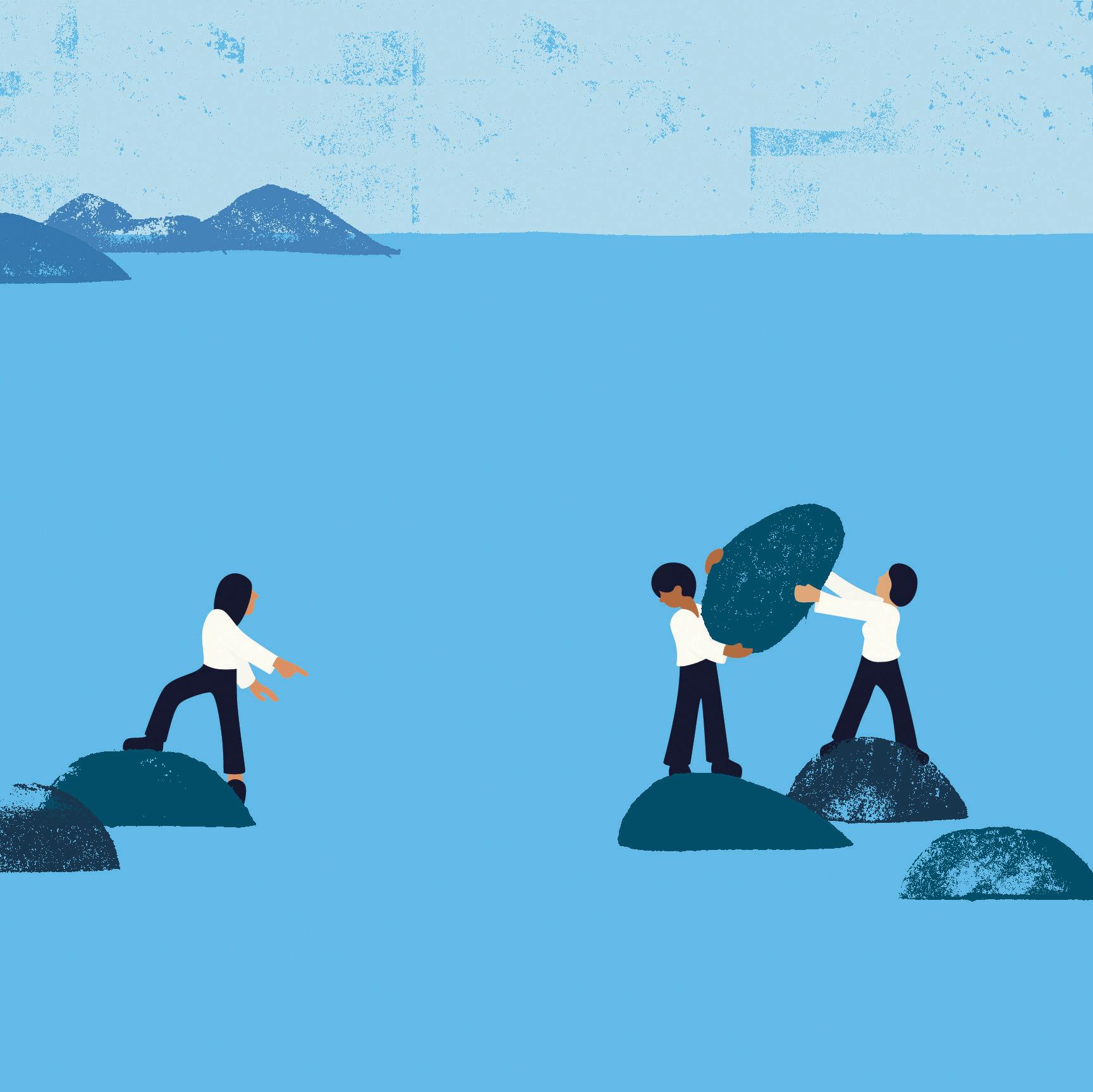
Then, they moved us all back home to Memphis, where our grandmothers lived, where four generations of our family developed wisdom through struggle. And back to where my grandmothers, who both succumbed to cancer caused by environmental racism due to seventeen toxic facilities surrounding their homes, had built the foundations of our family.
They moved us home where humility forged the bonds of trust and grew the webs of interconnectedness between all of us. They brought us back to where we came from, so that they—one a teacher and one a preacher—could humbly serve in their hometown.
Most of us instinctively value the idea of humility. We recognize the relationship between being humble and having compassion for others.
We understand that it is only through accepting our limitations that we can recognize what we have to learn from others. In this way, we may serve the common good rather than the privileged few of a society built on profit and white supremacy.
The ancient Greek philosophers Socrates and Plato identified humility as a virtue among virtues. Not only as a moral virtue, as we think of it today, but also as an intellectual one. While we need to understand and acknowledge our limitations as human beings, we also need enough self-reflection to recognize our own intellectual ignorance.
Most spiritual traditions also teach us the value of humility. Buddhism, for example, sees humility as a virtue that guards against arrogance. Arrogance, or ego-centeredness, impedes compassion for others.
The Christian Bible teaches that humility is respect for ourselves and others, and requires putting love for others over love for self. Christian scripture also teaches (Proverbs 11:2) that humility is necessary for wisdom: “Pride leads to disgrace, but with humility comes wisdom.” We learn in Matthew of its necessity for leadership, when Christ says, “Whoever wants to be a leader among you must be your servant.” Humility is a necessary attribute for good and proximate leadership.
Islamic teachings espouse that humility is the root of all the virtues. Jewish teachings hold that humility is understanding one’s strengths and weaknesses so that one may cooperate rather than compete.
In a country as polarized as ours, the very humility that is needed to wisely cooperate for the common good is the very value that is lacking among too many of our political leaders. Their minds are closed to all but their own self-serving agendas.
I’ve experienced this firsthand on the floor of the Tennessee General Assembly over the past year.
My fellow Tennessee state representatives Justin Jones and Gloria Johnson joined together with me to acknowledge the wisdom of the people we represented—and the hard data— to call for common sense gun safety laws in the wake of the horrific massacre of three of Nashville’s Covenant School children and three staff members in March 2023. Our solidarity protest in the Well of the Tennessee General Assembly was broadcast around the country and across the globe. As was the subsequent expulsion of Representative Jones and me from office by republican lawmakers—and our ultimate reinstatement by our voters.
The power and knowledge we have as leaders come not only from the facts and science but also from “those who made us”—from our communities and our constituents. It also comes from those who are most marginalized, from those who suffer most from unjust policies that serve only the powerful. Only by understanding their wisdom and experiences can we bridge political divides and represent everyone.
Lacking humility and the wisdom it brings, some lawmakers in the Tennessee General Assembly refused to learn from affected constituents and hard data about gun violence. Some even doubled down on this hubris by proposing to vastly increase the presence of guns in our schools. Their proposals ignored the studies that show arming teachers and civilians increases the risks of gun violence in schools. Instead, they chose to align with the interests of eighty-two reported gun manufacturing facilities in our state.
In a similar display of self-serving hubris, one conservative lawmaker pronounced on
What we need instead—in Tennessee and the nation—is the cooperation, connection, and common good that can only come with humility.
the House floor that climate change isn’t real and that fossil fuels are a clean and renewable source of energy. Not only are both statements demonstrably false and contrary to all scientific evidence, the lack of humility present in these proclamations exposes the dangers of policies that protect only the powerful—in this case the fossil fuel industry—at the expense of truth and justice for the rest of us.
Politicians like these who demonstrate arrogance and ignorance exemplify the antithesis of humility. Their ideology is asserted in direct contrast with fact. Their policies serve to pit our basic human rights and needs against the agendas of corporate profit.
What we need instead—in Tennessee and the nation—is the cooperation, connection, and common good that can only come with humility.
A persistent challenge that should be addressed with humble leadership is poverty. There are about 2 million poor and low-income voters in Tennessee, and nearly one-quarter of Tennessee’s households with children reported “sometimes or often not having enough to eat the previous week.” And well over half of all Tennesseans in 2022 reported hardship in meeting basic living expenses.
These statistics are significantly worse than the national averages. According to the Tennessee Commission on Children and Youth’s State of the Child 2022 report, more than a quarter of our households spent more than 30 percent of their monthly income on housing. Among low-income residents, this number skyrockets to three out of four households.
This reality should humble any policymaker and spur them to action. But for the majority of our state’s lawmakers, it doesn’t. They lack the
humility necessary for true democracy that works for the well-being of all of us.
Born near the Tennessee border in Kentucky in the 1950s, the Black feminist, social activist, and prolific author bell hooks speaks powerfully about the relationship between love, humility, and liberation. She says in her book All About Love, “When the politics of greed become a cultural norm, all acts of charity are wrongly seen as suspect and are represented as a gesture of the weak.”
When politicians characterize the wisdom of the most marginalized as weakness and the enrichment of the already powerful as the ultimate goal of a society, we lose connection. We lose love. We lose justice.
We must find our way back. A good place to start is with the value from which all other values flow—humility.
Public servant and activist Justin J. Pearson earned a degree in government and legal studies and education in 2017. He is a member of the Tennessee House of Representatives from the 86th district.
Francesco Ciccolella is an illustrator, graphic artist, and visual storyteller based in Vienna, Austria. His work has been featured in many publications, including The New York Times and The New Yorker. See more of his art at francescociccolella.com.
Attorney Luke Wilson ’06 is ensuring a future where water is more than a resource—it’s a right.
Water Defender
What draws you to the work that you do?
When water systems fail, societies fall; when systems work, they thrive. The stakes couldn’t be higher.
How did your career unfold?
I think there was always a current pushing me toward water, though it took time for me to see it. I have to credit Bowdoin with setting me on the course I am now. The International Law class I took with Allen Springer was the starting point of it all, and the Volunteer Lawyer’s Project in Portland helped me to understand how poverty in the United States deepens every strain and pain. After law school, I was a law clerk at the International Court of Justice in The Hague, where I first cut my teeth on a dispute over water.
It was after that, when I was working on international arbitration cases alongside human rights cases, that I realized just how much water is the hub—it’s at the center of every aspect of life. Whether it is protecting a fragile peace or preventing conflict, prosecuting war crimes or ecocide, protecting human rights or investment, or protecting health and happiness, water is at the center. When I had this realization—and saw how much more of a need there was to protect water security—I saw my future path with clarity and started the Center for Water Security and Cooperation with a colleague. Eight years later, and the need has only gotten greater.
You’ve described access to water as being central in conflict as well as civilization. Do you see that happening now?
We’re seeing attacks on water more and more in conflicts around the world, and we’re not doing enough to stop them. Denying any person water, whether as punishment or collateral damage, is abhorrent, inhumane, and illegal. We seem to forget that, and we certainly do not shout from the rooftops as much as we should “This is one of the worst things a person can do to another. Cut it out ” So many people—in war zones or not—live on fetid, polluted, or diseased water. Somehow, we don’t ever seem to make it a priority.
What inspires you?
I am inspired by human resiliency, by the ability of so many to fight for what they deserve even in the face of overwhelming odds. Environmental defenders are constantly being targeted in countries where we work, and being able to lift these advocates up, to give them the tools, and to believe that the progress we’re making together will change the world—that’s what inspires me every day.
What brought you to Bowdoin? What was your experience at the College like?
I loved how Bowdoin was both connected and cloistered. I could volunteer in Portland and have one-on-one debates with my professors. I could be in a production of Into the Woods, sing in Robby Greenlee’s Chamber Choir and the
Meddiebempsters, and sit by the ocean or sit in the shadows of the pine trees all in the same day. Bowdoin allowed me to connect every part of myself to what the College had to offer, and to challenge myself in myriad ways.
Is there something about the work you do that others would find surprising?
I think the sheer scope of water insecurity—not having reliable access to enough clean water for basic needs—is a shock for many. Our best estimates are that 2 billion people worldwide and 2 million people in the United States struggle to get, have, and keep water every day. This number is astounding, and it’s only getting worse as climate change and poor management lead to droughts, empty or polluted aquifers, and economic pain.
Is there something about you that others might find surprising?
I’m still holding out hope that the Bowdoingrown, student-written-and-directed musical Home makes it to Broadway, where I can reprise my role as the kindly New Jersey–proud patriarch with his affectionate cat, Shnookums.
Luke Wilson ’06 is cofounder and deputy director of The Center for Water Security and Cooperation and teaches international law at the George Washington University, where he earned his JD.
For more from this interview, visit bowdoin.edu/magazine.
44 BOWDOIN MAGAZINE WINTER 2024 | CLASSNEWS@BOWDOIN.EDU PHOTO: CANDICE KALB
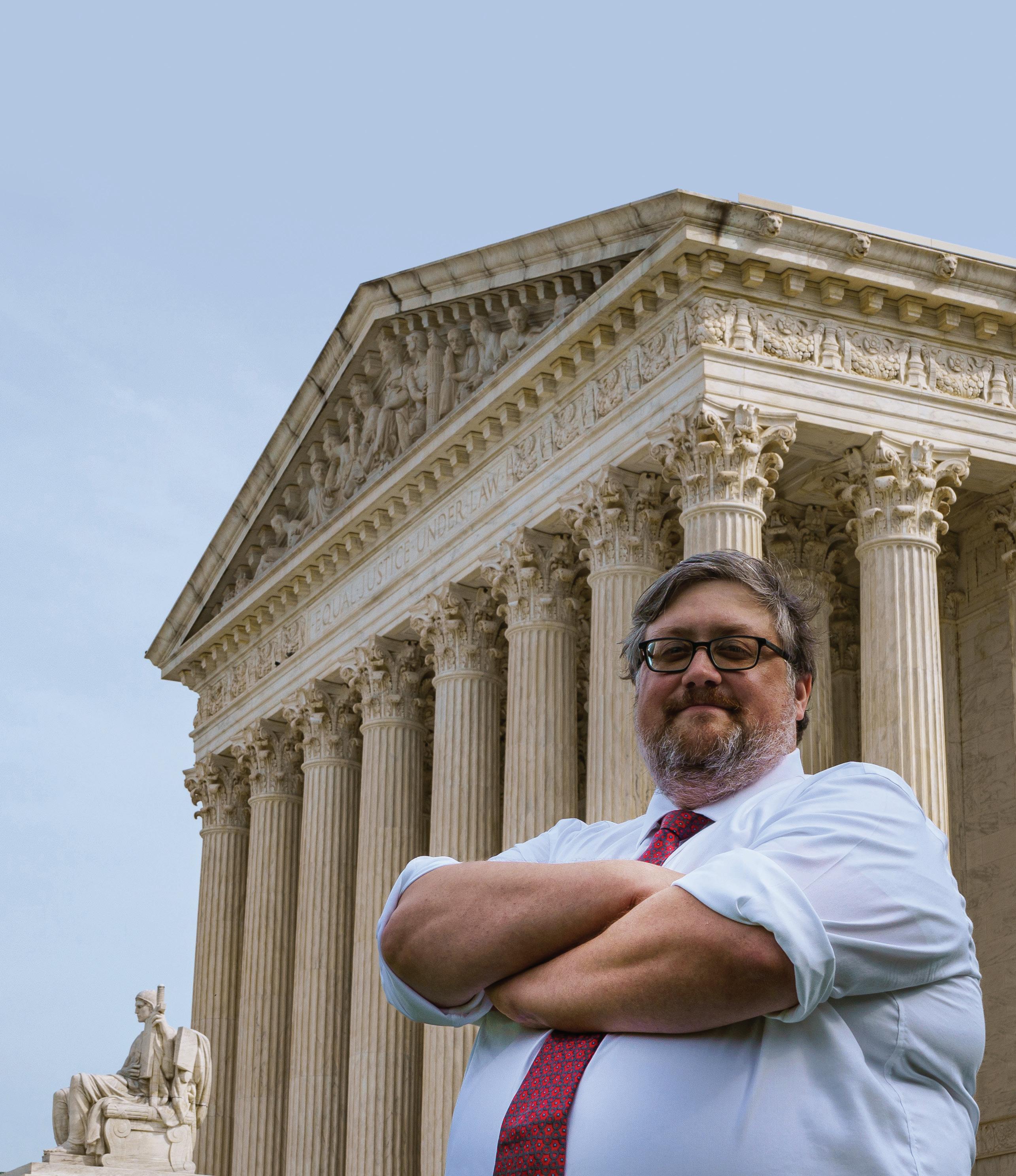
Whispering Pines
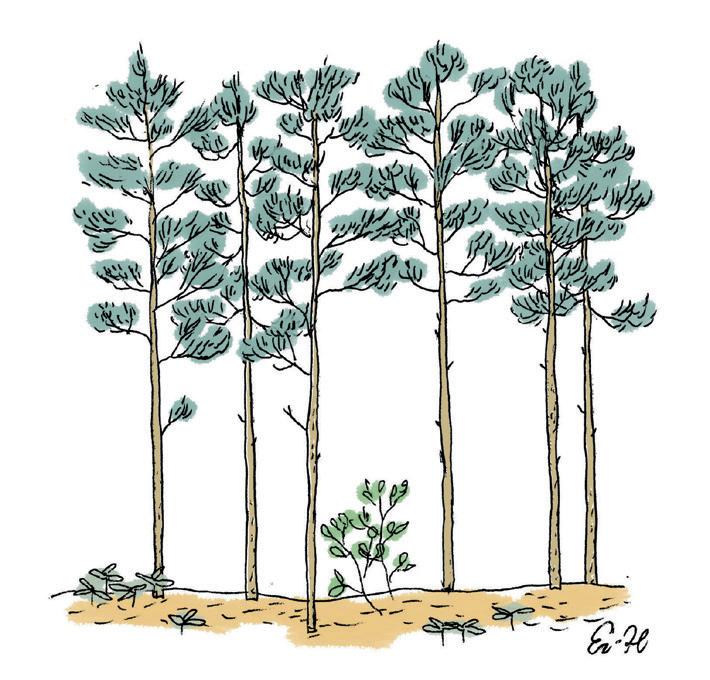
No Fairer Mother ’neath the Sun
The family tree of “Bowdoin Beata,” once the official Bowdoin College song, has deep roots and many cousins.
THESE DAYS, the musical world must tread lightly over issues of copyright infringement, as digital “sampling,” mashups, and interpolations of existing compositions and recordings are incorporated into contemporary music. Recently, I fell into a “rabbit hole” that made me think of the cumulative effects of “borrowing” music when a classmate inquired about the Wake Forest University fight song “O, Here’s to Wake Forest,” played at halftime of a televised football game: “Wasn’t that tune the same as ‘Bowdoin Beata’?”
The short answer was yes. The lyrics to “Bowdoin Beata” were written in 1895 by Henry Hill Pierce of the Class of 1896. Fortunately, the musical score is of sufficient antiquity to be in the public domain. Few alumni are familiar with the words to the four verses in the original version of “Bowdoin Beata,” which was originally titled “Loyal ’til Death,” but its opening lines are familiar to many Bowdoin alumni:
“When bright skies were o’er us, and life lay before us, ’Neath Bowdoin’s pines we gathered far and near.”
The tune is often identified as “Wake, Freshman, Wake,” a Yale fraternity recruiting song of the 1860s, but even that attribution can be traced back to “Annie of the Vale,” a popular song published in 1861, with music by J. R. Thomas and words by George P. Morris. The tune was appropriated as a vehicle to deliver the sentiments of both sides of the conflict during the Civil War. “The Grand Jubilee Song” [1863] and “Nellie of the North” [1864] were pro-Union songs, while “Welcome, ‘Jeff,’ to Baltimore” assured Confederate
president Jefferson Davis and generals Robert E. Lee and Stonewall Jackson of a warm reception there.
“Wake, Freshman, Wake” inspired other colleges and schools to come up with their own versions. A Yale alumnus who was the head of the Kamehameha Schools in Honolulu used the tune for “Sons of Hawai’i” and took Yale’s blue and white for the school’s colors in 1886. In 1895, Union College students sang “Union beside the Mohawk Vale,” while “Campus Song” [Wesleyan University, copied nearly verbatim by Marietta College in Ohio], Wake Forest’s “O Here’s to Wake Forest” [1908], and Hamilton College [“The Hill of Science”] did the same. Kappa Sigma [“Kappas Forever”] and Psi Upsilon [“O Joy for the Glad Hours”] fraternities each had lyrics grafted onto the musical base of “Annie of the Vale.” In the realm of popular songs, “My Moustache Is Growing” moved away from collegiate sentimentality and toward humor:
“My moustache is growing, its genial warmth bestowing, Its beauty fills the eye of all Broadway.”
From the time of its publication in the October 2, 1895, issue of The Bowdoin Orient, “Bowdoin Beata” became a standard song at the College, sung at the end of meetings, concerts, rallies, and athletic events (often paired with “Phi Chi,” a spirited song of a nineteenth-century sophomore hazing society, set to the tune of “Marching through Georgia”). Students were expected to stand and remove their hats when the song was sung. The song appeared as Bowdoin’s entry in published collections of college songs. Beginning in 1914, there were suggestions to replace “Bowdoin Beata” with “Rise, Sons of Bowdoin,” written by then-dean Kenneth C. M. Sills ’01 and set to music by Professor Charles Burnett. Pressure to make the switch gained momentum with the advent of Prohibition, when lines from the chorus of “Bowdoin Beata” seemed out of tune with the times:
“Clink, clink, drink, drink, drink.
Smash the glass to splinters when you’re done.”
The final decision to make “Rise, Sons of Bowdoin” the College’s official song occurred in 1952, in part to celebrate Sills’s retirement after thirty-five years as Bowdoin’s president.
In 1994, in recognition of changes at the College and in society, the Alumni Council approved edits to “Bowdoin Beata” that reflected the presence of both women and men among students and alumni, a diminishing role for fraternities, and the kinds of concerns about alcohol consumption first voiced in the 1920s. Professor Anthony Antolini ’63 undertook the challenging task of bringing an 1890s song into a 1990s Bowdoin campus, while still conveying a timeless sentiment:
“Bowdoin Beata, O dear Alma Mater; There is no fairer mother ’neath the sun.”
John R. Cross ’76 is secretary of development and college relations.
46 BOWDOIN MAGAZINE WINTER 2024 CLASSNEWS@BOWDOIN.EDU
ILLUSTRATION: ERIC HANSON
WILLIAM GILCHRIST ’06
A GROWTH MINDSET
I am driven by growth in all its forms. It’s about constantly moving forward and pushing boundaries.
That was certainly my experience at Bowdoin, which was transformative and unparalleled, filled with lifelong lessons and connections. In Professor Laurence’s Comparative Politics course, he shared a story about the Vikings’ downfall due to their arrogance and refusal to learn from Indigenous peoples—it has been a guiding principle in my work abroad and in the tech industry, emphasizing humility and an openness to learning.
After graduating from Bowdoin, I ventured to Shanghai to teach English, later doing media relations for an international publication. That experience was pivotal and taught me the importance of language and cultural understanding in professional progression. It made me realize the language was a barrier that was holding me back, so I pursued certifications in Mandarin from Cornell and Beijing Universities.

That helped me land positions as a sales manager and then head of knowledge at Google in Singapore, but I found myself more interested in sales technology. I took an unpaid internship in lead generation with TSL Marketing, where my supervisor told me that sales skills are universal and crucial. His words launched my journey into redefining what this field means in a rapidly evolving global market.
A couple of years later, in 2017, I launched Konsyg, which provides end-to-end sales operations for enterprises and subject-matter experts globally. We’re constantly dealing with cutting-edge technologies, and the opportunity to bring someone’s innovation to new markets is incredibly fulfilling.


I’m passionate about reshaping how sales are perceived and executed in the global market, and I find inspiration in historical figures and empires that faced and overcame challenges. The thrill for me lies in solving problems and a ceaseless quest for growth.
For more from this interview, visit bowdoin.edu/magazine.
PHOTO: TIORIA BY CARAMIA

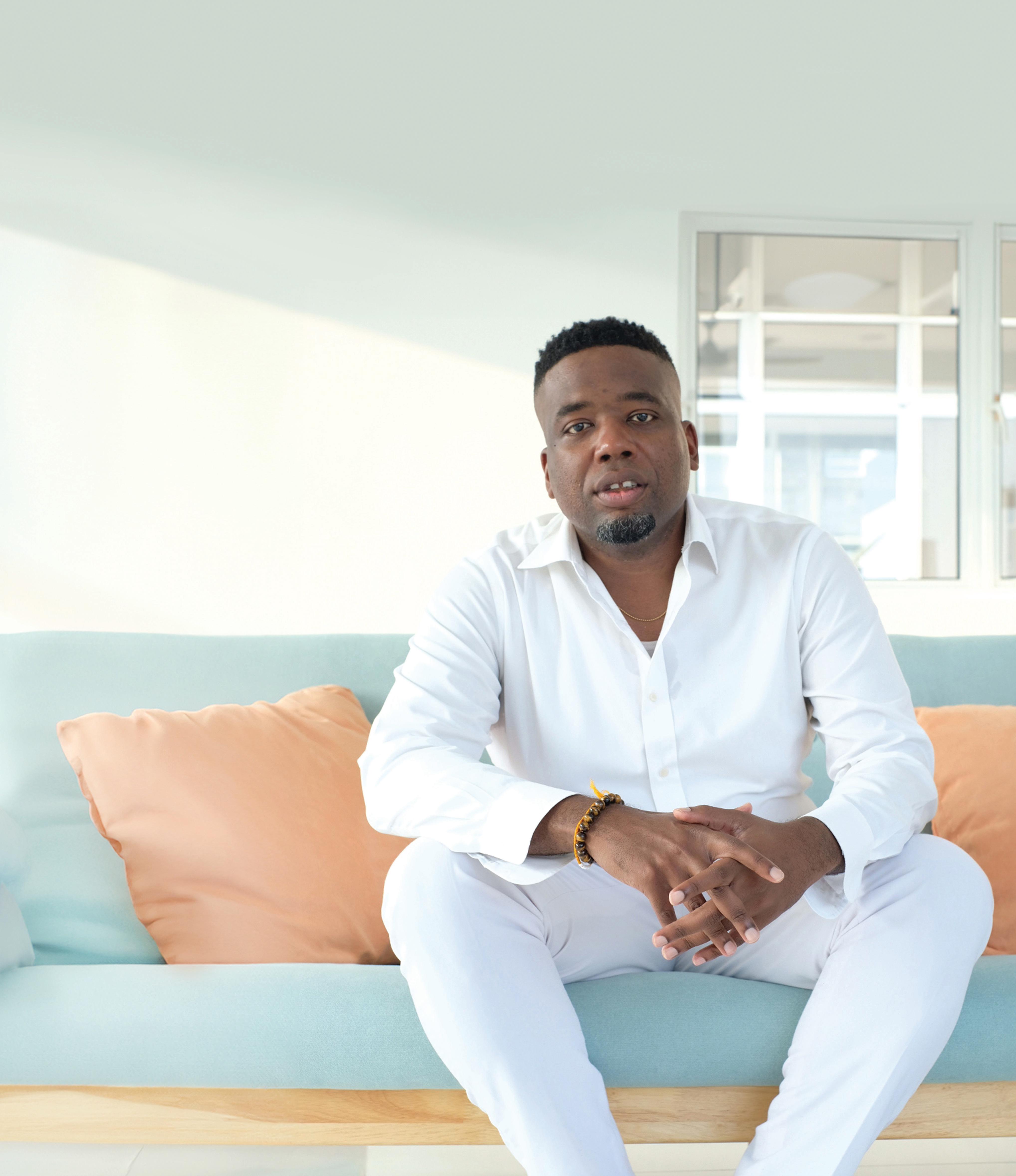
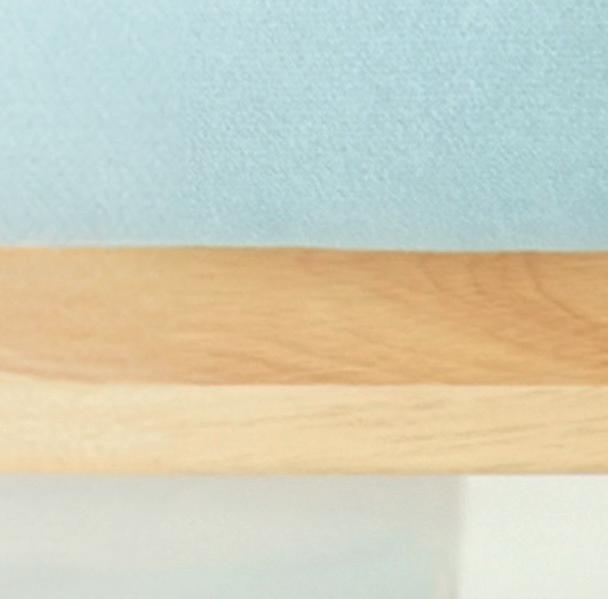
When not working to improve global sales performances in the technology sector, Gilchrist can be found nerding out with his partner, searching for his next great meal, relaxing in onsens, walking his dog, and learning more from YouTube documentaries.
Connect
ALUMNI NEWS AND UPDATES
Finishing Strong
While our campaign has reached the incredible goal of $500 million in gifts and pledges ahead of the deadline of June 30, 2024, there is still work to be done to keep our promises to all Bowdoin graduates. Being engaged in the life of the College matters. Whether you make a gift, volunteer, or attend an event, it all helps propel Bowdoin forward—from here.
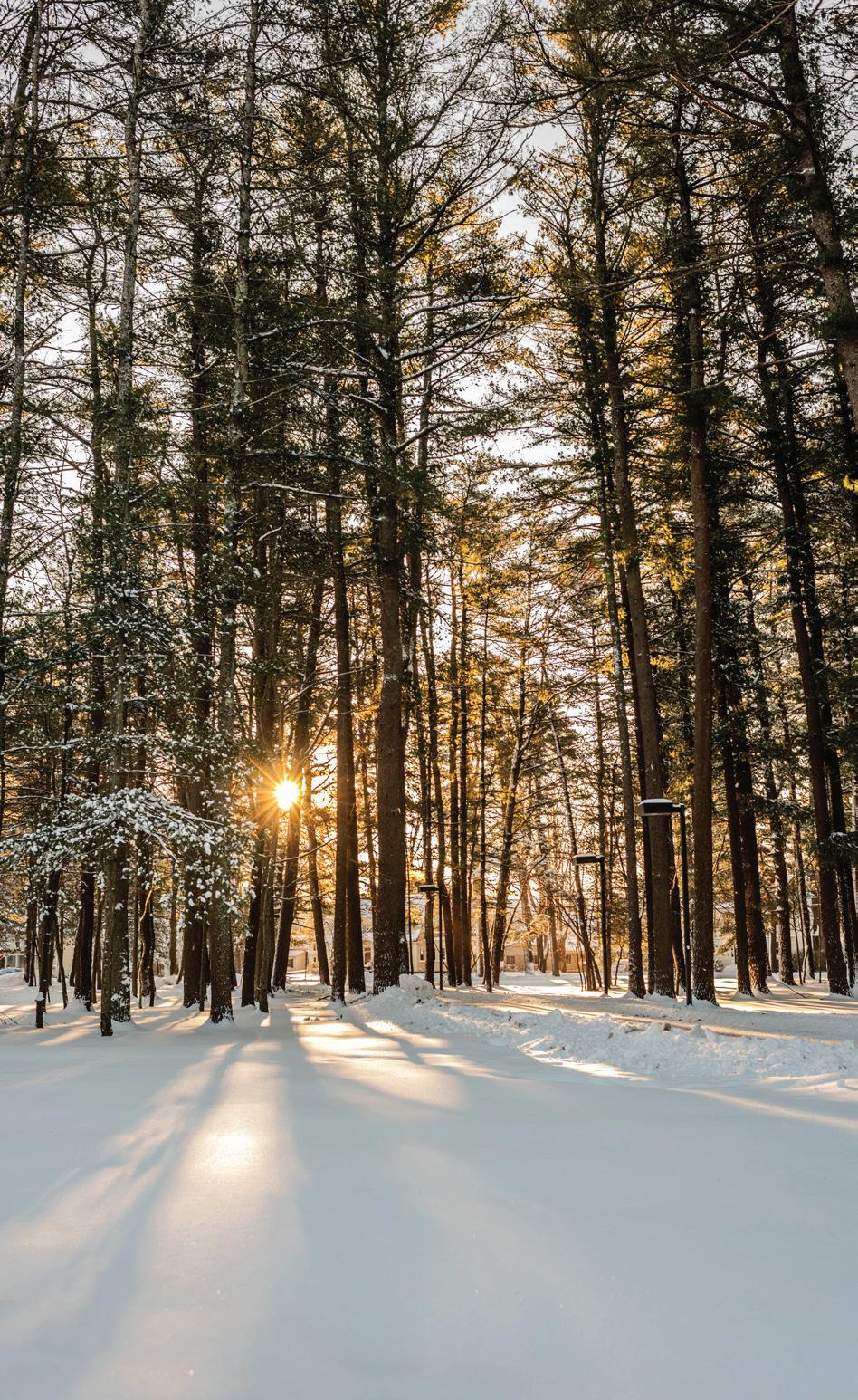
Please help keep this momentum going by volunteering, registering for an event or program, or making a gift to the Alumni Fund.
1952 In January, Claude Bonang received the Paul Harris Fellow Award from the Rotary Foundation of Rotary International and was recognized for his achievement by the Maine Senate and House of Representatives in Augusta. While there to accept the certificate of his accomplishment, he played his rhythm bones in the general assembly room, the senate chamber, and the house chamber, all to “wonderful applause from the audiences.” According to the document, the award is presented “in appreciation of tangible and significant assistance given for the furtherance of better understanding and friendly relations among peoples of the world” and orders that “this official expression of sentiment be sent forthwith on behalf of the 131st legislature and the people of the State of Maine.”
1955
Phil Trussell: “I retired from MIT in 1999. Wow! Twenty-four years ago. We bought a condo in Sarasota and enjoyed sixteen years there with many old and some new friends—mostly Canadians. In 2015, we sold the condo to a woman from Cambridge who was renting the condo above us. The next year, we sold our wonderful condo in the retired Norfolk County Prison in Dedham, Massachusetts, and bought into North Hill, a CCRC (continuing care retirement community) in Needham, Massachusetts. I knew this facility, having served on the board of trustees from 1987 to 1997. Of a total population (independent, assisted, and memory care) of 460, we knew thirty-five when we moved in. I have been active here, serving on several resident committees until 2020, when Priscilla needed hospitalization with pulmonary fibrosis and eventually 24-7 oxygen
here in our apartment. She then came down with dementia, so I gave up golf and most of my committee work to be a full-time caregiver. We have wonderful support staff here, but I know she’d rather be home than in our memory care facility. Fortunately, when needed, I can call on our home health staff. My MIT sixty-fifth reunion was in June 2021, amid the pandemic, and I was feted by our then-president, L. Rafael Reif, for having directed a major mixed-use ground-leased development named University Park at MIT adjacent to the campus, which, from its beginning in 1983 to 2018 had returned to MIT over $360 million, strictly from sale and refinancing proceeds. The development in 2018 had a value of $2 billion. In addition, MIT receives the normal annual base rents and percentage rents from the developer. When I retired from MIT in 1999 as their associate treasurer and director of real estate, they established the Philip A. Trussell Prize, which is given annually to a male and female scholar-athlete with a sense of levity. Priscilla and I are very proud of our three-year-and-three-month-old great-granddaughter, Molly Duggan, whom we hope to steer to Bowdoin!”
1959
Reunion
From John Bird: “In a recent conversation Zeke Zucker had with class president Gene Waters, Gene remarked how pleased he was that John Bird had stepped up to fill the secretary position, vacant since the passing of Bren Teeling. He stressed the importance of continuity in keeping our classmates and others advised of our doings. He felt that, for the same reason, he would like to see the vice presidency filled. It has been vacant since the passing
48 BOWDOIN MAGAZINE WINTER 2024 | CLASSNEWS@BOWDOIN.EDU Connect
THE CAMPAIGN FOR BOWDOIN
bowdoin.edu/fromhere
Remember
The following is a list of deaths reported to us since the previous issue. Full obituaries appear online at: obituaries.bowdoin.edu
Harold L. Osher ’44
December 23, 2023
George L. Hildebrand ’46
November 7, 2023
William A. Johnson ’46
July 16, 2023
Herbert A. Mehlhorn ’46
October 10, 2023
Basil J. Guy ’47
June 11, 2023
William S. Silsby Jr. ’47
September 27, 2023
Fred W. McConky III ’49
August 11, 2023
Richard C. Lunt ’50
October 21, 2023
Guy T. Emery ’53
September 14, 2023
Peter L. Runton ’53
August 22, 2023
Clive Tillotson ’53
October 10, 2023
Mickey F. Weiner ’53
August 21, 2023
William A. Caspar ’54
October 8, 2023
James W. Gorman ’54
October 15, 2023
Gordon D. Larcom Jr. ’54
September 2, 2023
Parker McLaren ’54
September 20, 2023
Lloyd O. Bishop ’55
September 17, 2023
Forrest R. Cook Jr. ’55
August 17, 2023
Nathan D. Cushman ’55
January 7, 2023
Robert C. Hawley ’55 October 2023
Elliott S. Kanbar ’56
December 12, 2023
Raymond F. Kierstead Jr. ’56
September 13, 2023
J. Steward LaCasce ’56
November 4, 2023
John Ware ’56
October 8, 2023
Richard G. Geldard ’57
November 7, 2023
Dietmar K. Klein ’57
December 13, 2023
Ralph L. Miller ’57
September 7, 2023
Francis H. Taggart Jr. ’57
December 16, 2023
Albert F. Marz Jr. ’58 September 25, 2023
Barry N. Miller ’59
September 23, 2023
Theodore C. Sandquist ’59 October 1, 2023
Douglass M. Corson ’60
June 16, 2023
William A. Christmas ’61
October 8, 2023
Regis J.-F. Dognin ’61
September 9, 2023
William C. Phillips ’61
September 22, 2023
Francis M. Thomas ’61 October 8, 2023
Steven H. Crabtree ’63
August 9, 2023
Stephen J. Gardner ’63
December 22, 2023
William S. Baxter Jr. ’66 December 26, 2023
John A. Wood ’66
December 4, 2023
David F. Scott ’67
November 9, 2023
Mark I. Chase ’71
December 8, 2023
Thomas G. Wourgiotis ’72
November 19, 2023
Leland J. Arris Jr. ’73
November 26, 2023
John A. Currie ’73
October 13, 2023
Jerry C. H. Carr ’74
June 10, 2023
Steven M. Klyne ’74
July 28, 2022
John W. LaDouceur ’74
October 23, 2023
Bruce D. Osborne ’74
November 19, 2023
Barbara A. Kreuter ’75
December 1, 2023
Paul A. Weeks ’75
December 1, 2023
Vanessa Campbell ’76
June 27, 2022
Lawrence J. Carlson ’76
October 24, 2023
Kenneth M. Madrid ’76
September 13, 2023
David T. Totman ’76
January 31, 2023
George E. Bumpus Jr. ’77
December 16, 2023
James D. Hardee Jr. ’79
August 30, 2023
Mark E. McGoldrick ’81
November 23, 2023
Scott G. Dinsmore ’83
September 15, 2023
Eric W. LaPlaca ’93
September 14, 2023
Kristen E. Maddoux ’98
October 31, 2023
Jeffrey S. Clark ’99
October 18, 2023
Kathleen A. McDonough ’19
November 25, 2023
GRADUATE
Earl C. Pike G’69
December 4, 2023
James S. Arnold II G’71
December 3, 2023
FACULTY/STAFF
Richard F. Boyden
November 1, 2023
Bowdoin obituaries appear on a dedicated online site, rather than printed in these pages.
Updated regularly, the improved obituary format allows additional features that we can’t offer in print, specifically the ability for classmates, families, and friends to post photos and remembrances.
PHOTO: ARTIST_CREDIT BOWDOIN MAGAZINE WINTER 2024 | CLASSNEWS@BOWDOIN.EDU 49
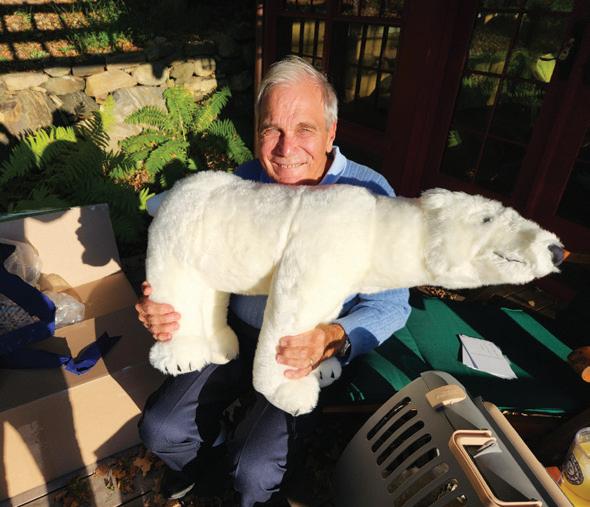
Dick Forté
the country.
“The Buddhist
a palpable serenity to a spectacular landscape.”
In September, Ted Strauss ’65 received a big stuffed polar bear to commemorate his eightieth birthday!
After dubbing the bear Winthrop in honor of his first-year dorm, he stationed it appropriately to look out over his home from the rafters.

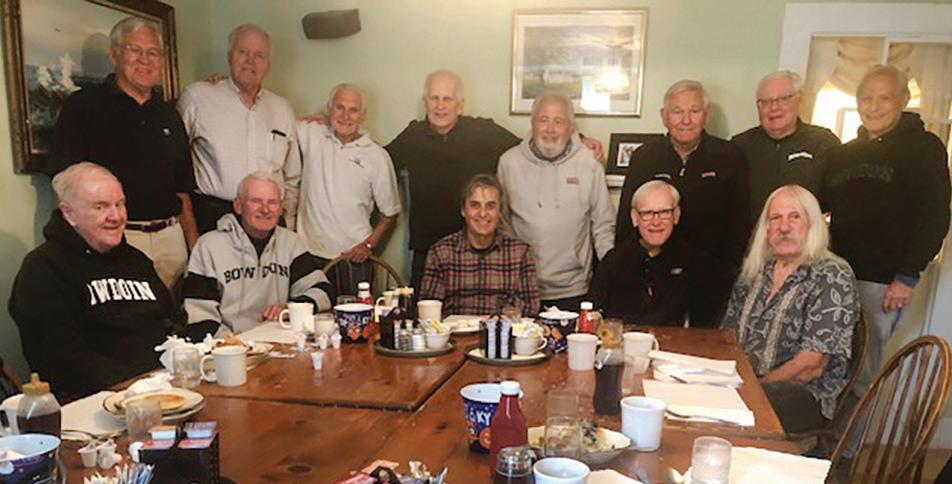
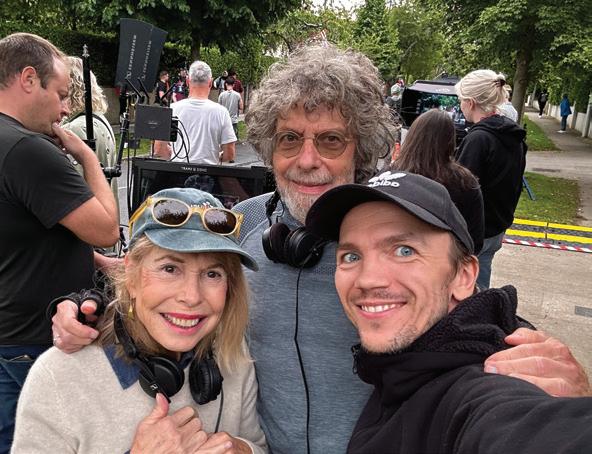
of Tom McGovern in 2005. Zeke agreed to see what could be done. With the encouragement of alumni office staffer Isabel Crawford, who oversees our class, he decided an election would be appropriate. Gene approved. Nominations were solicited. Two were received for Reid Appleby and for Zeke. Zeke immediately declined. An election was conducted among our classmates for whom we have email addresses. There were no write-ins. Reid was unanimously swept into office. In announcing the result, Zeke noted that, in addition to his impressive performance as our class agent, this election is also a tangible way we can express our appreciation for all Reid has done in supporting Gene and the alumni office in the general goings-on of our class.”
Roderick Forsman: “Left a widower by my wife’s death in 2019 (from a glioblastoma brain tumor), I have remarried to another Susan. We left the climate rigors of Berlin, New Hampshire, and moved to a more moderate Martinsville, Virginia. And no, I have not become a NASCAR fan. Other than sporting a pacemaker, I am in good health. However, gone are the halcyon days of traversing the Appalachian Trail. I am fortunate in having hiked it four times. The memories live on.”
1962
Bill Glidden: “My latest book has been published, Regulating Our Constitutional Rights: Democratic Rule or Judicial Fiat (Lexington Books, 2023). Retirement remains fun, so far. We’d be pleased to receive visitors in southern Maryland or in our second house in Washington, DC.”
Chris Potholm: “What an exciting time to be at our alma mater. A new president and our very own class’s Peter Webster representing Cornell
University at her inauguration! I always remember what William DeWitt Hyde said: ‘The best days of Bowdoin lie ahead.’ Just finished up my latest and hopefully most humorous book on Maine politics for Down East Books: Maine Decides: How Ballot Measures Are Won or Lost in the Pine Tree State, which features many Bowdoin professors and students from campaigns past and present. Should be out early in 2024.”
1964 Reunion
William Thwing: “During our four years in Bennington, Vermont, helping our son, Michael Thwing ’97, care for our grandkids while his wife attended nursing school, I managed to pen two memoirs—Vietnam Days and Restless Days—using the Japanese poetic form of haibun, and a collection of poetry, Open Your Eyes, all published by Shires Press in Manchester, Vermont. When Mike and his family moved to Denmark, Joy and I moved back to our home in Johnstown, Pennsylvania, where I resumed my interest in songwriting, publishing over 100 of my songs on the DistroKid label and publishing a fourth book on songwriting, The Song in My Heart—A Spiritual Journey through Life Recorded in Song, Poetry and Prose. These songs are all available through online music and music video streaming services like Spotify, AppleMusic, and YouTube under my artist name, ‘Bill Thwing.’ All the books are currently available on Amazon Kindle Direct Publishing.”
1967
Tommy Walz:
“When I joined the Vermont House of Representatives in 2012, I joined fellow alums Adam Greshin ’82 and Willem Jewett ’85 as a Bowdoin triumvirate in the Vermont legislature. Willem
50 BOWDOIN MAGAZINE WINTER 2024 | CLASSNEWS@BOWDOIN.EDU Connect
’66, Claire Ayer (widow of Al Ayer ’66), and Bill Allen ’66 at the iconic Tiger’s Nest Monastery in Bhutan—a 10,000-foot elevation—during a two-week excursion to
Dick says,
culture imparts
The Class of ’68 Bowdoin Breakfast Club—Ken Anderson, Charlie Hews, Myles Schiller, Jot Ross, Howie Zetlan, Henry Newman, Noel Bailey, Mike Monroe, Bob Parker, Gene Ferraro, Dave Himmelstein, Ted Cronin, and Dana Gallup—at their monthly gathering in October.
Steve Schwartz ’70 stands between his wife, Paula Mae, and Oscar-nominated director Jan Komasa on the Dublin, Ireland, set of the film Anniversary The Schwartzes are producing Anniversary alongside actors Nick Wechsler and Kate Churchill.
has passed on, Adam now works in the administrative branch, and I have retired. There are no more Polar Bears in our State House. Retirement means I can spend more time traveling, on charity work, and being with family. We recently spent three weeks with family in France, Spain, and Germany. In the latter country, I tried to track down ancestors, finding many graves and at last seeing the villages my family lived in for centuries. I had pictured quaint old German villages with halftimbered houses and thatched roofs. Disappointingly, they were all quite modern with lots of concrete. Hope to make it to Brunswick in the spring.”
1968
Ken Anderson:
“The Bowdoin Breakfast Club, a group of alums from the class of 1968, has met for several years on the north shore of Massachusetts. The club was formed by Bob Parker, Mike Munroe, Richie Benedetto, and Ted Cronin. Its initial gathering location was the Village Pancake House in Rowley, due to its proximity to the residences of its founding members. The club’s initial expansion brought in Howie Zetland and Elliot Hacker. In the early years, the late Dave Doughty, a coalescing force for our class, joined, and the club met at his sister’s place in Boxford. In honor of blueberries and Dave, the club has met in both places in recent years. In more recent expansions (like the SEC?), Bob Lakin, Henry Newman, Bill Strauss, Gene Ferraro, Dana Gallup, Noel Bailey, Jot Ross, and Myles Schiller joined. And, at our most recent gathering, we were joined by Dave Himmelstein and Charlie Hews! Charlie Hews and Dana Gallup were freshman year roommates and had not seen each
other since 1967, but they bonded as if they had left each other’s company yesterday. I must say that it’s impressive that we have almost 10 percent of our surviving class getting together regularly!”
1970
From Steve Schwartz: “This fall, Steve Schwartz and his wife, Paula Mae, were on set in Dublin, Ireland, for the film Anniversary, directed by Oscar-nominated Jan Komasa. The Schwartzes are producing the film with actor Nick Wechsler and producer Kate Churchill. Anniversary focuses on a single close-knit family and what happens to each member when a cult sweeps across America. The starry cast: Diane Lane, Kyle Chandler, Madeline Brewer, Zoey Deutch, Phoebe Dynevor, McKenna Grace, Daryl McCormack, and Dylan O’Brien. The screenplay was written by Lori Rosene-Gambino, based on an original story by Komasa and RoseneGambino. Anniversary represents the first collaboration between Lionsgate and Fifth Season, which are now looking into the possibility of a slate of films together.”
1973
Jay Vivian: “Came to 50th Reunion in June with Speedy, enjoyed it very much. Been retired sixteen-plus years. Most of my board work was nonprofit, but that’s fading at age seventy-plus, two small boards left. Still hiking a lot, usually two major ones a year—did Kilimanjaro a few months ago. Lead hikes for local hiking club with 1,500 members. Daughter is in grad school at Berkeley. Playing a lot of pickleball, some volleyball/jogging. Play Ultimate a few times a year to continue fifty-one-year streak. Best wishes to all.”
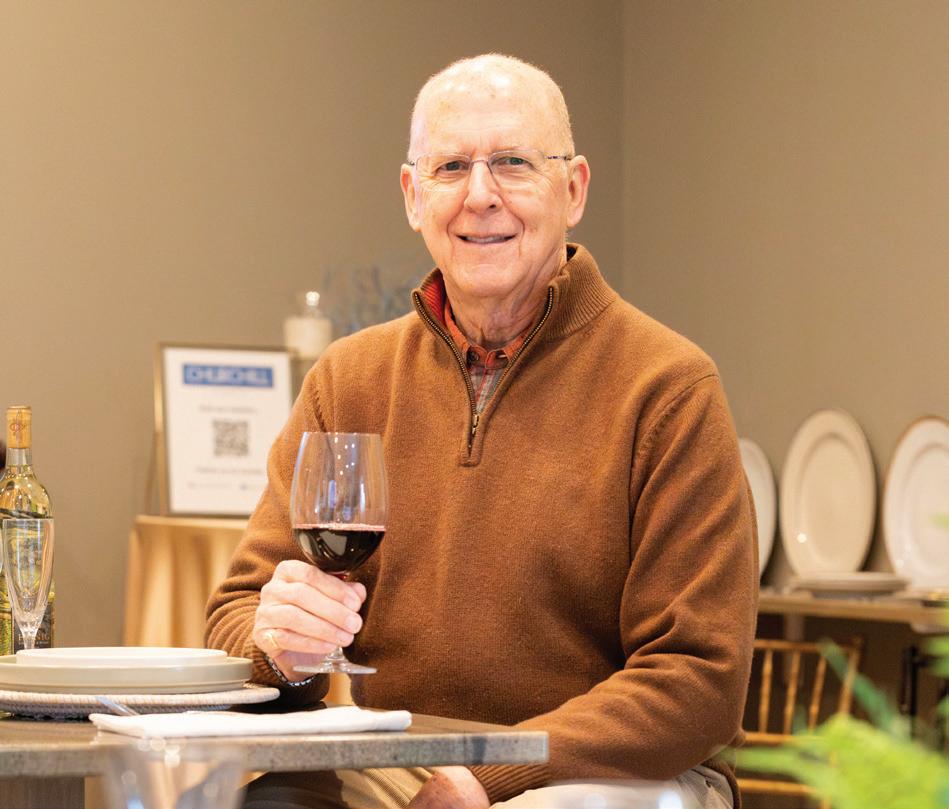 Craig Williams ’71
Craig Williams ’71
CHEERS TO THAT
Craig Williams ’71 turned the joy of a job well done into a successful career in hospitality, catering, and event planning.
GROWING UP WITH FIVE SIBLINGS ensured competition for praise from our parents for doing a good job. We had weekly assignments, and our parents loved to entertain. When I think of how effortlessly my mother seemed to pull off those annual holiday open-house events (like when 125 friends and neighbors would stop by on Christmas Eve for seasonal cheer), I am pretty sure that led me to end up in hospitality.
DURING MY BOWDOIN YEARS, I worked in Moulton Union and a fraternity kitchen. After US Army training and business school, I joined a Boston hospitality management firm, oversaw a group of Hiltons in the Northeast and Florida, opened a deluxe resort in the West Indies, and served as managing director of the Ritz-Carlton in Washington, DC. In 1996, my family and I moved to Maine, and I established Churchill Events in Portland. CHECKLISTS ARE ESSENTIAL— even the most thorough ones can miss a very important element. For one recent event (with a 450-item checklist), I had agreed to look over the entertainer’s (Lionel Richie) contract rider to make sure we could provide everything required. I had not expected a twenty-five-page, single-spaced book of required items. It took a lot of phone calls and emails, but we were able to supply everything— Lionel was pleased, and the client was thrilled!
For more from this interview, visit bowdoin.edu/magazine.
BOWDOIN MAGAZINE WINTER 2024 | CLASSNEWS@BOWDOIN.EDU 51
PHOTO: ANDREW ESTEY
Catching Up
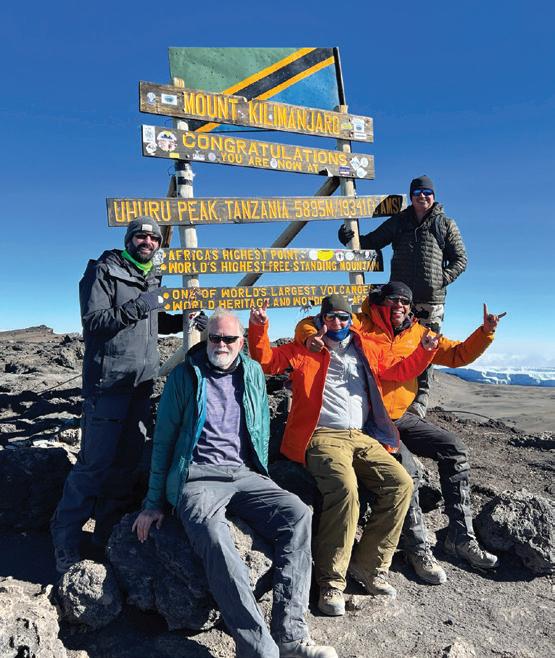
Jay Vivan ’73, hatless,
at the summit of Mount Kilimanjaro in Tanzania with a group of fellow hikers. He says that he still hikes a lot and usually tackles “two major ones” each year.
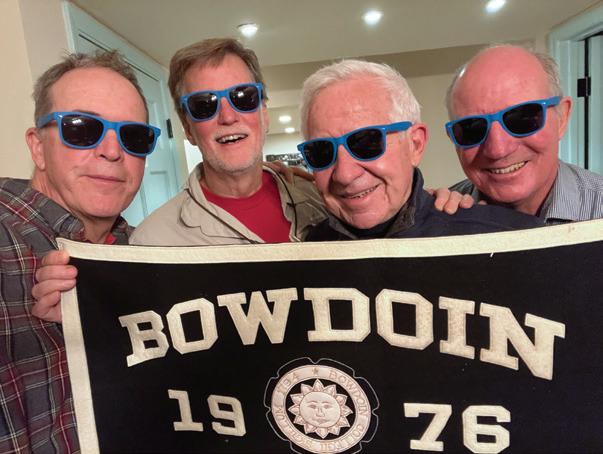
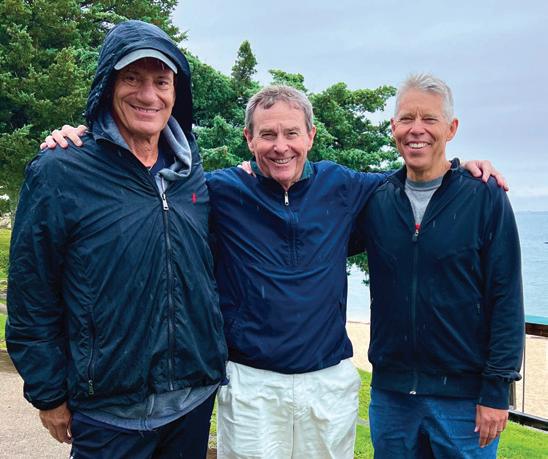
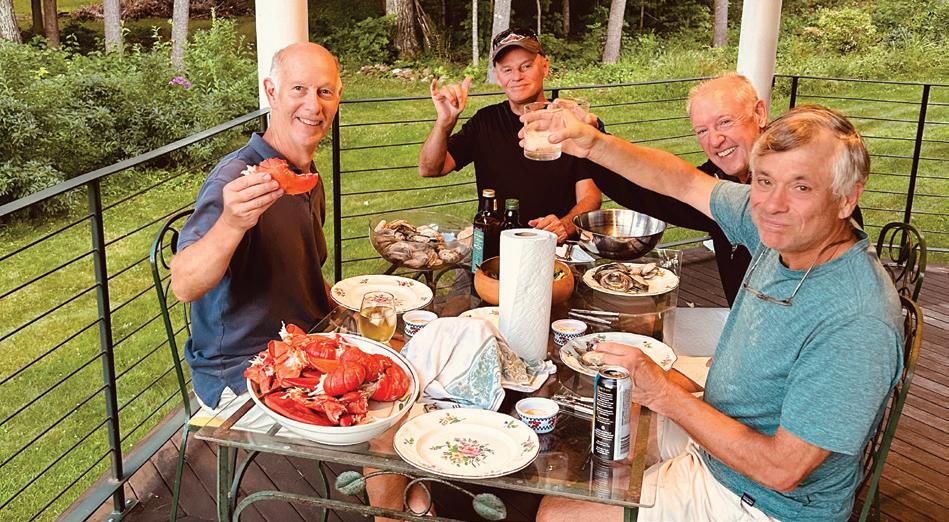
1976
From John Bowman: “Class of ’76 tennis- and squash-mates John Bowman, Jim Fitzpatrick, and Brett Buckley had a longawaited reunion at Fitzie’s place in Nonquitt, Massachusetts, last August. Had lots of laughs, great food, and some ‘amazing’ duffer’s tennis and golf. I was cajoled into taking a dip into Buzzard’s Bay on a very cold morning—wound up getting chilled, followed by a week of COVID. A small price to pay for some quality reunion time with some of Coach Eddie Reid’s finest!”
From Chris Wolf: “Chris Wolf is keeping busy in retirement after four decades in the law, seizing on his status as a fourth-generation Washingtonian to serve as board chair of the DC History Center and on the board of the new Capital Jewish Museum. He also serves on the national board of the AntiDefamation League and the boards of the Electronic Privacy Information Center (EPIC), Young Concert Artists, and the Future of Privacy Forum, which he founded and chairs.”
1979 Reunion
Leslie Anderson: “I have just returned from a trip to Buenos Aires, Argentina, where I was invited to make presentations at two conferences celebrating Argentina’s return to democracy forty years ago this month. I presented a paper: ‘Paths Toward Democracy: Institutions and Social Capital,’ at the Conference on Forty Years of the Third Wave of Democracy in Latin America, held at the Torcuato Di Tella University, Buenos Aires, November 27–28. I was also invited to make comments at the Conference in Memory of the Work and Legacy of Guillermo O’Donnell at Austral University on November 29.”
Bernard Fortier: “I retired this past June after teaching Latin and French at Lewiston High School for thirty-two years. My last hurrah was giving the graduation speech dressed as a Roman centurion! I am now subbing, playing hockey four times a week, reading, and spending time with family and friends. Looking forward to our 45th Reunion in June!”
1981
Andrew Holman:
“Working with serial entrepreneur Larry Bock, I shared data about heart rate variability (HRV) testing for Cancer Moonshot cancer care at the 2016 reunion. Now our next-gen, precision version is working through FDA review. Hardening the soft science of stress biology, Inmedix CloudHRV is coming to US clinics in early 2024. Get ready for a once-in-a-century diagnostic.”
1982
From a United States District Court Southern District of Ohio newsletter article. Having just been ceremoniously sworn in as a US District Judge, Jeffery Hopkins spoke at the National Underground Railroad Freedom Center in Cincinnati about the tragic murder of his great uncle. “Hearing the story of Robert Hall, a World War II veteran, being snatched from his home in front of his wife and newborn in the wee hours of the morning of January 29, 1943, for the alleged crime of tire theft … and his being beaten to death on the courthouse steps, ignited in me a desire to be part of the justice system and become a lawyer.” Hopkins served twenty-six years on the bench as a bankruptcy judge and was appointed by President Biden in 2022 to become the 40th US District Judge for the Southern
52 BOWDOIN MAGAZINE WINTER 2024 | CLASSNEWS@BOWDOIN.EDU Connect
sits
Roommates Brian O’Donnell ’76, Bill Lambert ’76, Mike Fiore ’76, and Fred Carey ’76 celebrate birthdays and Fio’s favorite color in Tucson, Arizona, on December 1, 2023.
John Bowman ’76, Jim Fitzpatrick ’76, and Brett Buckley ’76 together at “Fitzie’s” in August for a long-awaited reunion and a great time.
Tom Moore ’80, Rick Beveridge ’80, Mike McQueeney ’80, and Jamie Macmillan ’80 had their own Downeast lobster feast in Brunswick to celebrate turning sixty-five.
District of Ohio. The court gathered on June 28 to celebrate his investiture. Hopkins said at the event that he is committed to protecting America’s promise that everyone should be treated fairly under the law. He also challenged everyone to think of ways they can make a difference in their fellow Americans’ lives. “If each of us volunteered just one hour using the American spirit witnessed in [the book and movie] Hidden Figures that launched Ohioans John Glenn into space and Neil Armstrong on a rendezvous with the moon, dare I say we can make a difference in the lives of young people while adding strength and vitality to the country we love.” Among the attendees at the swearing-in were Boston attorney and managing director of the Rich May law firm, Emmett E. Lyne ’81, and Boston businessman Nick Krol ’97
1984
Reunion
JT McMillan: “The most remarkable thing about aging is our capacity to deny it—and I’m in full denial. Even so, time passes, and our 40th Reunion looms. Attending would be a first for me, but we’re approaching ‘now or never’ time, so I’m leaning that way. I look forward to hearing what my classmates have learned in these decades. Or just email me at jonmcmillan.me@gmail.com. Seriously, I’d love to gather your wisdom—or whatever. It’s fine if you have no idea who I am because it’s not clear to me either!”
1986
Andrew Turkish: “I am a senior partner at Clausen Miller PC in Florham Park, New Jersey, specializing in litigation. I also am a professor at Seton Hall University Law School. Lost my dad this year at eighty-six,
which is rough, but my son had a baby boy, Logan Alan Turkish, which has brought great joy to our family. Being a grandfather is great. I am hoping Logan grows up to be a hardcore NY Yankees fan, which is still my passion outside of the law and teaching. I cannot wait to go to his Little League games. Would love to hear from classmates. My best contact is aturkish@clausen.com.
Best regards to all.”
1987
From a Denison University online news release, December 5, 2023.
Denison University President Adam Weinberg has been appointed to the National Collegiate Athletic Association’s (NCAA) Division III Presidents Council, the highest governing body in the division. Weinberg is one of five new members of the council, who begin their four-year terms following the 2024 NCAA Convention in January 2024. The NCAA Presidents Council implements policies adopted by the association’s board of governors and may sponsor amendments to the NCAA constitution. It establishes and directs the general policies of the division, while also overseeing the division’s budget and establishing the strategic priorities. Additionally, the Council may sponsor legislation and adopt noncontroversial and intent-based amendments, administrative bylaws, and regulations to govern the division between NCAA Conventions. Weinberg currently serves as the North Coast Athletic Conference (NCAC) president—he will be the eighth NCAC president to serve on the council. Weinberg became the twentieth president of Denison University in 2013. He has focused on positioning Denison in ways that address the major issues
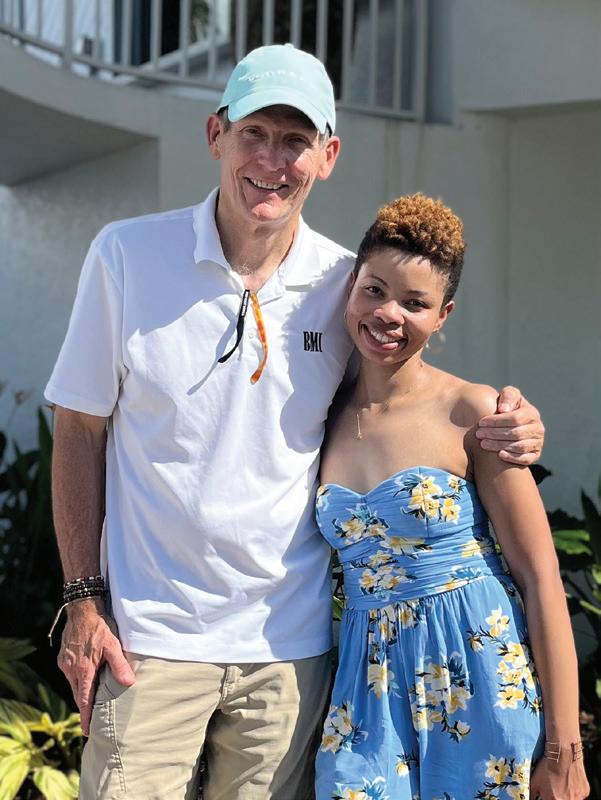
Dan Spears ’81 and Coretta King ’12 connected recently at the 2023 Island Hopper Songwriter Festival in Captiva Island, Florida. The festival is presented by Dan’s company, BMI, and Coretta, whose music is represented by BMI, was one of the featured singer-songwriters.

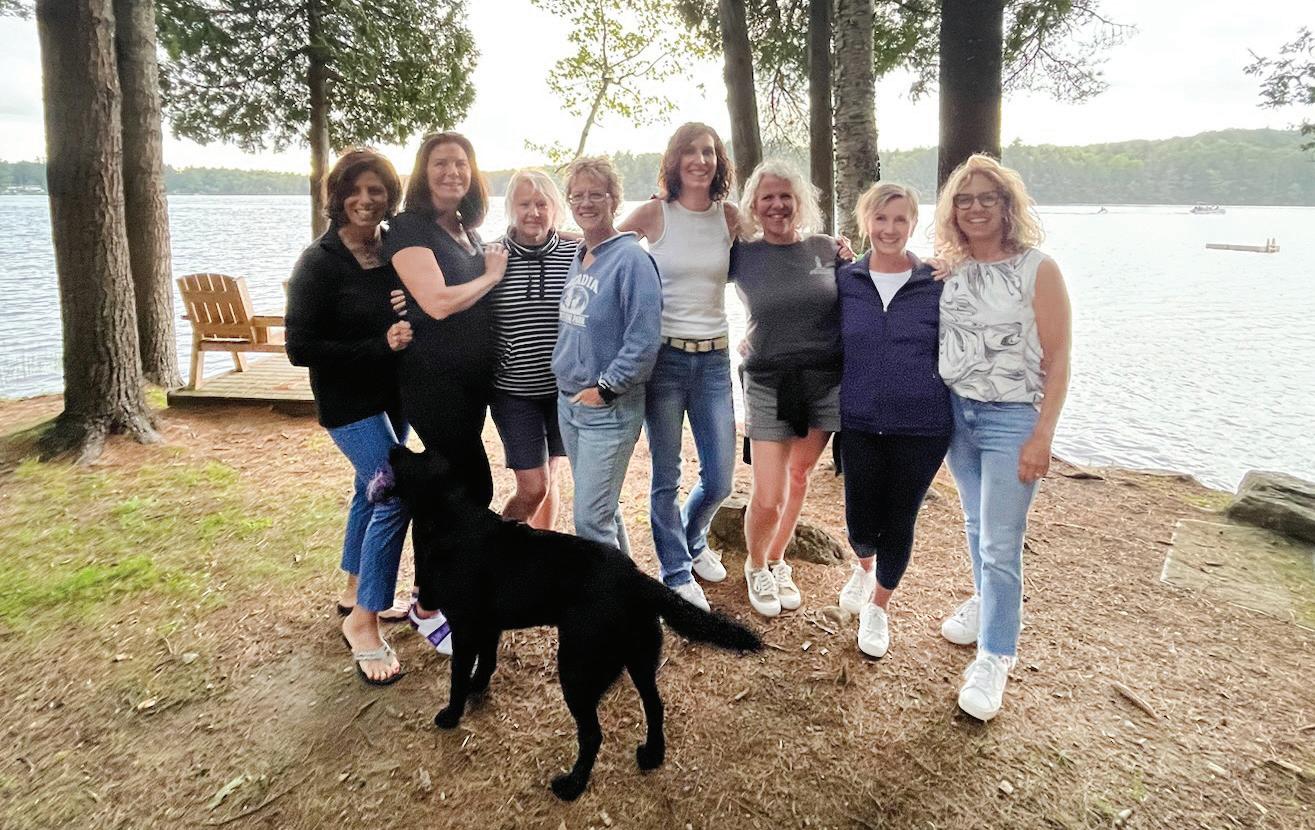
BOWDOIN MAGAZINE WINTER 2024 | CLASSNEWS@BOWDOIN.EDU 53
JT McMillan ’84 paragliding on the coast of Maine this fall where, he said, he was “putting the philosophy degree to some use.”
Class of ’85 friends Jeanne Little Ramsay, Andrea Demars Gordon, Mary Willcox Smith, Marion Ryder Webster, Sue Thornton, Jennifer Wallace-Brodeur, Marybeth Fennel Brust, and Julie Arvidson Andrews gathered for collective sixtieth-birthday celebrations in August at Andrea’s camp in Winthrop, Maine.
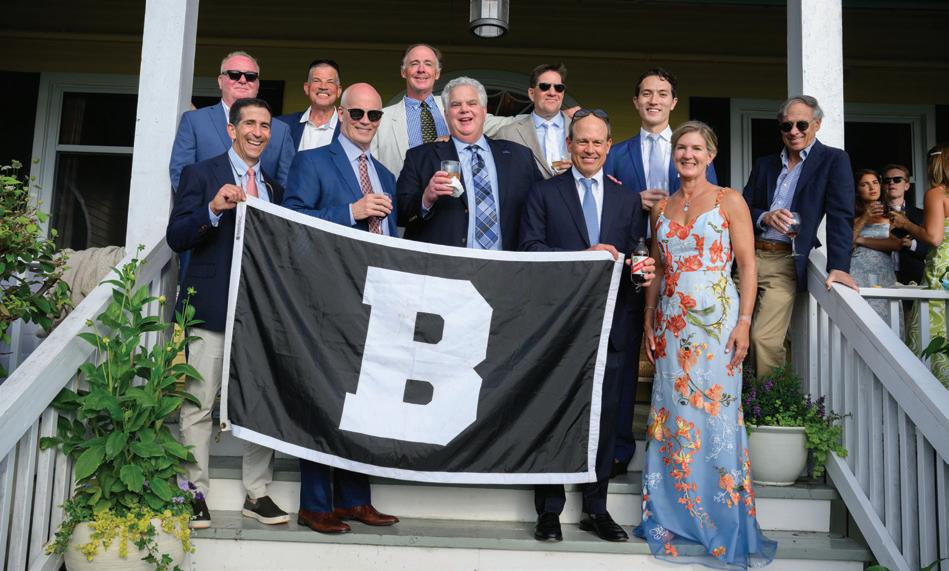
facing higher education in the twenty-first century, including affordability, career readiness, internationalization, civic education, learning outcomes, and social inclusion.
1988
David Belmont:
“After ten years in Singapore and fifteen years in New York/Greenwich, Tilly and I are getting out of our comfort zone by living in London as empty nesters for a few years. Any Polar Bears in the West End, look us up! Will grab a pint when not traveling!”
anesthesiology at the University of Cincinnati Medical Center and a fellowship in pedia tric anesthesiology at Cincinnati Children’s. She is board certified in anesthesiology and pediatric anesthesiology, is a member of the American Society of Anesthesiologists’ Committee on Physician Wellbeing, and serves as a mentor for the Women’s Empowerment and Leadership Initiative/Society of Pediatric Anesthesia. Her appointment began January 22, 2024.
1991
their parents (also Bowdoin classmates!) serendipitously ran into each other there on Thanksgiving Day.
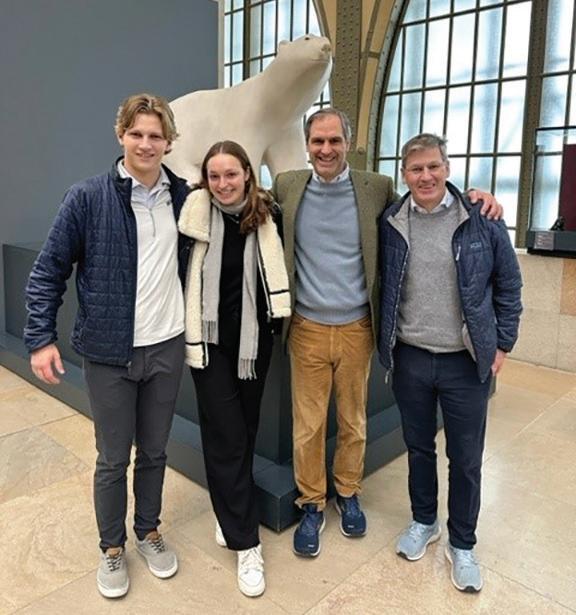
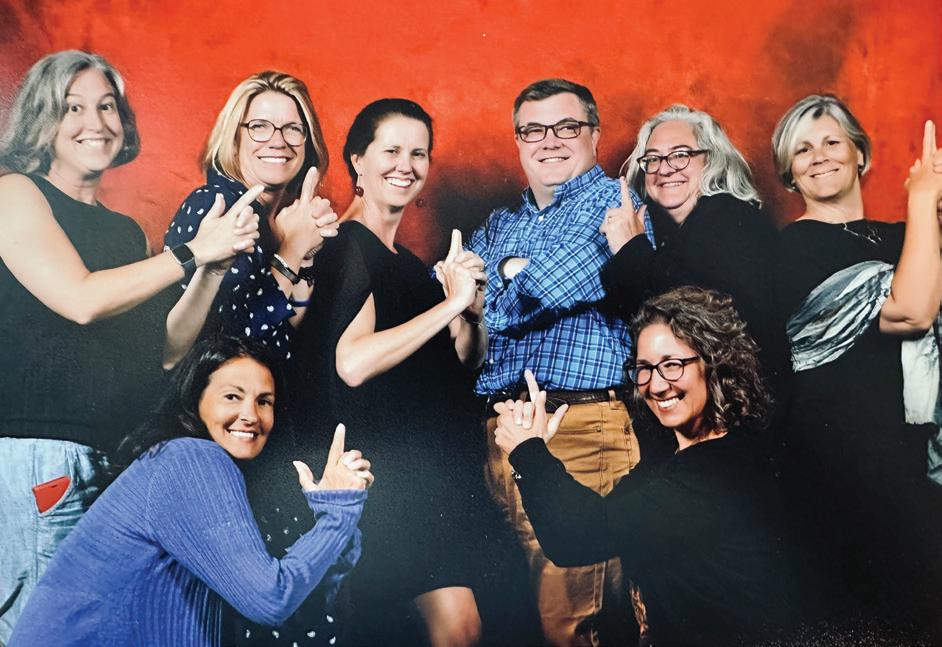
1990 From a Cincinnati Children’s press release, November 8, 2023. Anne Boat has been named anesthesiologist-in-chief at Cincinnati Children’s, a nonprofit academic health system that is internationally recognized for improving child health and transforming delivery of care through research, education, and innovation. She is the first female to hold this position at the health system. Boat returned to Cincinnati Children’s from Ann & Robert H. Lurie Children’s Hospital of Chicago, where she served as associate chief medical officer and director of fetal anesthesia since 2018. She is also an associate professor of anesthesiology at Northwestern University Feinberg School of Medicine. Prior to this, Boat served as patient experience officer in the Center for Patient/ Family Experience, director of fetal anesthesia, and associate professor of clinical anesthesia and pediatrics at Cincinnati Children’s. She joined Cincinnati Children’s in 2006 as an assistant professor of clinical anesthesia and pediatrics. Boat earned her medical degree from the University of North Carolina. She completed a residency in
From a bowdoin.edu/news story, November 29, 2023. Chris Brown, chief financial officer at the Maine-based independent record store chain Bull Moose, was recently interviewed on the WCSH TV program 207, where he discussed a number of albums that came out as part of Record Store Day’s Black Friday releases—a concept that was introduced in 2011. (NOTE: In 2008, Brown was one of the handful of entrepreneurs who started Record Store Day, now a global, industrywide celebration of recorded music, held every April.) One of the highlights he mentioned was a recording by former Bowdoin music professor and free jazz pioneer Marion Brown ’74, which has been rereleased more than half a century after it was recorded. The album, Creative Improvisation Ensemble, was recorded in Paris, France, in 1970 by Brown, primarily a saxophonist, and trumpet player Leo Smith. Both musicians also play various percussion on the record. The Marion Brown recording is of particular interest to the Bowdoin community, said Chris Brown, because the following year he came to Bowdoin, where he taught as assistant professor of music while simultaneously pursuing his bachelor’s
54 BOWDOIN MAGAZINE WINTER 2024 | CLASSNEWS@BOWDOIN.EDU Connect
Ben Secor ’25, Hollis Hirsch ’25, Scott Hirsch ’90, and John Secor ’90 pose in front of a polar bear sculpture at the Musée d’Orsay in Paris. The Bowdoin classmates and
Polar Bears Keith Shortall ’82, Dave Bean ’82, Rick Beveridge ’80, Mark Luz ’82, Andrew Murowchick ’16, Bill Pohl ’77, Jeff Colodny ’83, Pete Larcom ’81, Brien Henderson ’82, Charlie Pohl ’83, and Jessica Lydon Pohl ’89 gathered at the Chebeague Island Inn in Casco Bay to celebrate the marriage of Charlie and Jessica’s daughter Abigail Pohl to Danny Pierce on August 12, 2023. Joe Cogguillo ’81 was also at the festivities but missed his photo op!
Emily Flanigan Hiller ’94, Liz Garrett Mayer ’94, Megan Mahar Breiding ’94, Rodney Lewis, Adele Maurer Lewis ’93, Amy Fish ’94, Jen D’urso ’94, and Jenna Burton ’94 struck a pose together while on a cruise celebrating their fiftieth birthdays (in 2022). They visited ports in Maine, Nova Scotia, Prince Edward Island, and sites along the St. Lawrence.
degree. By this time, he had already gained a reputation as a leading member of the New York avantgarde jazz scene, playing alongside such legends as John Coltrane and Archie Shepp. “Another cool Bowdoin connection,” said Chris Brown, “is that Creative Improvisation Ensemble was later repackaged into a double-LP set titled Duets, and the second LP in Duets was an album featuring Marion Brown and Elliott Schwartz [the pioneering classical composer and Bowdoin’s former Robert K. Beckwith Professor of Music Emeritus, who died in 2016]. That album was recorded in Bowdoin’s gym,” explained Brown, who majored in music. One of the reasons he enrolled at Bowdoin, he added, was to study under Schwartz. The Bowdoin music department, meanwhile, is preparing to award the inaugural Marion Brown Prize, a new annual residency to support emerging composers from underrepresented communities.
1997
From a Hispanic Executive online column, January 8, 2024. The David Morales story is the story of the Morales family. That resonates in no place greater than his recent autobiography, American Familia. In it, Morales digs into his Puerto Rican heritage—not only to emphasize the legacy of his family’s journey to America, but to also inspire others within the Latino community to tell their own stories. A devout student of all things Puerto Rico, Morales has been steadfast in his dedication to the island. He shows it through his keen interest in its musical history as well as the many ways in which he incorporates a “family first” culture into the teams he leads at Unicare, a health benefits company located in Woburn, Massachusetts, where he
currently serves as general manager. He is also a best-selling author and a renowned researcher and lecturer in traditional music from Puerto Rico. He is very active in his community, serving on several boards.
1999 Reunion
Jen Malia: “I was recently promoted to professor of English at Norfolk State University. My children’s chapter book series, The Infinity Rainbow Club, illustrated by Peter Francis, is launching this fall with Beaming Books. The Infinity Rainbow Club features five neurodivergent children in a club at their elementary school. The first book in the series, Nick and the Brick Builder Challenge, came out September 26, followed by Violet and the Jurassic Land Exhibit on October 24 and Connor and the Taekwondo Tournament on March 2, 2024. You can learn more about the books on my website at JenMalia.com.”
2001
Nick Krol: “Great getting back to campus for an amazing Homecoming Weekend! I enjoy supporting the Max Courage curriculum (maxcourage.org). Fred Warburg ’04 and family created this organization in recognition of his late brother Max, who was lost to cancer. Very sorry to learn of Truc T. Huynh ’05’s passing. Super cool/fun individual gone too soon. Go U Bears!”
2005
From a bowdoin.edu/news story, October 4, 2023. When Politico reporter Corbin Hiar returned to Bowdoin last April to participate in the environmental studies’ (ES) fiftieth anniversary symposium, he got a lead for a story he had been working
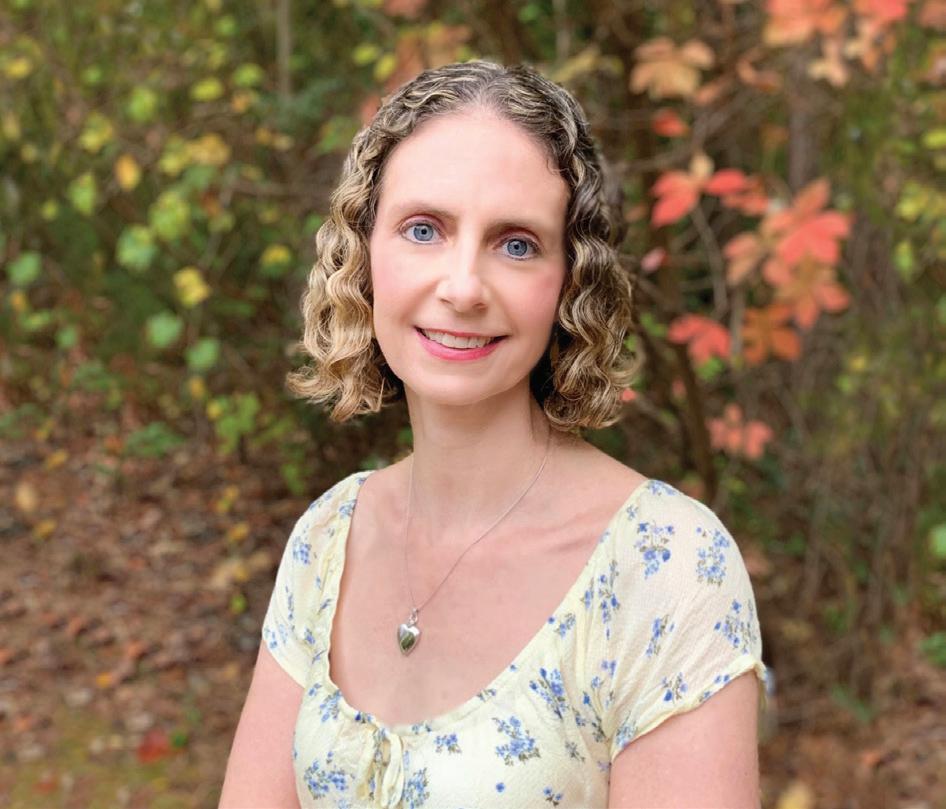
TURNING THE PAGE
Jen Malia ’99 started a new chapter after being diagnosed with autism spectrum disorder on the same day as her two-year-old daughter.
MY JOURNEY to discover my own and my kids’ neurodivergence led me to pivot in my career. I’m still a professor at Norfolk State University, but I stopped publishing literary criticism and focused instead on writing to advocate for neurodivergent people like me and my kids. I started by telling my own story in essays for publications like The New York Times and writing children’s books like the Infinity Rainbow Club series.
ONE OF MY FAVORITE PROFESSORS AT BOWDOIN was Ann Louise Kibbie. I took her American Gothic seminar as a first-year student, and she ended up being my advisor for my honors thesis on Gothic literature too. My dissertation at the University of Southern California focused on Gothic terror and terrorism in literature. My current book project—a middle-grade horror novel for kids—was inspired by some of the Gothic literature I first read at Bowdoin.
NOTHING WAS MORE EXCITING than racing the 4 x 400-meter relay or a 5K cross-country race. Training was always an adventure with Coach Slovenski, who would take us to run intervals up a mountain or a trail run through snow and mud in the Maine wilderness. I’ve done a lot of half marathons since I graduated, but I’m now training for my first marathon.
For more from this interview, visit bowdoin.edu/magazine.
PHOTO: DAVID SWARTZ
BOWDOIN MAGAZINE WINTER 2024 | CLASSNEWS@BOWDOIN.EDU 55
Jen Malia ’99
Catching Up
Exceptional Devotion
Gifts from estates have established programs, enabled growth, and supported priorities of the College from its earliest days. With more than a thousand members ranging in age from twenty-seven to one hundred and five, the Bowdoin Pines Society recognizes the bedrock value of planned gifts and honors alumni and others who show exceptional devotion to the College by making gift planning arrangements.
If you have made a beneficiary designation or included a provision for Bowdoin in your estate plan, we would like to welcome you into the Bowdoin Pines Society. If you are or will be sixty-five by June 30, 2024, your documented provision will be celebrated in From Here: The Campaign for Bowdoin
Nancy Milam and Liz Armstrong in the Office of Gift Planning can help you become a member of the Bowdoin Pines Society and create your legacy at Bowdoin.
207-725-3172
giftplanning@bowdoin.edu bowdoin.edu/gift-planning
on for months. The symposium brought more than a dozen alumni to the College to participate in public discussions about environmental justice, storytelling, design, planning, and sustainability. Sam Brody ’92, an expert on flood risk and mitigation, was one of the alumni guests; he participated in a panel about environmental design and planning. He is Texas A&M University’s Regents Professor in the department of marine and coastal environmental sciences. Hiar writes about energy and the environment and was part of the symposium’s environmental storytelling panel. In the months leading up to the event, he had been investigating a seeming inconsistency in the “gold standard for environmental design,” the US Green Building Council’s LEED rating system. After hearing Brody speak about strategies for lessening coastal flooding, Hiar became curious to hear Brody’s thoughts about LEED. He pulled Brody aside to question him, and the two talked in depth a week later. In the end, Hiar said Brody’s input was invaluable to his reporting and helped frame the piece. He thanked the environmental studies program for bringing the two together. In his Politico special report, which was published in late September, Hiar examines what he calls a contradiction in the LEED program, in that “the influential rating system largely overlooks the growing impacts of climate change, despite increasingly frequent and severe climate-related disasters...As a result, the Green Building Council has affixed its coveted three-leafed seal to more than 800 new buildings in the past decade that are at extreme risk of flooding, according to an analysis by Politico’s E&E News and the First Street Foundation, a nonprofit that models likely climate
impacts.” If these buildings require repairs or even become uninhabitable before the end of their life cycle, the value affixed to their being green and sustainable comes into question. “More importantly,” Hiar writes, “the LEED process and the tax breaks involved could be a crucial tool for preparing man-made structures for climate-related disasters—one that is being squandered today.”
2009 Reunion
Lily Morse: “Anna Folkers and I were married on June 3, 2023, at The Owenego, a historic inn and beach club around the corner from our house in Branford, Connecticut. In attendance were classmates Morgan Macleod and Luke Fairbanks. My wife and I are both oncology nurses at Yale Cancer Center. We enjoy yearly camping trips to Hermit Island, our favorite place in Maine.”
2010
From a bowdoin.edu/news story, October 25, 2023. Caitlin Meehye Beach has won the Smithsonian American Art Museum’s annual Charles C. Eldredge Prize for Distinguished Scholarship in American Art. The award recognizes her new book, Sculpture at the Ends of Slavery (University of California Press, 2022), which examines the “intersections between the economic wealth generated by enslavement and the materials, production, and circulation of eighteenth- and nineteenth-century sculpture.” The work, selected by an independent panel, was praised for advancing “how American art history approaches racial violence, offering students a model for eliminating racial spectacle,” according to the Smithsonian. Beach is an assistant
56 BOWDOIN MAGAZINE WINTER 2024 | CLASSNEWS@BOWDOIN.EDU Connect
professor of art history and affiliated faculty in African and African American studies at Fordham University. For the academic year 2023–2024, she is also codirector of Fordham’s newly established program in Asian American studies. She earned a doctorate and master’s degree from Columbia University. Linda Docherty, associate professor of art history and emeritus and Beach’s thesis advisor, said Beach “was a stellar art history student at Bowdoin. She had a voracious appetite for learning, a creative approach to research, and a dogged determination to understand fully whatever topic she pursues.” Bowdoin Professor of Art History Stephen Perkinson, also a former professor of Beach’s, said the award is a significant one in the art history field, and well-deserved by Beach for her important book. Docherty agreed. “Sculpture at the Ends of Slavery exemplifies both the breadth and the depth of Caitlin’s formidable intellect. I was delighted to hear that she had received the Smithsonian’s Eldredge Prize, but not at all surprised,” she said.
From Kate Emerson Emerdello: Luke Emerdello and Kate Emerdello are excited to announce the arrival of Ben, “an August child confused by Maine winters and birthday buddy of classmate Ellie Stevenson. The family of three is forever grateful to fellow Polar Bear and midwife-in-training Olivia Erickson ’18, who helped welcome Ben into the world.”
From an Ohio University online news announcement, January 8, 2024. Alexandra Locke has been selected for the 2024 Kiplinger Fellowship in Public Affairs Journalism at Ohio University. Locke, executive producer for The Take, an Al Jazeera English podcast, is one of eighteen veteran journalists with experience covering
immigration and migration issues across the globe to be chosen out of nearly three hundred applications. She will travel to Ohio University in April for the weeklong fellowship, which is aimed at improving immigration and migration reporting. During the week, fellows will have an opportunity to hear from leading experts on immigration and migration policies and from humanitarian organizations, as well as from other journalists who cover the issues exclusively. The fellowship will consist of workshops and focus of themes like economic, climate, or political forced migration, border policies and immigration quotas, human trafficking, and other related topics. The gathering will mark the fifty-first year of the fellowship, which was started in 1973 at The Ohio State University following a generous gift from the Kiplinger family in honor of patriarch William Kiplinger, the founder of Washington Editors.
2012
From a
bowdoin.edu/news story, November 28, 2023. In November, Alain Mathieu was named to Boston’s 2023 list of Ten Outstanding Young Leaders by the Greater Boston Chamber of Commerce and its young professional platform, City Awake. Mathieu, an attorney who handles civil litigation matters for private and public companies, is an associate at the Boston-headquartered law firm Mintz. After Bowdoin, Mathieu, the son of Haitian immigrants who grew up on Long Island, New York, attended law school at Boston College. His practice focuses on complex commercial litigation, including contract disputes, business litigation, and government investigations, as
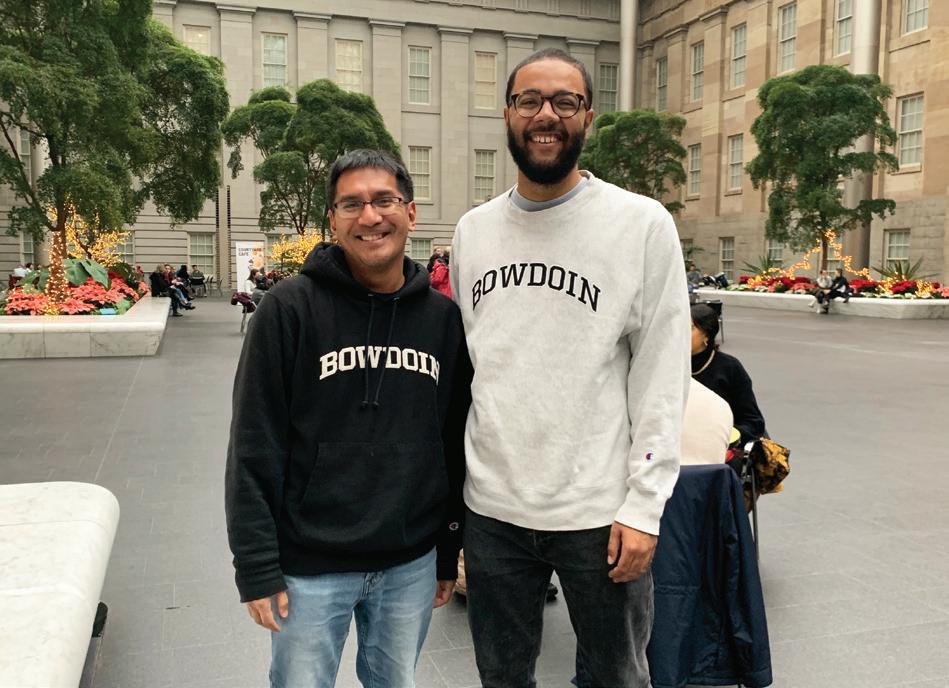
Noel Verzosa ’99 happened to be wearing his Bowdoin sweatshirt during a visit to the National Portrait Gallery in Washington, DC, where he was spotted by Nate DeMoranville ’20, sporting his own Bowdoin gear. The two couldn’t pass up the photo op!
Kendall Brown Reed ’06, Margaret Gormley Donahue ’06, Emily Oster, and Ashley Conti Smith ’07. Kendall says the alums were thrilled to meet Oster, a behavioral economist and “overall go-to data-based mom specialist!”
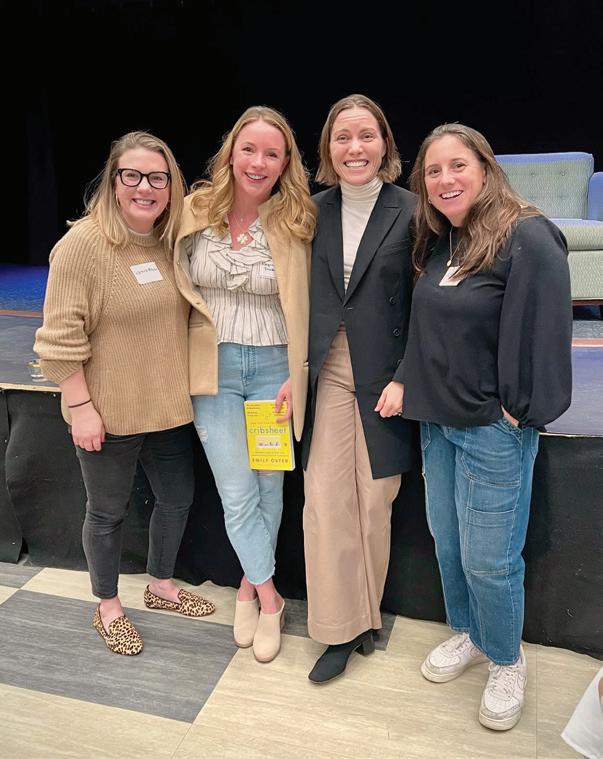
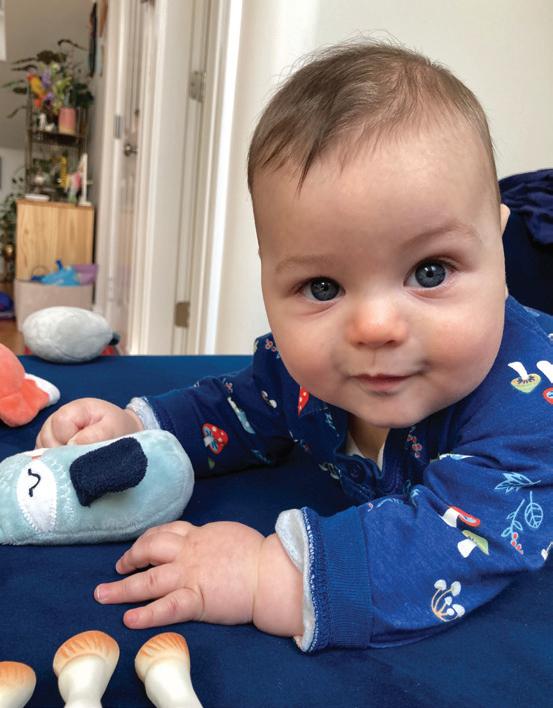
Luke Emerdello ’10 and Kate Emerson Emerdello ’10 happily announce the August arrival of their son, Ben.
BOWDOIN MAGAZINE WINTER 2024 CLASSNEWS@BOWDOIN.EDU 57
Connect
well as sports and entertainment, institutional class action recovery, and public finance and bankruptcyrelated litigation. He is an active member of the firm’s sports and entertainment practice, for which he counsels clients in personal business, branding and licensing, league compliance, investigations, and litigation. Mathieu also maintains an active pro bono practice, in which he represents clients in matters related to domestic and sexual violence, asylum, and civil appeals. He serves on a number of nonprofit boards for organizations that work to empower youths of various backgrounds, including Crossroads, the Wily Network, Harlem Lacrosse Boston, and The Foundation to Be Named Later. Mathieu also serves on Mintz’s advisory committee on recruitment and retention of Black attorneys, as well as the Boston Bar Association’s DEI Steering Committee. The Ten Outstanding Young Leaders Awards are presented annually by City Awake, which seeks to connect, engage, and celebrate the next generation of leaders. The awards recognize the contributions of current and emerging young local leaders who have demonstrated professional, personal, cultural, and civic commitments to advance their community, organization, and region.
2013 From Jordan Francke: “Jordan is finishing his final year of anesthesiology residency at UCLA, before beginning a one-year fellowship in obstetric anesthesiology at Brigham and Women’s/Harvard Medical School in Boston as his last year of medical training. Martin is working at the DC-based sustainability nonprofit World Resources Institute, supporting partnerships for a geospatial data platform.”
2014 Reunion
From a greenpointers.com online article and bagelup.co. Sam Silverman is Brooklyn, New York’s, very own Bagel Ambassador. He always had a passion for the food—his parents called him a “bagel-tarian” growing up—and in 2017 turned that obsession into a professional interest. While working in the corporate world, he realized there was a hole in the market: New York is the home of bagels. There is a festival for almost everything in New York. Yet somehow, New York City had never held a bagel festival. Silverman enmeshed himself in the bagel world, learning everything there is to know about bagels, and in 2019, BagelFest, New York’s first festival focused on the city’s iconic food, was born. The event has become the premiere trade and consumer show for the bagel industry, attracting thousands of bagel enthusiasts and foodies from around the world.
In July 2023, he was named one of “Brooklyn’s 50 Most Fascinating People” by Brooklyn Magazine. After seeing how popular the event was, Silverman also started his own company, BagelUp—now when he’s not planning BagelFest, you can find him leading bagel tours, writing a bagel newsletter, consulting for a bagel shop or bagel-related brand, and of course, eating a bagel. His favorite is an everything bagel with scallion cream cheese, not toasted. [2024 BagelFest will be held October 21–22, 2024, in Chelsea].
2016 From Anna Wells Piotti: “Weeks after defending their dissertations, Dr. Piotti married grad school sweetie Dr. Castonguay at the family farm. The two now live in Lewiston, Maine. Anna Wells Piotti Castonguay works
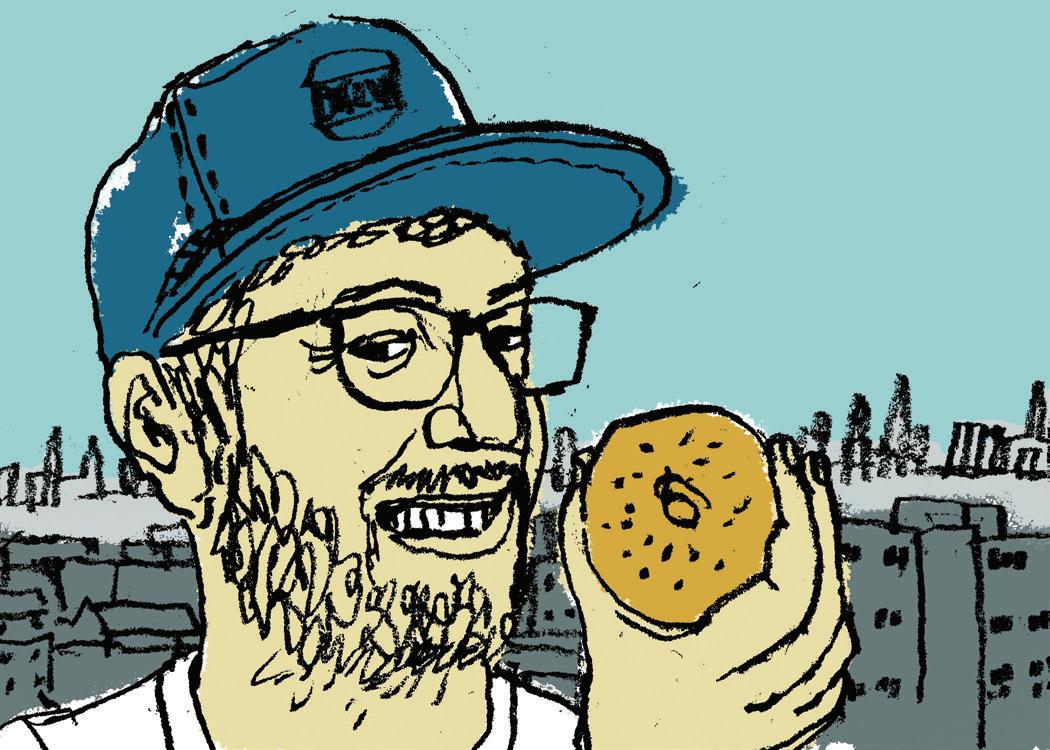
“Bagels have always been my favorite food. My parents called me a ‘bagel-tarian’ growing up. I ate bagels for virtually every meal.”
—SAM SILVERMAN ’14, BAGEL EXPERT AND FOUNDER OF BAGELFEST, NEW YORK CITY’S FIRST BAGEL FESTIVAL
at Bates, and Alexander Charles Piotti Castonguay is a radiochemist for the State of Maine.”
2018 From Dania Bowie: “Dania Bowie received an Ashley Bryan Fellowship with the Maine Writers and Publishers Alliance and a LGBTQIA Residency Fellowship at the Sundress Academy for the Arts. They will travel to Knoxville this winter for their weeklong writer’s residency. You can read their poem, ‘The Groundwater,’ in the anthology From Root to Seed: Black, Brown, and Indigenous Poets Write the Northeast, edited by Samaa Abdurraqib and published by NatureCulture.”
From a bowdoin.edu/news story, November 28, 2023. In November,
Chareeda Rustanavibul was named to Boston’s 2023 list of Ten Outstanding Young Leaders by the Greater Boston Chamber of Commerce and its young professional platform, City Awake. Rustanavibul is vice president, startup banking, at Silicon Valley Bank (SVB). Born and raised in Maine, Rustanavibul is a first-generation Thai college graduate and startup enthusiast who has built a community of earlystage founders, connecting them with venture capitalists to provide more access to capital to grow their businesses. She helped lead a bank-wide initiative to allocate funding and resources to underrepresented founders and organizations. Outside of SVB, Rustanavibul is the chief convention director at
58 BOWDOIN MAGAZINE WINTER 2024 | CLASSNEWS@BOWDOIN.EDU
ILLUSTRATION: ERIC HANSON
the National Association of Asian American Professionals (NAAAP). She led a national team of more than a hundred volunteers to deliver Boston’s largest leadership convention of Asian and Pacific Islander professionals. The convention brought in more than 780 attendees, forty sponsors, and seventy-five speakers, including keynote addresses from actor and activist George Takei, Boston Mayor Michelle Wu, and Gold House CEO Bing Chen. Rustanavibul is also a community fellow at Gold House, which is a nonprofit collective that unites, invests in, and champions API creators, founders, and leaders.
The Ten Outstanding Young Leaders Awards are presented annually by City Awake, Greater Boston Chamber of Commerce’s young professional network, which seeks to connect, engage, and celebrate the next generation of leaders. The awards recognize the contributions of current and emerging young local leaders who have demonstrated professional, personal, cultural, and civic commitments to advance their community, organization, and region.
2019
Reunion
David Shank: “In fall of 2023 I made big strides toward my goal of becoming a content creator. I create strategy videos for competitive Magic: The Gathering, and I am also documenting my journey toward playing Magic at the pro level.”
2020
From Anna Martens:
“Diana Grandas, Abigail Gurgliolo, Sarah Walker, Clara Booker, and Anna Martens reunited in the Seattle area this summer! We went hiking and wine-tasting
and re-created a picture from our (postponed in-person) graduation. In the last year, we have been living in North Carolina, Washington, DC, Alaska, Mexico, and Spain, so it was a feat to arrive all at the same place at the same time!”
2021 From a bowdoin.edu/news
story, September 20, 2023. In September, Mohamed Kilani was the guest on an episode of the podcast America the Bilingual. Interviewer Steve Leveen recorded the installment, “Meet a Spanish Teacher in Maine,” on Bowdoin’s campus. Kilani, who majored in Hispanic studies and education, now teaches Spanish at Falmouth Elementary School in Maine. Besides Spanish and English, he speaks Arabic as well as an Iraqi dialect his parents spoke and a bit of French and Russian. Leveen describes Kilani’s life as a modern-day odyssey. He was born in Amman, Jordan, to Iraqi parents who had fled war and economic hardship. When he was a young boy, his mother and her two sons were granted asylum to the United States. So, with his mother and his younger brother, Khalil Kilani ’25, Kilani arrived in Dallas-Fort Worth, Texas, in 2009, but moved a few months later to Portland, Maine. Kilani said part of the respect he had for his own teachers is why he pursued a teaching career. And he loves languages and teaching languages. “I think learning a language is an empathetic thing you can do for someone else. If you have a new immigrant community [nearby], it would be wise to learn a few phrases, learn about their community, see what they’re doing. Maybe share that with them, so you can be friends,” he told Leveen.

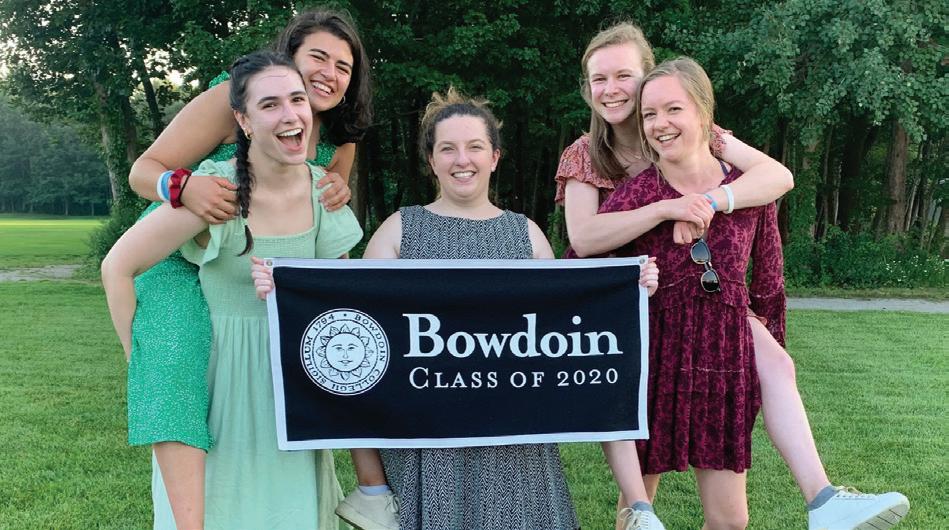
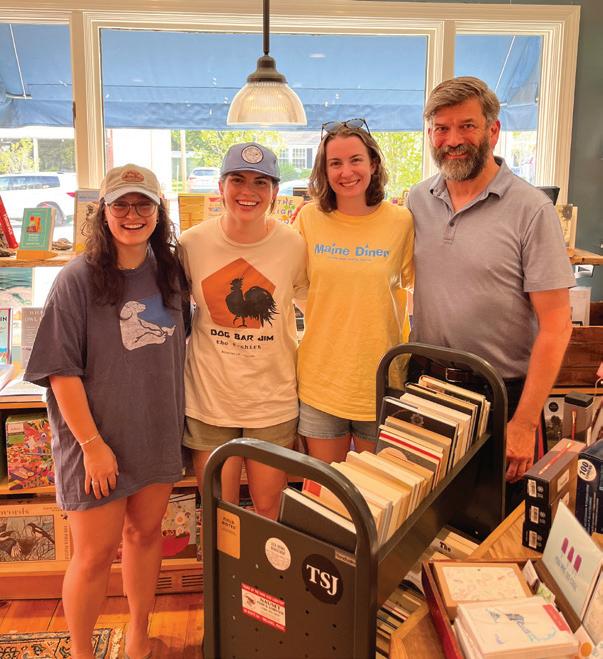
BOWDOIN MAGAZINE WINTER 2024 | CLASSNEWS@BOWDOIN.EDU 59
Nora Greene ’22, Kasey Cunningham ’22, Ailish O’Brien ’22, and Mark Ziomek ’83 met at Sea Howl Bookshop in Orleans, Massachusetts, this summer.
Clara Booker, Diana Grandas, Abigail Gurgliolo, Anna Martens, and Sarah Walker—all class of 2020—reunited in the Seattle area over the summer to hike, catch up, and re-create a picture from their (postponed in-person) graduation.
Sabrina Worth ’15, Bridgett McCoy ’15, Nate Joseph ’13, and Johnny Bohorquez ’13 met up in Quindío, Colombia, where they completed a three-day trek through the Páramos of Los Nevados National Park. They turned around at 16,000 feet and made it back, as Johnny reported jokingly, “mostly unharmed.” He added, with the same humor, that he thinks Bowdoin should offer a pre-orientation trip there for the group to lead next year!
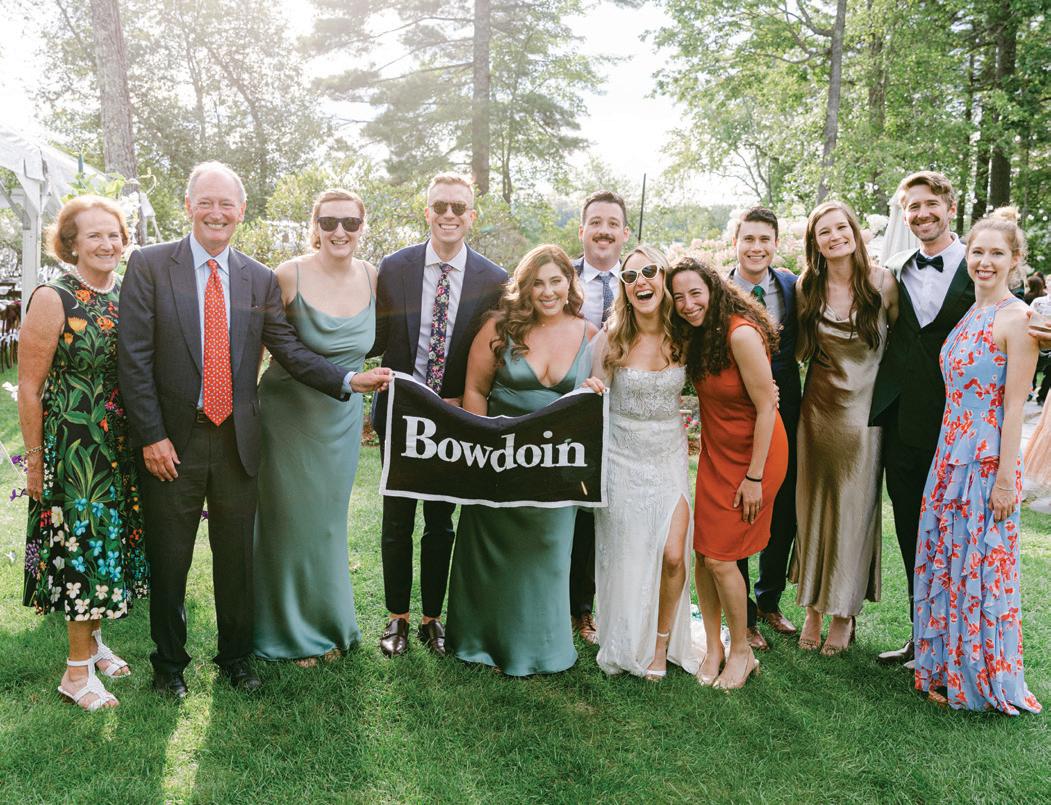
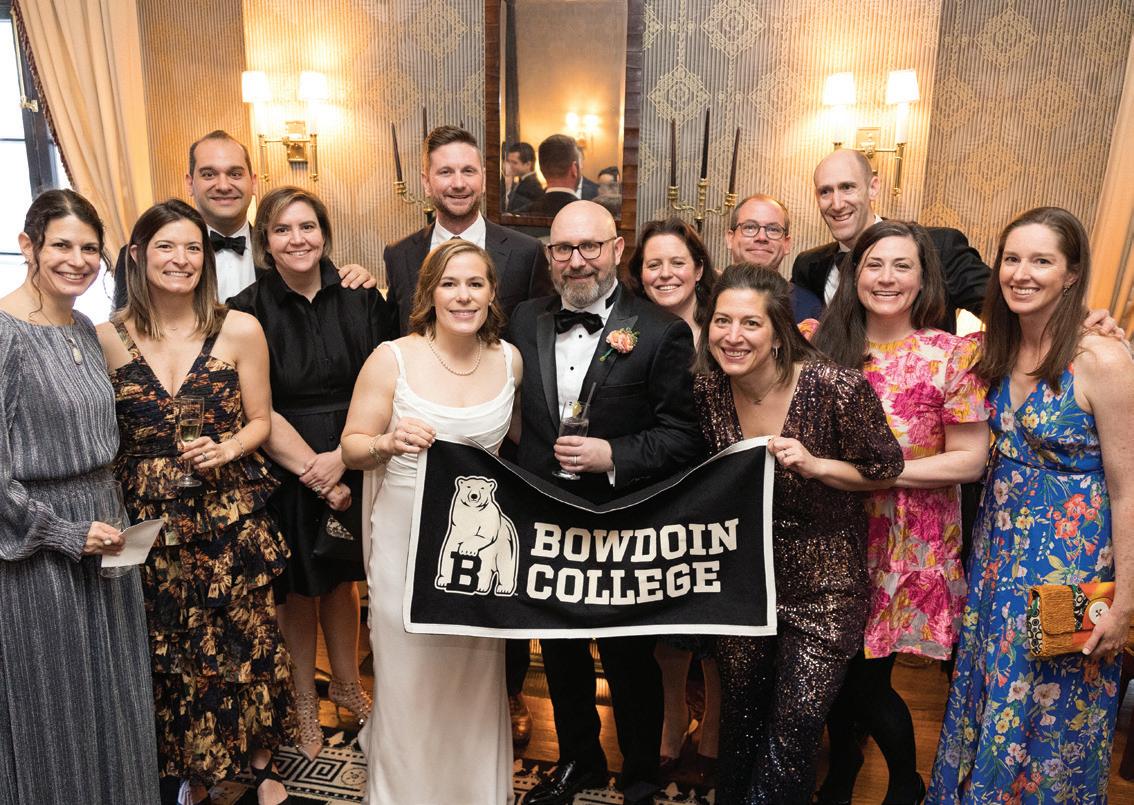
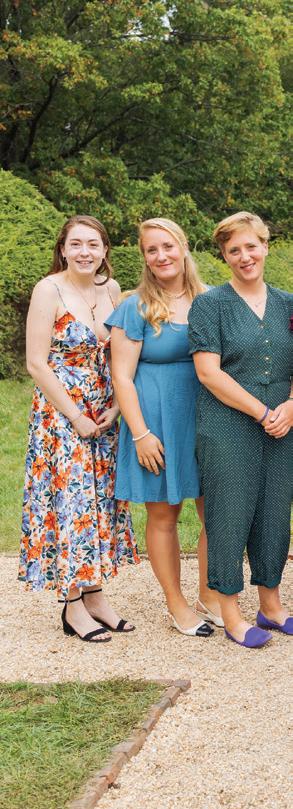
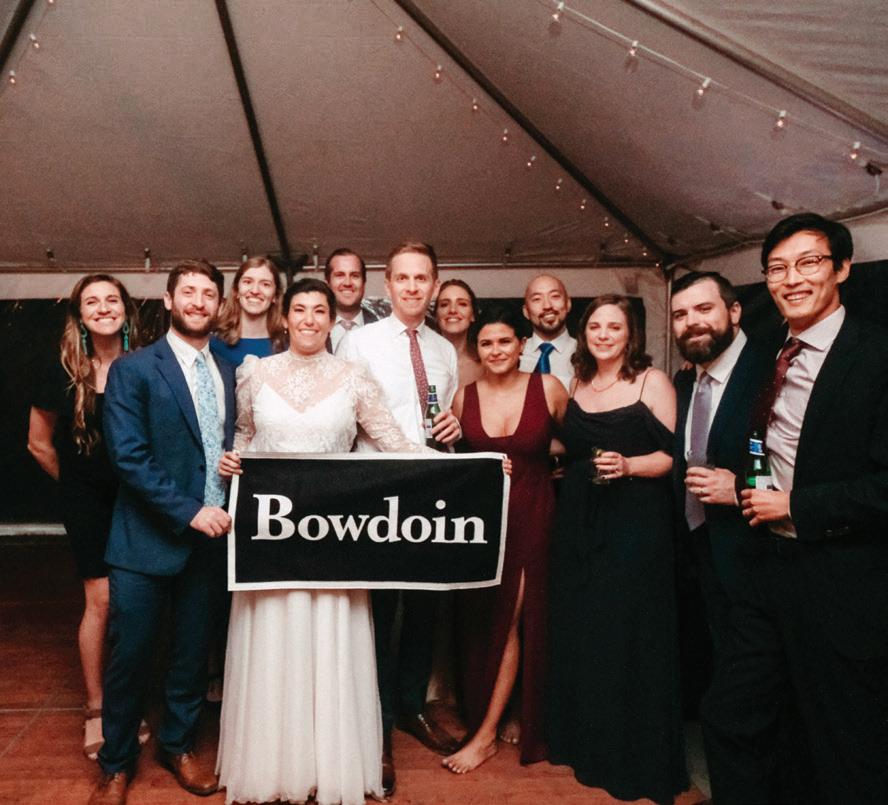

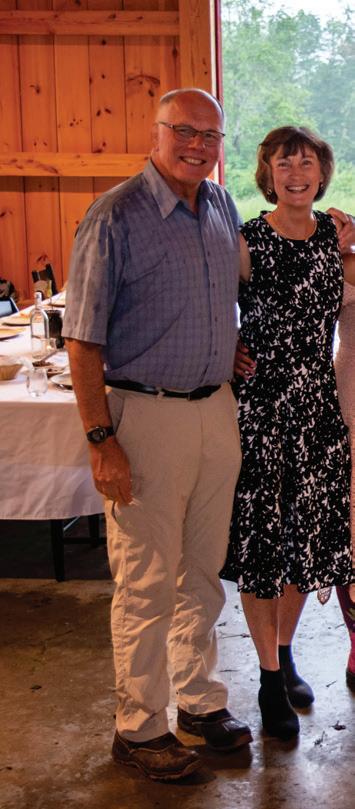
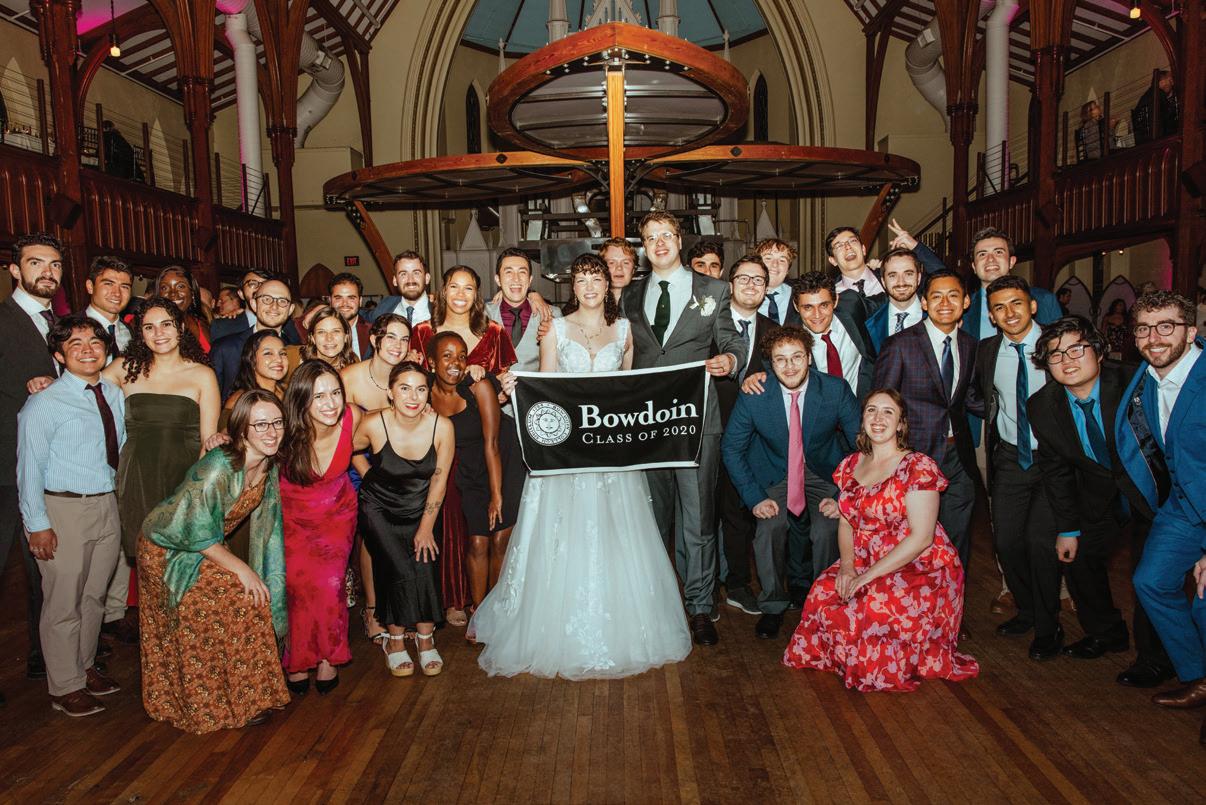
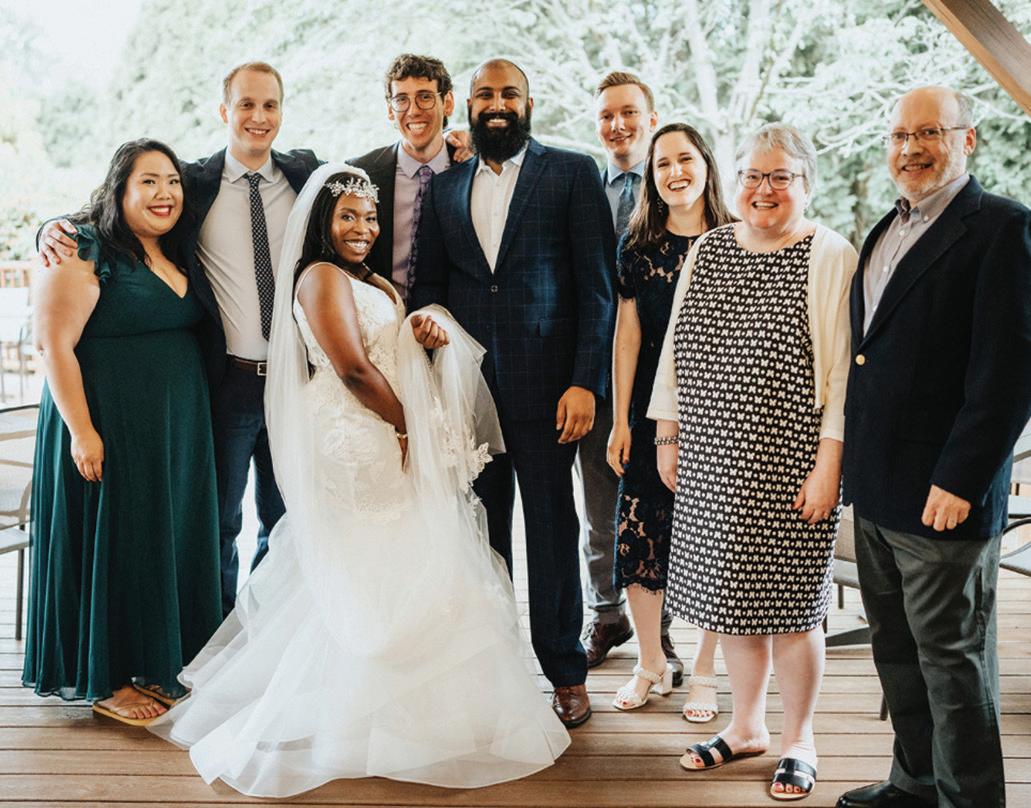

60 BOWDOIN MAGAZINE WINTER 2024 | CLASSNEWS@BOWDOIN.EDU Connect 5 6 7 9 1 3 8 2 4
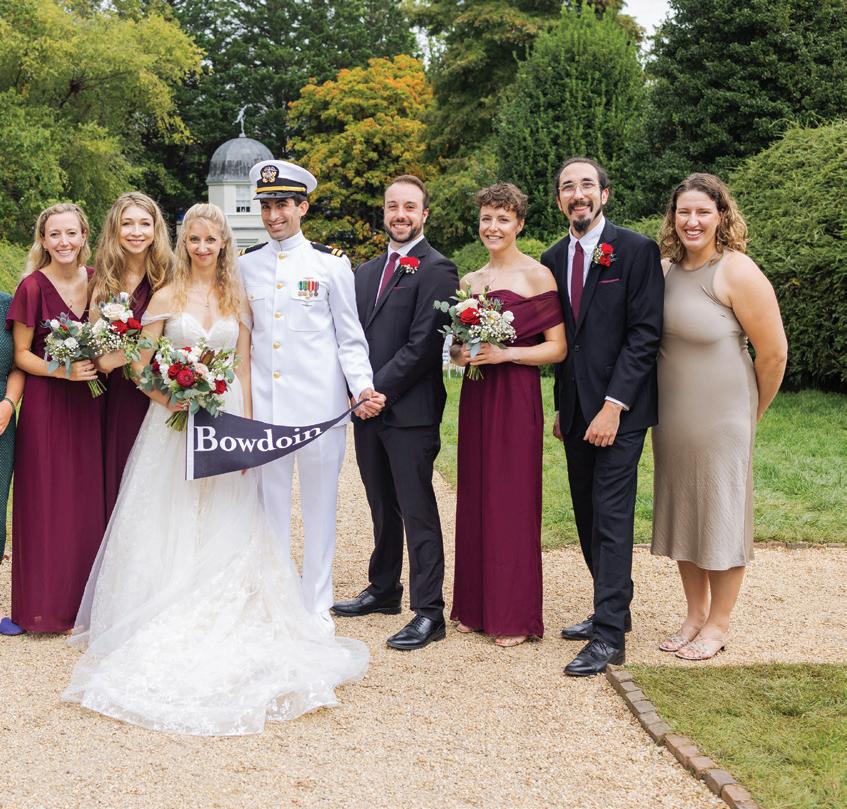
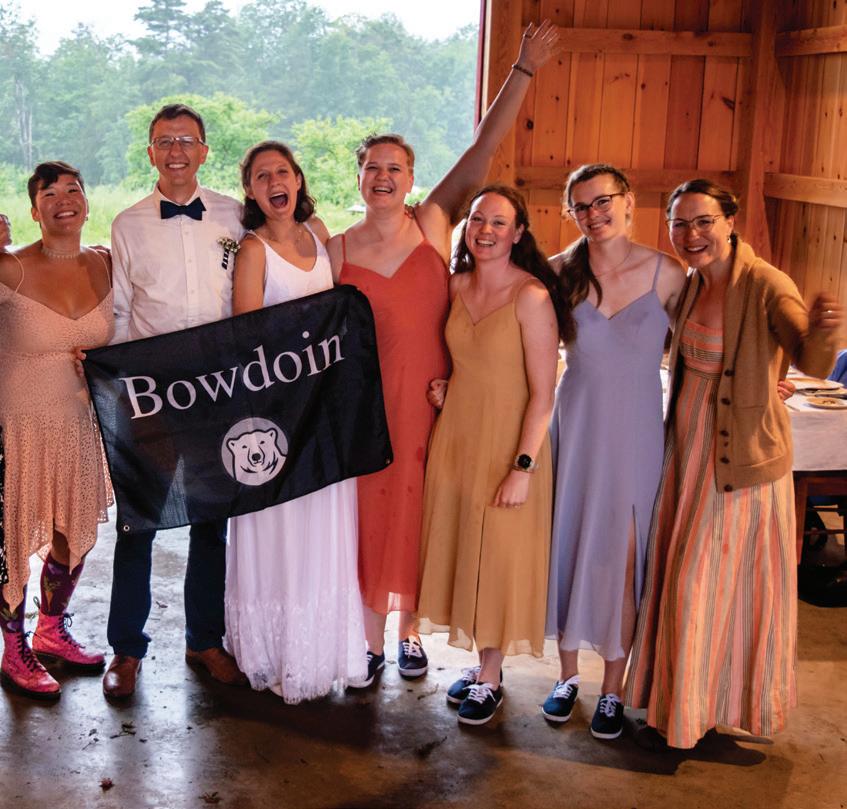
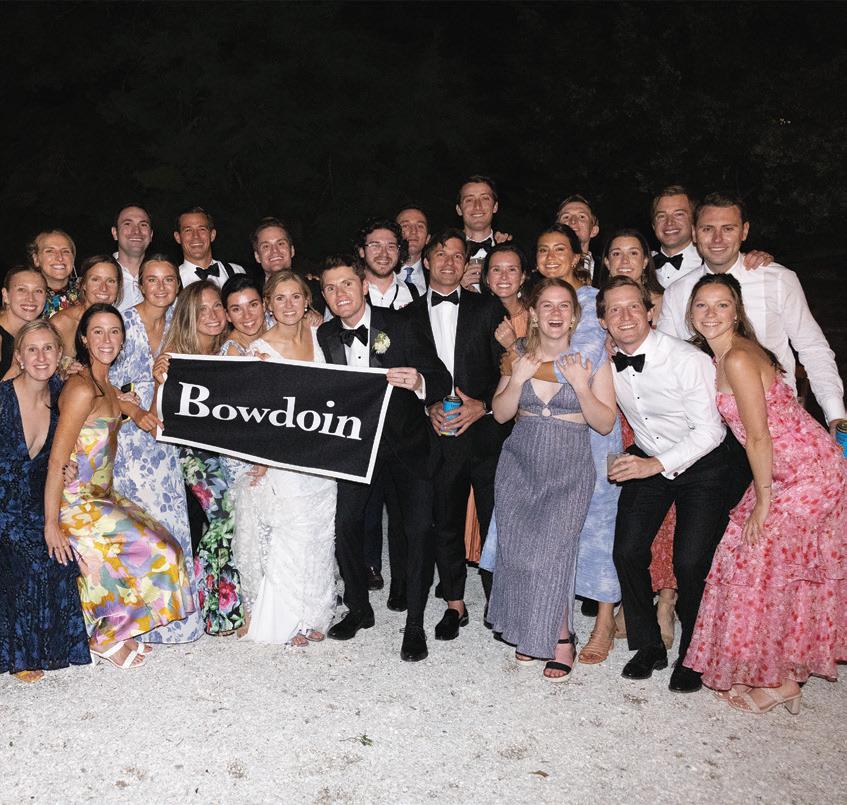
1. Julie Hooper ’12 and Matthew Cameron (University of California— Berkeley ’14) were married on September 2, 2023, at Squam Lake, New Hampshire. Pictured: Karen Mills, Barry Mills ’72, Laura Till ’12, Michael Hannaman ’13, Elena Keamy ’12, Craig Comen ’12, Julie, Liz Huppert ’12, Chad Dufaud ’12, Natalie Reid ’17, Tim Hunt ’14, and Quinn Cohane ’13.
2. Kristin Pollock ’04 and Rob Civitello (Miami University ’00) were married on March 25, 2023, in Chicago, Illinois. Pictured: Shoshana Kuriloff Sicks ’04, Heather MacNeil Cox ’04, Ryan Naples ’04, Eileen Schneider Naples ’04, Kristin and Rob, Ryan Malloy ’04, Hillary Fitzpatrick Peterson ’04, Nora Dowley Liebowitz ’04, Ben Peterson ’04, Jarred McAteer ’04, Becky Tanenbaum Lacey ’04, and Amanda Burrage ’04.
3. Raleigh McElvery ’16 and Spencer Shabshab (United States Naval Academy ’16) were married on September 30, 2023, in Annapolis, Maryland. Pictured: Sophie Berube ’16, Tracey Faber ’16, Coco Faber ’16, Kathleen Hardy ’16, Kylie Moore ’16, Raleigh and Spencer, Jacob MacDonald ’16, Lucy Knowlton ’16, Jacob Muscato ’16, and Sarah Steffen ’17.
4. Hanna Wurgaft ’14 and Alex Beach (Clark University ’13) were married on September 30, 2023, in Rockland, Maine. Pictured: Maeve O’Leary Kelly ’14, Sam Silverman ’14, Tracy Shirey ’14, Hanna and Alex, Aggie Kelly ’13, Danae Hirsch ’14, Casey Correa ’14, Kevin Miao ’14,
Charlotte Beach Woodford ’14, Cameron Woodford ’15, and Kevin Wu ’14. In attendance but not pictured: Charlie Boyle ’13.
5. Ellen Masalsky ’17 and Spencer Shagoury ’17 were married on September 9, 2023, at Flanagan Farm in Buxton, Maine. Pictured: Thomas Freeman ’17, Mariette Aborn ’17, Kelsey Scarlett ’17, Simon Close ’17, Anne Devine ’81, Anisa LaRochelle ’17, Drew Fernandez ’16, Leigh Fernandez ’18, Reed Fernandez ’17, Walter Chacon ’17, Brooke Bullington ’17, Haley White ’17, Spencer and Ellen, Hannah Broos ’17, Cam Chisholm ’16, Mark Schiller ’17, Phoebe Smukler ’17, Alex N’Diaye ’15, Clara Hunnewell ’17, Casey Kelly Ellis ’02, Lucy Knott Schiller ’17, Cam Woodford ’15, Nancy Geduld ’17, Agathe Wallin ’17, and Charlotte Beach Woodford ’14.
6. Anna Wells Piotti ’16 and Alexander Castonguay (SUNY— Binghamton ’17) were married on July 2, 2023, in Northport, Maine. Pictured: Bob Mathews, MaryBeth Mathews (Bowdoin women’s rugby coach emerita), Elena Schaef ’16, Alex and Anna, Meredith Outterson ’17, Emily King ’16, Hayleigh Kein ’15, and Megan Marsh ’08.
7. Isabel Thomas ’20 and Cole Crawford ’20 were married on October 21, 2023, in Portland, Maine. Pictured: Matthew Donnelly ’22, Matsu Hikida ’22, Kenny Lamm ’20, Samantha Schwimmer ’21, Sabrina Hunte ’20, Evelyn Beliveau ’19, Shani Agarwal ’20, Ryan Ali-Shaw ’19, James Callahan ’19, Viviane Callahan ’19, Charlotte Hall ’20,
Parker Lemal-Brown ’18, Caroline Kranefuss ’20, Anna Fauver ’20, Kevin Lane ’19, Joyce Bor ’22, Olivia Ware ’20, Mingo Sanchez ’17, Isabel and Cole, Dylan Hayton-Ruffner ’20, David Brower ’20, Eddie Korando ’20, Jake Readinger ’20, Adam Cohen ’20, Leo Levine ’17, Bobby Choi ’17, Chlöe Dietrich ’16, Dave Ruuska ’17, Miguel Diaz Segura ’20, Mike Donnelly ’20, Ural Mishra ’20, Junyoung Hwang ’20, and Aaron Earl ’20.
8. Marina Affo ’17 and Michael Jones (Penn State ’14) were married on June 3, 2023, in Wilmington, Delaware. Pictured: Chrissy Rujiraorchai ’17, Marcus Christiansen ’17, Marina, Isaac Merson ’17, Arindam Jurakhan ’17, Silas Domy ’16, Leah Murphy ’16, Michelle Small ’86, and Jeffrey Sullivan ’86.
9. Billy Valle ’16 and Maggie Godley ’16 were married on September 16, 2023, at Mt. Hope Farm in Bristol, Rhode Island.
Pictured: Sarah Wallace ’16, Jamie Hofstetter Foley ’16, Bridget McCarthy ’16, Rachel Brooke ’16, Alexa Yurick ’15, Audrey Phillips ’16, Kathleen Smith ’15, Abby Einwag Schultz ’15, Kelsey Mullaney ’16, Ryan Nardi ’17, Kiersten Turner ’16, Peter Reuter ’16, Jenna DiCicco Yurewicz ’15, Amanda Kinneston ’15, Maggie and Billy, Peter Powers ’16, Brandon Rothman ’16, Chris Nadeau ’16, Drew Hillman ’17, Sean Offner ’16, Meg O’Connor Durkin ’16, Rebecca Stoneman Brewster ’14, Emma Beecher ’16, Sam Hodgson ’16, David Nemirov ’15, Taylor Wilson Dussault ’15, Cody Dussault ’15, Sydney Hancock ’17, and Jack Carrier ’15.
Celebrate BOWDOIN MAGAZINE WINTER 2024 CLASSNEWS@BOWDOIN.EDU 61
Celebrate
10. Emi Gaal ’15 and Alexander Thomas ’16 were married on May 13, 2023, in Friendship, Maine.
Pictured: Erik Liederbach ’19, Erika Sklaver ’17, Matt Foley ’16, Hailey Wahl ’16, Erin Houlihan ’17, Jackie Sullivan ’15, Chad Martin ’16, Courtney Koos ’16, Sophia Cornew ’14, Andrea Noble ’15, Kaylee Schwitzer Yarrow ’15, Ethan Winter ’19, Alyce McFadden ’20, Kelsey Gallagher ’17, William Goodenough ’16, Danny Mejia ’17, Ryan Sanderson ’16, Dimitria Spathakis ’16, Koko Novak ’16, Matt Goroff ’16, Alexander and Emi, Maya Norman ’17, Meg Broderick ’16, Jai Vaidya ’16, McKenzie Kessel ’16, Matt Collins ’15, Matt Mathias ’14, Ali Ragan Mathias ’16, Linnea Patterson ’18, Bo Bleckel ’18, Carina Spiro ’18, April Mendez ’18, Michael Butler ’17, Risa Fox ’20, Ben Sickel ’18, Brewster Taylor ’18, Eli Bass ’16, Madeline Bustemante ’17, Alice Jones ’17, and Drew Villeneuve ’16.
11. Jordan Francke ’13 and Martin Sommerschuh were married on September 30, 2023, at the Coolidge Family Farm in New Gloucester, Maine. Pictured: Sarah Seames (Bowdoin staff), CJ Stratton Buys ’13, Mira Nikolova ’13, Juan Gomez Ruszem ’13, Jordan and Martin, Renee Symonds ’13, Matt Yantakosol ’10, Katarina Holmgren ’13, Mariya Ilyas ’13, Elena Crosley ’13, and Jimena Escudero ’13.
12. Leah Murphy ’16 and Silas Domy ’16 were married on September 2, 2023, at the Portland Regency Hotel in Portland, Maine.
Adela Yang ’16, Marina
Affo Jones ’17, Sabine Berzins ’16, Leah and Silas, Victor Leos ’16, Dillon Sandhu ’16, and Miguel Aviles ’16.
13. Emily Nguyen ’16 and Will Schleier (Princeton University ’13) were married on January 7, 2023, in New Orleans, Louisiana.
Pictured: Oliver Lawrence ’16, Jared Feldman ’16, Brian Durkin ’13, Hunter Clark ’13, Maggie Godley ’16, Kiersten Turner ’16, Charlie Krause ’16, Phoebe Kranefuss ’16, Billy Valle ’16, Meg O’Connor Durkin ’16, Emma Beecher ’16, Emily and Will, Lindsay Picard Prebor ’16, Spencer Antunez ’18, Caroline Coles ’16, Ari Cameron ’16, Charlotte Alimanestianu ’16, Emily Serwer ’16, Claire Schollaert ’16, Matthew Gutschenritter ’16, and Andrew Fradin ’16.
14. Taylor Washburn ’04 and Heather Hwalek (Columbia University ’10) were married on September 25, 2021, at Camp Fernwood Cove in Harrison, Maine. Pictured: Conor Savage O’Brien ’03, Heather and Taylor, and Aaron Goldstein ’05.
15. Rebecca Centanni ’13 and Daniel Schmoll ’13 were married on August 19, 2023, in Wellesley, Massachusetts. Pictured: Matt Frongillo ’13, Devon Shapiro ’13, Allison Beeman ’13, Basyl Stuyvesant Durnan ’13, Sara Kwasny Mahoney ’13, Andrea Koenigsberg ’13, Nani Durnan ’13, Chris Mahoney ’13, Matt Bernstein ’13, Laura Kunycky Schmoll ’86, Ryan Holmes ’13, Danny and Becca, Tristan McCormick ’13,
Stephanie Ludy Mitrano ’13, Eddy Page ’13, Eliza Warren-Shriner ’13, Zoe Eiber ’13, EJ Googins ’13, Kristen Stogsdill ’13, Peter Yen ’13, Robert Schmoll ’84, Mark O’Donnell ’13, Kyra Babakian ’14, Kasey Suitor ’13, Dani Chediak ’13, Anne Schmoll Lee ’85, Katie Doble Goodrich ’13, and Jeff Goodrich ’12.
16. Lily Morse ’09 and Anna Folkers (New College of Florida ’10) were married on June 3, 2023, at The Owenego in Branford, Connecticut. Pictured: Morgan MacLeod ’09 and his wife, Hannah Marcus, Lily and Anna, and Luke Fairbanks ’09 and his wife, Leslie Acton.
17. Nicholas Collins ’07 and Mary Rose Tuba were married on May 13, 2023, in Falls Church, Virginia. Pictured: Jordan Krechmer ’07, Carrie Miller ’08, Casey Dlott ’07, Conor McManamy ’19, Mary Rose and Nicholas, Keirnan Willett ’07, Caitlin Watson ’07, Matthew Martin ’07, Mark Hendrickson ’07, and Michael Peiser ’07.
18. Natasha Belsky ’19 and John-Alexander (Jay) Kourkoulis ’17 were married on September 9, 2023, in Franklin, Tennessee.
Pictured: Daniel McMullan ’18, Brendan Conroy ’17, Tom Dunleavy ’20, Matthew Sullivan ’17, Callie Burkhart ’21, Cullen Geary ’18, Jay and Natasha, Greg McConnell ’07, B. Steven Polikoff ’88, Miranda Princi ’17, Chloe Polikoff ’17, Mettler Growney ’17, Erik Bertin ’14, Mitchell Barrington ’17, Abby Motycka ’17, Ken Culbertson ’17, Joseph Lace ’17, Matthew Lison ’18, and Casey Chase ’18.
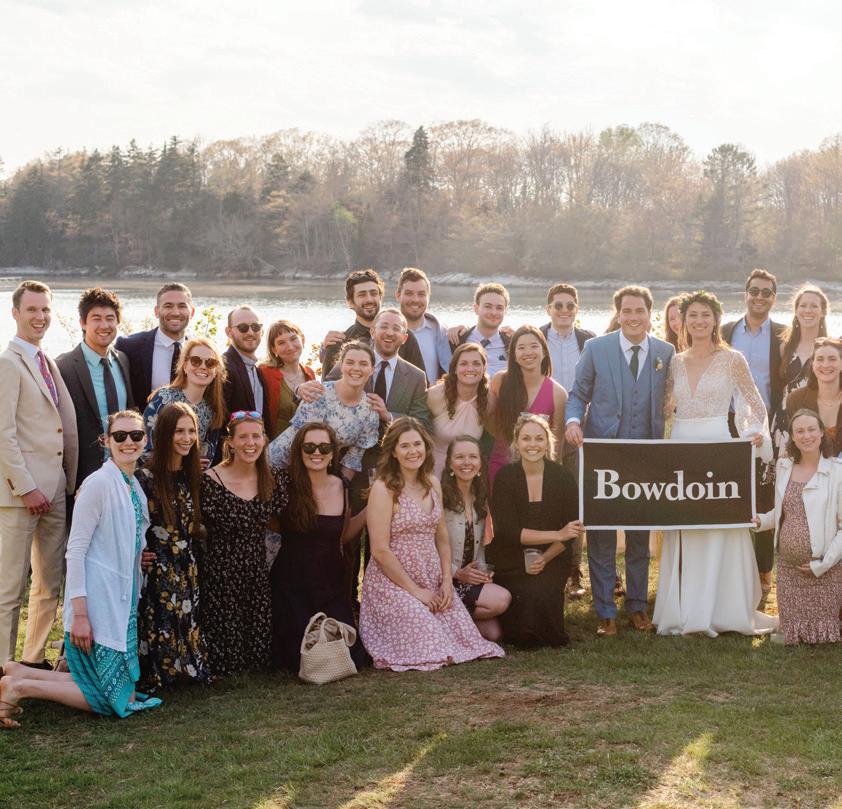
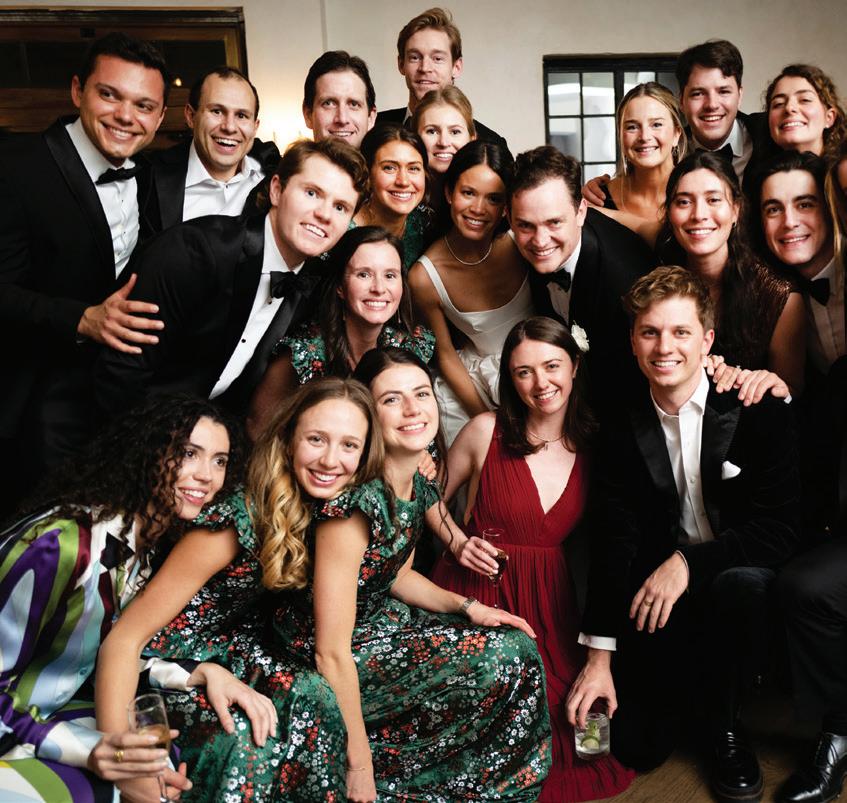
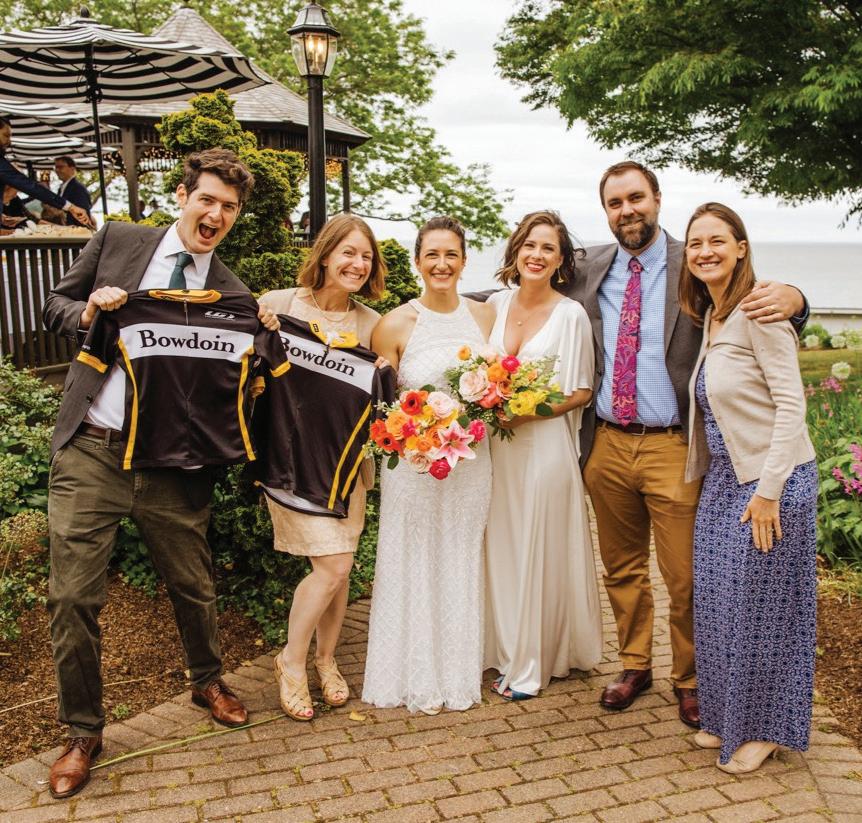
62 BOWDOIN MAGAZINE WINTER 2024 | CLASSNEWS@BOWDOIN.EDU
Pictured:
13 16 10
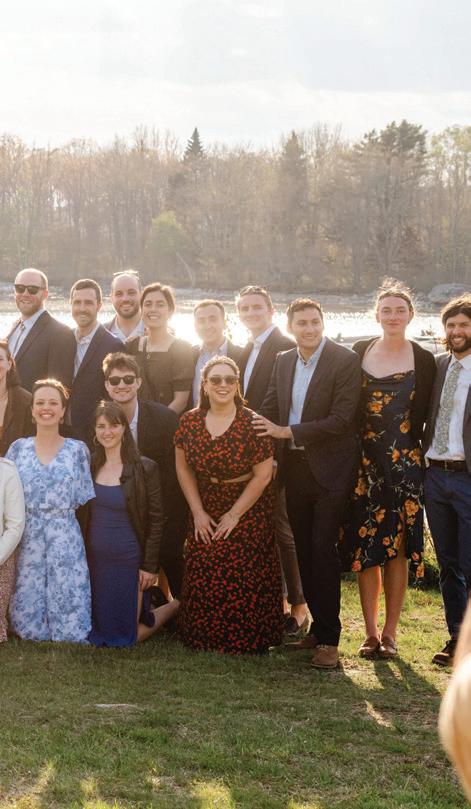
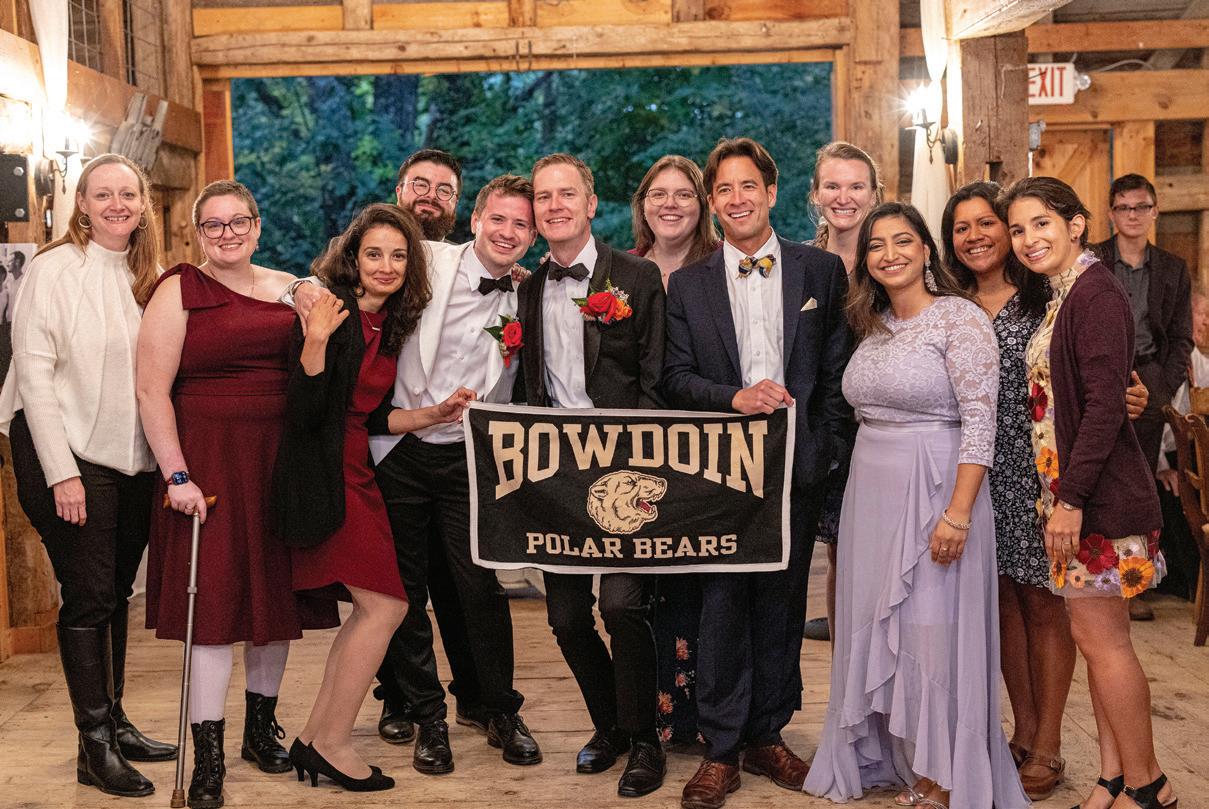
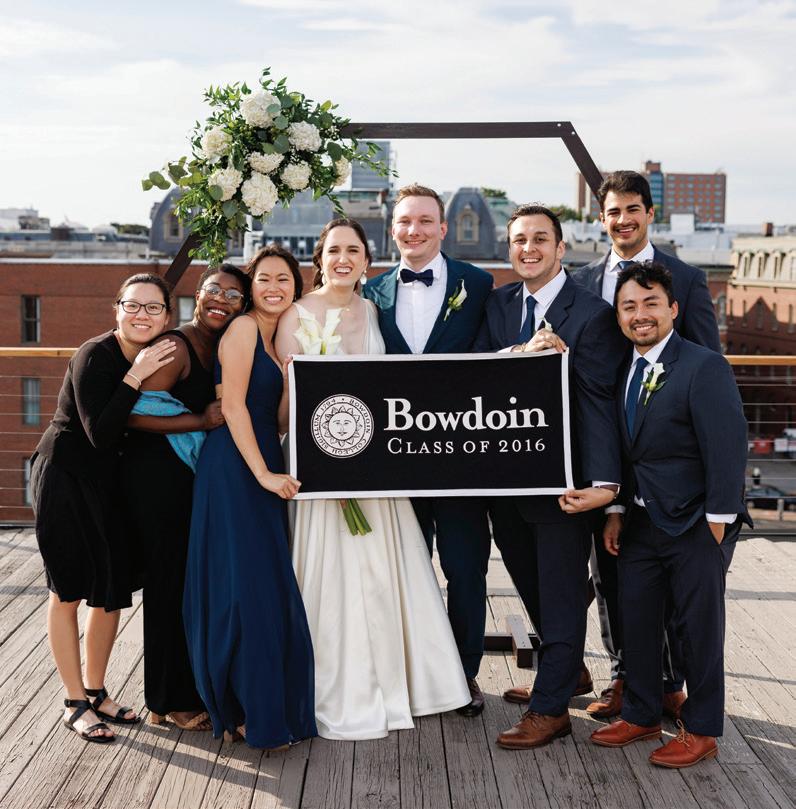

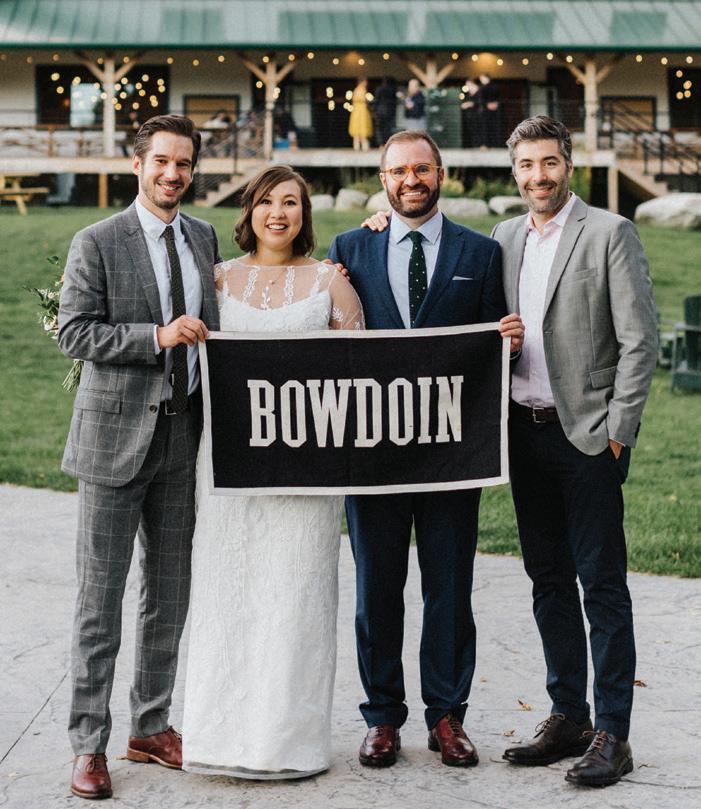


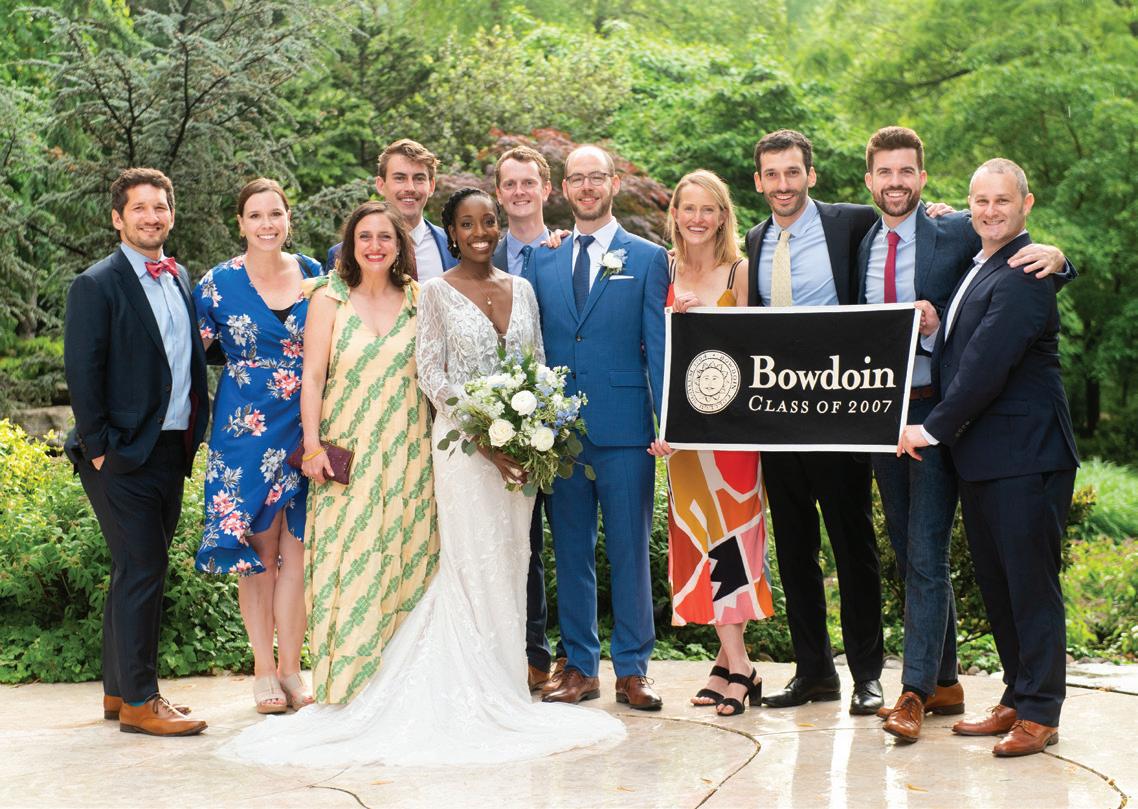
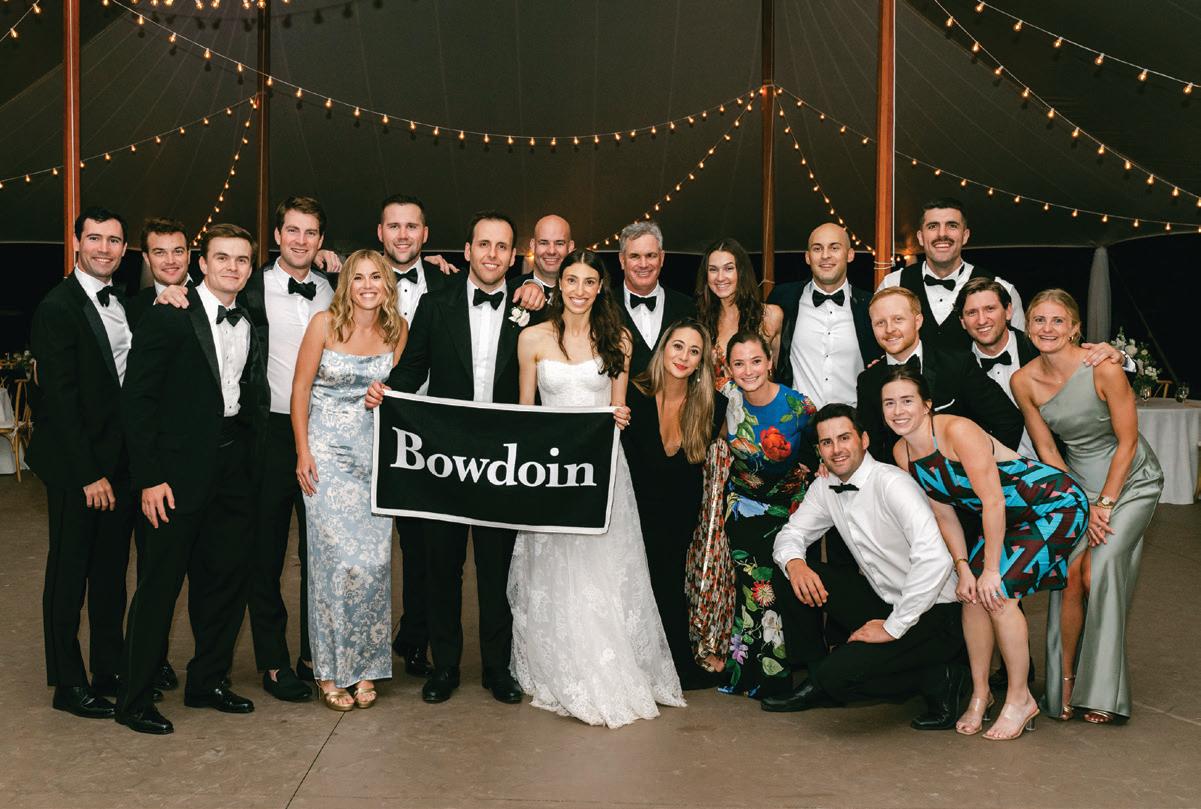
BOWDOIN MAGAZINE WINTER 2024 | CLASSNEWS@BOWDOIN.EDU 63 15 11 14 18 12 17
When the General Court of Massachusetts granted the charter for Bowdoin College on June 24, 1794, the United States was a nation not yet twenty years in the making, and it would be another twenty-six years before Maine would become a state. But notable things were happening in Bowdoin’s founding year.
The Spirit of 1794
The Court of Massachusetts asked all Maine towns to draw and submit maps. That same year, Samuel Lewis produced one of the earliest maps of Maine, “Province of Maine, From the Best Authorities.”
The Treaty of 1794 between the Passamaquoddy Tribe and the Commonwealth of Massachusetts transferred tribal lands to the state without congressional approval, but the treaty did protect some native fishing and hunting grounds.
The Maine towns of Bridgton, Cornish, Dresden, Farmington, Hampden, New Milford (now Alna), New Sharon, Newfield, and Prospect—spread across what are now six different counties— were incorporated.
The Sabbathday Lake Shaker settlement was formally established in New Gloucester with the construction of its Meetinghouse in 1794. Shakers practice celibacy and so have always had to increase their population through conversion and adoption; the two who live at Sabbathday Lake today are the last remaining Shakers.
General Henry Knox, secretary of war under George Washington and a larger-than-life figure who would serve as the model for Colonel Pyncheon in Nathaniel Hawthorne’s House of the Seven Gables, was granted vast land holdings in Maine, including the Waldo Patent, between the Kennebec and Penobscot Rivers.
On June 18, twenty-five delegates from seventeen towns met in Portland to discuss the District of Maine separating from Massachusetts, a move that proponents insisted would save Maine £1,550. The separation would not occur until twenty-six years later, as part of the Missouri Compromise.
On August 17, Robert Pinckney Dunlap was born in Brunswick. Dunlap would serve as governor of Maine from 1834 to 1838 and as a member of the Bowdoin College Board of Overseers for thirty-eight years until his death in 1859.
Benjamin Darling, a free Black man, settled on Malaga Island off the shores of Phippsburg, which would eventually become home to a multiracial community that flourished from the Civil War until the state forcibly evicted all residents in 1911 and that inspired a highly acclaimed 2023 novel by Paul Harding, This Other Eden
Notorious colonial outlaw Henry Tufts was arrested for the last time for stealing six silver spoons, an event recorded in his 1807 memoir, A Narrative of the Life, Adventures, Travels and Sufferings of Henry Tufts, now residing at Lemington, in the District of Maine
The Ricker family established an inn at Poland Springs that would become a popular resort hotel, The Poland Spring House. The hotel eventually had a barber shop, dance and photography studios, a pool room, a music hall, and a bowling alley, in addition to its dining facilities and more than 350 guest rooms.
On December 29, 1794, the Portland-based Eastern Herald reported that the Hon. James Bowdoin III, Esq., had sent a letter to the trustees and overseers of Bowdoin College pledging $1,000 and 1,000 acres of land in Bowdoin toward the endowment of the College, noting that “This generous donation, in addition to the five townships of land granted by the government, is the whole estate of the College at present.”
64 BOWDOIN MAGAZINE WINTER 2024 CLASSNEWS@BOWDOIN.EDU Here PHOTO: ANDREW ESTEY

Robert Pinckney Dunlap, Bowdoin Class of 1815, served as Maine’s eleventh governor. Born in Brunswick on August 17, 1794, he served as a member of the Maine House of Representatives and as a member of the Maine State Senate before winning election to the governor’s office in 1833. He served for thirty-eight years as a member of the board of overseers for Bowdoin, sixteen of them as board president. Dunlap died on October 20, 1859, and was buried at Brunswick’s Pine Grove Cemetery, where his grave is marked with the monument seen here.
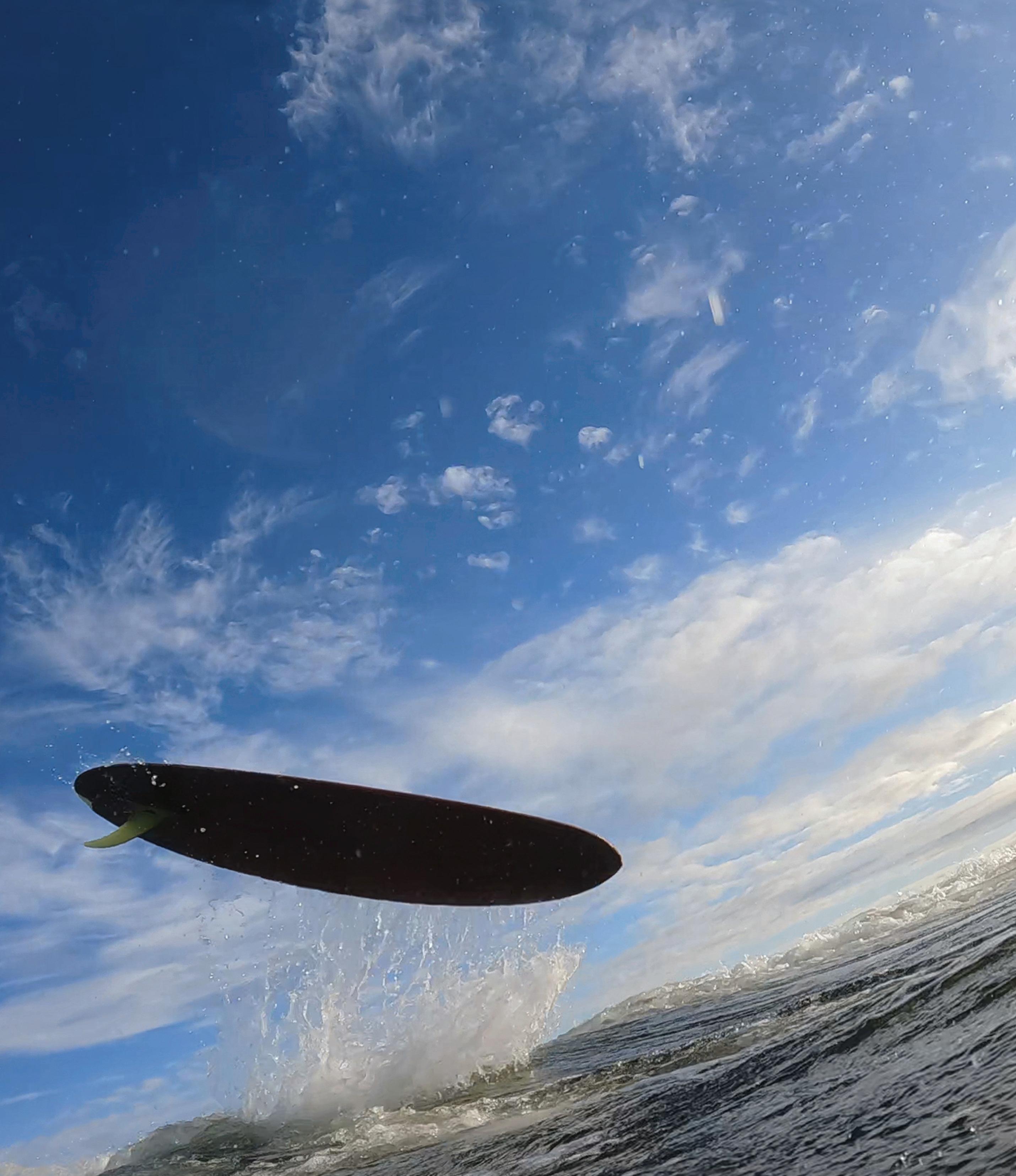
Bowdoin Magazine Bowdoin College Brunswick, Maine 04011 NON-PROFIT U.S.POSTAGE PAID BOWDOIN COLLEGE












 FROM BOWDOIN AND BEYOND
FROM BOWDOIN AND BEYOND



































 Vandersea at Bates
Vandersea at Bates





 BY MICHAEL COLBERT ’16
ILLUSTRATIONS BY PIERRE-PAUL PARISEAU
BY MICHAEL COLBERT ’16
ILLUSTRATIONS BY PIERRE-PAUL PARISEAU

















 BY CHRIS RITTER ’21 PHOTOGRAPHS BY HEATHER PERRY
BY CHRIS RITTER ’21 PHOTOGRAPHS BY HEATHER PERRY











 Below: A wave flips one of the boards into the air. This can be dangerous when the water is crowded, but on this day the Bowdoin surfers were the only ones in the water.
Opposite page, top: Sydney Reaper ’21 heads for the surf.
Opposite page, bottom: Chris Ritter ’21
Below: A wave flips one of the boards into the air. This can be dangerous when the water is crowded, but on this day the Bowdoin surfers were the only ones in the water.
Opposite page, top: Sydney Reaper ’21 heads for the surf.
Opposite page, bottom: Chris Ritter ’21




















 Craig Williams ’71
Craig Williams ’71











































